Safe Sport: Critical issues and practices
Julie Stevens, Editor
Centre for Sport Capacity, Brock University
St. Catharines, Ontario, Canada


Safe Sport: Critical issues and practices by Julie Stevens is licensed under a Creative Commons Attribution-NonCommercial-ShareAlike 4.0 International License, except where otherwise noted.
1
Safe Sport: Critical issues and practices by Julie Stevens (Editor) is licensed under a Creative Commons Attribution-NonCommercial-ShareAlike 4.0 International License.
Vectors used in cover design and Figure 5.1 are derived from the Vecteezy.com free license. Unless otherwise noted, photos are used through Creative Commons licenses from Pixabay, Unsplash, Wikimedia, and Flickr. Unless otherwise noted, all figures should be credited to the chapter author and the editor.
![]()
Stevens, J. (Ed.) 2022. Safe Sport: Critical issues and practices. Ecampus Ontario. https://ecampusontario.pressbooks.pub/safesport Licensed under CC-BY-NC-SA 4.0.
If you adopt this book as a required or supplemental reading in a course or other educational forum, please let us know by emailing the Editor, Julie Stevens, PhD, at jstevens@brocku.ca
2
This edited book is dedicated to all who enjoy participating in sport, no matter what the level or form. We hope our contribution builds upon the Red Deer Declaration, as well as the efforts of many others who place safety, inclusion, and diversity as a fundamental principle in their efforts to make sport better.
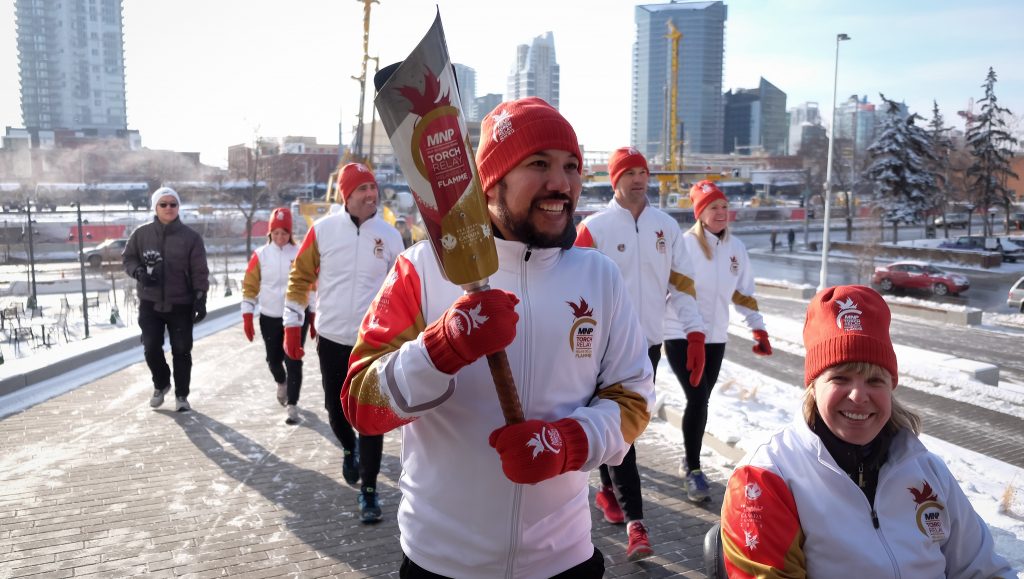
We, the Federal, Provincial, and Territorial Ministers responsible for Sport, Physical Activity, and Recreation recognize that all Canadians have the right to participate in sport—in an environment that is safe, welcoming, inclusive, ethical and respectful. An environment that protects the dignity, rights and health of all participants.
Red Deer Declaration for the Prevention of Harassment, Abuse and Discrimination in Sport, Conference of Federal-Provincial-Territorial Ministers Responsible for Sport, Physical Activity and Recreation, February 2019.
3
This edited book’s format is compliant with the Accessibility for Ontarians with Disabilities Act, 2005 (AODA). The tools used to build this safe sport edited book are structured to ensure that our content reflects the POUR principle, meaning that the resource is Perceivable, Operable, Understandable, and Robust. The Universal Design for Learning (UDL) framework used in the creation of this edited book gives students multiple ways to engage with content and demonstrate their knowledge by providing interactive content, audio recorder/written response opportunities, and videos.
To achieve AODA compliance we spoke with colleagues in the Centre for Pedagogical Innovation at Brock University and attended workshops including “Making Accessible Content with Pressbooks”, funded in part by eCampusOntario. We also conducted accessibility tests using the NonVisual Desktop Access (NVDA) screen reader in the Chrome browser.
Pressbooks is designed to be accessible for users of all abilities and compatible with screen readers and other assistive technologies. We opted to pursue accessibility over aesthetics in many cases. For example, while formatting a page using the table function may result in a nicer layout, it would not be accessible for an individual using a screen reader. Here are some of the main items we focused on to ensure this edited reader is accessible.
Should this resource require accessibility updates or corrections, please let us know by emailing the Editor, Julie Stevens, PhD, at jstevens@brocku.ca.
4
5

Julie Stevens, PhD, is an Associate Professor in the Department of Sport Management and Director of the Centre for Sport Capacity at Brock University. She currently serves as the Special Advisor to the President – Canada Games, where she leads the academic partnership between Brock University and the 2022 Niagara Canada Summer Games. For the past 30 years, Julie has conducted diverse and transdisciplinary research, and employs various models of organizational development to analyze dynamics of change and organizational design within sport. Her scholarly work emphasizes various topics such as institutional development, large-scale change, innovation, governance, managerial logics and practices, player development models, and ethics. Julie is also a North American Society for Sport Management Research Fellow (2013) and a Brock University 2020 Outstanding Co-op Supervisor Recognition Award recipient.
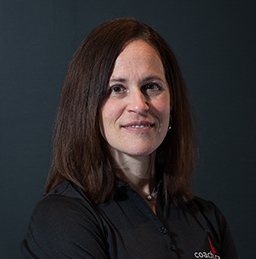
Isabelle Cayer is the current Director of Sport Safety at the Coaching Association of Canada (CAC). Her mission is to create a safer and more inclusive sport system for everyone. A former competitive athlete and NCCP certified coach, she is a current Coach Developer, facilitator, presenter and volunteer on a community sport board, and when the opportunity presents, at domestic national and international events. She has worked at the national level of sport for over 20 years at various organizations including the CAC and Skate Canada, and her work has focused on coach education and training, policy development, mentorship, women in coaching & leadership programming, diversity and inclusion initiatives for coach training and partner engagement, and the professionalization of coaching in Canada.
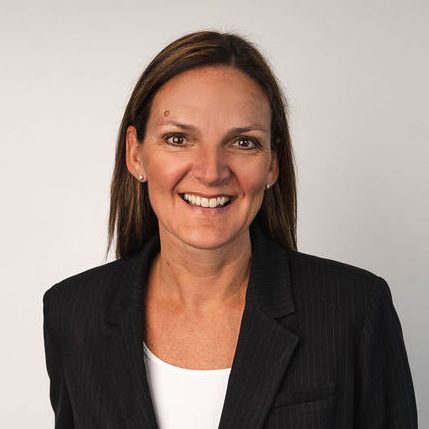
Karri Dawson is the Senior Director of Quality Sport at the Canadian Centre for Ethics in Sport (CCES) and the Executive Director of the True Sport Foundation. Karri holds a Bachelor of Commerce in Sports Administration from Laurentian University and has more than 25 years of professional experience managing corporate sponsorship, philanthropic donations and community engagement programs in amateur sport at the national level. Karri leads a team that engages sport leaders and organizations that share a common belief about what good sport can do, and works with partners and funders to develop initiatives that advance values-based sport in Canada.
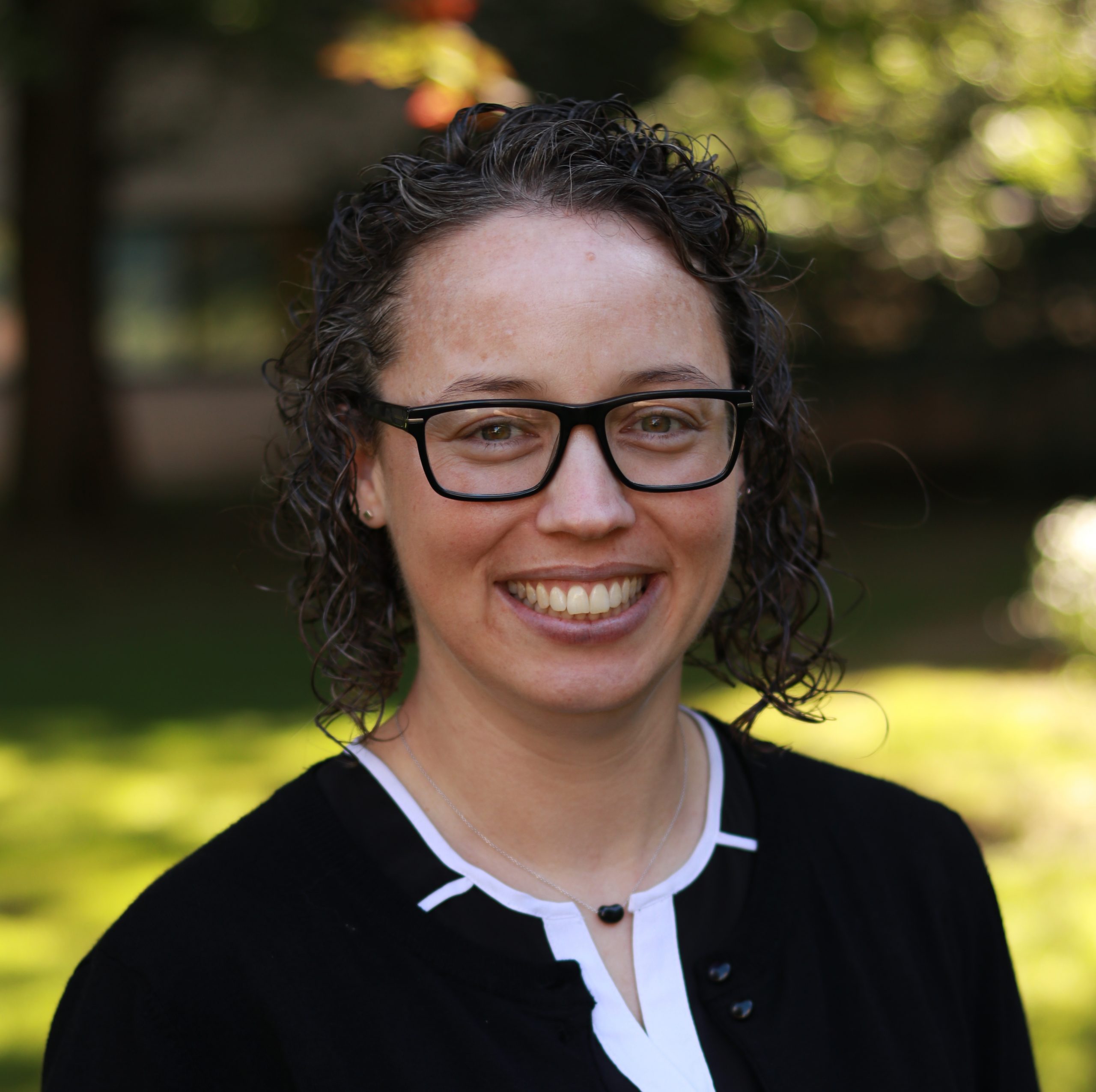
Michele K. Donnelly, PhD, is an Assistant Professor of Sport Management at Brock University, specializing in areas of gender equality and sport. Michele also researches topics of alternative sport, girls and women-only activities in the sport realm, and research ethics. She is the co-founder and serves on the advisory board of the Girls on Track Foundation, whose mission is to help young girls build important life skills through participation in roller derby.

Peter Donnelly, PhD, has recently retired as a Professor and Director of the Centre for Sport Policy Studies at the University of Toronto. He has edited two major sociology of sport journals (Sociology of Sport Journal; International Review for the Sociology of Sport), and served as President of the North American Society for the Sociology of Sport, and General Secretary of the International Sociology of Sport Association. He began researching the maltreatment of athletes when he taught at McMaster University in the 1980s, and has continued that strand of research (among many others) by focusing in particular on the maltreatment of child athletes.
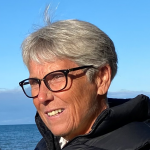
Hilary Findlay, LLB PhD, is a recently retired Associate Professor of Sport Management at Brock who specializes in risk management, regulatory issues, contracts and other legal issues affecting sport and recreation organization.

Susan L. Forbes, PhD, is the Manager of the Teaching and Learning Centre, as well as an Adjunct Professor in the Faculty of Health Sciences at Ontario Tech University in Oshawa, Ontario. Her research focuses on sports officials’ recruitment, development, retention, and attrition. She and her research partners recently published the book entitled Sports Officiating: Recruitment, Development and Retention (Routledge, 2020).
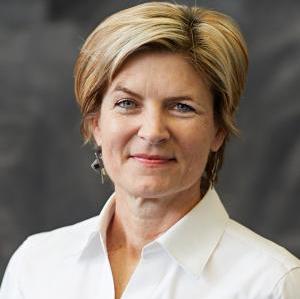
Gretchen Kerr, PhD, is a full Professor and Dean, Faculty of Kinesiology and Physical Education at the University of Toronto. She has spent her academic career devoted to promoting safe and equitable sport opportunities for all through research and knowledge transfer and exchange. As a co-Director of E-Alliance, the Canadian Gender Equity in Sport Research Hub, Gretchen is engaged in establishing a broad network of researchers and partnerships across the country to advance gender equity in sport. Gretchen was the senior author of Canada’s first national prevalence study of maltreatment among current and former national team members, and the subject matter expert for the development of the Universal Code of Conduct to Prevent and Address Maltreatment (UCCMS), and a contributor to Safe Sport education.

Bruce Kidd, PhD, is the Ombudsperson at the University of Toronto. He is a Professor Emeritus in the Faculty of Kinesiology and Physical Education, and the founding Dean of that faculty. He also served as Warden of Hart House, Principal of the University of Toronto Scarborough and Director of Canadian Studies, all at U of T. Bruce’s scholarship focuses upon the history and political economy of Canadian and Olympic sport. He has been involved in the Olympic Movement as an athlete (1964), journalist (1976), contributor to the arts and culture programs (1976 and 1988) and accredited social scientist (1988 and 2000). He was founding chair of the Olympic Academy of Canada (1983-1993), served on the board for Toronto’s 1996 and 2008 Olympic bids and is an honorary member of the Canadian Olympic Committee. Bruce has been a lifelong advocate of human rights and athletes’ rights.
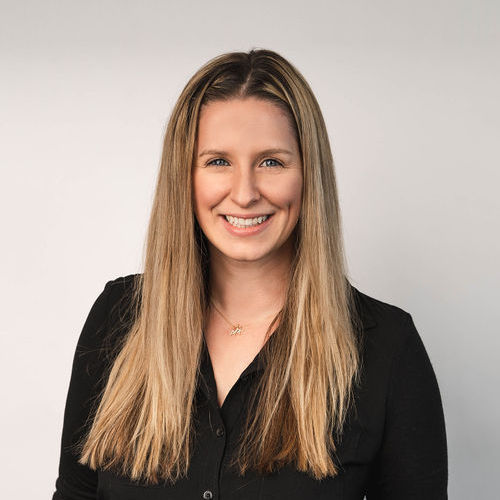
Kasey Liboiron is the Manager of Sport Community Engagement at the Canadian Centre for Ethics in Sport (CCES). In this role, she manages the outreach and engagement of True Sport. The True Sport Principles define Canada’s commitment to values-based sport and are activated and supported by Canadian communities, sport organizations, schools, groups and individuals who believe in the difference good sport can make. Previously, Kasey worked as a secondary school Physical and Health Educator – particularly passionate about inspiring a commitment to physical activity and wellness. Kasey holds Bachelors of Education, Science, and Physical and Health Education from Queen’s University in Kingston, Ontario.

Lori A. Livingston, PhD, is the Provost and Vice-President, Academic and Full Professor in the Faculty of Health Sciences at Ontario Tech University. She has participated as an athlete, coach, official, and administrator at the provincial, national, and international levels in the sport of women’s field lacrosse. She continues to contribute to sport through her research, including work in the area of sport officiating.
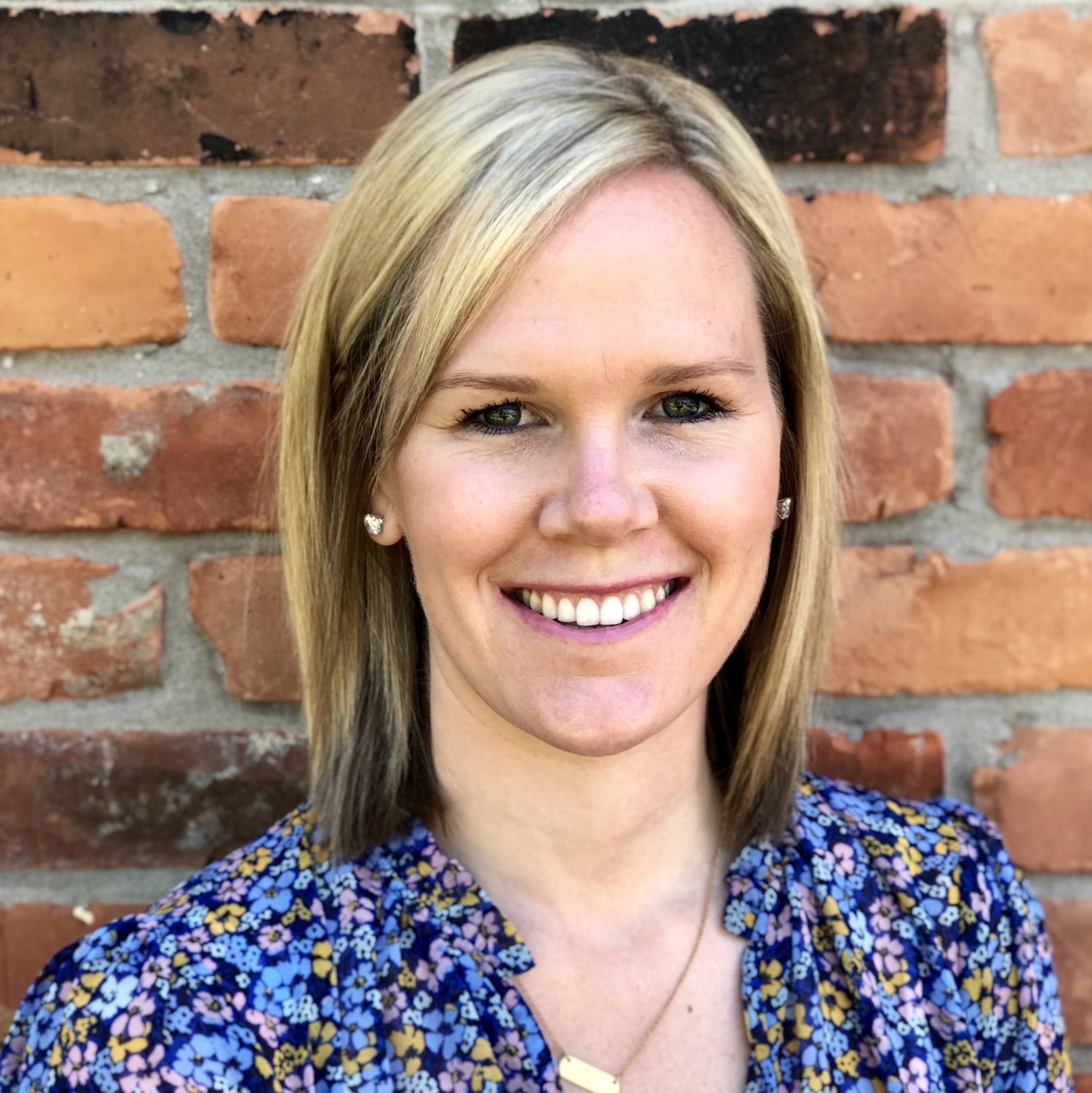
Ellen MacPherson completed her PhD in the Faculty of Kinesiology and Physical Education at the University of Toronto. Her research focuses on social behaviour in sport and online contexts, as well as athlete welfare and development. Ellen has been recognized internationally by the Association for Applied Sport Psychology (AASP) with the Sport Psychologist’s Young Researcher Award and her work has received funding from the Social Sciences and Humanities Research Council of Canada (SSHRC). As the former Director, Safe Sport at Gymnastics Canada, she led the development and implementation of an organizational Safe Sport Framework and the corresponding policy, education, and advocacy initiatives. In her current role at the University of Toronto, she conducts research and works with sport organizations to mobilize knowledge into practice with the ultimate goal of safe, developmentally appropriate, and equitable sport for all.
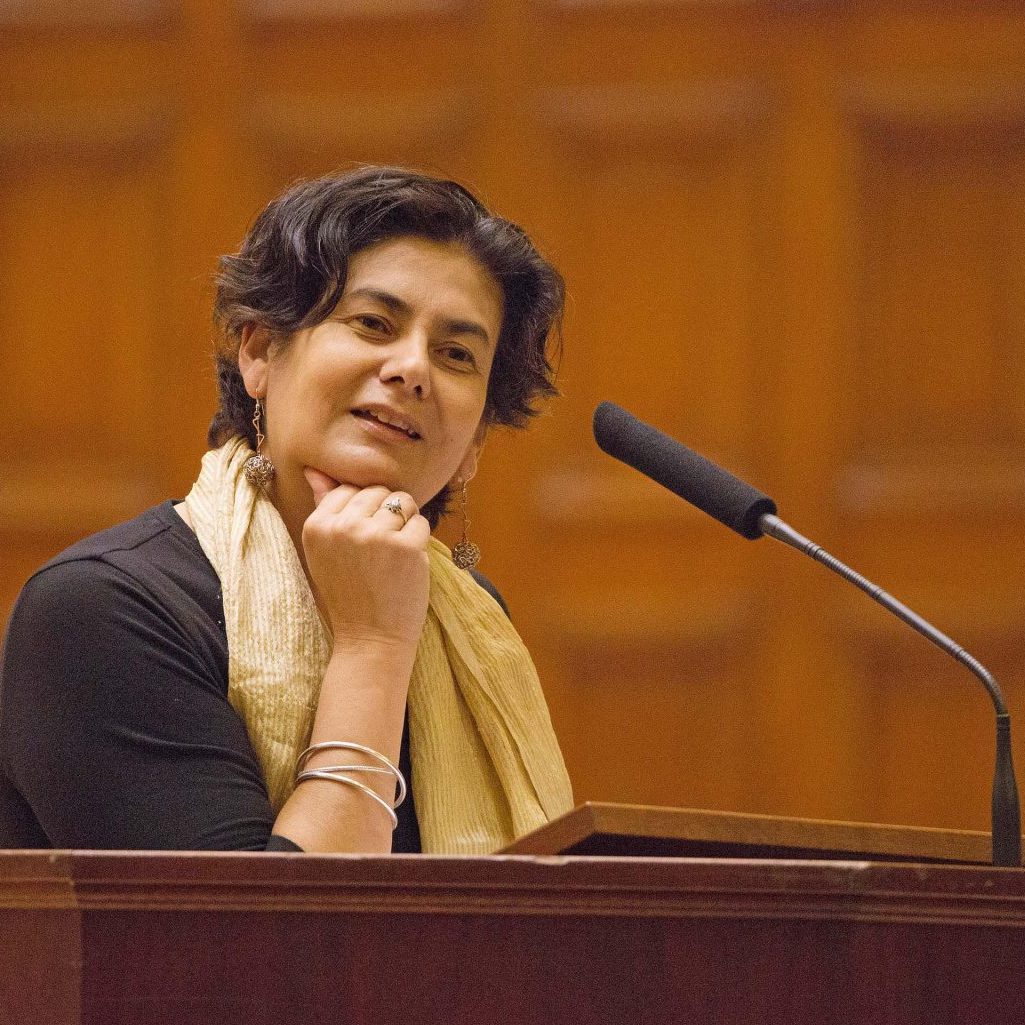
Leela MadhavaRau has served as the inaugural leader of equity, diversity and human rights initiatives at three different universities in both Canada and the United States, mostly recently as the Executive Director of Human Rights and Equity at Brock University. Leela’s expertise in the areas of equity, diversity and inclusion has provided her with the opportunity to present at many national and international conferences, as well as becoming a mentor for individuals beginning their careers in this field.
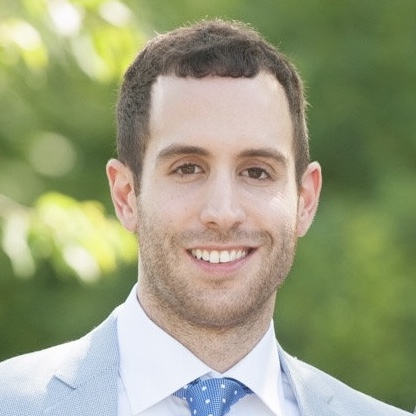
Marcus Mazzucco, JD, is Legal Counsel for the Ontario Ministry of Health and a Sessional Lecturer of Sports Law at the University of Toronto, Faculty of Kinesiology and Physical Education. Marcus has a Bachelor of Physical and Health Education from the University of Toronto and a Juris Doctor from the University of Victoria, British Columbia. The opinions and views expressed in this chapter are solely those of the author and do not represent the opinions or views of the Ontario Government.
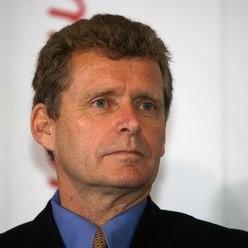
Ian Moss is the CEO of Gymnastics Canada, and has been involved with the organization since 2017. Ian’s involvement in national sport organizations reaches beyond gymnastics, and throughout his career he has worked with seven different NSOs and two MSOs, forming a well-rounded knowledge of Canadian and international sport at both the technical and management level. A seasoned sport association leader with over twenty years of national and international experience, Ian has built a strong vision and operating capacity to translate “big picture” needs into clear operating principles and partnerships.

Peter Niedre is the Director of Education Partnerships at the Coaching Association of Canada (CAC), and oversees the National Coaching Certification Program (NCCP). This role involves working with over 65 National Sport Organizations, 13 Provincial and Territorial Coach representatives and other Canadian Sport System Partners in development and delivery of the NCCP. Prior to the CAC, he worked at Canoe Kayak Canada as the National Junior coach, and Director of Coach and Athlete Development. Prior to that, he was a physical education and outdoor education teacher at the secondary level for 10 years, and part-time lecturer at University of Ottawa in the School of Human Kinetics. Peter is also a Master Coach Developer in sprint Canoe Kayak and in multisport delivery with the Coaches Association of Ontario and actively volunteers at the community level coaching cross country skiing and biathlon.

Talia Ritondo, MA, is a recent Master’s graduate of Brock’s Recreation and Leisure program, where she studied how postnatal women are affected by gendered expectations of motherhood while returning to team sport. She plans to pursue a PhD in the future, with a focus on bringing an intersectional social justice lens to the sport research field. She currently serves as Brock Human Rights and Equity’s Gender and Sexual Violence Education Coordinator, where she coordinates workshops, training and events that educate students, staff, and faculty about gender and sexual violence through an intersectional, anti-oppression lens. For leisure, they love to play volleyball, rock climb, watch Netflix, and play video games.

Kirsty Spence, PhD, has a 20-year background of researching leadership topics and more specifically, leaders’ vertical development and its relationship to leadership effectiveness and program development. She is passionate about Safe Sport topics, having completed Master’s-level research on an inter-organizational network analysis of the implementation of the Speak Out! Program within Hockey Canada in 2001. Dr. Spence has received the Professional Coaching Certification (P.C.C.) designation with the International Coaching Federation (ICF) as a certified Integral Master Coach™.

Georgina Truman, MHK, is the Manager, Athlete Relations and Operations at AthletesCAN. In her role, she is responsible for administration, programs and services, communications, athlete relations, and events. Her experiences as a multi-sport athlete in her youth translated into a passion for the sport industry and strong connection to athlete-centred sport. Prior to joining AthletesCAN, she developed experience in the recreation, university, and non-profit sport sectors in communications, marketing, and client relations. She holds a Master’s degree of human kinetics with specialization in sports management and Bachelor degree of human kinetics from the University of Ottawa.
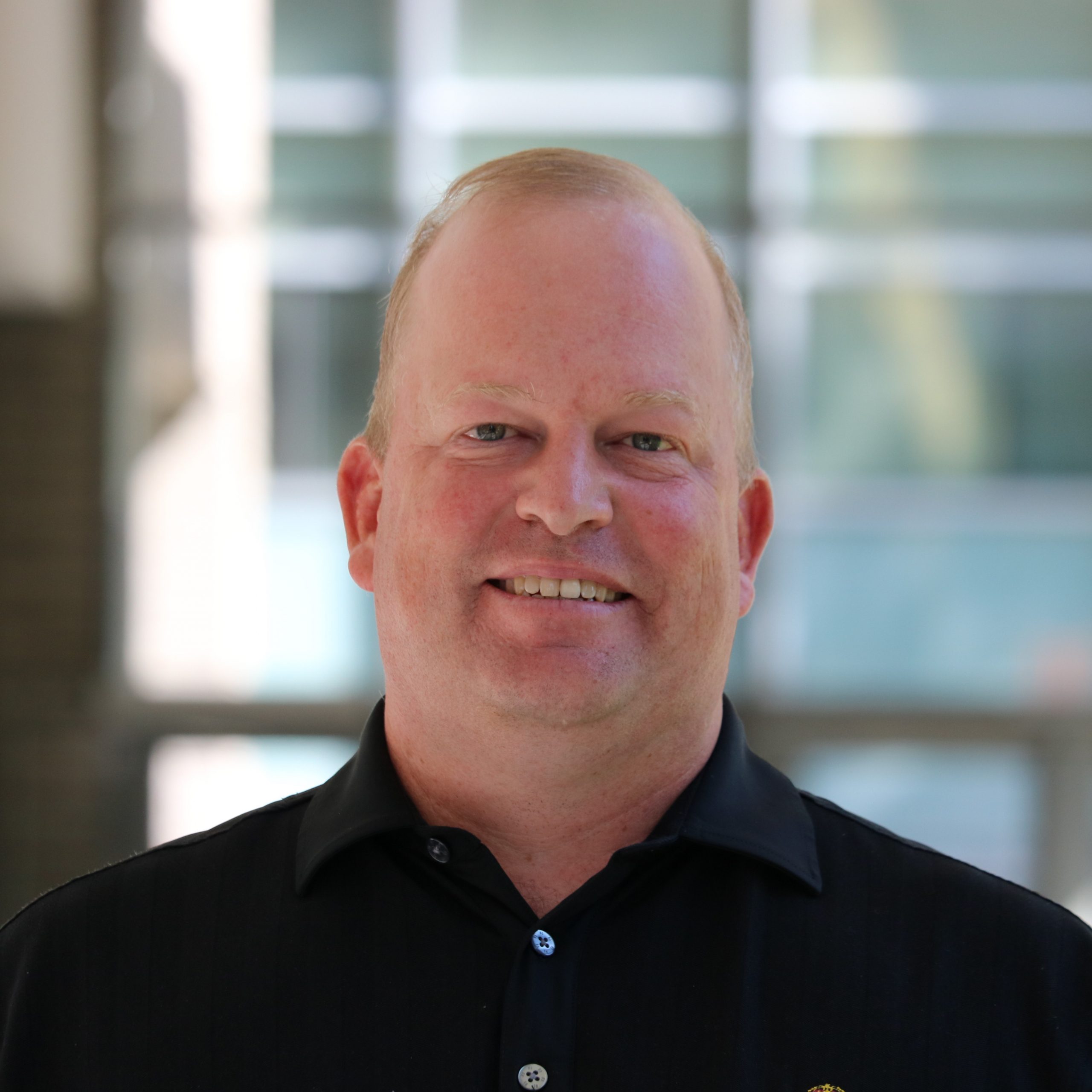
Michael Van Bussel, PhD, has over 18 years of academic, administrative, and service experience in Sport Management. His educational background includes a PhD focusing on Sport Law and Policy Studies from Western University. He held faculty positions at Jacksonville University and Wilfrid Laurier University in the field of Sport Management. He has won awards in teaching and coaching and was named OUA (USPORT) Provincial Coach of the Year on two separate occasions with the Western University Women’s Soccer Program. His research interests include sport law, risk management, governance and policy, and coach/athlete communication.
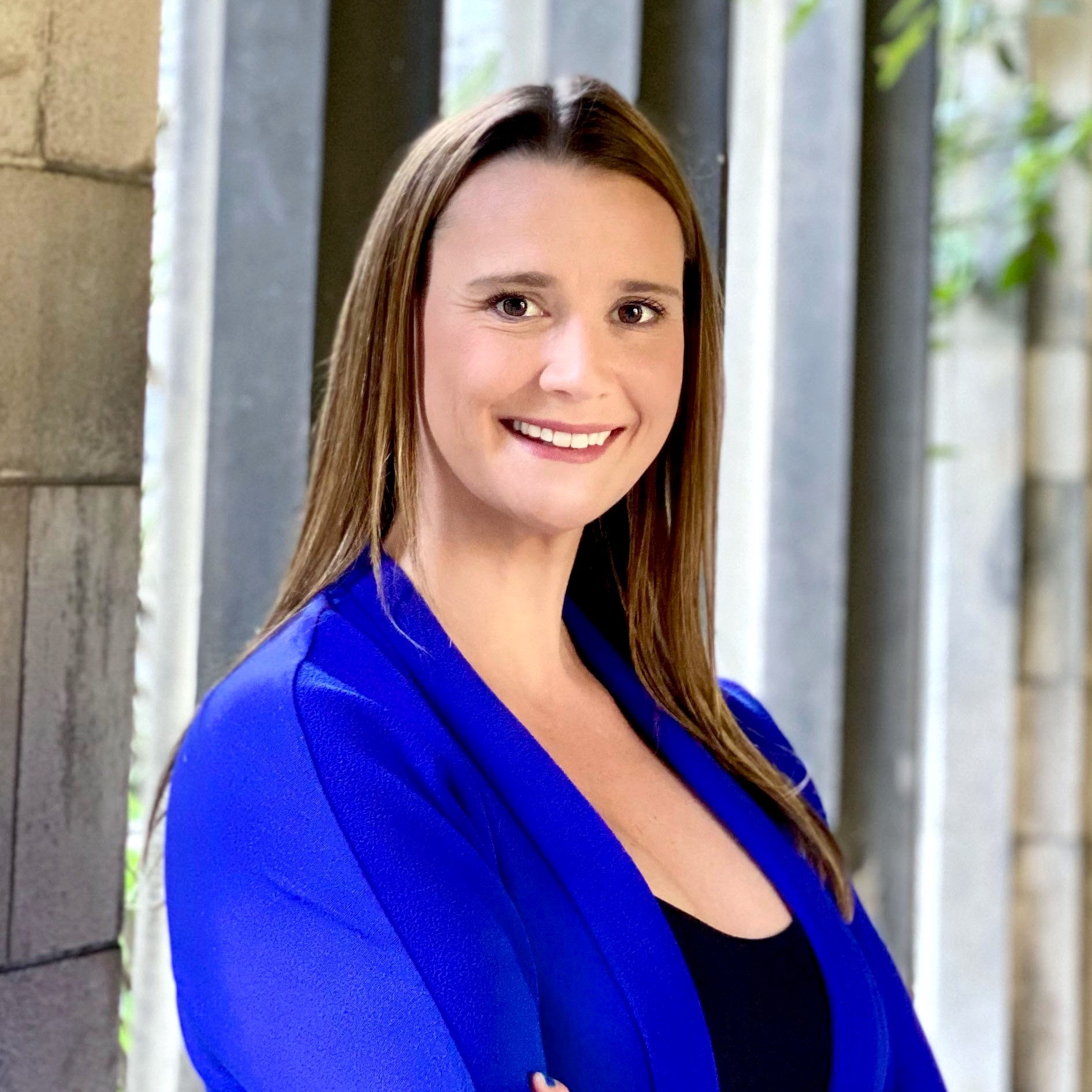
Erin Willson, MSc, is currently a PhD candidate in the Faculty of Kinesiology and Physical Education at the University of Toronto. Her areas of research interest include maltreatment in sport, athlete empowerment and advocacy. Erin also sits on the Board of Directors at AthletesCAN. As a former Olympian, Erin brings a unique perspective to her research endeavors.
6




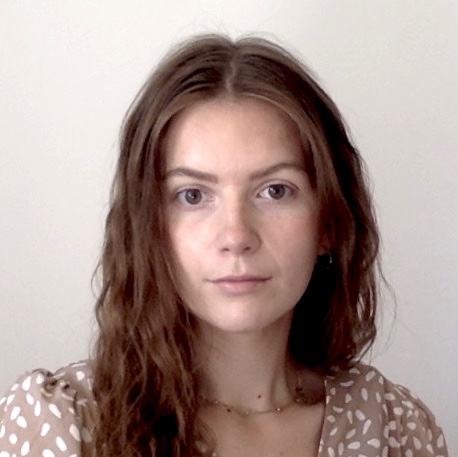

Four Brock University students reviewed sample chapters of this edited book in November 2021. We are grateful for the insight and comments of:
Brock University’s Centre for Pedagogical Innovation (CPI) provided assistance in the realm of grant writing, accessibility, technology-enabled learning, and general support of our instructional design methods. We are grateful for the services of:
7
Creating an open access online resource like this is beneficial because it offers high-quality scholarship and professionally researched materials for free to anyone who is interested in the topic of safe sport. Open access resources like Safe Sport: Critical issues and practices ensure a secure transfer of knowledge from trusted sources for learners and for organizations looking to educate their members and the general public, many of whom are working with limited resources. By making this resource open access, this critical information is available to a wider audience, many of whom might not have the funding or resources to acquire such a book.

This is achieved through Accessibility for Ontarians with Disabilities Act, 2005 (AODA) compliant design and coding, captioning and transcription of all video and audio components, and full written descriptions for all figures and diagrams. We have also provided links to external resources, news articles, videos and podcasts for learners to explore particular issues in depth. There is also an abridged French version of this book, showcasing select chapters for learners looking to read about safe sport in both official languages.
The tools used to build this safe sport edited book are structured to ensure that our content reflects the POUR principle, meaning that the resource is Perceivable, Operable, Understandable, and Robust. The Universal Design for Learning (UDL) framework used in the creation of this edited book provides multiple ways for learners to engage with content and demonstrate their knowledge. For example, chapters includes interactive content, audio recorder/written response opportunities, and videos. A student focus group review was conducted prior to publishing, and their feedback was incorporated into the pedagogical approaches taken towards the chapters.
This edited book is a unique resource that has the potential to benefit a wide range of students, educators and professionals.
It may be used by learners at a university or college across several disciplines such as sport management, kinesiology, physical education, recreation, law, sociology, history, social justice, gender studies, child and youth studies, and policy studies. It is this generation of students who represent the next generation of coaches, parents and sport organizers who must implement the necessary changes required to realize the safe sport goals outlined in this resource. As such, they need to have access to these critical research and training materials.
This edited book is a robust resource for researchers examining legal, social, ethical, and managerial issues in sport. It also targets professionals who work across public, nonprofit, and commercial sectors, as well as Canadian sport organizations at all levels who must lead programs and services where safe sport issues must be addressed. Finally, this book is useful to community and grassroots organizations as educational training materials for their members and volunteers.
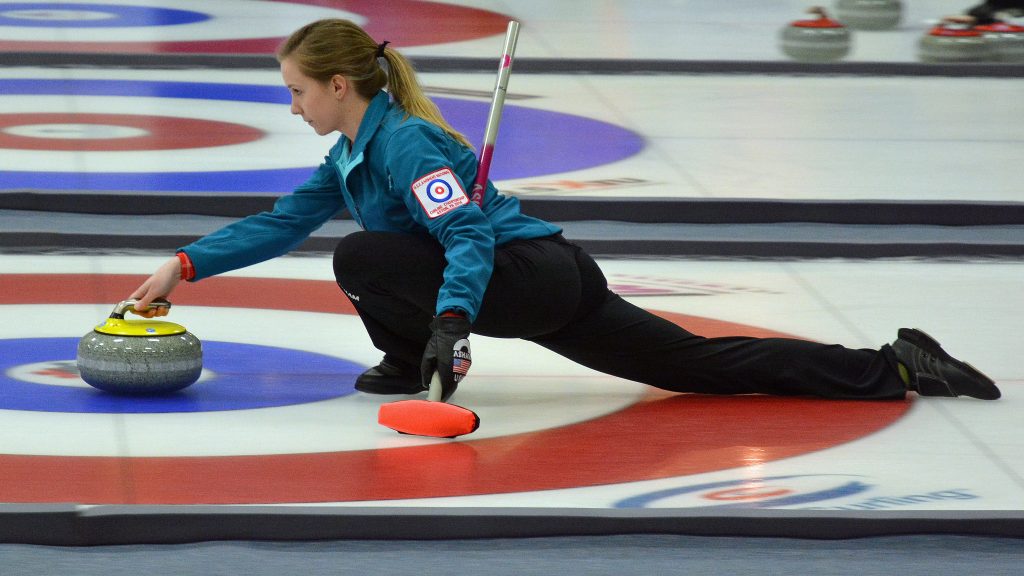
The blocks of text in this edited book are split up with interactive figures and colourful text boxes designed to directly engage learners with the material. Instructors may utilize these text boxes, which contain relevant content and thought-provoking questions, for student assignments. These include the following:
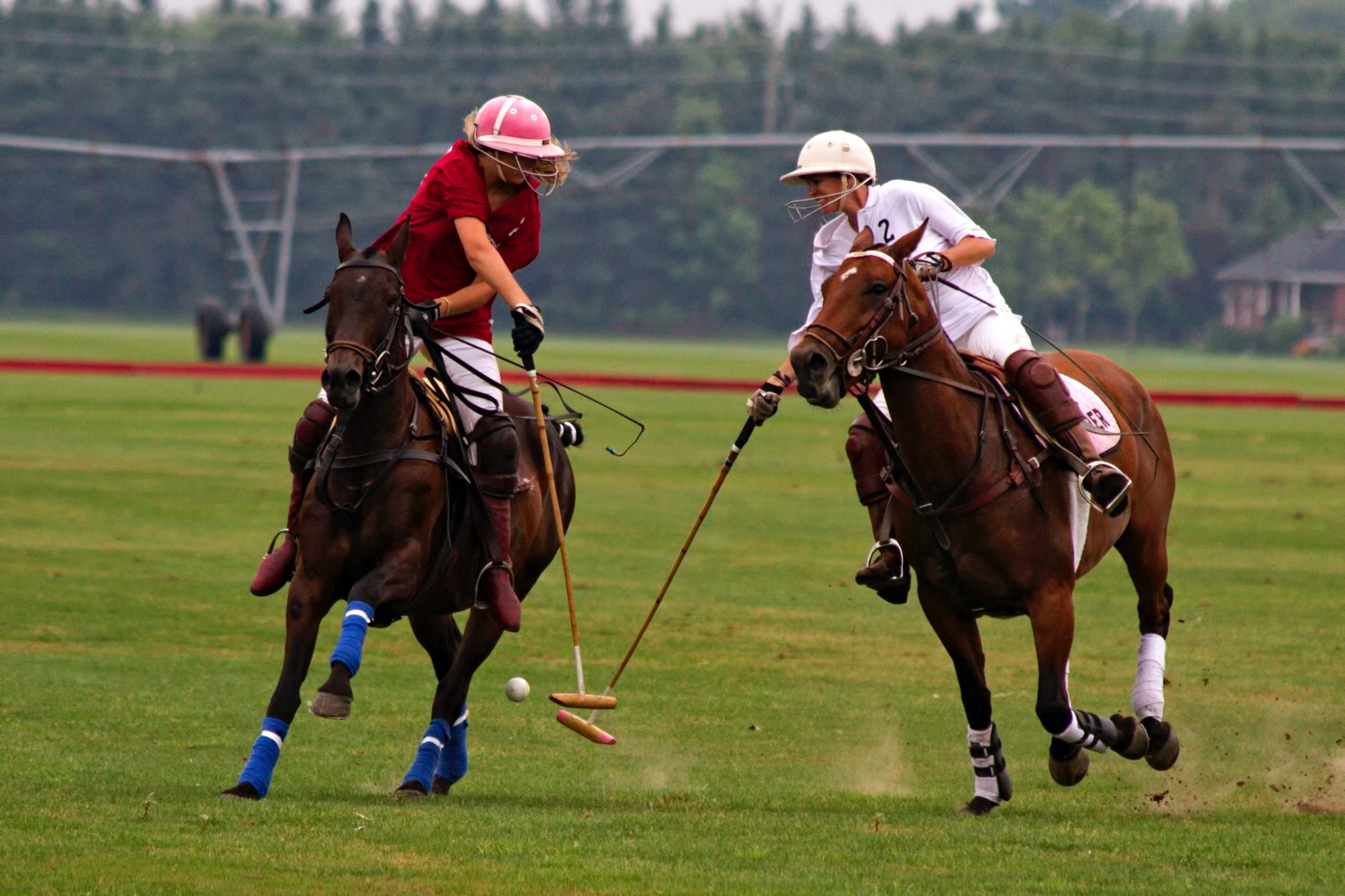
In addition to text boxes, there are multiple chapter sections that are useful for both learners, educators and professionals. To ensure accessibility, we structured the chapters with proper heading hierarchies as well as colour coding and icons to facilitate simpler way-finding throughout the text.
8
Figure 2.1 Differentiation Between Relationships and Terms Including Bullying, Abuse, and Harassment
Figure 2.2 Characteristics of an Athlete-Centred System
Figure 4.1 Examples of “Troubling” Sport Organization Governance and Practices
Figure 5.1 Opportunities to Play for University Men and Women
Figure 5.2 Sport Ecosystem
Figure 5.3 IDEA: Inclusion, Diversity, Equity, and Accessibility
Figure 5.4 Chapter Five Review
Figure 6.1 Legal Relationships Between SDRCC, Sport Organizations and Participants
Figure 6.2 Pyramidal Structure of Sport Hierarchy
Figure 6.3 Contractual Options for Acquiring Jurisdiction at National Level
Figure 7.1 Pathway of a Complaint in the Investigative Phase
Figure 7.2 Types of Evidence Matching Exercise
Figure 7.3 Standards of Proof Illustrated
Figure 8.1 Parties Involved in Dispute Resolution
Figure 8.2 SDRCC Tribunals
Figure 8.3 Hierarchy of Canadian Courts and Tribunals
Figure 8.4 Decision-Making Hierarchy in Sports System
Figure 9.1 Dispute Scenarios for Post-Investigation Decisions
Figure 9.2 Scope of Review Options
Figure 9.3 Standards of Review and Deference to Original Decision-Makers
Figure 9.4 Burdens of Proof as a Sporting Analogy
Figure 9.5 Standards of Proof Illustrated
Figure 9.6 Ambiguities in Language
Figure 9.7 Principles Relevant to an Arbitrator’s Review of an Original Decision with UCCMS Interpretation
Figure 10.1 Pathways for Challenging a Sport Maltreatment Arbitration Decision
Figure 10.2 Objectives of Publicly Reporting Sanctions in the Sport Maltreatment Context
Figure 10.3 PIPEDA Information Principles
Figure 10.4 Contractual Relationships in Sport to Enforce Sanctions
Figure 11.1 True Sport Member Type Infographics
Figure 12.1 Disciplines of Gymnastics
Figure 12.2 GymCan Organisational Structure
Figure 12.3 Gymnastics Canada Vision, Mission, Overarching Goals, and Values
Figure 12.4 Sample Skills and Responsibilities of a Safe Sport Portfolio Position
Figure 12.5 GymCan’s Six Key Steps to Developing the 2018 Safe Sport Framework
Figure 12.6 Phases of Safe Sport Policy Revitalization
Figure 13.1 Relational Risk Management Plan
Figure 14.1 Coaching Association of Canada Values
Figure 14.2 Sport Coaching Research
Figure 14.3 Pathways to Chartered Professional Coach (ChPC) Designation
Figure 14.4 A Socio-Ecological Model to Inform Safe Sport
Figure 14.5 Individuality and Lived Experiences of Participants
Figure 14.6 CAC’s Responsible Coaching Movement
Figure 14.7 The Rule of Two
Figure 14.8 The CAC Safe Sport Journey 2015-2021
Figure 15.1 Rules Classification
Figure 15.2 Safe Sport Environment
Figure 16.1 Why Female Basketball Referees Leave the Game
Figure 17.1 Reasons for not Reporting
Figure 17.2 Steps to Realize the UCCMS
9
Table 2.1 Maltreatment Types and Examples
Table 7.1 Overlap Between Definitions of Maltreatment under UCCMS and Canadian Criminal Laws
Table 7.2 Summary of Duty to Report under Provincial/Territorial (P/T) Child Welfare Legislation
Table 8.1 Safeguards for Ensuring Arbitrator Independence and Impartiality in Sport Maltreatment Cases
Table 9.1 International Comparison of Scope of Review and Procedural Rules
Table 9.2 Summary of CAS and SDRCC Confidentiality Rules
Table 9.3 Purposes of Disclosing Arbitration Decisions and Relevant Considerations
Table 9.4 Privacy Rules in Sport Maltreatment Arbitration Context
Table 10. 1 Grounds for Setting Aside an Arbitration Decision
Table 12.1 GymCan Key Objectives for Safe Sport Advocacy Initiatives
Table 17.1 Summary of Canadian Prevalence Study of National Team Member Maltreatment Experiences
10
Video 1.1 Julie Stevens: A Summary of the Athletes’ Voices Panel
Video 1.2 Julie Stevens: A Summary of the Governance and System Re-Engineering Panel
Video 2.1 Erin Willson: Body Image and Belittling Athletes
Video 2.2 Allison Forsyth: What is Complicity?
Video 2.3 Danielle Lappage: Attending the AthletesCAN Safe Sport Summit
Video 2.4 Camille Bérubé: An Athlete’s Perspective on Safe Sport
Video 2.5 Neville Wright: An Athlete’s Perspective on Racial Discrimination in Sport
Video 2.6 Erin Willson: The Definition of Safe Sport
Video 3.1 Bruce Kidd: Sport and the Struggle for Inclusion
Video 3.2 Bruce Kidd: The Fight for Gender Equity in Canadian Sport
Video 3.3 Bruce Kidd: The Long Struggle for Safe Sport
Video 4.1 National Sports Governance Observer: Play the Game
Video 4.2 Peter Donnelly: Athletes Rise
Video 11.1 A Recipe for Good Sport
Video 11.2 The Power of True Sport
Video 11.3 True Sport Lives Here Manitoba
Video 11.4 The Ride Home
Video 14.1 Safe Sport Training Promo, CAC
Video 14.2 Isabelle Cayer: Sport is in a Culture Renovation
Video 14.3 Isabelle Cayer: Support Through Sport Series
Video 17.1 Gretchen Kerr: Why Safe Sport Now?
Video 17.2 Gretchen Kerr: Athletes’ Fear of Repercussions
Video 17.3 Gretchen Kerr: Studying Athletes’ Willingness to Report Incidents
Video 17.4 Gretchen Kerr: The Duty to Report Concerns in Sport
11
You’ll notice throughout this edited book that in the beginning of every chapter, there is a list of Key Dates that pertain directly to its content. The Key Dates listed below provides a master compilation of important dates from each of the chapters in this book, showing the interconnectedness of important themes and historic moments in the movement towards safer sport.
Click the arrows and scroll through the list to learn more about where we currently stand in this journey, and how we came to be here.
An interactive H5P element has been excluded from this version of the text. You can view it online here:
https://ecampusontario.pressbooks.pub/safesport/?p=76#h5p-1
12

This project is made possible with funding by the Government of Ontario and through eCampusOntario’s support of the Virtual Learning Strategy. To learn more about the Virtual Learning Strategy visit https://vls.ecampusontario.ca
I
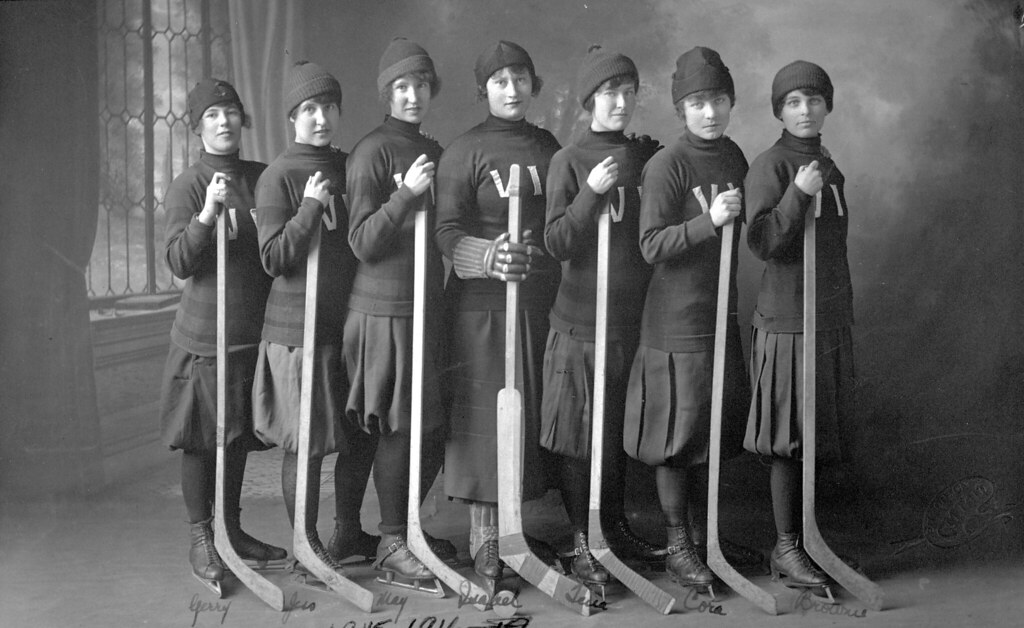
In Part 1, Julie Stevens, PhD, Professor of Sport Management at Brock University, briefly frames the safe sport edited book within current academic and professional contexts and explains the importance of understanding these selected contributions if safe sport progress is to be made in the Canadian sport system.
1
Julie Stevens
I am excited to share with you this book on safe sport. Comprised of 18 chapters from 21 contributors across academic and professional realms, the book offers current and insightful commentary that addresses athlete, governance, human rights, legal, coaching, and officiating issues.
The creation of this open education resource (OER) was driven by a compelling necessity to ensure safe sport experiences for all athletes within all contexts. The organizers of the 2021 Safe Sport Forum hosted by the Centre for Sport Capacity at Brock University took this athlete-focused approach seriously. During our planning and staging activities, we were unified around two key priorities: First – that athletes be at the forefront of the discussion and second – that the discussion would continue beyond the Forum!
The first priority manifested in the Forum name – Athletes First: The Promotion of Safe Sport in Canada, an athlete panel to launch the program, and the positioning of athletes as the central beacon for shared discussion among attendees. The sessions applied various perspectives to address the harassment and abuse of athletes, and the lack of administrative action in these instances which have been highlighted in recent cases in the media and the courts. Most importantly, the Forum acknowledged that the long-term negative ramifications of a failure to ensure safe sport for athletes at all levels of the Canadian sport system is a significant issue that requires discussion and action.

As someone who has held several roles in sport, including scholar, volunteer, coach, official, parent, advocate and most importantly, athlete, I have tried to cultivate a safe and respectful environment when I engage with others through sport. Finding a way to keep this focus at the forefront was a personal endeavour. But during a recent strategic planning session I attended, I learned about a perspective that Jeff Bezos has implemented in Amazon for a very long time – aptly described as the “One Empty Chair Rule.”Anders, G., 2012. The rule ensures that an empty chair is placed at the table in order to make certain the customer is top-of-mind at every company meeting.Koetsier, J., 2018. Bezos refers to his mantra as “customer obsession”.
The “Empty Chair” approach resonated with me and stirred thoughts about how it might guide safe sport innovation within the Canadian sport system. The lens made me think of ways a consistent positioning of the athlete – which in sport is the central stakeholder – at the forefront of decision-making might enhance safe sport. What if an empty chair is placed at the table at every meeting where sport leaders make decisions in order to ensure the athlete is top-of-mind?
Athlete-centredness is not new to the sport conversation. In the 2000s, criticism grew over the excessive bureaucracy, corporatization, and results-based orientation of the Canadian high- performance sport system. Calls for change, such as the introduction of athlete-centred initiatives have been made within the Canadian sport system.Thibault, L.& Babiak, K., 2005. The discussion has expanded into various areas of sport, such as anti-doping policy, and beyond the Canadian border to engage a global dialogueGrigaliūnaitė, I. & Eimontas, E., 2018. and competition at the international level.Ciomaga, B., Thibault, L., & Kihl, L., 2017. Further, arguments for a ‘deliberate democracy’ lens were raised as a concept that might counter power imbalance within the sport system and open the door for athletes to engage in decision-making.Kihl, L., Kikulis, L., & Thibault, L., 2008.

Extending upon the notion of power, the politics of athlete-centredness in a sport system has been examined in the context of performance enhancement drugs resulting in claims that anti-doping policy development fails to include athletes as policymakers.Jackson, G. & Ritchie, I., 2007. More recent work connects athlete input with sustainable elite sport in relation to coaching, holistic perspectives, and the co-creation of an athlete’s overall development.Dolsten, J., Barker-Ruchti, N. & Lindgren, EC., 2019. Interestingly, a review of athlete representation within the decision-making forum of major sport event properties has revealed that Paralympic athletes have a vote through the International Paralympic Committee Athlete Council, whereas the voting representation of Olympic Games and Commonwealth Games athletes is not as evident.MacIntosh, E. & Weckend Dill, A., 2015.
While these works demonstrate how athlete-centredness has been addressed over the past 20 years, the difference now is momentum – the sport community seems far more resolute about hearing from athletes with respect to their view of a safe sport experience.
Hence, this book about safe sport begins with the athlete voice!
In Part 2, Erin Willson and Georgina Truman (AthletesCAN) share powerful insight about the athlete experience in relation to safe sport. The research they address demonstrates the importance of gathering athlete voices, including voices at the lower levels of the sport system, expanding our individual awareness and building our collective awareness about safe sport. It is critical to communicate and implement safe sport policies in ways that align with the level of the athlete.
Video provided by Brock University Centre for Sport Capacity. Used with permission. [Transcript]
Part 3 includes three chapters that draw upon different perspectives to examine how athletes are positioned within a larger sport system. Bruce Kidd examines the historical struggle for safe sport within a system fraught with contested terrain. Peter Donnelly critiques the long-standing autonomy of sport and argues that reengineering the way sport organizations operate will increase safe sport accountability. Finally, Leela MadhavaRau and Talia Ritondo propose encompassing a human rights framework into the broader context of safe sport and discuss how safe sport can be achieved.
Video provided by Brock University Centre for Sport Capacity. Used with permission. [Transcript]
Part 4 provides an exceptionally comprehensive five-chapter account of safe sport legal considerations. Hilary Findlay and Marcus Mazzucco examine key legal issues that arise from the creation of an independent body to oversee the implementation of the Universal Code of Conduct to Prevent and Address Maltreatment in Sport (UCCMS) and ensure the fair, transparent and effective management of reported cases of maltreatment. They break down the role of the new independent body in relation to four phases – jurisdiction, investigation, dispute resolution and enforcement. Understanding the legal aspects of the UCCMS as it becomes a mandatory element of the federal sport system, and possibly provincial/territorial and local levels of sport, is critical for students, researchers, professionals and other stakeholders within the Canadian sport system.
Part 5 offers two “from-the-field” exemplars from sport organizations that have effectively developed safe sport policies and practices. Kasey Liboiron and Karri Dawson (True Sport) champion the True Sport values-based approach to sport as a fundamental foundation for the intentional integration of effective safe sport policy by stakeholders throughout the sport system. Ellen MacPherson and Ian Moss (Gymnastics Canada) offer an insider account of the initiatives Gymnastics Canada completed in order to develop, support and foster safe sport throughout the organization.
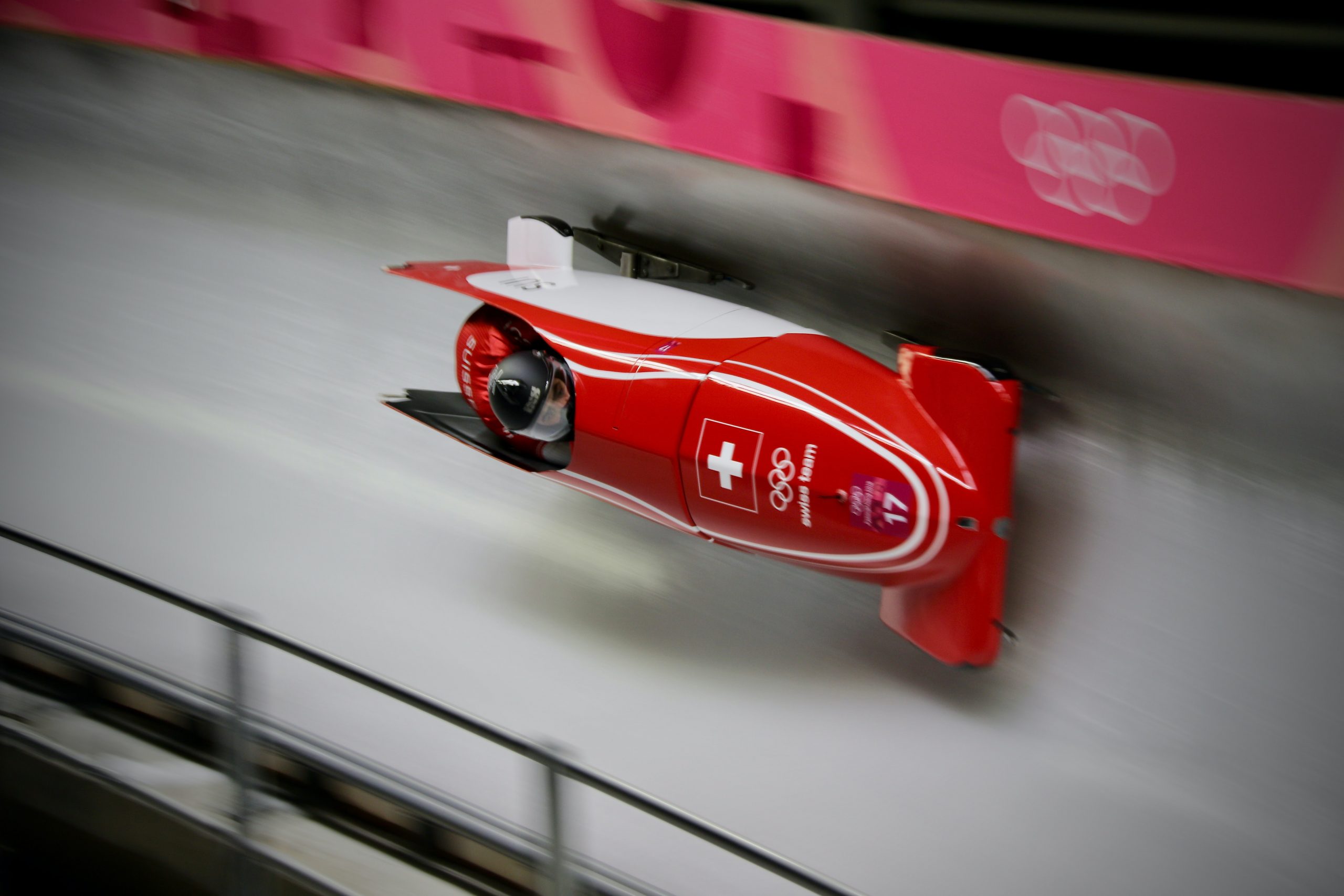
Part 6 shifts the focus to coaches where two chapters address the role a coach plays in a safe athlete experience. Michael Van Bussel and Kirsty Spence outline how a care-driven model and relational risk management plan offer a constructive guide for safe sport relationships among athletes, coaches, and administrators. Isabelle Cayer and Peter Niedre (Coaching Association of Canada) explain the culture shifts that have impacted the safe sport movement and various actions to offer and promote training and coach education across the country.
Part 7 highlights sport officials as the lesser known yet essential stakeholder of the sport ecosystem. Spanning two chapters, Lori Livingston and Susan Forbes address the purpose of rules and their role in creating safe playing environments, and outline the role of officials and how officials have been historically maltreated by spectators, coaches and athletes.
Part 8 concludes the book by looking ahead to what needs to happen in order for the UCCMS to be realized. In one chapter, Gretchen Kerr explains why the UCCMS represents only a first step in the safe sport journey and suggests next steps must include the need for independent complaint and adjudication mechanisms, and extending the notion of safe sport beyond the prevention of harms to include optimization of the sport experience. In a second chapter, Michele Donnelly offers a summary of where we currently stand in this safe sport movement, and an important perspective on what steps need to be taken next to put the UCCMS words into action.
In conclusion, the wealth of information in this book offers ways we can counter challenges of structure in order to commit to safe sport values and enact these values through policies and programs. One resounding theme the authors have communicated in their own unique way is that safe sport requires effort from a variety of stakeholders (including you) at every level of the sports system. My hope is to build upon this initial edition by adding new chapters that respond to the evolving conversation about safe sport in our communities.
I am excited to share these insightful scholars and professional accounts from across the sport system, and to work with you to build ways of keeping the “Athletes First” focus at the forefront of our ongoing and collective safe sport efforts.
Yours in safe sport,
![]()
Sources
42 Courses. (October 16). Jeff Bezos’ one empty chair rule. Retrieved January 27, 2022, from https://blog.42courses.com/home/2018/10/16/jeff-bezos-one-empty-chair-rule.
Anders, G. (2012, April 4). Inside Amazon’s idea machine: How Bezos decodes customers. Forbes. Retrieved January 27, 2022, from https://www.forbes.com/sites/georgeanders/2012/04/04/inside-amazon/?sh=ec2d00461998
Ciomaga, B., Thibault, L., & Kihl, L. (2017). Athlete involvement in the governance of sport organizations. In M. Dodds, K. Heisey, & A. Ahonen (Eds.), RouthledgeHandbook of International Sport Business. London: Routledge.
Dolsten, J., Barker-Ruchti, N., & Lindgren, E. C. (2019). Sustainable elite sport: Swedish athletes’ voices of sustainability in athletics. Qualitative Research in Sport, Exercise and Health, 13(5), 727-742. DOI: 10.1080/2159676X.2020.1778062.
Grigaliūnaitė, I. & Eimontas, E. (2018). Athletes’ involvement in decision making for good governance. Baltic Journal of Sport and Health Sciences, 3(110), 18-24. https://etalpykla.lituanistikadb.lt/object/LT-LDB-0001:J.04~2018~1579623660997/J.04~2018~1579623660997.pdf
Jackson, G. & Ritchie, I. (2007). Leave it to the experts: The politics of ‘athlete-centeredness’ in the Canadian sport system. International Journal of Sport Management and Marketing, 2(4), 396-411.
Kihl, L., Kikulis, L., & Thibault, L. (2008). A deliberative democratic approach to athlete-centred sport: The dynamics of administrative and communicative power. European Sport Management Quarterly, 7(1), 1-30.
Koetsier, J. (2018, April 5). Why every Amazon meeting has at least 1 empty chair. Inc. Retrieved January 27, 2022, from https://www.inc.com/john-koetsier/why-every-amazon-meeting-has-at-least-one-empty-chair.html
MacIntosh, E., & Weckend-Dill, A. (2015). The athlete’s perspective. In M. Parent & J. L. Chappelet (Eds.), Routledge Handbook of Sports Events Management. London: Routledge.
Thibault, L. & Babiak, K. (2005). Organizational changes in Canada’s sport system: Toward an athlete-centred approach. European Sport Management Quarterly, 5(2), 105-132.
II

Understanding safe sport from the athlete’s perspective is vital as we continue working through safe sport issues in Canada. In Part 2, experts from AthletesCAN, which is the independent association of Canada’s national team athletes, highlight the different forms of maltreatment that athletes experience. Erin Willson and Georgina Truman identify the many ways in which athletes have influenced the Canadian safe sport system, especially in recent years. They also explain the athlete-centred approach to safe sport, and its importance in minimizing maltreatment within sport.
2
Erin Willson
Georgina Truman
Maltreatment in sport
Athlete-Centred approach
Change implementation
When you have completed this chapter, you will be able to:
L01 Identify four types of maltreatment;
L02 Draw connections between athlete advocacy and changes in sport;
L03 Identify 3 key changes;
L04 Explain how the athlete voice has led to key changes; and
L05 Identify key components of the athlete-centred approach. Provide suggestions to implement an athlete-centred sport system.
Maltreatment has become an increasingly documented concern in sport. For example, a 2019 study on Canadian National Team athletes revealed that 75% of athletes reported experiencing at least one harmful behaviour in their careers, with psychological harm and neglect being most common, followed by sexual and physical harm.Willson et al., 2021 In Canada, the athlete’s voice has been an essential component of advancing the safe sport movement, which gained traction in 2018.
First, national team athletes completed a survey on their experiences of maltreatment,Kerr et al., 2009 which was closely followed by a gathering of athletes at the 2019 AthletesCAN Safe Sport Summit, in which reviewed the findings and established consensus statements on the prominent findings and next steps (e.g., a need for an independent body for disclosure/reporting).AthletesCAN, 2019 These statements were presented at a National Safe Sport Summit, which included athletes, national sport organizations and multisport organizations, and led to the formation of a safe sport advisory board and action planning working group.
Since then, a Universal Code of Conduct to Prevent and Address Maltreatment in Sports (UCCMS) has been established and implemented, and a National Independent Mechanism (NIM) is being established by the Sport Dispute Resolution Centre of Canada (SDRCC). This chapter provides an overview of past actions athlete leaders have had in safe sport, including key learnings from this experience about why we believe the athlete’s voice is an essential component of driving change in sport.
This chapter includes multi-media content (videos/audio) of Canadian athletes sharing their experiences with maltreatment, disclosure/reporting concerns, and using their voices to create change. Additionally, it will provide an athlete’s perspective on what is essential to continue the movement toward a safer sport environment, and some practical examples of what safe sport looks like from the eyes of an athlete.
An interactive H5P element has been excluded from this version of the text. You can view it online here:
https://ecampusontario.pressbooks.pub/safesport/?p=112#h5p-2
There has been mounting evidence of all forms of maltreatment occurring in sport around the world, including physical, sexual, and emotional abuse. Over the past decade, several high-profile cases have emerged, including the USA Gymnastics case in 2016, in which the team’s doctor Larry Nassar was sentenced to 175 years in prison after two hundred athletes came forward with experiences of sexual abuse.Levenson, 2018 The investigation also revealed a culture of emotional abuse and neglect that is rampant in the sport of artistic gymnastics. Athletes around the world have disclosed experiences of body shaming, forced extreme dieting and water restriction, training on injuries and concussions, and frequent public humiliation and beratement.Gymnastic Alliance, n.d.; Levenson, 2018 The USA Gymnastics case was not an isolated incident, with many sports facing similar cases and public allegations, including swimming, alpine skiing, rugby, and artistic swimming.Davison, 2021; Ehekircher, 2020; Longman & Brassil, 2021; Muchnick, 2021 For instance, the British Athletes Commission called for a full investigation of British Gymnastics after several disturbing allegations of bullying and abuse arose in 2020.Ingle, 2021
There have also been research studies conducted from several countries which assessed the prevalence of maltreatment occuring in Canada, Belgium, the Netherlands, and the United Kingdom. These studies have indicated high rates of athlete maltreatment in areas including psychological abuse, neglect, physical abuse, and sexual maltreatment across sport.Alexander et al., 2011; Kerr et al., 2019, Parent & Vaillancourt-Morel, 2020; Vertommen et al., 2016 For example, in a study of Canadian National Team athletes, seventy-six percent of athletes from sixty-four sports reported at least one experience of maltreatment in their athletic careers.Kerr et al., 2019
In response to the growing awareness of maltreatment, several prevention and intervention initiatives have been instated. Some Canadian examples include the educational programs by Respect Group’s “Respect in Sport for Activity Leaders”, the Coaching Association of Canada’s Safe Sport Training, and mandatory requirements and standards for federally funded sport organizations, including third party reporting officers.
Most recently, a Universal Code of Conduct to Prevent and Address Maltreatment in Sport (UCCMS) has been implemented to outline all forms of harm in sport that are not acceptable. Furthermore, a National Independent Mechanism (NIM) has been developed to prevent and address maltreatment, and provide an independent body for athletes to report maltreatment. The latter initiatives were heavily influenced by athletes who had spoken out about personal experiences of maltreatment, highlighting the importance that the athletes’ voices carry in the movement towards a safer sport environment. In this chapter you will:
Sport participation offers many benefits that lead to physical, social, and mental well-being (Hansen et al., 2003, Neely & Holt, 2014). However, it is important to acknowledge that there are athletes whose sport experiences have been harmful due to various forms of maltreatment.Willson et al., 2021; Vertommen et al., 2016 Maltreatment refers to: “all types of physical and/or emotional ill-treatment, sexual abuse, neglect, negligence and commercial or other exploitation, which results in actual or potential harm to health, survival, development or dignity in the context of a relationship of responsibility, trust or power”.World Health Organization, 2020
| Type of Abuse | Example |
|---|---|
| Sexual Abuse | Touching or non-touching offenses (e.g., contact, exposure) |
| Physical Abuse | Punching, beating, kicking, biting |
| Psychological Abuse | Yelling, belittling, demeaning comments, humiliation |
| Neglect | Refusing recovery time of injury/illness, inadequate supervision, inadequate attention of basic needs |
| Bullying | Teammate exclusion, theft, teasing |
| Hazing | Initiation specific activities – drinking excessively, personal servant, performing criminal activities |
Power is a fundamental component of maltreatment because violence is often used to assert or maintain dominance over another person.Hu & Liu, 2017; Pense & Paymer, 1986; Russo & Pirlott, 2006 One example of a use of power to establish dominance is veteran athletes using their status as a means to force newcomers to partake in harmful hazing activitiesAllan et al., 2019; Waldron et al., 2011
Hazing is frequently cited as a way for athletes to “know their place” on a team, which reinforces the player hierarchy with senior athletes holding their position of power over junior or new athletes.Waldron et al., 2011 As such, hazing is an example of maltreatment that can happen between peers. Although hazing can result between peers when a power differential occurs through age, rank, seniority, or skill level, it is important to note that athletes are typically prescribed equal amounts of power in the sport system making hazing between peers less likely to be addressed at an institutional level.Kerr et al., 2016
There are several relationships in sport that have predisposed imbalances of power, which can often leave athletes vulnerable. Examples of these relationships include coach-athlete, team captain-athlete, trainer-athlete, and sport administrator-athlete (e.g., CEO of an NSO, high-performance director). Within each of these relationships, athletes are seen to be in a lower position of power since the other roles are positions of authority. Moreover, there is increased vulnerability because of the culture of control and obedience that is instilled throughout sport.
Athletes are taught to respect these positions of authority, which can lead to an unquestioned compliance to the demands from someone in a higher position (e.g., coach).Brackenridge, 1994; Burke, 2001 Moreover, this compliance is often expected from those people who are in positions of power. This power imbalance and unquestioned compliance can significantly reduce an athlete’s power since they are conditioned not to deviate from what is expected of them.
Therefore, our stance at AthletesCAN is to empower athletes by including them in important conversations about their training in order to lessen the power imbalances inherent in sport. It is our hope that steps taken to nurture athlete empowerment will contest traditional methods of coaching and reduce athlete vulnerability .
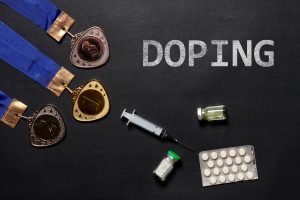
For more insight about the history of athletes’ involvement in the high-performance sport system, review these resources. In his 2006 thesis and co-authored research article with Dr. Ian Ritchie, Greg Jackson examined the involvement of athletes in Canada’s anti-doping policy process.
Several terms are frequently interchanged when discussing maltreatment in sport. Therefore, this section provides an overview of the different terminologies that are used. Figure 2.1 outlines these terms in a more concise way and is broken down based on the positions of power. The figure indicates that a misuse of power is the underlying mechanism of harm. Abuse is harm that occurs between two actors, with one person having significant influence over another’s sense of security, trust, and/or fulfillment of needs.Crooks & Wolfe, 2007 This is often known as a “critical relationship,” and in sport this can be relationships between athletes and authority figures that commonly interact (e.g., coaches, parents, etc.). Maltreatment between peers is referred to as bullying since athletes are typically within the same prescribed social rank, and in most instances do not have the power differential of a critical relationship. Harassment is maltreatment that occurs outside of a critical relationship. There is typically a power imbalance that occurs between the two actors; however, the perpetrator does not have a direct influence on the others sense of safety or trust. Examples of this could be a sport administrator that only interacts with the athletes occasionally. At the bottom of the diagram are the types of harm that can occur, which will be discussed in the following section.
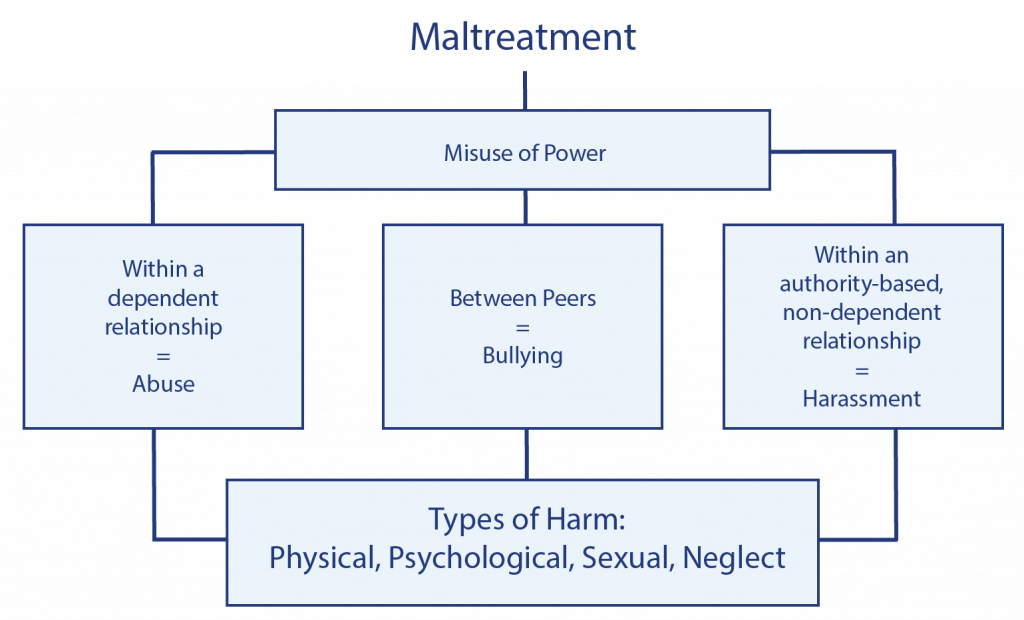
Psychological harm in sport is defined as “a pattern of deliberate non-contact behaviours that have the potential to be harmful” (Stirling & Kerr, 2008, p. 178). Psychological abuse has been found to be the most frequently experienced type of harm by athletes.Alexander et al., 2011; Vertommen et al., 2016; Willson et al., 2021 Psychological abuse accounts for many harmful behaviours including being yelled at and publicly humiliated. Given the nature of sport, these types of harmful behaviour occur routinely, resulting in the normalization of abusive behaviour and higher rates of psychological harm. Simply put, these behaviours occur so frequently in public training environments that they have become accepted as “part of the game”.Stirling & Kerr, 2008
Stirling and Kerr (2008) have proposed examples of psychological harm, which include:
The most common behaviours reported by Canadian athletes in 2019 were being shouted at, being gossiped about or having lies told about them, and being put down, embarrassed or humiliated.Kerr et al., 2019
Video provided by Brock University Centre for Sport Capacity. Used with permission. [Transcript]
Physical harm is understood to be an infliction of physical pain or injury, which can include contact or non-contact behaviors.Durrant, 2006; Perry et al., 2002 Contact behaviours include hitting, slapping, and punching, whereas non-contact behaviours can include being forced to hold an uncomfortable position for a prolonged period of time.
Physical harm in sport can be:Stirling, 2009
Exercise as punishment (e.g., running laps when late, doing sprints because of poor performance) was the most frequently reported form of physical harm by Canadian athletes in 2019.Kerr et al., 2019
Sexual harm is understood as “Any sexual interaction with person(s) of any age that is perpetrated against the victim’s will, without consent, or in an aggressive, exploitative, coercive, manipulative, or threatening manner”.Ryan & Lane, 1997
Sexual harm in sport can be contact or non-contact including, but not limited to:
The most frequent forms of sexual harm reported amongst Canadian athletes were sexist jokes and remarks and intrusive sexual glances, sexually explicit communication, and sexually inappropriate touching.Kerr et al., 2019
Neglect is characterized by acts of omission or inaction.Brittain, 2006 Examples of this are intentionally ignoring someone or their needs, purposeful exclusion, or purposeful inaction.
Training when injured or exhausted, sacrificing education and/or career, training in unsafe conditions, and inadequate support of basic needs were the most frequently identified behaviours by Canadian athletes.Kerr et al., 2019
Video provided by Brock University Centre for Sport Capacity. Used with permission. [Transcript]

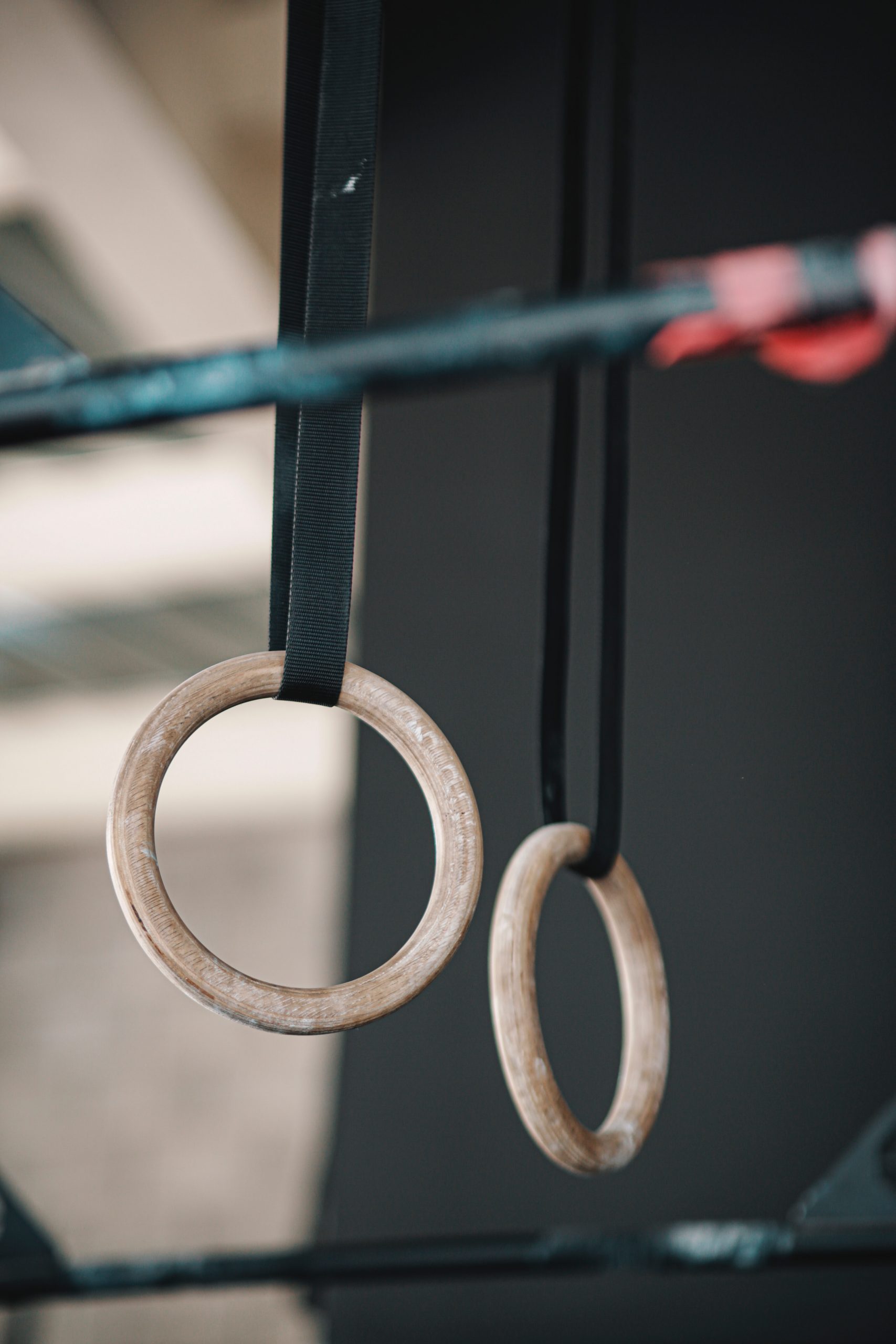
In the middle of the season, a high-performance gymnast was complaining of pain in her heel. Their doctor advised her to take it easy at practice for a month since it could lead to a tear in her Achilles’ heel. Her coach put her on a modified training program, so she would do primary upper body, core, and flexibility training on her own.
The athlete was mostly ignored by the coach because the coach would focus on the other athletes who were “there to train”. One example of the modified training was being told to hold a split position for five minutes on each leg and if her coach felt she was not as flat in her splits as she could be, then the coach would come by and press down on her shoulders to make her legs touch the ground.
Often, tears were formed in the athlete’s eyes because of the sharp pain this extra pressure would cause. She was diligent about training plan but if her coach ever saw her “taking it easy” even if it was for a water or bathroom break, the athlete would be yelled at from across the gym and humiliated in front of all the other gymnasts. As a consequence, she would be forced to complete one hundred push ups and one hundred sit ups to make up for the perceived lack of effort.
Two weeks before the upcoming qualification, the coach told her that if she did not start participating in full practices, she would not be allowed to compete in the qualification which meant she would not be eligible for the larger competitions that season. Knowing this, the athlete decided that she would train full-time against their doctor’s orders.
Which of the four types of harm are being seen here?
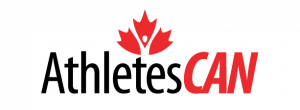 AthletesCAN, the association of Canada’s national team athletes, is the only fully independent and most inclusive athlete organization in the country and the first organization of its kind in the world. As the collective voice of Canadian national team athletes, AthletesCAN ensures an athlete-centred sport system by developing athlete leaders who influence sport policy and, as role models, inspire a strong sport culture.
AthletesCAN, the association of Canada’s national team athletes, is the only fully independent and most inclusive athlete organization in the country and the first organization of its kind in the world. As the collective voice of Canadian national team athletes, AthletesCAN ensures an athlete-centred sport system by developing athlete leaders who influence sport policy and, as role models, inspire a strong sport culture.
In 2019, AthletesCAN, in partnership with the University of Toronto, and with the support of the Government of Canada, announced that a baseline prevalence study would be carried out to provide a snapshot of Canada’s national team athletes’ experiences with abuse, harassment and discrimination in sport.
AthletesCAN, the association of Canada’s national team athletes, is the only fully independent and most inclusive athlete organization in the country. It is also the first organization of its kind in the world. As the collective voice of Canadian national team athletes, AthletesCAN ensures an athlete-centred sport system by developing athlete leaders who influence sport policy and, as role models, inspire a strong sport culture.
Mission: To unite and amplify the voices of all Canadian National Team athletes.
Vision: We are the collective athlete voice in the unwavering pursuit of an athlete-centred sport system.
Values: AthletesCAN promotes and lives the following athlete focused values in our work and through our actions
AthletesCAN serves an important and unique purpose in sport. Led by a committed group of current and retired national team athletes – AthletesCAN benefits from a rich history.
Over two decades ago, passionate trailblazers including three-time World Indoor Championship bronze medalist and Pan-Am Champion Ann Peel (Race Walking); two-time Commonwealth Games Champion and two-time Pan-Am Games silver medalist Dan Thompson (Swimming); ‘Crazy Canuck’ and Olympic bronze medalist Steve Podborski (Alpine Skiing); 1988 Olympian, Heather Clarke (Rowing); 2-time Olympic Champion Kay Worthington (Rowing); 1984 Olympian, Sandra Levy (Field Hockey); 1984 and 1988 Olympian, Shelley Steiner (Fencing), Tour de France Women’s Champion, Pan-Am Games bronze medallist and 2012 and 2016 Olympic coach, Denise Kelly (Cycling); and former CEO of Freestyle Canada Bruce Robinson, came together to challenge the Canadian sport system.
They identified the need for and founded an independent body, then known as the Canadian Athletes Association, that would represent all national team athletes as a stronger collective voice on key issues and initiatives in sport. These early days helped to build an increasingly athlete-centred sport system and provided hundreds of athletes with the opportunity to contribute in a number of important ways.
Since then, AthletesCAN has invested in athlete leadership development through effective representation and education. The organization has created resources to build and formalize athlete feedback mechanisms across the sport system. As a result of strengthening strategic partnerships both within and outside of the system, AthletesCAN has continued to pioneer innovative ways to ensure inclusive decision-making by informing, educating, and advocating for an athlete-centred sport system. One of the major contributions in the past few years to the Canadian sport system was ensuring athletes’ voices were heard in the safe sport discussions and policy formations. One of the ways this was done was through a formalized research study in partnership with the University of Toronto, in which athletes were asked about their experiences of maltreatment in sport.
The last prevalence study of Canadian athletes’ experiences was conducted over twenty years ago.Kirby & Greaves, 1996 Since that time, the culture with respect to reporting sexual violence as well as child and youth protection has changed dramatically. Not only does this current prevalence study provide a snapshot of athletes’ experiences but it serves as baseline data against which to assess the impact of future preventive and intervention initiatives. It also signals the importance of addressing the human rights and welfare of athletes in Canada.
The online, anonymous survey was developed by Dr. Gretchen Kerr, Ph.D., Erin Willson, Ph.D. Candidate, and Ashley Stirling, Ph.D., in collaboration with AthletesCAN and the AthletesCAN safe sport working group. The survey was distributed to current national team members as well as retired national team members who had left the sport within the past ten years.
In total, 1,001 athletes participated in the study by completing an online survey. Of this total, seven-hundred-sixty-four were current athletes and two-hundred-thirty-seven were retired athletes who had left their sport within the past ten years.
A discussion of the study’s results is provided in Chapter 17.
In 2019, AthletesCAN, together with their partners, hosted the AthletesCAN Safe Sport Summit in Toronto, Ontario. The event brought together fifty athletes, sport partners, subject matter experts, survivors, and advocates to courageously share their experiences, knowledge, and vision for a safer sport environment from grassroots to high-performance. The results from the prevalence study conducted by Kerr et al., (2019) were shared with the athletes (see Chapter 17 for more information).
After meaningful discussions, the athletes agreed to a number of consensus statements, including, but not limited to the following:
Read the following section to better understand the extent to which each of these six consensus statements has been fulfilled.
Over the past few years there have been significant shifts towards a safe sport environment in Canada. AthletesCAN believes the driving forces of this shift have risen because of the strength in the athletes’ voices. Athletes came together to ensure that safety in sport was a main priority for sport administrators. They did this through formalized surveys and unified consensus statements to ensure their requests and proposed actions for meaningful change were heard. In addition, the Safe Sport Working Group was formed through AthletesCAN as a group of current and retired athletes to represent the collective athlete voice at national practitioner conferences, and in the committees responsible for creating the UCCMS and NIM. As demonstrated by the timeline presented at the beginning of this chapter, many of the critical steps occurred based on the consensus statements from the athletes in 2019.
Statement #1 reads that all forms of maltreatment should be taken into consideration. Previously, the prevention and intervention initiatives in sport had been primarily focused on sexual harm, with policies such as the “Rule of 2” implemented to protect young athletes from being alone with potential sexual perpetratorsCoaching Association of Canada, n.d. (see Chapter 14 for more information on coaching and the “Rule of Two”). The implementation of the UCCMS outlines all forms of unacceptable harm , which includes sexual, physical, physiological and neglectful behaviors.Canadian Safe Sport Program, n.d.
Statement #2 which pertains to all athletes regardless of age, is also incorporated within the UCCMS. The UCCMS does not specify age because there is the understanding that the behaviors outlined can be harmful at any age.Canadian Safe Sport Program, n.d.
Statements #3 and #4 were addressed in 2021 when the National Independent Mechanism (NIM) was established. While the body is not completely independent since it is run through an existing organization, it is a 3rd party resource that equally advocates for all parties (athletes, coaches, sport administrators). In addition, the NIM is also responsible for research, education, and training (statement #3).
Statement #5 has been addressed with the creation and implementation of the Universal Code of Conduct to Prevent and Address Maltreatment in Sport.
Statement #6 has also been addressed through mandatory education that is being provided through the Coaching Association of Canada that was created in 2020. At this time, safe sport training is mandatory for all stakeholders, but there is a lack of data to assess whether this is being upheld.
Given these changes aligned with athletes’ requests, AthletesCAN believes that athletes were an essential part of this movement. However, it is also interesting to note that many decisions made about athletes do not incorporate athletes themselves. For example, many athletes do not have representation or voting rights on their sport organizations’ Board of Directors where many decisions are made. We implore sport organizations to continue collecting feedback from their athletes and incorporating athletes in their decision-making processes. This can be done through formalizing athlete representation into government structures and practices.
Video provided by AthletesCAN. Used with permission. [Transcript]

“Canadian athletes have a proud history of representing this country with honour, class, and overall success. NSOs in Canada work hard to provide the structures which contribute to our athletes’ achievements. In order to best utilize these structures, it is paramount for athletes to both literally and figuratively have a seat at the table. In addition, by including the athlete voice in NSO decision making and governance, Canadian sport institutions will increase their level of effectiveness and transparency, while promoting democratic ideals. Acts of good faith, inclusivity, and a will for success are all virtues needed for promoting the voice of athletes within Canadian sport governance.” – AthletesCAN, 2020
Read the full report “The Future of Athlete Representation within Governance Structures of National Sport Organizations” online.AthletesCAN, 2020
An athlete-centred approach allows athletes to take a more active role in their sporting career, particularly around the decision-making process. Jowett and Cockerill (2003) propose that this approach minimizes the dependency of an athlete on the coach, by becoming an equal contributor in the process. In the 1994 discussion paper “Athlete-Centred Sport” Clarke, Smith and Thibault discuss properties of an athlete-centred sport system:

After the 1988 Ben Johnson doping incident, a formal inquiry was conducted to assess the sport environment.CCES, n.d. This investigation was conducted by Ontario Appeal Court Chief Justice Charles Dubin and was known as the “Dubin Inquiry”. Results from this investigation posited that the win-at-all costs approach that was rampant throughout the Canadian sport culture was detrimental to the health and well-being of athletes.Dubin, 1990 Following this commission, Canada began to make changes towards a more athlete-centred approach, which included the creation of AthletesCAN in 1992 and the Canadian Centre for Ethics in Sport (CCES), then known as the Canadian Anti-Doping Organization (CADO).
Canada has made formal commitments to an athlete-centred approach through policy documents including:

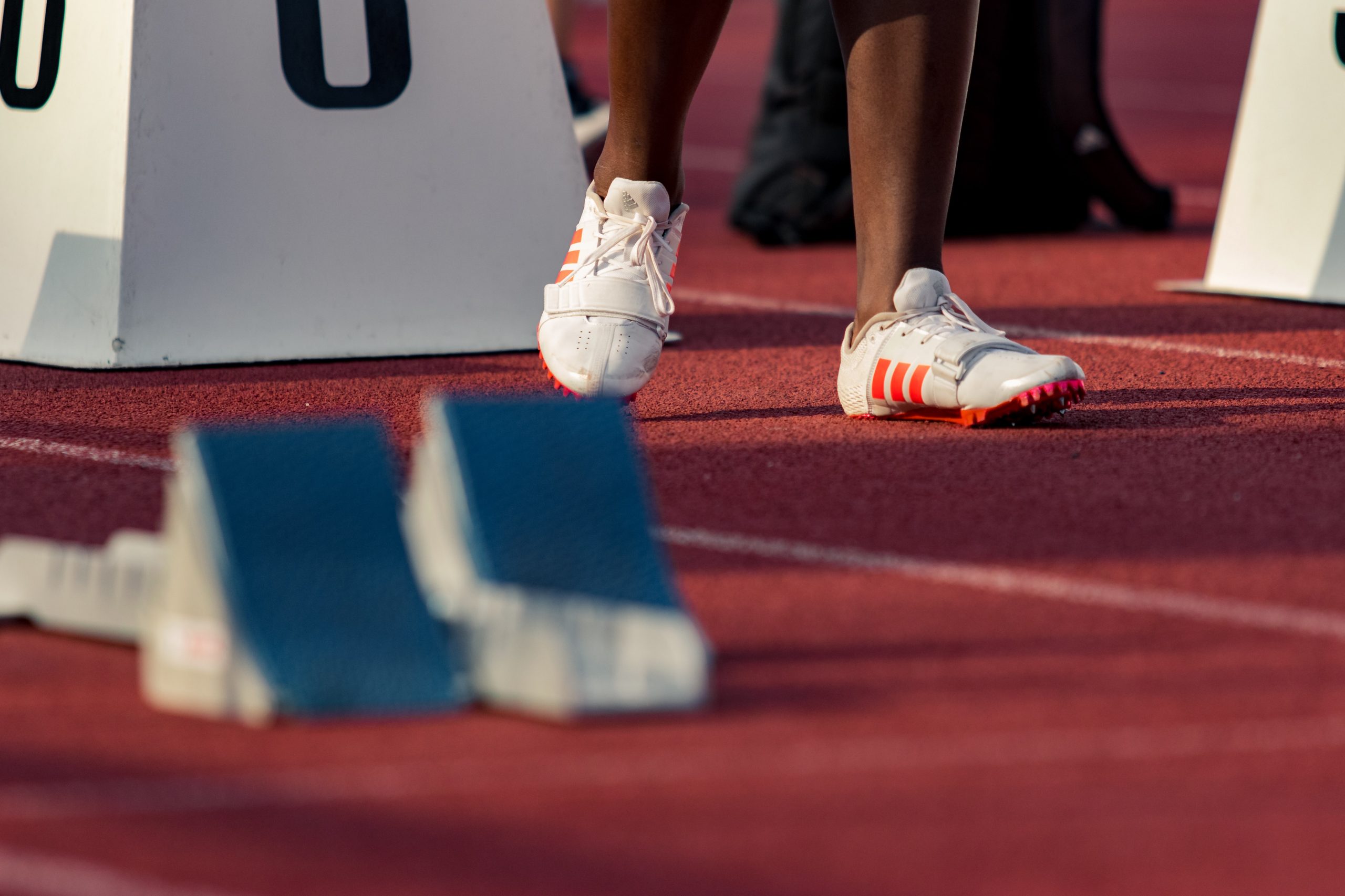
“Dealing with doping: Sports world can learn from Canada and Ben Johnson legacy” by Sarah Bridge, CBC, Feb. 12, 2018.
At the 1988 Summer Olympics in Seoul, South Korea, Canadian Olympic sprinter Ben Johnson won the gold medal in the 100 meter sprint in 9.79 seconds. It was later discovered that he and five other finalists had taken performance-enhancing drugs. What followed was the Dubin inquiry, a historic commission that revealed the ineffective testing policies and procedures of the Canadian government. This inquiry spurred by Johnson’s doping revelations resulted in the establishment of the Canadian Anti-Doping Organization (CADO), an independent body that oversees nationwide drug testing. The CADO is known today as the Canadian Centre for Ethics in Sport (CCES). The Dubin Inquiry focused upon high-performance athletes rather than the sport system as a whole when identifying reasons why performance enhancing drugs were prevalent in Canadian high-performance sport.
What do you think sport leaders have learned from this scandal about implementing an athlete-centred approach? What lessons still need to be implemented?
Video provided by AthletesCAN. Used with permission [Transcript].
One of the main challenges identified by athletes is that they do not feel they have a safe place to report maltreatment. Most complaints must be brought to the athletes’ superiors, who have power over the decisions that are made against the athlete. For example, a national team athlete who had an issue with a coach would need to go to the national sport organization to submit a complaint, but this could also have implications for their own careers since the sport organizations makes decisions on team selection. Many athletes feel as though they do not have a safe place to report their experiences.
Video provided by AthletesCAN. Used with permission. [Transcript]
During her presentation at the 2021 Safe Sport Forum hosted by the Centre for Sport Capacity at Brock University, Allison Forsyth, Olympian and AthletesCAN board member, addressed the difficulty an athlete faces when reporting maltreatment. The following six themes related to perceived barriers are highlighted by these direct quotes provided by athlete participants in the maltreatment study.Kerr, et al., 2019
“While some could view the outcomes of this study as negative, highlighting the extreme nature of the issues and having a baseline to then work from to effect change is actually positive.”
“Athletes rarely report. Plain and simple. They are not comfortable or feel safe doing so with anyone who has a vested interest in the outcome. I reported and did not experience a positive outcome. It is not easy being the whistle blower. We need to support athletes through this – they need a safe place to report free from conflict of interest.”
“The reporting system is broken or useless as it stands right now. Other coaches knew about abuse and did nothing. Turning a blind eye was the norm. Everyone feared consequences of confronting the issues.”
“When an athlete or team says that the coach is unfit and that her behaviour is considered harassment, listen! It is not ok to “wait and see” what will happen and expect that all problems will resolve themselves. When twelve people give you different instances of unacceptable behaviours, that means there is a problem, don’t tell your athletes that they are “just being dramatic and will have to deal with it.”
“I did not make a formal complaint because the process was lengthy and I was afraid of repercussions and mentally it would be difficult to deal with and continue training.”
“If athletes speak out or questions decisions, they are told to be quiet.”
“My NSO did support me very well during a harassment investigation. The parties accused were found guilty but very minor consequences were given. The harassment put a cloud over my entire career.”
“Over 5 players have left our program due to mental health issues in direct correlation with the head coach. Our team finished 3rd so they kept him on board despite the abuse.”
Athletes’ voices are often ignored in the conversation of maltreatment. Reasons athletes have received for not being included are:
“This included the use of conflict of interest to exclude athlete representative positions from NSO boards, issues with recruiting athlete representatives who lack the preferred board member skills and qualifications, as well as geographical barriers which may prevent athletes from attending board meetings and performing their athlete representative role.”AthletesCAN, 2020, p. 19
Normalization of behaviours, grooming contributes to a lack of education.
“All athletes, coaches and sports officials should take a mandatory Safe Sport course.”
“Coaches should be required to go through training to help them navigate harassment and abuse issues between team members. My coach always put his head in the sand and used the ‘that’s not my job’ excuse. I know there is a focus on dealing with harassment and abuse perpetrated by coaches, but I think that issues between peers also must be seriously addressed.”
“More education is needed on ‘It’s not okay to do X’ anymore.”
“Teach male coaches that it isn’t appropriate to talk about sexual things, whether or not they relate to the athlete, ever. Teach coaches to not discuss the negatives of their personal/home life with the athlete, ever.” As one athlete wrote, “Coaches are educators. Most math teachers would be fired for negatively screaming at a person for a wrong answer. Out with the old in with the new.”
Video provided by Brock University Centre for Sport Capacity. Used with permission. [Transcript]
There continues to be improvements and action toward a safer sport environment for all, however, there is still great deal that must be done. We believe one of the most essential parts of this movement are the athletes, which includes their protection and their voice within this movement. We believe the best way forward is through a collaborative approach with all stakeholders, including sport administrators, sport organizations, coaches, and athletes. This does not necessarily mean that athletes get “all the power” but we do propose that athletes are involved in a meaningful way.
Moreover, this means removing the “us vs. them” mentality that continues to persist between sport stakeholders, specifically between athletes and other stakeholders. There are concerns that if athletes have more power then there will be chaos in sport, and it will no longer be manageable. We are at a moment in time where athletes are demanding protection, and we believe that a system that includes all stakeholders’ voices and puts athletes at the centre of all decisions will lead to a safe, welcoming, and inclusive sport environment.
Key Terms
An interactive H5P element has been excluded from this version of the text. You can view it online here:
https://ecampusontario.pressbooks.pub/safesport/?p=112#h5p-3
Suggested Assignments
Image Descriptions
Figure 2.1 This figure demonstrates the differentiation between relationships and terms including bullying, abuse, and harassment. Maltreatment is committed through the misuse of power. Within a dependent relationship this is called abuse. Between peers this is called bullying. Within an authority-based, non-dependent relationship this is called harassment. These three types of harm are manifested in physical, psychological and sexual harm, as well as neglect. [return to text]
Figure 2.2 This figure demonstrates the nine characteristics of an athlete-centred system which include accountability, dual respect, empowerment, equity & fairness, excellence, extended responsibility, health, informed participation, mutual support, and rights. [return to text]
Sources
Alexander, K., Stafford, A., & Lewis, R. (2011). The experiences of children participating in organized sport in the UK. The University of Edinburgh: Child Protection Research Centre.
Allan, E. J., Kerschner, D., & Payne, J. M. (2019). College student hazing experiences, attitudes, and perceptions: Implications for prevention. Journal of Student Affairs Research and Practice, 56 (1), 32-48. https://doi.org/10.1080/19496591.2018.1490303
AthletesCAN. (2019, May 2). Athlete leaders unite to influence safe sport policy in Canada. Retrieved December 30, 2021, from https://athletescan.com/en/athlete-leaders-unite-influence-safe-sport-policy-canada
AthletesCAN. (2020). The future of athlete representation within governance structures of national sport organizations. https://athletescan.com/sites/default/files/images/the_future_of_athlete_representation_in_canadavf-en3.pdf
AthletesCAN. (n.d.a). Retrieved December 30, 2021, from https://athletescan.com/en
AthletesCAN. (n.d.b). Our story. Retrieved December 30, 2021, from https://athletescan.com/en/about/our-story
BBC News. (2018, January 25). Larry Nassar case: The 156 women who confronted a predator. Retrieved December 30, 2021, from https://www.bbc.com/news/world-us-canada-42725339
Brackenridge, C. H. (1994). Fair play or fair game? Child sexual abuse in sport organisations. International review for the Sociology of Sport, 29(3), 287-298.
Brittain, C. R. (2006). Defining child abuse and neglect. Understanding the medical diagnosis of child maltreatment: A guide for nonmedical professionals, 149-189.
Burke, M. (2001). Obeying until it hurts: Coach-athlete relationships. Journal of the Philosophy of Sport, 28(2), 227-240.
Canadian Centre for Ethics in Sport. (n.d.). History of anti-doping in Canada. Retrieved December 28, 2021, from https://cces.ca/history-anti-doping-canada
Canadian Heritage. (2021, July 6). Minister Guilbeault announces new independent safe sport mechanism. Government of Canada. Retrieved October 27, 2021, from https://www.canada.ca/en/canadian-heritage/news/2021/07/minister-guilbeault-announces-new-independent-safe-sport-mechanism.html
Canadian Safe Sport Program. (n.d.). Sport Information Resource Centre: Universal Code of Conduct to Prevent and Address Maltreatment in Sport (UCCMS), 5(1), 1-16. https://sirc.ca/wp-content/uploads/2020/01/UCCMS-v5.1-FINAL-Eng.pdf
Clarke, H., Smith, D., & Thibault, G. (1994). Athlete-centred sport: A discussion paper. https://athletescan.com/sites/default/files/images/athlete-centred-sport-discussion-paper.pdf
Coaching Association of Canada. (n.d.). Three steps to responsible coaching. Retrieved December 28, 2021, from https://coach.ca/three-steps-responsible-coaching
Comeau, G. S. (2013). The evolution of Canadian sport policy. International Journal of Sport Policy and Politics, 5(1), 73–93. https://doi.org/10.1080/19406940.2012.694368
Crooks, C. V., & Wolfe, D. A. (2007). Child abuse and neglect. In E. J. Mash & R.A. Barkley, (Eds). Assessment of Childhood Disorders (4th ed.). New York: Guilford Press, 1–17.
Davidson, N. (2021, April 28). Ruby 7s women say they were let down by Rugby Canada’s bullying/harassment policy. The Canadian Press. Retrieved December 28, 2021, from https://www.cbc.ca/sports/rugby/rugby-sevens-women-let-down-rugby-canada-bullying-harrassment-policy-1.6005901
Dichter, M. (2021, October 8). NWSL’s abuse scandal reveals normalization of toxic culture in sports. CBC Sports. Retrieved December 30, 2021, from https://www.cbc.ca/sports/soccer/nwsl-soccer-abuse-symptom-culture-1.6204197
Dubin, C. L. (1990). Commission of inquiry into the use of drugs and banned practices intended to increased athletic performance. The Honourable Charles L. Dubin Commissioner.
Durrant, J. (2006) Distinguishing physical punishment from physical abuse: Implications for professionals. Canada’s Children, 9, 17–2.
Ehekircher, S. (2020, April 25). My swim coach raped me when I was 17. USA swimming made it disappear. The Guardian. Retrieved December 28, 2021, from https://www.theguardian.com/sport/2020/aug/25/my-swim-coach-raped-me-when-i-was-17-usa-swimming-made-it-disappear
Government of Canada. (2017). Sport in Canada. Retrieved December 30, 2021, from https://www.canada.ca/en/canadian-heritage/services/sport-canada.html
Gymnast Alliance. (n.d.). #GymnastAlliance – Changing the gymnastics worlds. https://www.google.com/search?q=gymnast+alliance&oq=gymnast+alliance&aqs=chrome.0.69i59j0i512l2j0i22i30l2j69i60l2j69i61.3492j0j4&sourceid=chrome&ie=UTF-8
Hansen, D. M., Larson, R. W., & Dworkin, J. B. (2003). What adolescents learn in organized youth activities: A survey of self-reported developmental experiences. Journal of Research on Adolescence, 13(1), 25–55. https://doi.org/10.1111/1532-7795.1301006
Hu, L., & Liu, Y. (2017). Abuse for status: A social dominance perspective of abusive supervision. Human Resource Management Review, 27(2), 328-337.
Ingle, S. (2021, March 9). Interim report reveals 400 submissions over UK gymnastics abuse. The Guardian. Retrieved December 30, 2021, from https://www.theguardian.com/sport/2021/mar/09/british-gymnastics-abuse-review-interim-report-400-submissions-uk
Jackson, G. (2006). A critical examination of the involvement of Canadian high-performance athletes in the development of anti-doping policy. Brock University. https://dr.library.brocku.ca/bitstream/handle/10464/1215/Brock_Jackson_Gregory_2006.pdf?sequence=1&isAllowed=y
Jenkins, S. (2018, March 14). Aly Raisman: Conditions at Karolyi Ranch made athletes vulnerable to Nassar. The Washington Post. Retrieved December 30, 2021, from https://www.washingtonpost.com/sports/olympics/aly-raisman-conditions-at-karolyi-ranch-made-athletes-vulnerable-to-nassar/2018/03/14/6d2dae56-26eb-11e8-874b-d517e912f125_story.html
Jowett, S., & Cockerill, I. M. (2003). Olympic medallists’ perspectives of the athlete-coach relationship. Psychology of Sport and Exercise, 4(4), 313–331. https://doi.org/10.1016/S1469-0292(02)00011-0
Kerr, G., Jewett, R., Macpherson, E., & Stirling, A. (2016). Student-athletes’ experiences of bullying on intercollegiate teams. Journal for the Study of Sports and Athletes in Education, 10(2), 132-149. DOI: 10.1080/19357397.2016.1218648
Kerr, G., Willson, E., & Stirling, A. (2019). Prevalence of maltreatment among current and former national team athletes. University of Toronto. 1–51. https://athletescan.com/sites/default/files/images/prevalence_of_maltreatment_reporteng.pdf
Kirby, S., & Greaves, L. (1996, July). Foul play: Sexual harassment and abuse in sport. Paper presented at the Pre-Olympic Scientific Congress, Dallas, TX.
Levenson, E. (2018, January 24). Larry Nassar sentenced to up to 175 years in prison for decades of sexual abuse. CNN. Retrieved December 28, 2021, from https://www.cnn.com/2018/01/24/us/larry-nassar-sentencing/index.html
Longman, J., & Brassil, G. R. (2021, March 9). Complaints of emotional abuse roil synchronized swimming. The New York Times. Retrieved December 28, 2021, from https://www.nytimes.com/2021/03/09/sports/olympics/synchronized-swimmers-abuse.html
Madger, J. (2017, March 14). McGill basketball teams in spotlight for brutal hazing allegation. Montreal Gazette. Retrieved December 30, 2021, from https://montrealgazette.com/news/local-news/mcgill-basketball-teams-in-spotlight-for-brutal-hazing-allegation
Muchnick, I. (2021, April 25). Dead in the water: The tragic human cost of swimming’s abuse scandals. Salon. Retrieved December 28, 2021, from https://www.salon.com/2021/04/25/dead-in-the-water-the-tragic-human-cost-of-swimmings-abuse-scandals/
Neely, K. C., & Holt, N. L. (2014). Parents’ perspectives on the benefits of sport participation for young children. The Sport Psychologist, 28(3), 255-268.
Parent, S., & Vaillancourt-Morel, M. P. (2020). Magnitude and risk factors for interpersonal violence experienced by Canadian teenagers in the sport context. Journal of Sport and Social Issues. https://doi.org/10.1177/0193723520973571
Pence, E., & Paymar, M. (1986). Power and control: Tactics of men who batter. Duluth, MN: Minnesota Program Development.
Perry, B., Mann, D., Corel, A., & Ludy-Dobson, C. (2002). Child physical abuse. In D. Levinson (Ed.), Encyclopedia of Crime and Punishment (pp. 197–202). Thousand Oaks, CA: Sage Publications.
Respect in Sport. (n.d.). Retrieved December 30, 2021, from https://www.respectgroupinc.com/respect-in-sport/
(2014). Politics and ‘shock’: reactionary anti-doping policy objectives in Canadian and international sport. International Journal of Sport Policy and Politics, 6(2), 195-212. DOI: 10.1080/19406940.2013.773358
Russo, N. F., & Pirlott, A. (2006). Gender-based violence: concepts, methods, and findings. In F. L. Denmark, H. H. Krauss, E. Halpern, & J. A. Sechzer (Eds.), Annals of the New York academy of sciences: Vol. 1087. Violence and exploitation against women and girls (p. 178–205). Blackwell Publishing.
Ryan, G. D., & Lane, S. L. (1997). Integrating theory and method. In G. D. Ryan & S. L. Lane (Eds.), Juvenile sexual offending: Causes, consequences, and correction (pp. 267–321). Jossey-Bass/Wiley.
Safe Sport eReader. (2021, December 14). Erin Willson: The definition of safe sport [Video]. Youtube. https://www.youtube.com/watch?v=4MWwmMdEEhU
Safe Sport eReader. (2021, December 21). Allison Forsyth: What is complicity? [Video]. Youtube. https://www.youtube.com/watch?v=0B3qBqVV3aU
Safe Sport eReader. (2021, December 23). Erin Willson: Body image and belittling athletes [Video]. Youtube. https://www.youtube.com/watch?v=lEX_CXVOxWs
Safe Sport eReader. (2021a, December 6). Camille Berube: An athlete’s perspective on safe sport [Video]. Youtube. https://www.youtube.com/watch?v=OOr2n6ShqBI
Safe Sport eReader. (2021b, December 6). Danielle Lappage: Attending the AthletesCAN safe sport summit [Video]. Youtube. https://www.youtube.com/watch?v=HOiB7OUHtuQ
Safe Sport eReader. (2021c, December 6). Neville Wright: An athlete’s perspective on racial discrimination in sport [ Video]. Youtube. https://www.youtube.com/watch?v=jUOjLxwPgc8
Safe Sport Training. (n.d.). Retrieved December 30, 2021, from https://safesport.coach.ca/
SIRC. (n.d.). Policies & procedures. Retrieved December 30, 2021, from https://sirc.ca/safesport/policies-practices/
Stirling, A. (2009). Definition and constituents of maltreatment in sport: Establishing a conceptual framework for research practitioners. British Journal of Sports Medicine, 43(14), 1091–1099. https://doi.org/10.1136/bjsm.2008.051433
Stirling, A. E., & Kerr, G. A. (2008). Defining and categorizing emotional abuse in sport. European Journal of Sport Science, 8(4), 173–181. https://doi.org/10.1080/17461390802086281
Vertommen, T., Schipper-van Veldhoven, N., Wouters, K., Kampen, J. K., Brackenridge, C. H., Rhind, D. J. ., Neels, K., & Van Den Eede, F. (2016). Interpersonal violence against children in sport in the Netherlands and Belgium. Child Abuse & Neglect, 51, 223–236. https://doi.org/10.1016/j.chiabu.2015.10.006
Waldron, J. J., Lynn, Q., & Krane, V. (2011). Duct tape, icy hot & paddles: Narratives of initiation onto US male sport teams. Sport, Education and Society, 16(1), 111-125.
Willson, E., Kerr, G., Stirling, A., & Buono, S. (2021). Prevalence of maltreatment among Canadian National Team athletes. Journal of Interpersonal Violence, 1–23. https://doi.org/10.1177/08862605211045096
World Health Organization. (2020, June 8). Child maltreatment. Retrieved December 28, 2021, from https://www.who.int/news-room/fact-sheets/detail/child-maltreatment
III
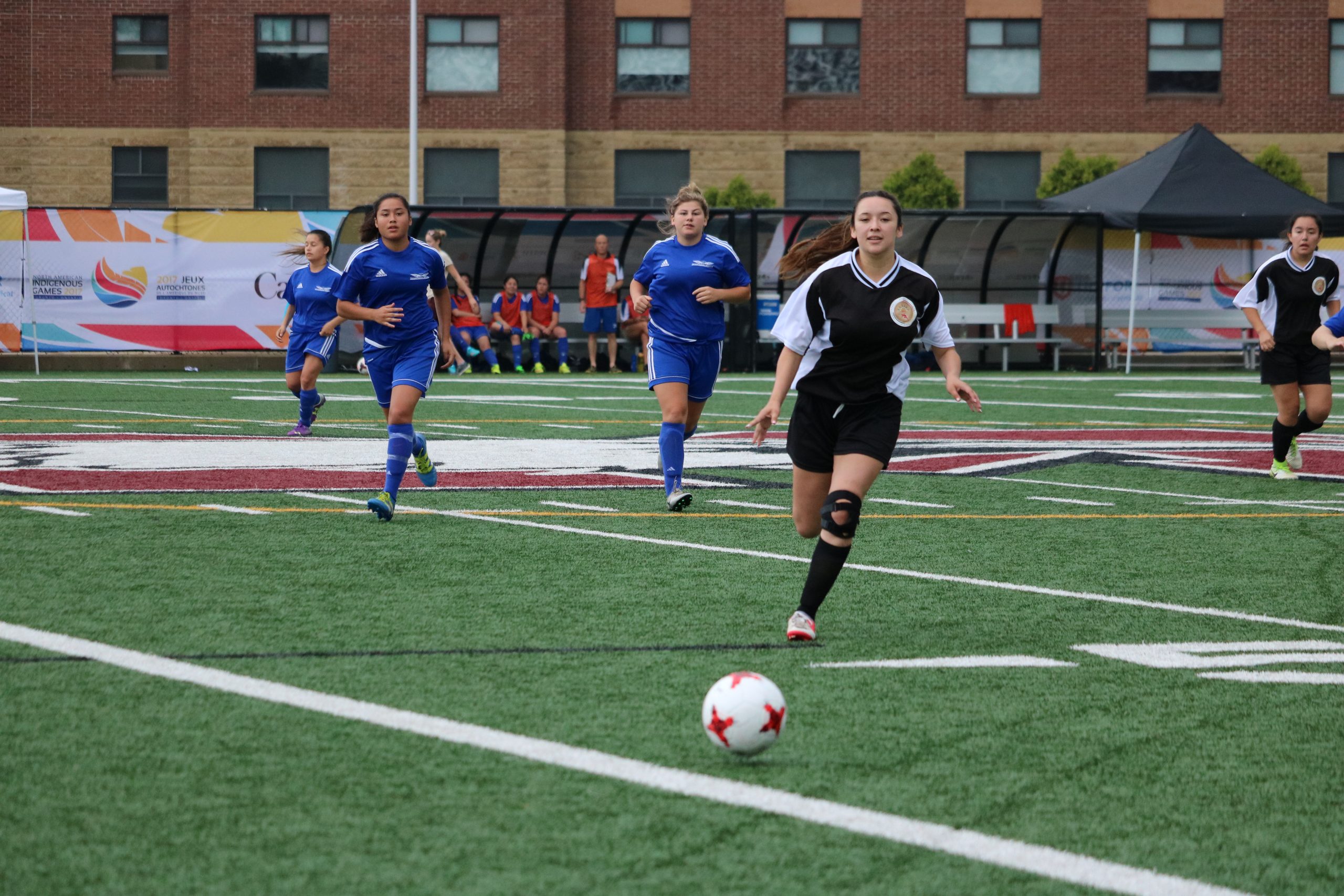
When it comes to the safe sport movement, implementing change requires a solid understanding of where we currently stand and how we got to be here. At the same time, it is crucial to reposition the conversation with an intersectional focus on athletes as individuals operating in multiple systems of power. Part 3 of this reader covers important conversations around the history of safe and inclusive sport, the changes that have taken place in sport governance, and the need for sport organizations to embrace cultures of equity and inclusion.
In Chapter 3, Bruce Kidd, PhD, from the Faculty of Kinesiology and Physical Education at University of Toronto writes about the long struggle towards safe sport in Canada. In Chapter 4, Peter Donnelly, PhD, who is from the same department at University of Toronto discusses the recent challenges posed to the autonomy of sport organizations. Finally, in Chapter 5, a human rights perspective is offered by Leela Madhava Rau and Talia Ritondo of Brock University. These topics are crucial for understanding the broader context of safe sport and how it can be achieved.
3
Bruce Kidd
Sport is a contested terrain.
People have always struggled to make sports safer and more inclusive, despite resistance.
The current Canadian campaign for safe sport must be understood in its historical context.
Students, teachers, athletes, and coaches must continue to push for reforms.
When you have completed this chapter, you will be able to:
LO1 Understand the complex, contested history of modern sports—that sports are not socially neutral but have been constructed to advantage some and disadvantage others;
LO2 Understand the contingent nature of the historical process—that campaigns to make them safe and more inclusive can succeed but they also can be defeated or rolled back; and
LO3 Understand the current state of the campaign for safe sport in Canada and what needs to be done to ensure its effectiveness.
The current campaign for “safe sport” is an expression of a long history of efforts to make societies and sports safer and more inclusive. In their origins in the early modern period, modern sports were violent, rough, and unruly, with success more often the result of brute strength than skill, and participation limited for the most part to European upper-class males and a few male “professionals” from the working classes. Since then, a succession of leaders, participants, and public bodies have sought to reduce or eliminate violence from sports, introduce rules to enhance the fairness of competition and encourage the values of self-restraint and “fair play,” while those excluded from sports, particularly women, the working classes, Indigenous peoples, Black people, persons with disabilities and other marginalized people have fought for opportunities and fair treatment. In 20th century Canada, such efforts included the campaigns against hockey violence, racial discrimination and doping, and for free public recreation, gender equity, and universal accessibility.
This chapter will briefly set out this long, tumultuous history, arguing that while the overall trend has been towards safer, more inclusive sports, there is no guarantee that particular campaigns will succeed. On the contrary, many efforts have been blocked or defeated by those who benefitted from the unsafe and exclusionary status quo, and even successful efforts can and have been rolled back. In Canada, strong policies to prevent and address gender-based violence (GBV) were first proposed in the early 1990s. While Sport Canada required National Sports Organizations (NSOs) in 1996 to take steps to eliminate GBV, in 2016 Donnelly, Kerr, Heron, and DiCarlo found that few NSOs had met that requirement and that Sport Canada had failed to monitor compliance.Donnelly et al., 2016. The chapter will conclude with recommendations for ensuring that the current new initiatives for safe and inclusive sport are sustained.
Sport is a contested terrain. We compete on the playing field and contend for opportunity and meaning. While we are engrossed in the challenges and emotions of a race or a game, it seems like the world and its complications are far away. To enjoy any game, we certainly want it to stay that way. But as students of sport, society, and public policy, we need to understand that the sports we play and how we experience them are inextricably bound up with the same enabling and constraining social structures within which we live. Gruneau (1983) captured this relationship best in his “paradox of play”:
“While one of the purposes of rules is to separate play from reality, the very act of rule construction has the effect of embedding play deeply in the prevailing logic of social relations and thereby diminishing its autonomy. For this reason, the study of play is haunted by a fundamental paradox. Play gives the impression of being an independent and spontaneous aspect of human action or agency and at the same time a dependent and regulated aspect of it.”Gruneau, 1983, pp. 20-21
That realization is the starting point for this chapter. I will make three extended historical points: (1) modern sports bear the stamp of ongoing debates and struggles about what constitutes safe sport; (2) those struggles for safer sport have always been intertwined with struggles for access and inclusion by those who have been excluded; (3) while “the arc of the moral universe bends towards justice”, as the US civil rights leader Martin Luther King argued in many of his speeches,King was paraphrasing the 19th century American Christian reformer, Theodore Parker; see Susan Manker-Seale, ‘The Moral Arc of the Universe: Bending Toward Justice’, 15 January 2006, https://web.archive.org/web/20070811220256/http://www.uucnwt.org/sermons/TheMoralArcOfTheUniverse%201-15-06.html. there is no guarantee that every episode of those struggles results in progressive change. History is contingent, and even very good campaigns have been defeated and victories reversed. From these three points, I will consider the current Canadian struggle for safe sport and draw the lessons for vigilance, study, and activism.

The origins of modern sports can be traced to the early 19th century in the rapidly industrializing societies of Europe and North America. In England, the boys and men of upper-class schools, universities, and clubs gradually transformed the rough and unruly games of the early modern period into what we recognize today. In an earlier time, every community had its own way of playing and games could go on all day. It mattered little because most people never travelled more than 25 kms from their birthplace and life followed the rhythms of agriculture and the seasons. But as the railway and telegraph shrunk distances and inter-town competition became possible, the factory clock drastically reduced leisure and urbanization eliminated open space, organizers gradually agreed upon or imposed standardized rules and equipment, fixed limits to the playing area, the number of players and the duration of games, established a clear distinction between players and spectators, and encouraged an ethic of fair play.Dunning & Sheard, 2005; Guttmann, 1978.
In North America, men who once played bat and ball games under local rules negotiated, embraced, or were forced to accept regional rules. By mid-century, the best known were the New York rules, the Massachusetts rules, the Western rules, and the Canadian rules. By the 1870s, the New York rules pushed out those other ways of playing and by the turn of the 20th century, simply became “baseball”. The same process occurred in the traditional games that became hockey, lacrosse and football.Gruneau & Whitson, 1983. At the same time, physical educators invented completely new sports like basketball and volleyball. So widespread is the acceptance of standard rules today that communities vie for the right to be declared the “home” of sports like hockey, failing to realize that evidence of such play in the early modern era does not constitute origins—simply that people played something similar. The new sports soon spread around the world by trade, imperialism, Christianity, and elite emulation.Mangan, 1998. These processes continue to this day.
For our purposes, concern and contention about safe rules and conditions have always been integral to the making of sports. Early modern sports were extremely violent, with few restrictions upon fighting and other tactics. There were no limits to the size or weight of players and success was more often the result of brute strength than skill. Players could and were seriously hurt. In boxing, what was known as prize fighting, men fought “bare knuckle”, and although there were rounds (measured by knockdowns), participants fought until one competitor could no longer stand. Gradually, rules were introduced to curb violence and referees to enforce them. Gloves (in boxing and baseball), weight categories and round limits in the combative sports were introduced to reduce injury. Skill rather than the size of players became more valued. But none of these changes occurred without long debates among players, organizers, and the growing sports media, often in response to death and serious injury.
The German British sociologist Norbert Elias (1971, 1978) argues that these changes in sport were part of a larger transformation he called “the civilizing process”. As urban densities increased, medical science advanced and the working class and women pressed for better opportunities, Western societies became more socially conscious. States began to provide clean water, control sewage, and regulate food products. They introduced universal public education to inculcate a culture of respect and self-restraint and sought to reduce interpersonal violence. Duels were outlawed and police forces were created to ensure public order.
In this context, every generation of Canadian sport has experienced the pressure to make sport safer. Some changes, such as new equipment and practices that reduce the risk of injury—think protective gear and water stations at fun runs—have provoked little controversy, but other proposed changes have touched off bitter debate. The federal government once made prize fighting illegal, but organizers defied the law and held matches clandestinely. Although boxing was subsequently allowed under strict provincial regulation, such is the risk of lifelong brain injury, that medical associations continue to call for its abolition.Kidd, Corner & Stewart, 1983; Kidd, 1995. Hockey, too, has long been a site of struggle over safety, as players, parents, and the public decry the seeming indifference of the sport’s rule makers and coaches to fighting and other injurious tactics.
We can place the current effort to realize “safe sports” in that trajectory. Recent campaigns against “win at all costs”, doping and for “fair play” are also part of this story. Recent examples include the campaigns to prevent concussions in Canadian football (e.g. “Grey Cup haunted by brain injury but doesn’t need to be”) to combat doping around the world (e.g. “‘Nigerian sprinter Okagbare faced 3 charges in doping case”), and to require athletes to double vaccinate against COVID-19 in the Olympics (e.g. “Olympics and Paralympic Winter Games Beijing 2022 – Update on Spectators, Vaccination, and COVID-19 Countermeasures”). Several of the research and project questions invite you to explore these efforts in sports with which you are familiar.
Video provided by Brock University Centre for Sport Capacity. Used with permission. [Transcript]
A closely related struggle is for access and inclusion. Modern sports were developed by men for able-bodied boys and men in male-only institutions. It was not that they forgot about girls and women, sexual minorities, persons with disabilities, the working classes, Indigenous Peoples, and other non-Europeans; the first organizers deliberately excluded them as a way of strengthening upper-class, European masculinity. But such were the joys and benefits of sports, that those excluded soon sought to play themselves, crashing the established sports bodies’ competitions, creating their own competitions and organizations (think Workers’ Olympiads and Women’s Olympics) and pushing governments to create public opportunities for their children in schools and playgrounds, while many of those who already enjoyed sports pushed back.Kidd, 1996. For me, this is the most fascinating thread of Canadian and international sports history, and it continues to this day.
The struggle for inclusion directly affects the struggle for safe sports, because as different people took up sports, they demanded that some rules and conditions be altered to make them easier and safer to play. These ideas, too, were frequently contested, as the century-long debates about distinct rules for women’s sports and events illustrate.
As the ongoing debates in boxing, hockey and women’s sports demonstrate, not everyone agrees that reform is desirable. Some players and coaches resist because change might alter the skills required, even their very understanding of and love for the game. In hockey, traditionalists have long argued that hockey should teach boys and men the courage to stand up and fight, and therefore oppose any proposal to eliminate fighting from the game. During the 1970s, independent task forces in virtually every province in Canadae.g Downey, 1973; McMurtry, 1974. recommended the elimination of fighting from hockey, yet very few associations agreed. The current effort to reduce concussions from hits to the head in hockey faces similar opposition.
Many progressive campaigns have met a similar fate. In the 1920s and 1970s, educators sought to eliminate abusive coaching, only to be told that toughening athletes was needed to make them successful. The advances of first-wave feminism in sports after WW1 were obliterated in the patriarchal post-WW2 reconstruction so that the 1960s generation of women leaders had to learn to organize all over again. In recent years, while there has been a welcome growth in legislation designed to bring about safer sports, e.g. Quebec’s Act Respecting Safety in Sports (2021) and Rowan’s Law (Ontario 2018) in Ontario, and university and foundation programs devoted to sport safety research (e.g. Concussion Research Clinic at the University of Toronto, Think First Foundation), there continues to be resistance.
Campaigns for access and inclusion have often faced resistance, as those who have already enjoyed sports seek to preserve them for themselves.
In both of these struggles, there have been cycles of public concern, government consultation and policy response, sport sector resistance and government failure to follow up, monitor and enforce compliance. In the early 1990s, following Ben Johnson’s shocking disqualification for steroids from the 1988 Olympics in Seoul and the anguishing nationally televised hearings that heard other Canadian athletes admit to doping, chief justice Charles Dubin concluded that the intense pressure upon athletes and coaches to win was a major contributor. He recommended a more “athlete-centered” approach and more representative sports bodies. Yet within a few years, the idea of “athlete-centered sport” was reduced to rhetoric and the newly established, much more representative Canadian Sport Council discontinued in the renewed push to the podium. Widespread concern over gender-based violence in Canadian sport led Sport Canada to require National Sports Organizations (NSOs) to create preventive policies with independent harassment officers. Yet in 2018, Donnelly and Kerr found that few NSOs had developed the requisite policies, only one had an independent investigative officer, and Sport Canada had failed to monitor compliance.Kerr, Kidd & Donnelly, 2020.
Video provided by Brock University Centre for Sport Capacity. Used with permission. [Transcript]
In 2018, federal Minister of Science and Sport, Kirsty Duncan, rejected calls to create a completely independent mechanism to address gender-based violence in sport and chose instead to renew and strengthen the failed 1996 policy. But further revelations of athlete abuse, intensified athlete activism, and the recommendations of several task forces and the 2019 meeting of the federal, provincial, and territorial sports ministers led her, her successor as sports minister, Steven Guilbeault, and Sport Canada to initiate a more rigorous approach. A new Universal Code of Conduct to address Maltreatment in Sport at the national level (Canadian Safe Sport Program, Sport Information Resource Centre, n.d.) has been promulgated and the Sport Dispute Resolution Centre of Canada (SDRCC) engaged to create a new independent mechanism to implement the Code.Canadian Heritage, 2021. The Code not only addresses gender-based violence but other forms of mistreatment, including bullying and neglect.
These are extremely encouraging steps forward. Very few other national efforts have defined the abuse of athletes so comprehensively. The SDRCC has a well-deserved reputation for timely, athlete-sensitive, and independent adjudications.
Yet given the long history of resistance to athlete-centered policies and the deep belief that harsh methods are sometimes necessary to get athletes to the podium, the athletes, researchers, and activists who have fought for safe sport must continue to press for significant change in the culture of sports, the widespread dissemination of the expectations of the Code and its effective implementation. How can athletes, equity advocates and members of the public hold the sports bodies accountable for their use of the UCCMS and the new independent mechanism and their efforts to change their culture? How can they hold Sport Canada accountable for its oversight of publicly funded high-performance sports?
Given that many sports bodies claim the “autonomy of sports”, despite their extensive public funding and immersion in the prevailing logics of society, it will be important for advocates to hold them up to their social responsibilities. Essential to this task will be independent monitoring and evaluation. This is a task to which researchers and students should give special attention.
Given that the UCCMS and the SDRCC only cover national programs, further efforts will be needed to bring the provinces and territories into the new regime.
Finally, the campaign for safe sport cannot lose sight of related efforts to improve the access and inclusion of sports. There can’t be much to cheer about if sports become safer yet are only available to a few. Yet, Canadian sport is largely a white, middle-and upper-class practice, where “pay for play” requirements exclude the poor.
The fight for safe and more equitable sport is far from over.
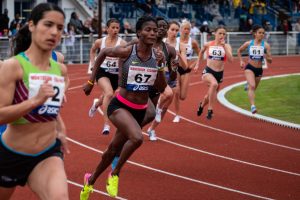
Video provided by Brock University Centre for Sport Capacity. Used with permission. [Transcript]
Further Research
One area for future research is the exploration of implicit cultural biases (e.g. racism, toxic masculinity, homophobia) in sport through the lens of intersectionality. As Cooper and colleagues (2020) note “inequities, inequalities, and discrimination” are barriers to developing an inclusive, welcoming sports environment.
Key Terms
An interactive H5P element has been excluded from this version of the text. You can view it online here:
https://ecampusontario.pressbooks.pub/safesport/?p=125#h5p-5
Suggested Assignments
Sources
Canadian Heritage. (2021, July 6). Minister Guilbeault announces new independent safe sport mechanism. Government of Canada. Retrieved October 27, 2021, from https://www.canada.ca/en/canadian-heritage/news/2021/07/minister-guilbeault-announces-new-independent-safe-sport-mechanism.html
Canadian Safe Sport Program. Sport Information Resource Centre: Universal Code of Conduct to Prevent and Address Maltreatment in Sport (UCCMS), (5)1, 1-16. Retrieved October 27, 2021, from https://sirc.ca/wp-content/uploads/2020/01/UCCMS-v5.1-FINAL-Eng.pdf
Canadian Tire Jumpstart Foundation. (2021, March). Jumpstart state of sport report. Retrieved October 27, 2021, from https://static1.squarespace.com/static/59a5b44ed7bdce6f285fe67b/t/6074a8bfbba2f62bb780a882/1618258129681/Jumpstart_State_of_Sport_Report_March_2021.pdf
Connolly, J. & Noseworthy, M. (2017, November 22). Grey Cup haunted by brain injury risk – but doesn’t have to be. The Conversation. Retrieved October 27, 2021, from https://theconversation.com/grey-cup-haunted-by-brain-injury-risk-but-doesnt-have-to-be-87986
Donnelly, P., Kerr, G., Heron, A., & DiCarlo, D. (2016). Protecting youth in sport: An examination of harassment policies. International Journal of Sport Policy and Politics, 8(1), 33–50. https://doi.org/10.1080/19406940.2014.958180
Downey, L. W. (1973). Report of an inquiry into the rights of individuals in amateur sport (hockey). Edmonton: Alberta Branch of Cultural Development.
Dunning, E. & Sheard, K. (2005). Barbarians, gentlemen and players: A sociological study of the development of rugby football. New York: Routledge.
Elias, N. (1978). The civilizing process. New York: Urizen Books.
Elias, N. (2017). The genesis of sport as a sociological problem. In E. Dunning (Ed.), Sport: Readings from a Sociological Perspective (pp. 88-115). Toronto: University of Toronto Press. https://doi.org/10.3138/9781442654044-012
Gruneau, R. S. (1983). Class, sports and social development. Amherst: University of Massachusetts Press.
Gruneau, R. S. & Whitson, D. (1983). Hockey night in Canada: Sport, identities and cultural politics. Toronto: Garamond.
Guttmann, A. (1978). From ritual to record: The nature of modern sports. New York: Columbia University Press.
Kerr, G., Kidd, B., & Donnelly, P. (2020). One step forward, two steps back: The struggle for child protection in Canadian sport. Social Sciences, 9(5), 68–. https://doi.org/10.3390/socsci9050068
Kidd, B. (1995). Capturing the state for amateur sport: The Ontario athletic commission 1920-1947. In K.B. Wamsley (Ed.), Method and methodology in sport and cultural history (pp. 203-234). Brown & Benchmark.
Kidd, B. (1996). The struggle for Canadian sport. Toronto: University of Toronto Press.
Kidd, B., Corner, F. & Stewart, B. (1983). For amateur boxing: The report of the Ontario amateur boxing review committee. Ministry of Tourism and Recreation.
Legislative Assembly of Ontario. (2018). An act to enact Rowan’s Law (concussion safety), 2018 and to amend the Education Act. https://www.ola.org/sites/default/files/node-files/bill/document/pdf/2018/2018-03/bill—text-41-2-en-b193ra_e.pdf
Mangan, A. J. (1998). The games ethic and imperialism: Aspects of the diffusion of an ideal. London: Cass.
Manker-Seale, S. (2006). The moral arc of the universe: Bending toward justice. Retrieved October 27, 2021, from https://web.archive.org/web/20070811220256/http://www.uucnwt.org/sermons/TheMoralArcOfTheUniverse%201-15-06.html
McMurtry, W. R. (1974). Investigation and inquiry into violence in amateur hockey. Ministry of Community and Social Services.
MLSE Foundation. (2021, July). Change the game research: A study focused on sport access, engagement, and equity factors in the wake of the pandemic. https://assets.website-files.com/5eb9ca182f6df037590c28ea/60f5a049b617f857b0d14be4_Change%20The%20Game%20Research_FINAL.pdf
Quebec Publications. (2021, August 1). An act respecting safety in sports. http://legisquebec.gouv.qc.ca/en/pdf/cs/S-3.1.pdf
Safe Sport eReader. (2021, December 2). Bruce Kidd: Sport and the struggle for inclusion [Video]. Youtube. https://www.youtube.com/watch?v=r3ffdqE3WaQ
Safe Sport eReader. (2021a, December 31). Bruce Kidd: The long struggle for safe sport [Video]. Youtube. https://www.youtube.com/watch?v=AN33mJM2YpI
Safe Sport eReader. (2021b, December 31). Bruce Kidd: The fight for gender equity in Canadian sport [Video]. Youtube. https://www.youtube.com/watch?v=8XatWbjw1Oc
The Associated Press. (2021, October 7). Nigerian sprinter Okagbare facing 3 charges in doping case. The Toronto Star. Retrieved October 27, 2021, from https://www.thestar.com/sports/2021/10/07/nigerian-sprinter-okagbare-facing-3-charges-in-doping-case.html
True Sport pur. (2018, July 16). Succeed clean program[Video]. YouTube. https://www.youtube.com/watch?v=eKGBjoFHFiE
4
Peter Donnelly
Autonomy of Sport
Sport Governance
Safe Sport
When you have completed this chapter, you will be able to:
LO1 Understand the benefits, and also the problems associated with the autonomy of sport;
L02 Be better able to determine the organizational context under which abuse may occur, or may be prevented;
L03 Raise questions about sport governance in a sport organization, determine whether it is responsible, accountable and transparent; and
L04 Question whether athletes in an organization have a say in decisions that affect them, and if not, how the organization may be changed to genuinely include athletes in decision making.
It is usual to think of athlete abuse in terms of the individuals involved – the “abuser” and the “victim”. This chapter takes a larger view of the system in which athlete abuse occurs, the culture of abuse that is often seen in sport, especially high-performance sport; and the structure and organization (“governance”) of sports. The sport system may turn a blind eye to abuse, and it may cover up abuses, but it is also the system that could prevent abuses.
This chapter critiques the dominant “prolympic” sport systemDonnelly, 1996 the convergence of professional and Olympic sports both nationally and internationally, because it is widely recognized by researchers, the United Nations (UN), and non-government organizations (NGOs) such as Human Rights Watch, Transparency International and the Centre for Sport and Human Rights (CSHR) as a system that harbours abuse.Erin Willson provides strong evidence of the prevalence of athlete maltreatment in Canadian sport (see Chapter 2); and there have been well-publicized examples of sexual abuse in Canadian boys' hockey, English boys' soccer, girls' gymnastics and swimming in the US, and women's soccer in countries such as Afghanistan and Haiti This does not mean that there are no exceptions – some sport clubs, organizations, and federations are run well, and are not subject to the critiques made here. Nor does it mean that the system cannot be changed. The chapter concludes with an indication of some changes that are being made.
An interactive H5P element has been excluded from this version of the text. You can view it online here:
https://ecampusontario.pressbooks.pub/safesport/?p=137#h5p-6
In 2011, Belgian scholar Hans Bruyninckx pointed out that “Sports… take place in a sort of separate [autonomous] sphere, detached from normal rules and regulations in society”.Bruyninckx, 2011 Autonomy refers to “the ability of a sports body, without undue external influence, to establish, amend and interpret sporting rules, to select sporting leaders and governance styles and to secure and use public funding without disproportionate obligations; this autonomy is commonly justified as an important tool through which the values inherent to sport can be safeguarded from political, legal, and in the modern era, commercial influences”.Chappelet, 2010; Parrish, n.d.
We can see this, for example, in the levels of violence that are permissible in some sports but not in the larger society. Autonomy gives those sports the right to attempt to regulate the level of violence, and to determine penalties for those who exceed a permitted level. Sport organizations also claim the right to regulate athlete abuse and to determine penalties, although the degree of conflicts of interest in such proceedings has become increasingly evident.

This autonomy came about because governments and legal systems did not wish to take on the burden of organizing and policing sport. Sport organizations assured governments and legal systems that they could organize and police themselves. However, the number of cases of violence and athlete abuse that end up in law courts raises questions about those assurances.
There are many autonomous (self-governing) organizations and institutions in societies, including universities and all of the professions. Professional standards and codes of practice are maintained by “Colleges” of, for example, teachers, lawyers, accountants, and health and medical professions which, in Canada, are organized on a provincial level. Colleges govern professionals and organizations in the public interest by ensuring that people are served by those who meet high standards of learning, competence and professional conduct, and by disciplining those who fail to meet the standards.
Sport has a very different, unregulated type of autonomy. There is no “College of Coaches” and, for the most part, each sport organization has a responsibility for governing and disciplining itself. There is no overall standard of learning, code of practice or code of conduct. Of course, autonomy has limits. Complete autonomy is not possible, although sport has attempted to make it so. For example, the European Union offers sports bodies a degree of supervised autonomy. They can exercise their autonomy as long as “they are respectful of European law and demonstrate a clear commitment to transparency, democracy, and the protection of the values of sport”.Geeraert & Bruyninckx, 2014, p. 11 However, if sport organizations had successfully practiced this form of responsible autonomy (where organizations responsibly practice good governance – transparency, accountability and democratic decision making), a supervised autonomy (where the autonomy of sport is monitored by, in this case, the European Union) would not be necessary.
Headlines for the past 40 years or more have shown that sport organizations have been remarkably effective at increasing standards of athletic performance, and at organizing themselves in ways that appeal to corporate sponsors, mass media organizations and fans. At the same time, sport organizations have been remarkably incompetent at governing and disciplining themselves. While cover-ups exist at every level of sport, here are a few examples of this troubling behaviour:
An interactive H5P element has been excluded from this version of the text. You can view it online here:
https://ecampusontario.pressbooks.pub/safesport/?p=137#h5p-7
In 2000, British journalist and activist Sunder Katwala wrote, “It is difficult to think of anything that is so badly governed as international sport.”Katwala, 2000, p. 90 He wrote this as part of his scathing review of the global sporting industry, from bidding scandals during the Olympic Games to doping charges in the Tour de France (an annual multiple-stage men’s cycling road race).
Following the corruption scandals associated with Salt Lake City’s bid for the 2002 Winter Olympics, researchers and investigative journalists began to pay increasing attention to governance in sport organizations. Their investigations frequently confirmed Katwala’s (2000) claim about the poor level of governance. Play the Game (PtG), a Danish-based sport advocacy organization, developed the Cologne Consensus (2011), one of the first steps toward a global code for good governance in sport. PtG followed by establishing a unit on Action for Good Governance in SportAGGIS, 2012 which, in turn, developed the Sport Governance Observer— a measurement tool to determine whether sport organizations were governed in ways that were transparent, accountable, and followed democratic principles.


Play the Game is an initiative supported by the Danish Institute of Sport Studies, an independent research centre set up by the Danish Ministry of Culture in 2004.
Check out their website to learn more about Play the Game (PtG) including its mission, vision and values, and activities with the Council of Europe, UNESCO, and the European Union (EU).
Rigorous reports are also generated by the centre – here are some to review:
Watch an interview about Play the Game with Dr. Arnout Geeraert.
Video provided by Play the Game. Used with permission. [Transcript]
As students of sport management are well aware, governance of national and international sport organizations has changed dramatically in the last 50 years. The former system of amateur sport became politicized during the Cold War, leading countries into a “sporting arms race” based on winning Olympic Games and World Championship medals (see Chapter 2 where political forces influencing the origin of modern sport and the struggle for safe sport are addressed).Chataway & Goodhart, 1968; Donnelly, 2009 The growth of sponsorship and global media communications helped to commercialize this politicized sport into what we see now as a global “sportainment” industry. Governance shifted from the kitchen tables of amateur sport to a more professionalized model, with sport receiving both government and sponsor funding in many countries. However, despite accepting public (government) funding, sport organizations continued to assert their autonomy.
Just as funding from sponsors has conditions attached, public funding is usually distributed with the public interest in mind. The policies introduced by Sport Canada, which is the government agency that distributes funding to Canadian national sport organizations (NSOs), should have had the effect of regulating the autonomy of sport. These Sport Canada policies obliged NSOs to:
Unfortunately, these policies did not have much effect on sport organization autonomy in Canada. Initially, only the failure to introduce a harassment and abuse policy carried with it a threat of having funding withdrawn. Subsequently, with the introduction of the Sport Funding and Accountability Framework (SFAF), NSO funding became contingent on implementing the various policies.Accountability is one of the key components of good governance -- in this case accounting for the sources of all funding, how it has been spent, and why it has been spent.
SFAF involved an annual check-list for Canadian NSOs to assure Sport Canada they were in compliance with the policies. However, in a failure of accountability, Sport Canada never completely monitored the NSOs. Whether this was because of a lack of capacity and resources at Sport Canada, or an unwillingness to challenge the organizational autonomy of sport, Sport Canada acquiesced in their autonomy and, as far as we know, funding was never withheld. For example, in the case of safe sport (the harassment and abuse policy), Donnelly et al., (2016) showed that many NSOs ignored, or only partially implemented the policy.
As a consequence, in 2018 then-Minister of Science and Sport, Kirsty Duncan, announced that addressing the abuse of athletes was a priority of her office, that “national sporting organizations will lose their federal funding if they don’t immediately disclose to her office any allegations of abuse or harassment that occur within their ranks” and “effective immediately, funding agreements also require sporting associations to establish an independent third party to investigate all allegations of abuse and have mandatory prevention training in place as soon as possible and no later than 1 April 2020”.CBC, 2018 The Minister may not have been well informed by her Sport Canada staff, since these were essentially the same requirements from the 1996 harassment in sport policy that neither the NSOs nor Sport Canada had been able to implement.
Canadian NSOs saw their prime directive as developing high-performance athletes, and that was affirmed by the connection between funding and success – the more medals they won, the more public funding they received. This became even more pronounced in 2005 following the introduction of additional Own the Podium funding. Ultimately, it is believed that the failure to fully realize Sport Canada policies was a result of:
It should be noted that a number of smaller Canadian NSOs applauded the idea of an independent mechanism, or a regulatory body with the authority to implement safe sport policies, because they were prepared to admit their lack of capacity to manage a safe sport policy autonomously, and were aware of the increasing costs associated with legal action in cases of current and historical abuse.
Ongoing investigations of sport governance by researchers and investigative journalists, together with the International Olympic Committee’s (IOC) 2008 introduction (but not enforcement) of the Basic Universal Principles of Good Governance, and monitoring by the Sport Governance Observer have had an increasing impact on many sport organizations around the globe. The IOC now advocates for sport organizations to practice “responsible autonomy”. In other words, sport organizations retain their autonomy but should do so responsibly by practicing good governance. However, it is difficult to see how responsible autonomy will work in a sport culture where most of the rewards go to those organizations that will do whatever it takes to win.
As noted, the European Union offers sports bodies a degree of “supervised autonomy”.Geeraert & Bruyninckx, 2014, p. 11 Introducing supervised autonomy in Canada will both challenge and enhance sport governance. It will involve empowering and providing capacity to Sport Canada to monitor and enforce policies such that sport organizations practice good governance, are more democratic and transparent in their governance, and that public funding is spent accountably in the public interest.
The introduction of a new independent mechanism to investigate and adjudicate safe sport issues in Canada represents another step towards supervised autonomy. Just as there are independent agencies to regulate doping (Canadian Centre for Ethics in Sport or CCES) (see Chapter 11 for more details about the CCES and True Sport) and dispute resolution (Sport Dispute Resolution Centre of Canada or SDRCC), the SDRCC has now been contracted to establish the Office of the Sport Integrity Commissioner to administer the Independent Safe Sport Mechanism (more information about these entities in relation to legal considerations for safe sport is addressed in Part Four). With the very clear Universal Code of Conduct to Prevent and Address Maltreatment in Sport (UCCMS)Canadian Safe Sport Program, 2020 as the guiding document now in force for all NSOs in Canada, the Safe Sport Mechanism should now begin to provide athletes with a safe place to report maltreatment without retaliation from the sport organizations or the abusers; and NSOs have much clearer guidelines to prevent abuse in their organizations.

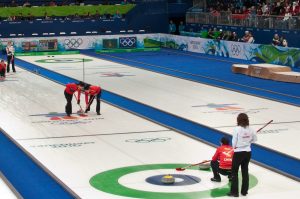
Here’s a summary of the steps taken towards creating an independent safe sport mechanism in Canada.
“We have heard the calls from the sport community for a safe, independent and trusted space to address maltreatment in sport. It is crucial that victims feel that they can speak out, call attention to harmful behaviour and challenge the system to be better. This new independent mechanism will give them the opportunity to do so in a supported environment.“The Honourable Steven Guilbeault as cited in Canadian Heritage, 2021, para. 4
In the era of politicized and commercialized sport, athletes’ voices have, for the most part, been silenced. Despite sport organizations making positive statements (rather than actions) about human rights in sport in the last few years, the position of some international sport organizations on human rights in the commercial world of modern “prolympic” sport was made very clear recently. For example, FIFA has done very little to relieve the plight of construction workers whose rights are being violated while building the facilities for the Qatar 2022 World Cup. And in a statement about sex testing women athletes (another human rights issue), World Athletics identified itself as “a private body exercising private (contractual) powers… [and] not subject to human rights instruments such as the Universal Declaration of Human Rights (UDHR) or the European Convention on Human Rights”.IAAF, 2019 The UN High Commissioner on Human Rights reported that there is no existing mechanism to assure compliance with human rights by the International Olympic Committee and International Federations. These positions all filter down to national levels, and athletes’ rights have not been given consideration in decision-making in sport.UNHCHR, 2020
Despite claims that, in Canada for example, following the Ben Johnson doping scandal at the Seoul Olympics (1988) and the subsequent Dubin inquiry (1990), sport was to be more “athlete-centred”, only token actions were taken in the 1990s. Some examples of this include appointing a single athlete to the Board of a Canadian NSO or establishing relatively powerless Athletes’ Commissions at the IOC and at National Olympic Committees. That has begun to change in recent years and athletes are beginning to become more involved in making the decisions that affect them.
Video provided by Brock University Centre for Sport Capacity. Used with permission. [Transcript]
In the lead up to a strike in 1982, the National Football League Players’ Association (NFLPA, 1981) declared, “We Are the Game”, and it has become increasingly evident that, without athletes, there would be no sport – no need for sport organizations, no political bragging rights, no profits for all of the people who take a profit from international and professional sports events.Donnelly, 2015 Athletes began to realize their potential power as investigations increasingly showed how badly sport organizations were governed, how badly many athletes were treated, and how little input athletes had into decisions that affected everything about their career as athletes.
The increasing power of athletes has been associated with the increasing recognition of the violation of human rights in sport. It has been spurred by the courageous voices of some athletes speaking out against abusers, against sex testing, against exploitation; but it has been most evident in the growth of athletes’ organizations and unions (e.g., AthletesCAN, Global Athlete). See Suggested Assignments 3 at the end of this chapter for three examples of Canadian athletes who spoke up and helped to make a difference: Ted Lindsay, Ann Peel, Allison Forsyth.
In Canada, athletes have gone from one seat on the Board to determining the postponement of the Tokyo 2020 OlympicsDonnelly, 2020 in a very short time, and AthletesCAN sponsored the prevalence study which found that, of 1,001 current and retired national team athletes, 67% of current athletes and 76% of former athletes reported experiencing at least one form of maltreatment mostly at the hands of their coaches.Kerr et al., 2019 Through AthletesCAN, athletes became a key voice in developing the UCCMS and in lobbying for the Independent Safe Sport Mechanism.
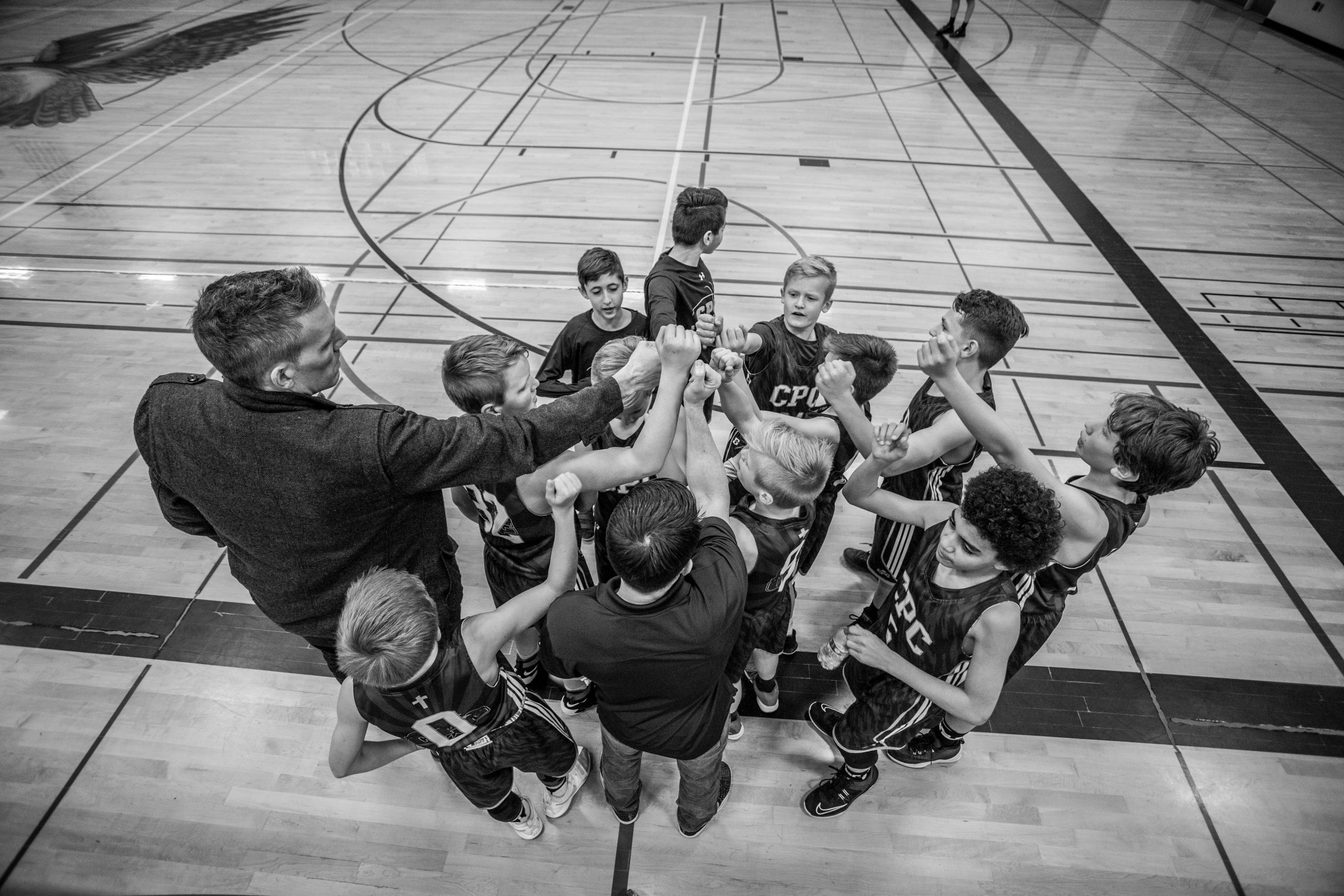
Full application of an athlete-centred policy would give athletes the right to be involved in every decision that affects them; and a truly democratic system would see coaches and sport organizations working in the service of athletes.
The unregulated autonomy of sport, the absurd and oxymoronic popularity of authoritarian coaching which takes highly motivated athletes and uses bullying and punitive coaching practices to motivate them, the failure to consider athletes’ rights, and the single-minded focus on medals, have created a culture of control in the “prolympic” sport system. When dealing with highly motivated individuals such as athletes, implementing authoritarian coaching practices speaks to, frankly, a poverty of the imagination. What we are dealing with is a systemic issue, and prevention requires more than getting rid of “a few bad apples.” Changing cultures and social structures is slow, and it is difficult. But perhaps we are seeing the first steps in changing the culture and structure of sport with challenges to the autonomy of sport, and with the active measures being taken to address safe sport.
 Self-Reflection
Self-Reflection
Key Terms
An interactive H5P element has been excluded from this version of the text. You can view it online here:
https://ecampusontario.pressbooks.pub/safesport/?p=137#h5p-8
Suggested Assignments
Image Descriptions
Figure 4.1 This interactive figure depicts four examples of “troubling” sport organization practices. These include complicity, financial corruption and cronyism, conflicts of interest, and violation of athletes’ rights. [return to text]
Sources
Action for Good Governance in International Sport Organizations (AGGIS). (2012). Retrieved January 7, 2022. https://playthegame.org/theme-pages/action-for-good-governance-in-international-sports-organisations/
Bruyninckx, H. (2011). Obsession with rules vs. mistrust in being ruled. Play the Game Conference, Cologne, Germany.
Canadian Centre for Ethics in Sport (CCES). (n.d.). Retrieved December 31, 2021, from https://cces.ca
Canadian Heritage. (2021, July 6). Minister Guilbeault announces new independent safe sport mechanism. Government of Canada. Retrieved October 27, 2021, from https://www.canada.ca/en/canadian-heritage/news/2021/07/minister-guilbeault-announces-new-independent-safe-sport-mechanism.html
Canadian Intergovernmental Conference Secretariat. (2019, February 15). Red Deer Declaration – For the prevention of harassment, abuse and discrimination in sport. Retrieved December 9, 2021, from http://scics.ca/en/product-produit/red-deer-declaration-for-the-prevention-of-harassment-abuse-and-discrimination-in-sport/
Canadian Safe Sport Program. (2020). Sport Information Resource Centre: Universal Code of Conduct to Prevent and Address Maltreatment in Sport (UCCMS), (5)1, 1-16. https://sirc.ca/wp-content/uploads/2020/01/UCCMS-v5.1-FINAL-Eng.pdf
CBC (2018). National sports organizations have to report allegations of abuse immediately. Retrieved January 7, 2022 from https://www.cbc.ca/news/politics/sport-harassment-abuse-1.4712734
CBC Sports. (2016, January 13). COC boss on Marcel Aubut scandal: ‘We could have done more’. Retrieved December 31, 2021, from https://www.cbc.ca/sports/olympics/2.6458/coc-boss-on-marcel-aubut-scandal-we-could-have-done-more-1.3401842
Centre for Sport and Human Rights. (n.d.). Retrieved December 31, 2021, from https://www.sporthumanrights.org
Chappelet, J-L. (2010). Autonomy of sport in Europe. Strasbourg: Council of Europe Publishing.
Chataway, C., & Goodhart, P. (1968). War without weapons. London: W.H. Allen.
Donnelly, P. (1996). Prolympism: Sport monoculture as crisis and opportunity. Quest, 48, 25–42.
Donnelly, P. (2009, December). Own the Podium or rent it: Canada’s involvement in the global sporting arms race. Policy Options. Retrieved January 12, 2022, from https://policyoptions.irpp.org/magazines/the-2010-olympics/own-the-podium-or-rent-it-canadas-involvement-in-the-global-sporting-arms-race/
Donnelly, P. (2015). ‘We are the Game’?: Player democratization and the reform of sport governance. In, Y. Vanden Auweele, E. Cook & J. Parry, (Eds.), Ethics and governance in sport: The future in sport imagined (pp. 102-108). London: Routledge.
Donnelly, P. (2020). We are the games: The COVID-19 pandemic and athletes’ voices. Sociología del Deporte, 1(1), 35-40. https://www.upo.es/revistas/index.php/sociologiadeldeporte/article/view/5009/4507
Donnelly, P., Kerr, G., Heron, A., & DiCarlo, D. (2016). Protecting youth in sport: An examination of harassment policies. International Journal of Sport Policy and Politics 8(1): 33–50.
Dubin, C. (1990). Report of the commission of inquiry into the use of drugs and banned practices intended to increase athletic performance. Ottawa: Canadian Government Publishing Centre. https://www.doping.nl/media/kb/3636/Dubin-report-1990-eng%20(S).pdf
Francis, A. (2019, May 9). AthletesCAN survey finds strong prevalence of maltreatment of athletes. Running Magazine. Retrieved December 31, 2021, from https://runningmagazine.ca/the-scene/athletescan-survey-finds-strong-prevalence-of-maltreatment-of-athletes/
Geeraert, A. (2018). National sports governance observer. Final report. Play the Game. Retrieved December 31, 2021, from https://playthegame.org/knowledge-bank/publications/national-sports-governance-observer-final-report/ee07c9d7-130d-4599-a9ba-a996008fb1a4
Geeraert, A. (2021). National anti-doping governance observer. Indicators and instructions for assessing good governance in national anti-doping organisations. Play the Game. Retrieved December 31, 2021, from https://playthegame.org/knowledge-bank/publications/national-antidoping-governance-observer-indicators-and-instructions-for-assessing-good-governance-in-national-antidoping-organisations/4b669297-3924-4875-a98b-ad3400e62fd2
Geeraert, A. & Bruyninckx, H. (2014). You’ll never walk alone again: The governance turn in professional sports. In, J. Mittag & S. Güldenpfennig (Eds.), Sportpolitik im spannungsfeld von autonomie und regulierung: Grundlagen, akteure und konfliktfelder (pp. 1-23). Klartext Verlag: Essen.
Government of Canada. (2020a, March 17). Spot funding and accountability framework. Retrieved December 31, 2021, from https://www.canada.ca/en/canadian-heritage/services/funding/sport-support/accountability-framework.html
Government of Canada. (2020b, December 18). Application guidelines – Independent safe sport mechanism. Retrieved January 5, 2021, from https://www.canada.ca/en/canadian-heritage/services/funding/sport-support/independent-safe-sport-mechanism/application-guidelines.html
Human Rights Watch. (2020, December 4). “They’re chasing us away from sport”. Retrieved December 31, 2021, from https://www.hrw.org/report/2020/12/04/theyre-chasing-us-away-sport/human-rights-violations-sex-testing-elite-women#
International Amateur Athletic Federation (IAAF). (2019, May 7). IAAF publishes briefing notes and Q&A on female eligibility regulations. Retrieved December 31, 2021, from https://www.worldathletics.org/news/press-release/questions-answers-iaaf-female-eligibility-reg
International Olympic Committee (IOC). (2008). Basic universal principles of good governance of the Olympic and sports movement. https://stillmed.olympic.org/Documents/Conferences_Forums_and_Events/2008_seminar_autonomy/Basic_Universal_Principles_of_Good_Governance.pdf
IOC. (n.d.). Universal principles for integrity. Retrieved December 31, 2021, from https://olympics.com/ioc/integrity/universal-principles-for-integrity
Joyce, G. (2019, March 4). Lindsay knew fighting for players’ rights would hurt, but he did anyway, Sportsnet. Retrieved December 31, 2021, from https://www.sportsnet.ca/hockey/nhl/lindsay-knew-fighting-players-rights-hurt-anyway/
Katwala, S. (2000). Democratising global sport. London: The Foreign Policy Centre.
Kerr, G., Willson, E., & Stirling, A. (2019). Prevalence of maltreatment among current and former national team athletes. University of Toronto. 1–51. https://athletescan.com/sites/default/files/images/prevalence_of_maltreatment_reporteng.pdf
Kunti, S. (2019, December 28). Crashing down: A decade of corruption cripples FIFA. Forbes. Retrieved December 31, 2021, from https://www.forbes.com/sites/samindrakunti/2019/12/28/crashing-down-a-decade-of-corruption-cripples-fifa/?sh=7dc8621f6cd4
Larsen, K. (2019, June 26). B.C. skier launches class-action lawsuit against over coach convicted of sex crimes. CBC News. Retrieved December 31, 2021, from https://www.cbc.ca/news/canada/british-columbia/allison-forsyth-class-action-alpine-canada-bertrand-charest-1.5190627
Office of the Sport Integrity Commissioner. (n.d.). Retrieved December 31, 2021, from https://sportintegritycommissioner.ca
Own the Podium. (n.d.). Retrieved December 31, 2021, from https://www.ownthepodium.org/en-CA/
Parrish, R. (n.d.). The autonomy of sport: A legal analysis. Sport and Citizenship. Retrieved December 31, 2021, from https://www.sportetcitoyennete.com/en/articles-en/the-autonomy-of-sport-a-legal-analysis
Peel, A. (2019, February 26). The over-regulation and under-protection of the female athlete. The Chester Group. Retrieved December 31, 2021, from https://chestergroup.ca/2019/02/26/the-over-regulation-and-under-protection-of-the-female-athlete/
Play the Game. (2011). The Cologne Consensus. https://www.playthegame.org/fileadmin/documents/Cologne_Consensus.pdf
Play the Game. (2017, September 19). National sports governance observer – Interview with Arnout Geeraert [Video]. Youtube. https://www.youtube.com/watch?v=Lt1jxcy9cc0
Play the Game. (2019). Sports governance observer – Benchmarking governance in international sports organizations. Retrieved December 31, 2021, from https://playthegame.org/theme-pages/the-sports-governance-observer/
Play the Game. (2021, September). Strengthening athlete power in sport. https://www.playthegame.org/media/10753881/Strengthening-Athlete-Power-in-Sport_lit-review.pdf
Play the Game. (2021, November). National sports governance observer 2: Benchmarking governance in national sport organisations. https://www.playthegame.org/media/10855857/National-Sports-Governance-Observer-2_Final-report.pdf
Play the Game. (n.d.). About play the game. Retrieved December 31, 2021, from https://playthegame.org/about/
Play the Game. (n.d.). Use the SGO benchmarking tool yourself and compare with previous data. Retrieved December 31, 2021, from https://playthegame.org/theme-pages/the-sports-governance-observer/use-the-sgo-benchmarking-tool/
Quinn, H. (1982, October 4). The lights go out on the NFL. MacLeans. Retrieved December 31, 2021, from https://archive.macleans.ca/article/1982/10/4/the-lights-go-out-on-the-nfl
Running Magazine. (2020, February 8). Megan Brown shares her story about what happened at Guelph. Retrieved December 31, 2021, from https://runningmagazine.ca/the-scene/megan-brown-shares-her-story-about-what-happened-at-guelph/
Sport Dispute Resolution Centre of Canada (SDRCC). (n.d.). Retrieved December 31, 2021, from http://www.crdsc-sdrcc.ca/eng/home
SIRC. (n.d.). Policies & procedures. Retrieved December 30, 2021, from https://sirc.ca/safesport/policies-practices/
Sports Research Institute. (n.d.). About the Danish Institute for Sport Studies. Retrieved December 31, 2021, from https://www.idan.dk/about-idan/
The Associated Press. (2018, December 18). Despite 2002 bribery scandal, Salt Lake City aims to host 2030 Winter Olympics. Retrieved December 31, 2021, from https://www.cbc.ca/sports/olympics/salt-lake-city-2030-winter-olympics-1.4951389
United Nations High Commissioner for Human Rights (UNHCHR). (2020, June 15). Intersection of race and gender discrimination in sport: Report of the United Nations High Commissioner for Human Rights. Retrieved December 31, 2021, from https://digitallibrary.un.org/record/3872495?ln=en
5
Marginalized communities have publicly fought for the right to participate in both recreational and high-level sport for the past century. Racialized communities’ ongoing fight against racism in sport began in the early 1900’s with American Jack Johnson’s boxing victory over his white opponent in a white-dominated sport.Cooper et al., 2019 Canadian women have been working towards equitable sport participation since the late nineteenth century through community movements as small, yet pivotal, as riding a bicycle.Hall, 2002 2SLGBTQIA+ athletes have also participated in sport since their conception, fighting for visibility and safety in sport as of 1966 when the International Olympic Committee began mandating sex-based testing for women’s events, targeting and outing intersex women.Pieper, 2016 Advocacy for disabled athletes’ participation in sport began in the post-World War 2 era, with recent evolutions to include meaningful and equitable participation.Smith & Sparkes, 2019 The impact of these movements are still felt today, paving the way for modern forms of activism to ensure sport is a safe space for all.
Within more recent years, global movements across a variety of sports have worked to generate awareness surrounding the impact of societal discrimination towards athletes. Contemporary methods of activism through media campaigns, including BBC’s “#changethegame”, the Union of European Football Association’s (UEFA) “Equal Game”, and Nike’s “EQUALITY”, inform the public of discrimination that occurs within sport. Although some aspects of the above campaigns include sizable donations to grassroots organizations, rarely do they include concrete, holistic initiatives to ensure athletes of all levels from diverse backgrounds have equitable access to Safe Sport participation.
Effects of sexism, racism, ableism, and homophobia remain abundant in far too many sporting spaces.Caudwell & McGee, 2018 Approaches to growing Safe Sport initiatives in sporting organizations have taken similarly siloed approaches with a focus on singular identities (race, sex, sexual orientation, gender identity, ability) rather than the athlete as an intersectional being operating in multiple systems of power.Kerr & Kerr, 2020 As such, this chapter posits that for sporting organizations to fully embrace cultures of equity and inclusion, they must apply human rights and intersectional lenses to Safe Sport frameworks.
An interactive H5P element has been excluded from this version of the text. You can view it online here:
https://ecampusontario.pressbooks.pub/safesport/?p=147#h5p-9
The term “Safe Sport” commonly refers to a policy which safeguards athletes and protects them from maltreatment in sporting spaces while optimizing the sport experience for all those involved.Gurgis & Kerr, 2021 Despite the presence of a generally universal understanding of Safe Sport, the creation of Safe Sport policies and the definition of Safe Sport is often left up to the discretion of National Sport Organizations (NSOs). In Canada, for example, large-scale Canadian sport organizations came together in 2019 to create a Universal Code of Conduct to Prevent and Address Maltreatment in Sport (UCCMS). This joint initiative brought together a code of conduct to serve as a guideline for Safe Sport policies and practices regarding maltreatment in general. Further, coaches and leaders are directed to engage in Safe Sport training. However, the application of said training and the UCCMS changes depending on the NSO’s policy and implementation.
As another example, the United States’ approach to Safe Sport is done through their U.S. Centre for Safe Sport. Their Safe Sport interventions operate under an independent non-profit organization, separate from NSOs, who developed a centralized Safe Sport Code that applies to all participants involved in Olympic and Paralympic teams. This centre is in charge of receiving complaints, guiding the reporting process, creating training, and developing and updating the Safe Sport Code. Similar to the Canadian context, this organization has little jurisdiction over how sporting agencies adhere to and implement Safe Sport practices. Therefore, a centralized approach to implementing Safe Sport practices at the ground-level is lacking in two major sporting bodies: Sport Canada and the U.S. Centre for Safe Sport.Kerr & Kerr, 2020
The history of sports exists as a separate, albeit fascinating, field. However, it is impossible to interrogate the current move to Inclusion, Diversity, Equity and Accessibility (IDEA) without reviewing the origins.
The origins of organized sport are commonly held to begin with the ancient Greek Olympiad in 776 BCE. However, there is a growing historical record pointing to team sports around the world prior to the first century. Most ancient sports featured only men, although there is some evidence of women’s participation in separate games in ancient Greece. On Turtle Island, now Canada, what we now know as lacrosse has a long history of spirituality, fitness, and resolving conflict.
In most of these instances, sport was a means of promoting a social good, although moving into the era of colonialism, sports have been implicated in establishing and securing patterns of social inequality and marginalization. Indeed, sport played an active role in many colonial practices, civilizing missions, and processes of empire-building. By the turn of the twentieth century, missionary coaches or teachers, driven by political, ideological, and commercial motives, had taken sports to virtually every corner of the non-European world.Kidd, 2011

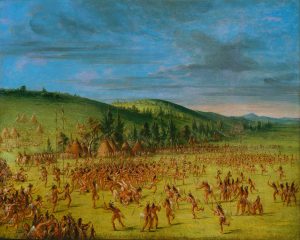
“We Play to Please the Creator” by Chris Swezey, Washington Post, July 20, 1998.
“The Iroquois called the game “tewaarathon,” meaning “little brother of war,'” Peter Lund wrote in “The History of the Game of Lacrosse: From the American Indians to the Present.” “They used the sport to keep their warriors in shape, to settle disputes between tribes and as a spiritual exercise to amuse and please the Creator, believed to be the god-like figure Deganawidah who, according to Iroquois legend, united the Six Nations of the Iroquois.”
“Sport: A Tool of Colonial Control for the British Empire” by Isobel Roser, Butler Scholarly Journal, April 30, 2016.
“Sport did not have a singular role in [the British] Empire, it had multiple purposes which changed and developed over time. Sport was used to create bonds, enforce British control and “civilise” the natives. Much like a pushy parent, the motherland tried to encourage her colonies to take up as many sports as possible. Ironically, the British failed to recognise that by bestowing her sports upon the Empire she was empowering her colonies, rather than suppressing them. However, initially, it was a successful imperial tactic, allowing the British a subtle, yet potent means of cultural control.”
When the modern Olympic Games began in 1896, women were not allowed to compete. In 1900, twelve female competitors were permitted to compete in tennis or golf. Through much of history, there was little interest in developing any form of equity in sport – indeed there was no need to do so. People around the world participated in casually organized sports in their villages. The emphasis of sport and strength holding masculine qualities came from a late nineteenth century push in Europe to eradicate what was seen as growing sensitivity amongst men, with compulsory sport woven into educational programmes.MenEngage, 2014 Sportsmen became symbols of strength and national pride comparable to military warriors, leading a form of celebrity which their female counterparts were unable to replicate. The sculpting of a sportsperson’s image has traditionally been masculine. Thus, while sport has the ability to promote societal good, sport has also been a contributor to social inequality through centuries of rules and practices that restrict access to participation for certain populations.
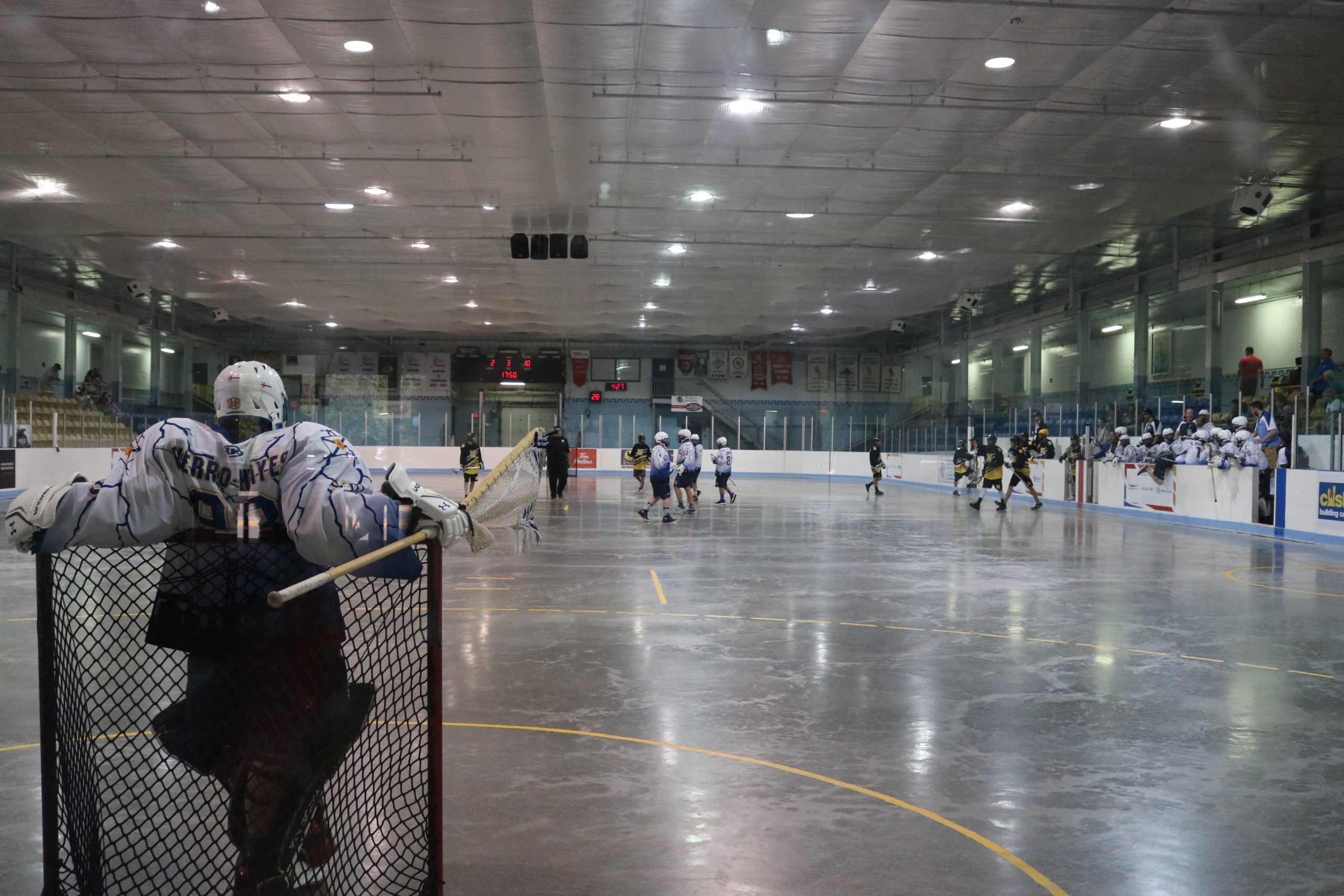
The earliest attempts to address inequalities often focus on bringing in individuals who were missing. This brings in people who may be different in terms of race, ethnicity, sex, sexual orientation and other identities but does little to ensure they feel comfortable in the environment. Equity is juxtaposed against equality. Early efforts to ensure equality provided the same standards for everyone without making allowances for individual differences. A phrase commonly thrown around among IDEA professionals is “Diversity is a fact and Inclusion is an act/choice.” Creating an inclusive environment will only happen with intentional action. Accessibility within sport is a move to ensure the greatest number of individuals can participate in the most effective way possible.
An obvious example is Title IX in the United States, passed as part of the Education Amendments of 1972, which banned sex discrimination in federally funded education programs. While the protections were wide-ranging and included gender and sexual violence committed in institutions that received federal funds, it is best known for its impact on expanding opportunities for women and girls in sports. Prior to the implementation of Title IX, female athletes received two percent of college athletic budgets, with virtually no athletic scholarships. Today, more than 100,000 women participate in intercollegiate athletics, a four-fold increase from 1971. That same year 300,000 women (7.5%) were high school athletes; in 1996, that figure had increased to 2.4 million (39%).NCWGE, 2012b
However, that startling change in participation rates does not mean equity exists for female athletes in either the United States or Canada. Once regulations laid out exactly how Title IX would work, one of the central ideas in athletics was that opportunities should fall roughly in line with enrolment. Women now make up about 58% of undergraduates but get just 43% of roster spots and 46% of Division I scholarship money. Researchers at the University of Toronto found much the same in Canada. For every 100 men in Canadian universities, there are 2.9 chances to play a sport. For every 100 women, there are just 1.8 chances.
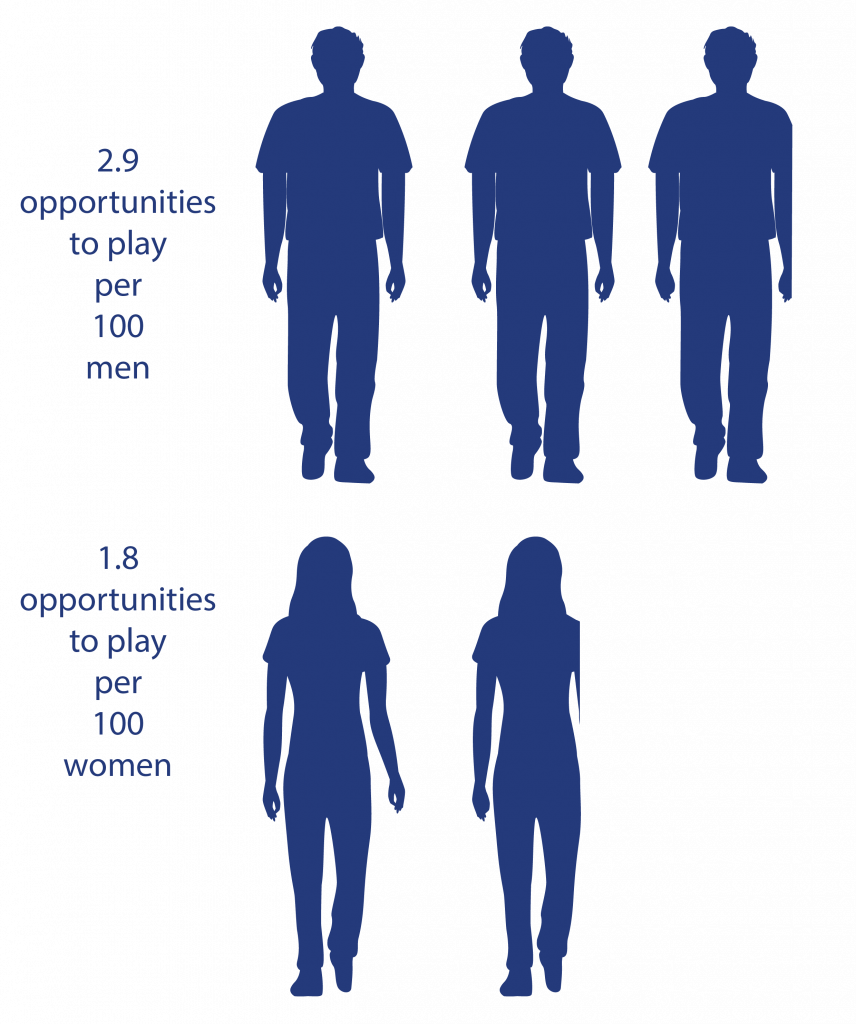
Canadian Interuniversity Sport data shows that an identical proportion—40%—of male and female athletes received scholarships last year. However, men got 6.7 million dollars while the women only received 4.8 million dollars. Given that the enrolment rate is higher for females than males, females should represent more than half of student athletes and receive more than half of the scholarship funds distributed. However, current statistics indicate that scholarship funding is not even reporting a 50:50 split between men and women.Sportsnet, 2019
The primary lens through which we view accessibility is that of disability. When we discuss accessibility of sports, we must think holistically. When does socioeconomic status impede participation in certain sports? When does geography make it difficult to participate in some sports? Disability in sport did not exist to a significant degree until Dr. Ludwig Guttmann created a competition for war veterans with spinal injuries in 1948. Guttman led a Spinal Injuries Centre in England which was known for its progressive rehabilitation programmes, including introducing competition and sportsmanship back into patients’ lives.
The debut games – named the Stoke Mandeville Games, after the hospital facility they were in – was timed to coincide with the 1948 London Olympic Games to encourage morale and competitive spirit. Holland recognised Guttman’s successful rehabilitation work for veterans and joined the Games in 1952. Today, we recognize this movement as the first Paralympics. The Olympic-based format of the competition and official recognition as part of the Games did not occur until Rome 1960 when four hundred athletes competed and were dubbed with the official Paralympic title in Tokyo 1964.Studio Republic, 2020
The Centre for Sport and Human Rights (CSHR) serves as a human rights organisation for the world of sport. The CSHR notes that the foundational principles of the world’s preeminent sport bodies speak to universal humanitarian values, harmony among nations, solidarity and fair play, the preservation of human dignity, and commitment to non-discrimination. In Convergence 2025, the strategic plan released by CSHR in September 2021, a sports ecosystem model is used to examine power differentials in sport.
“Power dynamics in traditional sports structures can exacerbate human rights risks to athletes and others. Reimagining sport from a holistic people-centred perspective is an important way to address these concerns. By applying a human rights lens to the ecosystem of sport, an arena that represents an intricate web of symbiotic relationships is revealed encompassing those affected and between different groups of institutional actors (see Figure 5.2). A rights-focused ecosystem model with people at the centre, shows that each of these interactions between all stakeholder groups may impact – positively or negatively – different individuals and communities, through the direct and indirect roles they play.”Centre for Sport & Human Rights, n.d.a, p. 14)
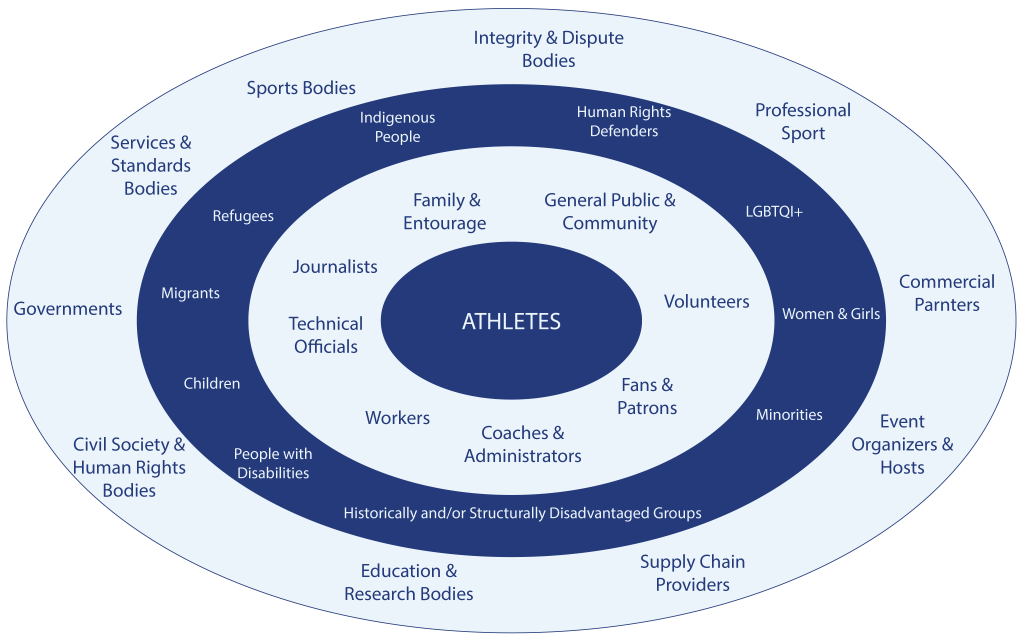
The Centre for Sport and Human Rights (CSHR) lists ten “Sporting Chance Principles” which affirm a shared commitment to realizing human rights in and through sport. These principles include:
Sport cannot exist separate from the world of politics as international human rights, standards, policies, and procedures transcend sport governance at every level. This has been demonstrated on many occasions including Olympic Games boycotts, Jesse Owens’ participation in the 1936 Berlin Games, and the definitions of “male” and “female” applied on the world stage.
We have recently seen how the activism of a lone athlete taking a stance can influence human rights issues on a global scale. National Football League quarterback Colin Kaepernick refused to stand during the United States national anthem in protest of systemic racism within the United States in 2016. While Kaepernick’s activism made him a persona non grata for the NFL, his actions (along with the repercussions felt around the world from George Floyd’s murder in May 2020) have led to players taking knees, wearing armbands, and holding moments of silence that speak to the impact of racism at a global level in sport.
However, despite this acknowledgement and understanding of human rights, there are still cases that provoke controversy and outrage at the international level. In March 2019, the International Association of Athletics Federation (IAAF) was criticized by the United Nations Human Rights Council (UNHRC) over concerns that their “discriminatory regulations […] to medically reduce blood testosterone levels contravene international human rights […] including the right to equality and non-discrimination…and full respect for the dignity, bodily integrity and bodily autonomy of the person.”
With specific reference to the IAAF’s Differences of Sexual Development Regulations, the UNHRC called upon states to “ensure that sporting associations […] refrain from developing and enforcing policies […] that force, coerce or otherwise pressure […] athletes into undergoing unnecessary, humiliating and harmful medical procedures”. A 2020 Human Rights Watch report noted that testosterone regulations are humiliating for the athlete, medically unnecessary and lead to human rights violations. Some of the violations outlined in the report include: physical and psychological injury, career loss based on discrimination, coerced medical intervention, and a violation of fundamental rights to health, privacy and dignity. Testosterone regulation also reinforces racially biased and Western standards of femininity, leading to the disproportionate discrimination of women of colour from Africa, Oceania, Asia, and Latin America.Human Rights Watch, 2020.
Highly publicized cases of this rule restricting athletes from participation include South Africa’s Caster Semaya, as well as Namibian 2020 Olympic medal contenders Christine Mboma and Beatrice Masilingi who were pulled from the 400m due to their high testosterone levels and forced to compete in the 200m event. As CBC Sports’ commentator Morgan Campbell wrote,
“Except there’s a qualitative difference between anabolic steroids and naturally produced testosterone. Mboma’s and Masilingi’s default hormonal settings are no more an unfair advantage than Kawhi Leonard’s giant hands, or keen eyes in Major League Baseball, where the average player sees with 20/13 vision. If you can picture MLB forcing left-handers with 100 mph heat and 20/10 vision to play first base, arguing their natural tools were unfair to regular players, then you can understand how arbitrary, targeted unfairness of World Athletics’ testosterone guidelines.”Campbell, 2021
The Swiss-based Court for the Arbitration of Sport ruled that forcing or coercing athletes to undergo unnecessary medical treatment is discriminatory. The panel found that the DSD Regulations are discriminatory, but the majority of the panel found that, on the basis of the evidence submitted by the parties, such discrimination is a necessary, reasonable and proportionate means of achieving the IAAF’s aim of preserving the integrity of female athletics in the restricted events.


“When Should Countries Boycott the Olympics,” by Sergei Guriev, New York Times Opinion Pages, February 6, 2014.
“2-time Olympic snowboarder calls for Team Canada boycott of Beijing 2022,” by Karin Larsen, CBC News, December 19, 2021.
“China warns nations will ‘pay price’ for Olympic boycott” BBC News, December 9, 2021.
There have been Olympic Games boycotts in 1936, 1956, 1964, 1972, 1980, and 1984. The geopolitics of the twenty-first century has brought about debate prior to almost all recent Olympic Games. Young, 2008
“Jesse Owens Biography” Olympics.com
Jesse Owens travelled to Berlin to take part in the 1936 Olympics – an event overseen by Adolf Hitler, which the new German chancellor hoped would profile the supremacy of the Aryan “master race”. It wasn’t to be. The African-American Owens stole the show. He won the 100m in 10.30 seconds, the 200m in 20.70 seconds, and then the long jump, with an impressive leap of 8.06 metres – apparently after getting some advice about his run-up from a German competitor, Luz Long. His fourth gold came in the 4x100m relay, in which Owens formed a key part of the team that set a new world record of 39.80 seconds.
“IOC transgender guidelines delayed again to 2022 due to ‘conflicting opinions‘” by Michael Houston, Inside the Games, September 21, 2021.
There has been much controversy from the International Olympic Committee on protecting and promoting the human rights of transgender and intersex athletes in competition.
In the world of Olympic sport, women of all ethnic and cultural backgrounds are still finding it difficult to make headway in positions of leadership. The latest Association of Summer Olympic International Federations (ASOIF) Review of International Federation Governance discovered that only one international sports federation had a board that was more than 40% female, while 18 IFs had a proportion of less than 25%. Indeed, when analyzing ten indicators related to international federation integrity, “appropriate gender balance in executive board or equivalent” achieved the lowest mean score, meaning international sport governing boards remain disproportionately male.
Employment practices associated with the sports industry, such as internal hiring practices, are one of the top barriers preventing diversity in the workplace.Bradbury & Conricode, 2020 To change this, people working in sport must “interrogate” how they got there and either change the norm or forcefully create networks that are more inclusive. Changing the internship system, in which eager students work for a big league or franchise for no salary (usually in a city that is expensive to reside in) would be a good start to create opportunities for marginalized students.
An interactive H5P element has been excluded from this version of the text. You can view it online here:
https://ecampusontario.pressbooks.pub/safesport/?p=147#h5p-10
Sports organizations at every level must take seriously the policies that have been put in place to progress IDEA within the domain. Some of these shifts will be difficult, requiring changes in languages, attitudes, and character. There must be a full understanding of why everyone will benefit when the most marginalized in society are fully included.
A pivotal shift sport organizers, managers, coaches, and athletes can also apply to their sporting practice is listening attentively to the voices and opinions of athletes. Integrating the voices of those who are experiencing maltreatment is critical to ending its presence. Furthermore, allowing athletes to have a voice promotes a safe space and encourages athletes to remain involved in sport. We recommend taking an intersectional, trauma and violence informed care (TVIC) approach to integrating Safe Sport practices into sport programs. TVIC considers the multiple identities and oppressions that affect athlete participation, along with potential trauma or violence that athletes have experienced as a result of that oppression.
This could be as simple as listening to athlete voices when creating codes of conduct, policies, educational materials, practice schedules, building layouts and facilities, and marketing materials. Additionally, intersectional and TVIC approaches align with Gurgis and Kerr’s (2021) recommendation that Safe Sport practices promote human rights and advance both athlete and sport development without leaving those who are marginalized behind. These strategies are also meant to promote inclusion, diversity, equity, and accessibility in sporting spaces, while keeping the rights of the athlete as its centre focus.
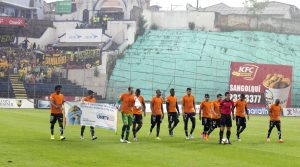
An interactive H5P element has been excluded from this version of the text. You can view it online here:
https://ecampusontario.pressbooks.pub/safesport/?p=147#h5p-11
Key Terms
An interactive H5P element has been excluded from this version of the text. You can view it online here:
https://ecampusontario.pressbooks.pub/safesport/?p=147#h5p-12
Suggested Assignments
Image Descriptions
Figure 5.2 This figure shows the sport ecosystem, with contents adapted from the Centre for Sport and Human Rights. In the centre of the ecosystem are athletes. In the field surrounding athletes are coaches & administrators, fans & patrons, volunteers, the general public & community, family & entourage, journalists, technical officials, and workers. The third level includes children, migrants, refugees, Indigenous people, human rights defenders, LGBTQ+, women & girls, minorities, people with disabilities, and historically and/or structurally disadvantaged groups. The final level of the ecosystem includes supply chain providers, education & research bodies, civil society & human rights bodies, governments, services & standards bodies, sports bodies, integrity & dispute bodies, professional sport, commercial partners, event organizers & hosts. [return to text]
Figure 5.3 This interactive feature demonstrates the concept of IDEA, or inclusivity, diversity, equity, and accessibility. Inclusion is ensuring all individuals are equally supported, valued, and respected. This is best achieved by creating a research environment in which all individuals (students, faculty, staff, and visitors) feel welcomed, safe, respected, valued, and are supported to enable full participation and contribution. An inclusive and welcoming research culture embraces differences of opinions and perspectives while fostering a learning ecosystem underpinned by respect by all and for all. Diversity is the wide range of attributes within an individual, group, or community that makes them distinctive. Dimensions of diversity consider that each person is unique and recognizes individual differences including ethnic or national origin, gender, gender identity, and gender expression, sexual orientation, background (socio-economic status, immigration status or class), religion or belief (including absence of), civil or marital status, family and caretaker obligations (i.e., pregnancy, elderly), age, and disability. Equity is the fair treatment and access to equal opportunity (justice) that allows the unlocking of one’s potential, leading to the further advancement of all peoples. The pursuit of equity is about the identification and removal of barriers to ensure the full participation of all people and groups. Accessibility is the provision of flexibility to accommodate needs and preferences, and refers to the design of products, devices, services, or environments for people who experience disabilities. “We can look at this as a set of solutions that empower the greatest number of people to participate in the activities in question in the most effective ways possible.” [return to text]
Sources
Abbatine, T., Laby, D. M., & Kirschen, D. G. (2019, August 8). Scope and rope: A visual profile of Major League hitters. Baseball America. Retrieved December 31, 2021, from https://www.baseballamerica.com/stories/scope-and-rope-a-visual-profile-of-major-league-hitters/#:~:text=The%20average%20visual%20acuity%20of,results%20on%20the%20general%20population.
Baker, J. & Vasseur, L. (2021, September). Inclusion, diversity, equity & accessibility (IDEA): Good practices for researchers. Canadian Commission for UNESCO. Ottawa: Canada. https://brocku.ca/unesco-chair/wp-content/uploads/sites/122/ToolkitIDEA.pdf
BBC News. (December 9). China warns nations will ‘pay price’ for Olympic boycott. Retrieved December 31, 2021, from https://www.bbc.com/news/world-asia-china-59592347
Bradbury, S., & Conricode, D. (2020). Game changer or empty promise?. In S. Bradbury, J. Lusted & J. Sterkenburg (Eds.), ‘Race’, ethnicity and racism in sports coaching (pp. 211-232). Routledge.
Campbell, B. (2021, July 7). Rules governing Olympic runners send a disturbing message to female athletes, especially those who are Black. CBC Sports. Retrieved December 31, 2021, from https://www.cbc.ca/sports/opinion-case-of-namibian-runners-further-exposes-half-baked-testosterone-regulation-1.6092033
Caudwell, J., & McGee, D. (2018). From promotion to protection: Human rights and events, leisure and sport. Leisure Studies, 37(1), 1–10. https://doi.org/10.1080/02614367.2017.1420814
Centre for Sport & Human Rights. (n.d.a). Convergence 2025: Strategic plan (2021-2025). https://sporthumanrights.org/media/os5fx2z0/cshr_convergence_2025.pdf
Centre for Sport & Human Rights. (n.d.b). About us. Retrieved December 31, 2021, from https://www.sporthumanrights.org/about-us
Centre for Sport & Human Rights. (n.d.c). Sporting chance principles. Retrieved December 31, 2021, from https://www.sporthumanrights.org/about-us/principles/
Colin Kaepernick. (n.d.). Retrieved December 31, 2021, from https://kaepernick7.com
Cooper, J. N., Macaulay, C., & Rodriguez, S. H. (2019). Race and resistance: A typology of African American sport activism. International Review for the Sociology of Sport, 54(2), 151–181. https://doi.org/10.1177/1012690217718170
Deutsche Welle (DW). (2020, February 20). Racism expert Gerd Wagner: The precedent of abandoning a match needs to be set. Retrieved December 31, 2021, from https://www.dw.com/en/racism-expert-gerd-wagner-the-precedent-of-abandoning-a-match-needs-to-be-set/a-52434651
Deutsche Welle (DW). (2021, December 19). German professional football match abandoned due to racist abuse. Retrieved December 31, 2021, from https://www.dw.com/en/german-professional-football-match-abandoned-due-to-racist-abuse/a-60187659
Gurgis, J. J., & Kerr, G. A. (2021). Sport administrators’ perspectives on advancing safe sport. Frontiers in Sports and Active Living, 3, 630071. https://doi.org/10.3389/fspor.2021.630071
Guriev, S. (2014, February 6). There are more effective ways to bring about change in Russia. The New York Times. Retrieved December 31, 2021, from https://www.nytimes.com/roomfordebate/2014/02/06/when-should-countries-boycott-the-olympics/there-are-more-effective-ways-to-bring-about-change-in-russia
Hall, M. A. (2002). The girl and the game: A history of women’s sport in Canada. Broadview Press.
Houston, M. (2021, September 21). IOC transgender guidelines delayed again to 2022 due to “conflicting options”. Inside the Games. Retrieved December 31, 2021, from https://www.insidethegames.biz/articles/1113268/ioc-transgender-guidelines-delay-2022
Human Rights Watch. (December 4, 2020). “They’re chasing us away from sport.” Retrieved January 7, 2022. https://www.hrw.org/report/2020/12/04/theyre-chasing-us-away-sport/human-rights-violations-sex-testing-elite-women
International Olympic Committee. (IOC). (n.d.). Jesse Owens. Retrieved December 31, 2021, from https://olympics.com/en/athletes/jesse-owens
International Paralympic Committee. (n.d.). Paralympics History. Retrieved December 31, 2021, from https://www.paralympic.org/ipc/history
Kerr, R., & Kerr, G. (2020). Promoting athlete welfare: A proposal for an international surveillance system. Sport Management Review, 23(1), 95–103. https://doi.org/10.1016/j.smr.2019.05.005
Kidd, B. (2011). Cautions, questions and opportunities in sport for development and peace. Third World Quarterly, 32(3), 603–609. https://doi.org/10.1080/01436597.2011.573948
Larsen, K. (2021, December 19). 2-time Olympic snowboarder calls for Team Canada boycott of Beijing 2022. CBC News. Retrieved December 31, 2021, from https://www.cbc.ca/news/canada/british-columbia/2-time-olympic-snowboarder-calls-for-team-canada-boycott-of-beijing-2022-1.6287991
MenEngage (2014). Brief on sports and the making of men. http://menengage.org/wp-content/uploads/2014/04/Advocacy-Brief-Sport.pdf
National Coalition for Women and Girls in Education (NCWGE). (2012b). Title IX at 40: Working to ensure gender equity in education. Washington, DC: NCWGE. https://www.ncwge.org/PDF/TitleIXat40.pdf
Pieper, L. (2016). Introduction. In sex testing: Gender policing in women’s sport. University of Illinois Press.
Roser, I. (2016, April 30). Sport: A tool of colonial control for the British empire. The Butler Scholarly Journal. Retrieved December 31, 2021, from https://butlerscholarlyjournal.com/2016/04/30/sport-a-tool-of-colonial-control-for-the-british-empire/
Rowbottom, M. (2021, October 1). Convergence 2025 strategy launched by Centre for Sport and Human Rights. Inside the Games. Retrieved October 31, 2021, from https://www.insidethegames.biz/articles/1113662/centre-for-sport-and-human-rights-plan
Savulescu, J. (2019, May 9). Ten ethical flaws in the Caster Semenya decision on intersex in sport. The Conversation. Retrieved December 31, 2021, from https://theconversation.com/ten-ethical-flaws-in-the-caster-semenya-decision-on-intersex-in-sport-116448
Smith, B., & Sparkes, A. C. (2019). Disability, sport, and physical activity. In N. Watson & S. Vehmas (Eds.), Routledge handbook of disability studies (pp. 391–403).
Sportsnet. (2012, June 19). SN magazine: Women still on the sidelines. Retrieved December 31, 2021, from https://www.sportsnet.ca/magazine/title-ix-women-still-on-the-sidelines/
Studio Republic. (2020, January 2). A brief history of social inclusivity in sports. Retrieved December 31, 2021, from https://www.studiorepublic.com/blog/brief-history-of-social-inclusivity-in-sports
Swezey, C. (1998, July 20). ‘We play to please the creator’. The Washington Post. Retrieved October 31, 2021, from https://www.washingtonpost.com/archive/sports/1998/07/20/we-play-to-please-the-creator/7f2b7fe8-8bcc-448c-a1c5-a92b41dfe9ce/
U.S. Center for Safe Sport. (n.d.). Retrieved December 31, 2021, from https://uscenterforsafesport.org
Young, C. (2008). Olympic boycotts: Always tricky. Dissent (00123846), 55(3), 67–72. https://doi-org.proxy.library.brocku.ca/10.1353/dss.2008.0063
IV
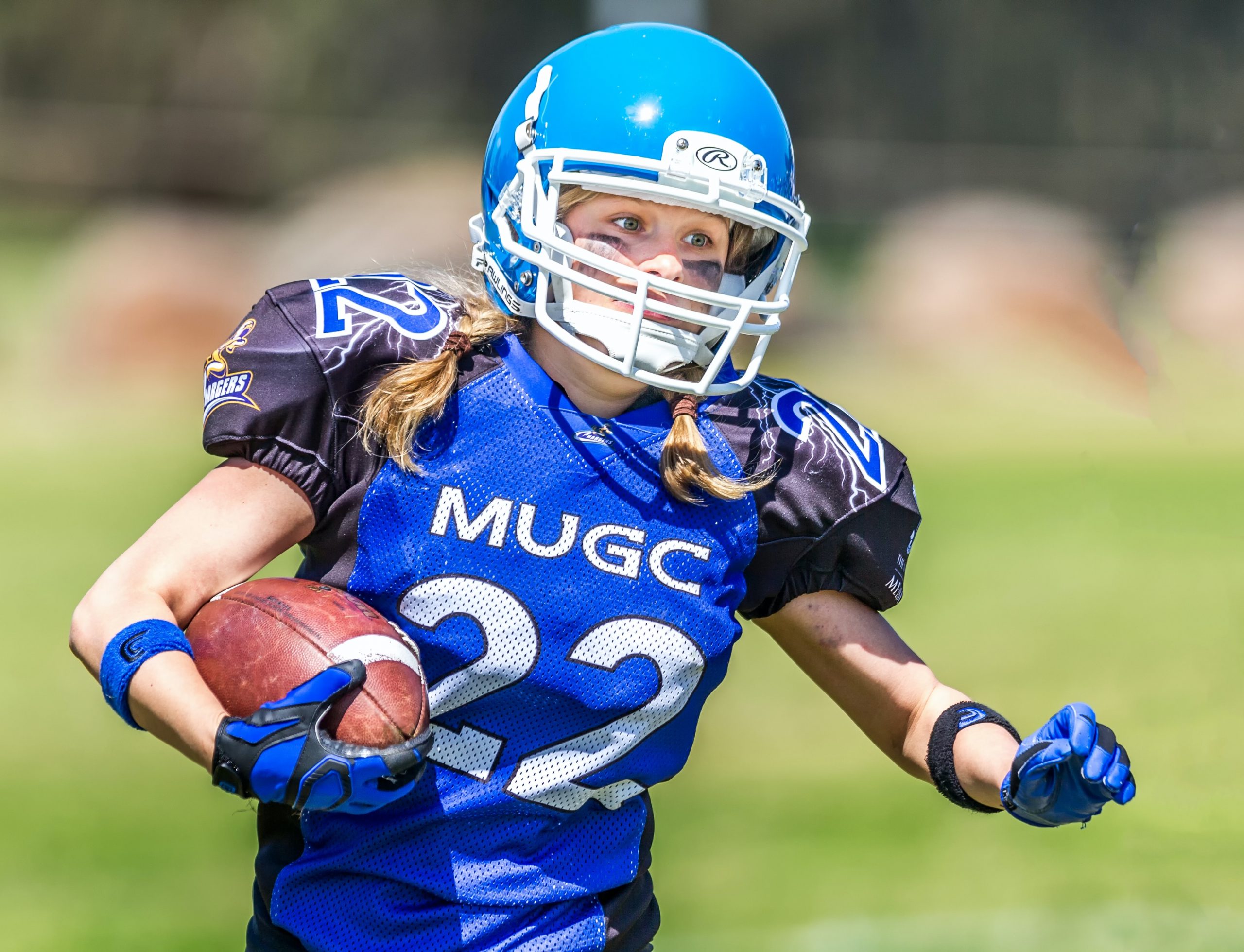
An independent body to oversee the implementation of the Universal Code of Conduct to Prevent and Address Maltreatment in Sport (UCCMS) and ensure the fair, transparent and effective management of reported cases of maltreatment has been created and will soon be a mandatory element of the federal sport system, and possibly provincial/territorial and local levels of sport. Given this, understanding the legal aspects of implementation, dispute resolution, and enforcement is critical for students, researchers, professionals and other stakeholders within the Canadian sport system.
Four phases of dealing with a complaint by this body have been identified:
Phase 1 – jurisdiction
Phase 2 – investigation
Phase 3 – dispute resolution
Phase 4 – enforcement
The following five chapters within Part 4: Legal Considerations and Safe Sport, examine key issues of each phase.
| CAC | Coaching Association of Canada |
| CADP | Canadian Anti-Doping Program |
| CAS | Court of Arbitration for Sport |
| CCES | Canadian Centre for Ethics in Sport |
| COC | Canadian Olympic Committee |
| ECHR | European Court of Human Rights |
| FEI | International Equestrian Federation |
| FIN | Italian Swimming Federation |
| FINA | International Swimming Federation |
| FIPPA | Freedom of Information and Protection of Privacy Act |
| HRTO | Human Rights Tribunal of Ontario |
| ICAS | International Council of Arbitration in Sport |
| IF | International Sport Federation |
| IOC | International Olympic Committee |
| IPC | International Paralympic Committee |
| ISU | International Skating Union |
| ITFs | International Tennis Federation |
| ITP | Idenpendent Third Party |
| JAMS | Judicial Arbitration Management Service |
| LGBTQIA | Lesbian, gay, bisexual, trans, transexual, transgender, questioning, queer, intersex, asexual |
| NGBs | National Sport Governing Bodies |
| NIM | National Independent Mechanism |
| NSO | National Sport Organization |
| NSP | National Safeguarding Panel |
| NTC | National Team Committee |
| OLTFC | Ottawa Lions Track and Field Club |
| PIPEDA | Personal Information Protection and Electronic Documents Act |
| PTSOs | Provincial/Territorial Sport Organizations |
| SDRCC | Sport Dispute Reolution Centre of Canada |
| SFT | Swiss Federal Tribunal |
| U.K. | United Kingdom |
| U.S. | United States |
| UCCMS | Universial Code of Conduct to Prevent and Address Maltreatment in Sport |
| UEFA | The Union of European Football Associations |
| USOPC | United States Olympic and Paralympic Committee |
| WADA | World Anti-Doping Agency |
6
Marcus Mazzucco
Hilary Findlay
Sports law
Jurisdiction
Contracts
When you have completed this chapter, you will be able to:
L01 Define the concept of jurisdiction and how it relates to sport bodies adopting and implementing the UCCMS;
L02 Identify three types of contracts that can be used to acquire jurisdiction in sport;
L03 Explain how the monopolistic character of sport governing bodies assists in acquiring jurisdiction; and
L04 Explain the importance of differentiating between members and non-members of an organization.
This chapter examines the jurisdiction of sport bodies to implement and apply the Universal Code of Conduct to Prevent and Address Maltreatment in Sport (UCCMS). At the national sport governing level, application of the UCCMS will need to extend beyond the scope of authority of federally funded sport organizations in order to capture those who are not members of those organizations, such as coaches and athletes. This extension of jurisdiction can be accomplished through contractual means. The further application of the UCCMS to provincial, territorial, and local levels of sport becomes more complex and raises important questions about the use of contract law to establish a sport body’s jurisdiction.
An interactive H5P element has been excluded from this version of the text. You can view it online here:
https://ecampusontario.pressbooks.pub/safesport/?p=161#h5p-13
As of March 31, 2021, national level sport organizations (NSOs) accepting funding from Sport Canada must adopt and integrate the Universal Code of Conduct to Prevent and Address Maltreatment in Sport (UCCMS) into their organizational policies and procedures.Section 5.1.3 of Annex A of the Sport Canada Contribution Agreement as cited in McLaren Global Sport Solutions, 2020 As part of adopting this policy, a National Independent Mechanism (NIM) will develop and oversee certain operational aspects of the UCCMS, such as investigations, decision-making, and dispute resolution.Except in cases involving an alleged sexual mistreatment of a minor, organizations can choose to opt out of the process overseen by the NIM (Sport Dispute Resolution Centre of Canada) and manage the process themselves (though they may not opt out of the non-procedural aspects). It seems unlikely this will happen given the efficiencies of using the independent process and the general inclination of the sport community to adopt a single independent process for handling matters of maltreatment in sport. (SIRC, 2019; McLaren Global Sports Solutions, 2020) The Sport Dispute Resolution Centre of Canada (SDRCC) has been selected by the Canadian federal government to act as the NIM. The UCCMS has been introduced at the national level to national sport governing bodies with the intent of subsequently expanding it to the provinces and territories and to local club and sport organizations.
Issues of jurisdiction will play an important role in the adoption of the UCCMS by sport organizations along with its associated operational aspects that will be overseen by the SDRCC as the NIM. Jurisdiction refers to the territory or sphere of activity over which an organization’s or individual’s authority extends. In the context of maltreatment in sport, the jurisdiction of the SDRCC and the sport organization are relevant. The SDRCC requires jurisdiction to carry out its investigative, decision-making, and dispute resolution functions. The national sport organization is essential in assisting the SDRCC in obtaining this jurisdiction through its legal relationships with sport participants. The national sport organization also requires jurisdiction to apply and enforce the UCCMS with sport participants, and to carry out functions that fall outside the authority of the SDRCC.As noted by McLaren Global Sports Solutions (2020), certain investigations and decision-making processes may fall outside of the independent body’s exclusive jurisdiction over allegations of sexual maltreatment, grooming, serious physical abuse, and consensual sexual activity with a person over the age of majority. The sport organizations can choose to provide these investigative or decision-making services (through the use of another independent third party, or request that the SDRCC provide these services.
A sport organization will typically have jurisdiction over its membership in accordance with the terms of its governing documents (for example, its constitution, bylaws, policies, and regulations). It does not have such jurisdiction over non-members, absent a legal relationship with those non-members. Where the scope of application of the UCCMS extends beyond the membership of the national sport governing body, the question thus arises as to what jurisdiction a national sport body has to apply and enforce the terms and conditions of the UCCMS (including the powers of the NIM charged with managing procedural aspects of the UCCMS) on both members and non-members? What considerations apply to extending the UCCMS to provincial and territorial governing bodies as well as to local clubs and associations?
This chapter examines the issue of jurisdiction at the national, provincial and territorial, and local levels. Specifically, we examine the ways by which a sport organization can take jurisdiction over a matter and the limitations placed on such jurisdiction. A summary of the contractual landscape is discussed in the following section and set out in Figure 6.1 (see below).
There are two mechanisms by which an entity generally gains jurisdiction: through legislation or by contract. In the Canadian context of maltreatment in sport, sport governing bodies will have obligations to implement the UCCMS through direct contractual relationships with Sport Canada, and the NIM (SDRCC) will obtain jurisdiction through contractual relationships between sport governing bodies and participants. In the United States, on the other hand, the jurisdiction of the Center for SafeSport and the requirement for national governing bodies to adopt, apply and enforce the SafeSport Code arise from legislation.U.S. Code, Chapter 36, section 2205 imposes obligations on the USOPC and NGBs to comply with the SafeSport Code, and assigns responsibility to the U.S. Center for SafeSport to administer key aspects of the safe sport program.
Legislation is arguably the better instrument where the rules are meant to be truly mandatory for all.There is no consensual element to legislated obligations whereas a key characteristic of contract is its consensual nature. One may query whether the relationship between Sport Canada and the national sport governing bodies reflects a true contractual relationship with meaningful input and consent to the terms of the contract in the situation where, for most sport governing bodies, their financial welfare depends on government funding. However, the federal structure of the Canadian landscape makes that impractical, if not impossible. Sections 91 and 92 of the Constitution Act, 1867 distribute legislative authority between the federal government and the provinces and territories. Section 92 assigns authority over matters related to property and civil rights, which encompasses most aspects of sport. There is no federal legislative authority by which sport organizations can be compelled to adopt either the UCCMS or the operational aspects of the NIM. While provincial and territorial legislation remains a theoretical option, it is unlikely that every provincial and territorial government would enact legislation that requires the adoption of the UCCMS by sport organizations operating in their jurisdictions when such a requirement can be achieved through contractual means. If provincial and territorial legislative action cannot be coordinated and consistent, then it would risk a further fragmentation of safe sport initiatives that already exist in Canadian sport.
The following sections describe the various levels of contracts that are required to apply and enforce the UCCMS in Canadian sport.
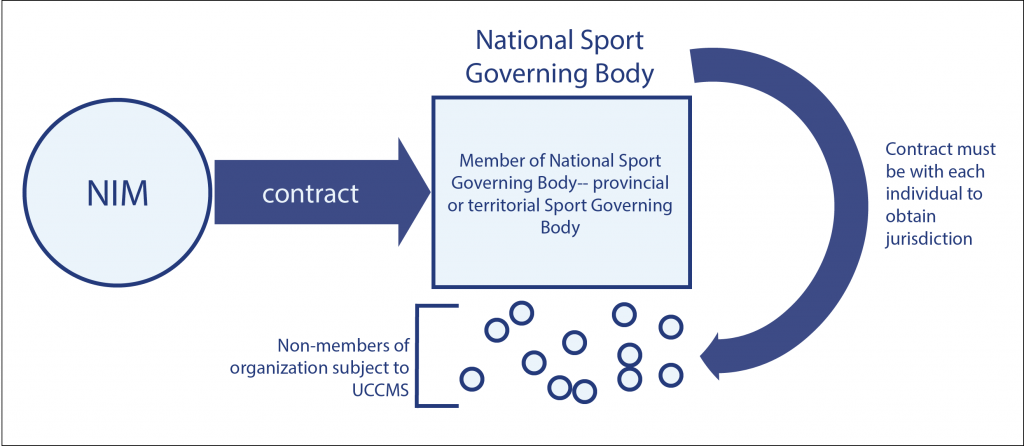
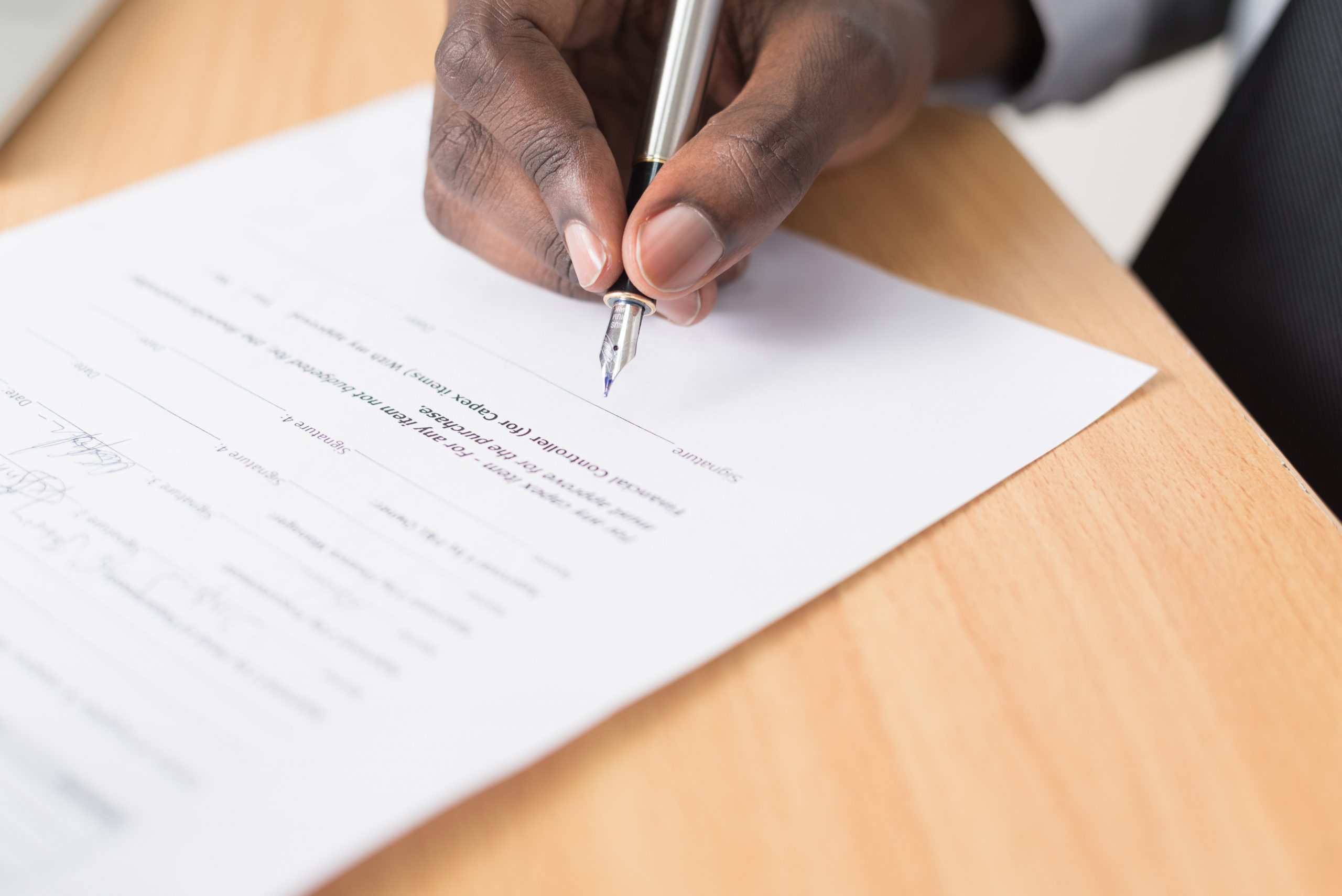
It is generally accepted that contracts are the backbone of sport.Sullivan, 2010; Freeburn, 2018, pp. 19-; Beloff et al., 1999, pp. 22- Indeed, it is said “the authority of private or domestic tribunal is derived solely from contract, that is, from the agreement of the parties concerned”Lee v. Showmen’s Guild of Great Britain, 1952 and “the authority of the sport governing body is purely consensual, arising from the membership agreement between the organi[z]ations and its members.”There is no consensual element to legislated obligations whereas a key characteristic of contract is its consensual nature. One may query whether the relationship between Sport Canada and the national sport governing bodies reflects a true contractual relationship with meaningful input and consent to the terms of the contract in the situation where, for most sport governing bodies, their financial welfare depends on government funding. (Freeburn, 2018, p. 9) And again, “[t]he application of the rules of associations to members is founded on the voluntary relationship between association and member.”Sullivan, 2010; Freeburn, 2018; Beloff et al., 1999
To be valid, and thus enforceable, a contract must meet certain legal requirements. Traditionally, these have included an offer, acceptance of that offer, consideration (or benefit) flowing between the parties in the form of reciprocal promises and, finally, an intention by the parties to be legally bound. There are other inherent characteristics that bring effect to these requirements and that are recognized as part of the contractual relationship between an organization and its members. Specifically, an agreement must be both voluntary and consensual.
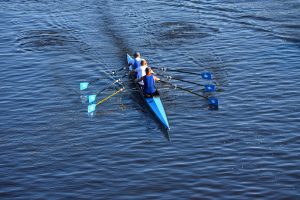
The crafting of the UCCMS and the selection of the NIM to oversee implementation of the policy is the result of the collective action of the sport community.SIRC, 2019 The first level of contract needed to successfully implement the UCCMS is between Sport Canada and federally funded sport organizations – known as the Contribution Agreement. Through the Contribution Agreement, Sport Canada has made federal funding contingent upon the adoption of the UCCMS.Federal funding makes up a significant portion of the budgets of most national sport governing bodies that most organizations cannot afford to lose. Most Canadian sport governing bodies are supportive of a pan-Canadian policy for dealing with maltreatment in sport and have entered into this funding agreement with Sport Canada wherein they have adopted the UCCMS in exchange for federal funding through a Contribution Agreement. However, a problem arises with regard to the jurisdiction of national sport governing bodies to apply and enforce the UCCMS.
The Contribution Agreement between the national sport governing body and Sport Canada stipulates that anyone “affiliated” with the organization shall be subject to the UCMMS. The Contribution Agreement goes on to define “affiliated” persons:
“For the purposes of this Agreement, “individuals affiliated with the organization” includes an athlete, a coach, an official, an athlete support personnel, an employee, a contractual worker, an administrator or a volunteer acting on behalf of, or representing the recipient in any capacity.” (Annex A, Section 5, Contribution Agreement as cited in McLaren Global Sport Solutions, 2020)
The above definition is problematic in two respects. First, it does not distinguish between members and non-members of a sport organization. As discussed further below, a sport organization is more likely to have a contractual relationship with members than non-members. Athletes and coaches are not typically members of a national sport organization and, therefore, a sport organization must enter into separate contractual relations to have jurisdiction over these individuals. Second, the definition does not include the provincial or territorial sport organization members of a national sport organization, which leads to a missed opportunity to apply the UCCMS to the provincial and territorial levels of sport.
The following sections discuss how a sport organization obtains contractual authority over members and non-members and how the jurisdiction necessary to administer the UCCMS at the provincial, territorial and local levels of sport could be obtained through contractual means.
Sport governing bodies can only implement policy, and specifically the UCCMS, to the extent they have jurisdiction to do so.Except in cases involving an alleged sexual mistreatment of a minor, organizations can choose to opt out of the process overseen by the NIM (Sport Dispute Resolution Centre of Canada) and manage the process themselves (though they may not opt out of the non-procedural aspects). It seems unlikely this will happen given the efficiencies of using the independent process and the general inclination of the sport community to adopt a single independent process for handling matters of maltreatment in sport. (SIRC, 2019; McLaren Global Sports Solutions, 2020) The authority of an organization refers to the power or right to make decisions and enforce rules. The authority of an organization must have some legal basis or come from some legal source. The conventional view is that the authority of a sport governing body is derived solely from contract, the contract being the membership agreement between the organization and each of its members.There is no consensual element to legislated obligations whereas a key characteristic of contract is its consensual nature. One may query whether the relationship between Sport Canada and the national sport governing bodies reflects a true contractual relationship with meaningful input and consent to the terms of the contract in the situation where, for most sport governing bodies, their financial welfare depends on government funding. (Freeburn, 2018, p. 20) The terms of that membership agreement, or contract, is made up of the governing documents of the organization, including its constitution, bylaws, policies, and rules. Two important points emerge from this proposition:
Point 1: The contract binds only members, not non-members.
Point 2: Even with regard to members, an organization has no inherent authority. It can act only to the extent its rules and policies allow.Sullivan, 2010; Freeburn, 2018; Beloff et al., 1999
Within the Canadian sport structure, membership in most national sport governing bodies is typically confined to other sport governing bodies at the provincial and territorial
level.See, for example, Athletics Canada at https://athletics.ca/wp-content/uploads/2020/07/Athletics-Canada-Bylaws-July-2020.pdf.ca; Soccer Canada at https://canadasoccer.com However, pursuant to the Contribution Agreement that national sport organizations have with Sport Canada, the scope of application of the UCCMS extends beyond the membership of the national sport governing body and thus beyond its jurisdiction. If regulatory power is not underpinned by a contract, and no other legal right to exercise authority is established (such as by legislative provision), there is no legally binding power by the organization over these non-members. In other words, the national sport governing body would not have jurisdiction over all those affiliated persons Sport Canada requires it to have.
The most direct way to achieve jurisdiction over non-members, is through a direct, or express, contractual agreement between the national sport organization and each of the relevant (affiliated) parties over which the organization wishes to have jurisdiction but does not by way of membership agreement. There are several examples of such contracts in sport: the International Olympic Committee (IOC) uses direct contracts between itself and all participants in the Olympic Games. All participants must sign an entry form, which is a form of express agreement whereby participants agree to comply with the Olympic Charter, the World Anti-Doping Code, the IOC Anti-Doping Rules, the IOC Code of Ethics and other IOC guidelines.The National Olympic Committee is responsible for ensuring all participants complete entry forms. International Olympic Committee, Olympic Charter, 17 July 2020, Rule 44(2) at p. 79 Closer to home, national sport organizations have athletes sign athlete agreements wherein the athlete agrees, inter alia, to be bound by the rules and regulations of the sport organization. That said, the use of direct contracts by sport governing bodies, particularly at the international and national levels, can be geographically and logistically burdensome and is not typically relied upon.
However, express contracts will exist for non-members of a national sport organization who are employees or independent contractors retained by the organization, which may include some high-performance or national team coaches and staff.

Implied contracts also exist in sport. For example, where a sport governing body hosts a competition, individuals who agree to participate in the competition impliedly accept the technical rules of the sport body that govern the competition. Participation may indicate actual, or constructive, knowledge of the rules of play and consent to such rules, but to suggest it reflects consent to the broader regulatory authority of a sport governing body including the rules and regulations underpinning such authority, is far from the “knowledge” necessary to establish consent to a valid contract. Having regard to the requirements of a legally binding contract, contracts must be consensual. Antecedent to consent is knowledge – the parties must know to what they are consenting. Consent to the regulatory authority of an organization rests on knowledge of those regulations. In Modahl v. British Athletic Federation Ltd.Modahl v. British Athletic Federation Ltd., 2002 the Court recognized that the sport body’s rules and regulations established “[a] framework of rights and duties of sufficient certainty to be given contractual effect” but was unable to imply from that framework an actual contract between the athlete and sport organization solely on the basis of the athlete’s participation without an actual express, or direct, contract between the parties.
Most international sport federations attempt to assert jurisdictional authority over non-members, particularly athletes, through the regulatory hierarchy of sport extending from the international sport federation through to the local club. Many national sport governing bodies follow suit by exerting jurisdictional authority over non-members by requiring provincial and territorial organizational members to incorporate and comply with national-level sport policies. The provincial and territorial organizations, in turn, require their members (local clubs, associations and individualsFor example: Swim Ontario membership is made up of clubs; Soccer Ontario membership is made up of various associations, leagues and individuals; Field Hockey Ontario membership is made up of individuals, clubs and teams.) to incorporate and comply with provincial and territorial policies, which incorporate an indirect requirement to comply with national policies.
This pyramidal structure of sport results in a “flow through” of rules emanating from the top or apex of the structure through each level ending at the grassroots club level (see Figure 6.2 below). Each successive level of this pyramid structure is bound to the next by consensual agreement between the organization and its members based on the organization’s governing agreement.One may question the ultimate source of authority of the highest level of the pyramid. This is an important consideration as, without some legal source of authority, any exercise of authority is arguably invalid. The law of sport has been described as an autonomous transnational legal order and as such, is outside the control of nation states and their legal orders. (Foster, 2019) As private organizations, organized as monopolies, sport governing bodies have been viewed as self-governing. As such, the members of the national organization, who are the provincial and territorial organizations, are bound by contract to the national organization. In turn, the members of the provincial and territorial organizations, who are typically local clubs, are bound by contract to the provincial and territorial organizations. Finally, individual club members (typically parents and athletes) are contractually bound to their clubs by membership agreements.
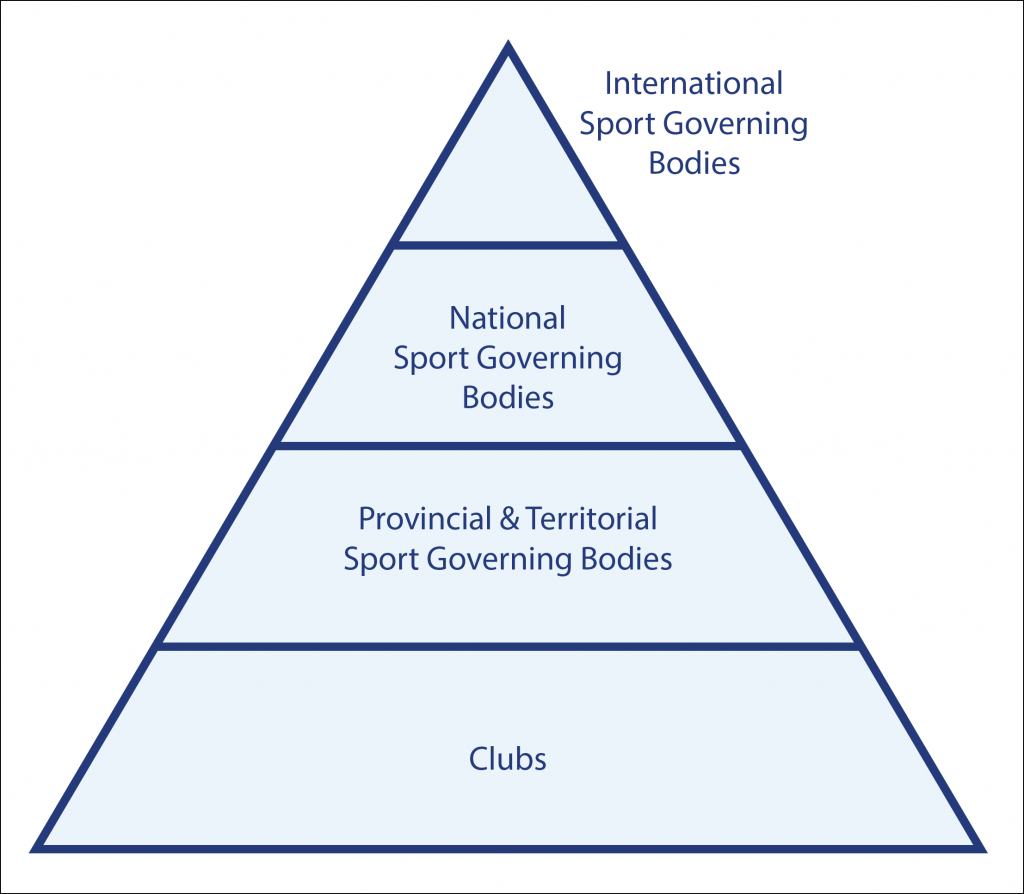
A “chain of interlocking contracts”"But there can be no doubt that the law of contract is the cornerstone on which ‘Sports Law’ has been built…" (Sullivan, 2010, p. 3; Freeburn, 2018, p. 70) binding each level of the pyramid to all those above it emerges. In this way, the international governing body can extend its regulatory influence down the entirety of the pyramid, as can the national association and provincial and territorial sport governing bodies.See for example Nagra v. Canadian Amateur Boxing Association, 2002 unreported decision of the Ontario Superior Court of Justice, where the international association required the national association to adopt a ‘clean shaven’ rule. From a contractual perspective this can be problematic. At any particular level of the pyramid, the terms of the contract between member and organization are not necessarily determined between the contracting parties, but instead are imposed by a non-party sitting above the organization in the pyramid.
This system of incorporating terms of a contract by reference into the policies of another organization (‘incorporation by reference’) is generally accepted within the governance framework of sport. Technically, it is a fiction to consider rules and regulations that are imposed on organizations and their members and to which the parties have no part in determining, to be part of an actual contract between an organization and its members. As a result, this chain of interlocking contracts has been criticized for not meeting the basic requirements for a contract on a number of grounds:“But there can be no doubt that the law of contract is the cornerstone on which ‘Sports Law’ has been built…" (Sullivan, 2010, p. 3)
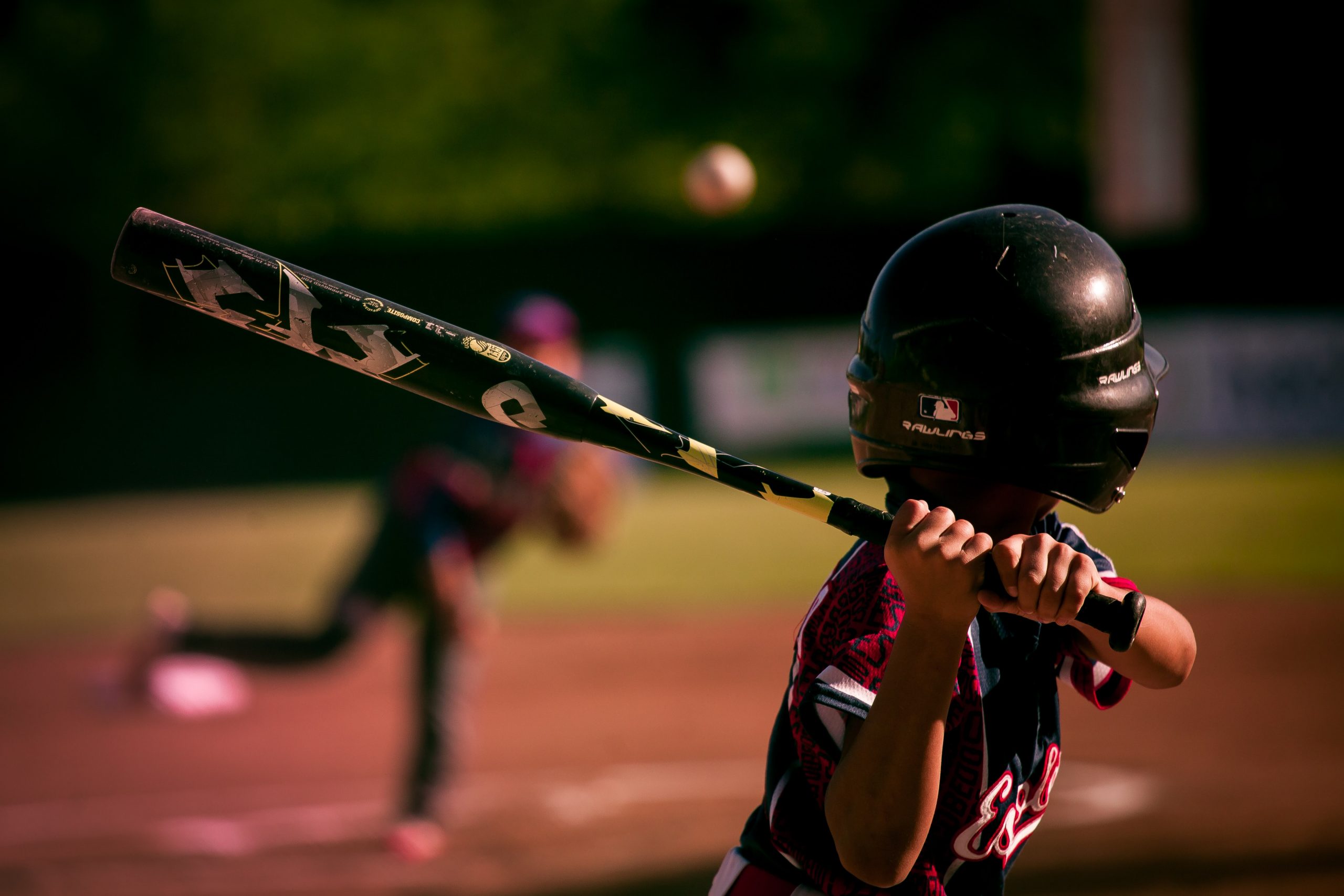
Despite these flaws in the contractual model, such a system does work because it rests on the monopolistic status of governing sport bodies.This monopolistic state of governing bodies is another reason to question the consensual nature of the relationship between organizations and their members and its contractual underpinnings. In essence those who wish to be involved in the sport have no choice but to submit to the authority of the regulatory body, even if that authority has no legal source. In order for a sport to operate with consistency and certainty, such monopoly is necessary and indeed, is an inherent characteristic of sport. It is also the way sport governing bodies can exert control over non-members even in the absence of a true contract.
“In terms of the analysis of the nature of the power of sports governing bodies, monopoly power is to be understood as a fundamental ingredient of the de facto power of sport governing bodies.”There is no consensual element to legislated obligations whereas a key characteristic of contract is its consensual nature. One may query whether the relationship between Sport Canada and the national sport governing bodies reflects a true contractual relationship with meaningful input and consent to the terms of the contract in the situation where, for most sport governing bodies, their financial welfare depends on government funding. (Freeburn, 2018 p. 100)
If a regulatory body requires participants to follow the UCCMS as a condition of participating in the sport, then that requirement will be respected in practice and is a reflection of the de facto power of the sport body.
A survey by McLarenExcept in cases involving an alleged sexual mistreatment of a minor, organizations can choose to opt out of the process overseen by the NIM (Sport Dispute Resolution Centre of Canada) and manage the process themselves (though they may not opt out of the non-procedural aspects). It seems unlikely this will happen given the efficiencies of using the independent process and the general inclination of the sport community to adopt a single independent process for handling matters of maltreatment in sport. (McLaren Global Sports Solutions, 2020, p. 38-39.) indicates that many provincial and territorial sport governing bodies support aligning their policies and regulations with a single national system as the most effective way to address and prevent maltreatment in sport. As self-governing entities, these sport bodies could integrate the nationally adopted UCCMS into their own governing structure – either voluntarily or by obligation in accordance with their membership contract with their national governing body. Provincial and territorial governing bodies could apply and enforce the UCCMS with regard to their members (local clubs and associations) and use express contracts to take jurisdiction over non-members whom they may wish to make subject to the UCCMS. A particular issue arising as the application of the UCCMS moves to the provincial and territorial and local levels is the capacity of the sport bodies to administer the UCCMS and whether the NIM will provide investigative, decision-making and dispute resolution services at these levels.
The McLaren survey suggests a number of national sport governing bodies and provincial and territorial governing bodies have aligned at least some of their existing policies with their respective national governing body, thus giving those national policies jurisdiction beyond the national level . As noted by McLaren :
“[s]ome of these [national sport organizations (NSOs)] have developed contractual agreements with their affiliated organizations that stipulate compliance with NSO policies concerning maltreatment (for example, reporting, education, and dispute resolution). Therefore, these NSOs are positioned to have the authority to mandate compliance as it concerns implementation of the UCCMS”.McLaren Global Sport Solutions, 2020, p. 36
There are other avenues through which jurisdiction can be acquired over a particular group and in a consistent fashion. The UCMMS, or some iteration of it, could be made mandatory at the provincial and territorial levels by leveraging the funding authority that provincial and territorial governments have over provincial and territorial sport governing organizations. Provincial and territorial sport organizations receive public funding, directly or indirectly, from provincial and territorial governments, and compliance with the UCCMS could be a condition of these funding arrangements.
This approach would mirror the contractual relationship between Sport Canada and federally funded sport organizations. This is perhaps the only way to ensure the same policy and policy provisions are adopted by every sport governing body receiving provincial or territorial funding. Provincial and territorial governments could also make it a condition of funding that provincial and territorial sport organizations require adoption of the UCCMS by their member local clubs. As at the national level, the provincial and territorial governing sport bodies could exercise their contractual or de facto power to require the adoption of the UCCMS by their local club members.
There is a final group to consider. There are organizations, particularly at the community level, in which people come together in pursuit of a common goal but do not have an intention to create legal relations. Typically, these organizations are unincorporated but may have a constitution, bylaws and a governing body in order to bring some organization to their common pursuit. Members of such a group do not enter into enforceable legal obligations just because they have joined a group with rules that all are expected to follow.Ethiopian Orthodox Tewahedo Church of Canada St. Mary’s Cathedral v. Aga, 2021 SCC 22; Highwood Congregation of Jehovah’s Witnesses (Judicial Committee) v. Wall, 2018 SCC 26 This might be the case for a local hockey club playing in a league or a dragon boat club participating in a schedule of competitions. These clubs are not members of any provincial or territorial governing body though individual participants may be selected to provincial or territorial teams. For a provincial or territorial sport governing body to exercise jurisdiction over such groups they must enter into a direct contractual relationship with each individual in the group.Once a participant has been selected to a provincial or territorial team, they likely would be required to be contractually bound to the provincial or territorial governing body by an athlete agreement.
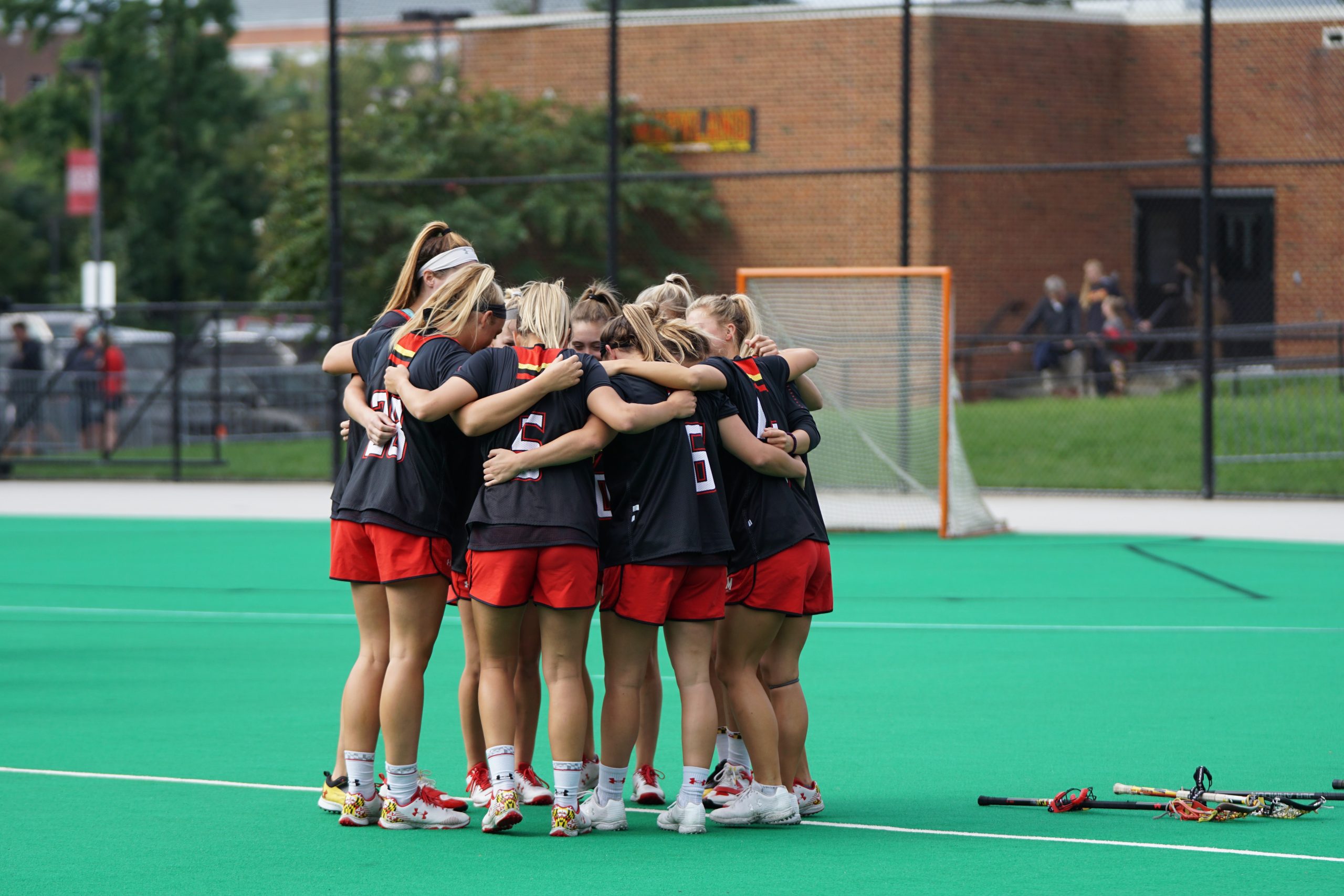
Further Research
One of the goals of this movement is to work towards a pan-Canadian harmonized approach to dealing with maltreatment in sport. From a jurisdictional perspective, this becomes more complex at the provincial, territorial, and local levels. What ways can harmonization be achieved between organizations operating at different levels and across sports? Does the global anti-doping system provide a helpful precedent wherein sport organizations can adopt their own anti-doping rules as long as the rules meet the minimum standards in the World Anti-Doping Code? Will such organizational discretion be permitted between sports (to account for sport-specific differences) or at various levels of sport (to account for jurisdictional differences) to promote a flexible but harmonized approach?
Key Terms
An interactive H5P element has been excluded from this version of the text. You can view it online here:
https://ecampusontario.pressbooks.pub/safesport/?p=161#h5p-14
Suggested Assignments
Image Descriptions
Figure 6.1 This graphic demonstrates the legal relationships between the SDRCC, sport organizations, and participants. The National Independent Mechanism (NIM) signs a contract with a sport governing body (national, provincial or territorial). A separate contract must exist between the sport governing body and non-members of the organization in order for the NIM to obtain jurisdiction. [return to text]
Figure 6.2 This graphic demonstrates the pyramidal structure of sport hierarchy, with clubs listed at the base level, provincial & territorial sport governing bodies listed above on the next level, national sport governing bodies on the next level, and international sport governing bodies at the very top of the pyramid. [return to text]
Figure 6.3 This graphic demonstrates the contractual options for acquiring jurisdiction at the national level. Sport Canada is listed on the left, making a contribution agreement with NSOs. A direct contract will apply only to members of the NSO. Alternatively, incorporation by reference or direct contact are contractual mechanisms for non-members. Non-members to whom policy may apply by contract include the athlete, coach, official, athlete support personnel, employee, contractual worker, administrator, or volunteer acting on behalf of organizations. [return to text]
Sources
Athletics Canada. (2020, July). Athletics Canada bylaws. https://athletics.ca/wp-content/uploads/2021/07/Athletics-Canada-Bylaws-July-2020.pdf
Beloff, M., Kerr, T., & Demetriou, M. (1999). Sports law. Hart Publishing.
Canadian Safe Sport Program. (2020). Sport Information Resource Centre: Universal Code of Conduct to Prevent and Address Maltreatment in Sport (UCCMS), (5)1, 1-16. https://sirc.ca/wp-content/uploads/2020/01/UCCMS-v5.1-FINAL-Eng.pdf
Constitution Act, 1982, being Schedule B to the Canada Act 1982 (UK), 1982, c 11.
Ethiopian Orthodox Tewahedo Church of Canada St. Mary’s Cathedral v. Aga, 2021 SCC 22
Field Hockey Ontario. (n.d.). Memberships: Faqs. Retrieved December 6, 2021, from https://www.fieldhockeyontario.com/membership
Foster, K. (2019). Global sports law revisited. Entertainment and Sports Law Journal, 17(1), pp. 1–14. https://doi.org/10.16997/eslj.228
Freeburn, L. (2018). Regulating international sport: Power, authority, and legitimacy. Brill Nijhoff.
Heil, J. (2021, June 29). Safety in sport is everyone’s issue. Vancouver Sun. Retrieved December 6, 2021, from https://vancouversun.com/opinion/jennifer-heil-safety-in-sport-is-everyones-issue
Highwood Congregation of Jehovah’s Witnesses (Judicial Committee) v. Wall, 2018 SCC 26
International Olympic Committee. (2020, July 17). Olympic charter: Bye-law to rule 44. p. 79. https://stillmed.olympic.org/media/Document%20Library/OlympicOrg/General/EN-Olympic-Charter.pdf
Karstens-Smith, G. (2021, July 13). Canada’s safe sport program still in need of change. The Canadian Press. Retrieved December 6, 2021, from https://www.cbc.ca/sports/olympics/summer/olympian-jennifer-heil-says-changes-still-needed-canada-safe-sport-program-1.6101870
Lee v. Showmen’s Guild of Great Britain [1952] 2 QB 329
McLaren Global Sports Solutions. (2020). Aim High: Independent approaches to administer the Universal Code of Conduct to Prevent and Address Maltreatment in Sport in Canada, final report. https://sirc.ca/wp-content/uploads/2020/12/MGSS-Report-on-Independent-Approaches-December-2020.pdf.
Modahl v. British Athletic Federation Ltd. [2002] 1 WLR 1192 at 103
Nagra v. Canadian Amateur Boxing Association (12 January 2002), unreported decision of the Ontario Superior Court of Justice, file no. 99-CV-180990
Ontario Soccer. (n.d.). District member: Contact your local district members. Retrieved December 6, 2021, from https://www.ontariosoccer.net/district-members
Patriotic and National Observances, Ceremonies, and Organizations, 36 U.S.C. 2205 (2009). https://www.govinfo.gov/app/details/USCODE-2009-title36/USCODE-2009-title36-subtitleII-partB-chap2205
Smart, Z. (2021, July 2). Heil, top Canadian athletes call on federal government to address gaps in safe sport system. CBC Sports. Retrieved November 10, 2021, from https://www.cbc.ca/sports/olympics/summer/jennifer-heil-canadian-olympians-paralympians-open-letter-1.6088744
Sport Information Resource Centre (SIRC). (2019, December). The UCCMS context document: Re: Universal Code of Conduct to Prevent and Address Maltreatment in Sport (UCCMS), version 5.1. https://sirc.ca/wp-content/uploads/2020/01/UCCMS-v5.1-Distribution-to-NSOs-MSOs-FINAL.pdf;
Sullivan, A. (2010). The role of contract in sports law. Australian and New Zealand Sports Law Journal, 5(1). Retrieved December 5, 2021, from http://classic.austlii.edu.au/au/journals/ANZSportsLawJl/2010/2.html
Swim Ontario. (n.d.). Swim Ontario membership. Retrieved December 6, 2021, from http://www.swimontario.com/news_detail.php?id=52
U.S Centre for Safe Sport. (n.d.a). Retrieved December 6, 2021, from https://uscenterforsafesport.org
U.S Centre for Safe Sport. (n.d.b). Safesport code. Retrieved December 6, 2021, from https://uscenterforsafesport.org/response-and-resolution/safesport-code/
7
Hilary Findlay
Marcus Mazzucco
Investigations
Procedural Fairness
Duty to Report
When you have completed this chapter, you will be able to:
L01 Describe the purpose of an investigation;
L02 Describe the stage at which an investigation occurs and its potential scope;
L03 Describe the key procedural protections for an investigation;
L04 Identify safeguards to prevent a biased investigation; and
L05 Explain why an investigation into alleged sport maltreatment may occur in parallel to criminal or child protection investigations.
This chapter examines the investigation of alleged maltreatment under the Universal Code of Conduct to Prevent and Address Maltreatment in Sport (UCCMS). It situates the investigation stage within the larger process of responding to allegations of maltreatment and explores the appropriate scope of an investigation. It also discusses the importance of incorporating procedural protections into the investigation to ensure a fair and unbiased process. Finally, it explores the intersection of reporting and investigative processes with parallel systems under provincial and territorial child protection laws and Canadian criminal laws.
An interactive H5P element has been excluded from this version of the text. You can view it online here:
https://ecampusontario.pressbooks.pub/safesport/?p=178#h5p-15
An investigation into an allegation of maltreatment can only occur following the formal reporting of a complaint or allegation. Formal reporting of an allegation of misconduct is distinguished from disclosure of an incident. Disclosure relates to the sharing of an experience, perhaps to a friend, trusted confidant, sport organization or to a third party. A disclosure does not initiate an investigation without the filing of a formal report.McLaren Global Sport Solutions, 2020, p. 50
Following the envisioned process under the direction of the National Independent Mechanism (NIM), once a formal complaint has been reported through a dedicated online web portal, a preliminary assessment is made to determine whether the NIM has jurisdiction over the complaint.McLaren Global Sport Solutions, 2020, p. 50 Jurisdiction refers to the sphere of activity over which an organization’s or individual’s authority extends (jurisdiction was explored previously in Chapter 6 ).
Where jurisdiction is confirmed, the complaint proceeds to the next step of the assessment to determine where the complaint should be directed. There are two possible options:
Option 1: The complaint stays with the NIM and is resolved internally through an investigation conducted by the NIM and a decision made by the NIM; or
Option 2: The complaint is directed to the independent third party (ITP) used by the sport organization (which could be the Sport Dispute Resolution Centre of Canada (SDRCC) or some other body or individual), with oversight by the NIM.
Which path a complaint will take will be determined based on a number of considerations but a key one will be the severity of the complaint. Conduct that carries a sanction of permanent ineligibility should be dealt with using the internal NIM process. Conduct of lower risk and with the possibility of informal resolution is better dealt with through the sport organization’s independent processes, but with continuing oversight by the NIM. However, if the ITP finds that the facts reveal that the alleged conduct is more serious than originally assessed, or the investigation has become too complex for it to complete, it can request that the matter be transferred back to the NIM.
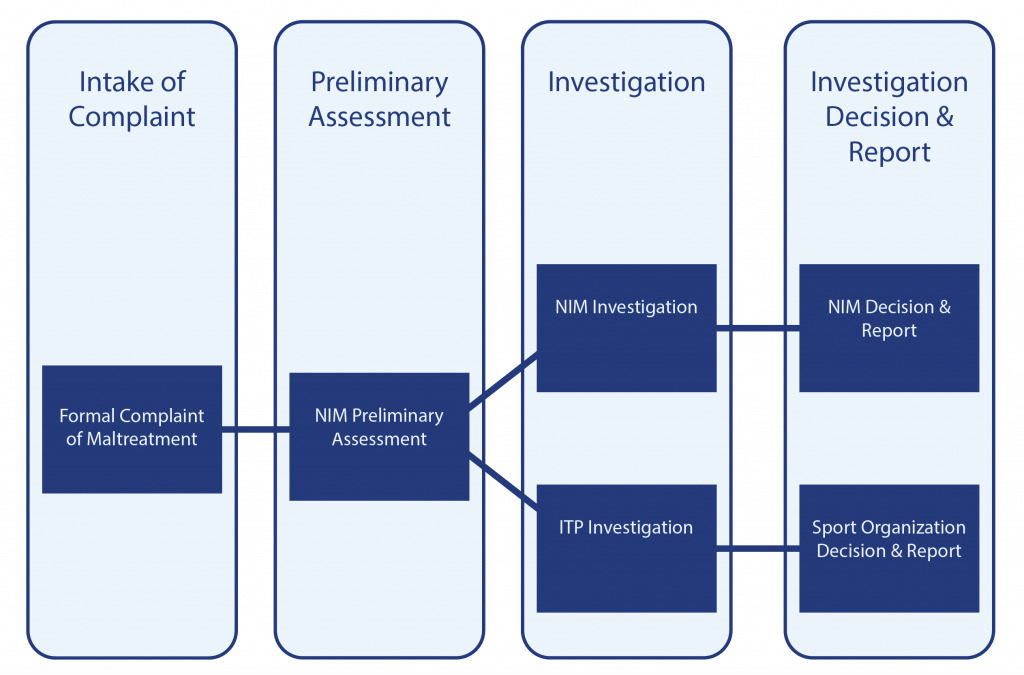
Whether the complaint is dealt with internally by the NIM or through the sport organization’s own independent process, the next significant stage of the process is the investigative stage. The investigative process is the focus of the remainder of this chapter.The UK SafeSport investigation guide considers an investigation to have begun at the point a complaint is received and any action is taken to elicit further information or explore any aspect of concern. (Chamberlain et al., n.d., p. 7)
The role of the investigator as fact-finder is to build a body of relevant and admissible evidence that will be useful eventually in confirming or refuting incidents related to the allegations. The investigation can be broken down into three main phases:
Phase 1: Information gathering and analysis
Phase 2: Determination to accept or reject the complaint
Phase 3: Report writing
The first phase of the investigation focuses on gathering information pertinent to the complaint. This will include interviews with the complainant and respondent in particular, as well as any pertinent witness, and reviewing documents, including formal documents of the organization (e.g., policies and pertinent regulations) and other written and digital material.
The scope of the information gathering is defined by the complaint and the UCCMS. The complaint sets out the alleged misconduct and the policy defines conduct constituting maltreatment. The investigation should be limited to the allegations made in the complaint. If there are multiple respondents, each should be accorded their own investigation led by separate investigators.McInnis v. Athletics Canada, 2020 Where multiple complaints of a common nature are brought against a single respondent, it may be appropriate (and procedurally efficient) to have one investigation that examines the complaints.
Information and evidence are similar, but not the same. Evidence is a certain type of information – it is information that is ultimately put before a decision-maker. It is used to prove a fact, disprove a fact, or support or contradict an argument. Evidence is usually verbal testimony, written documentation or material objects that are offered to prove the existence, or non-existence of a fact.
Evidence can also be described as information that has been judged or filtered. The purpose of these filters is to:
Not all information is evidence, and not all evidence can be accepted and given substantial weight.
The link between evidence and the incident can be direct (also known as primary evidence) or indirect. Indirect evidence can be hearsay or circumstantial (see Figure 7.2 below for an interactive exercise).
Direct evidence pertains to the incident itself – a direct examination of an object, a video recording of an event, and an account from an eyewitness, are all examples of direct evidence.
Indirect evidence is evidence from which one must draw an inference about the incident in question. A photograph taken just before or after the incident, a letter from someone describing an incident, and a witness who said they saw someone in the vicinity of the alleged incident would be examples of indirect evidence.
Hearsay evidence is third party evidence. Person A tells person B something and person B tells the investigator what person A told them. The reliability of hearsay evidence is always suspect because the real source of the information isn’t available to be questioned on it.
This does not mean that hearsay evidence is worthless. Careful questioning of the witness or corroborating the information by questioning other witnesses can help the investigator judge credibility of witnesses and possibly reveal insincerity or other motives. As well, hearsay can always be given an appropriate weight (that is, lesser) relative to other forms of evidence.
Circumstantial evidence is evidence that is not based on actual personal knowledge or observation of the facts in issue, but rather of other facts from which deductions and inferences are drawn and thereby indirectly suggesting the facts sought to be proved. Circumstantial evidence means that the existence of principal facts is only inferred from circumstances.
As the terms suggest, the former is evidence that supports, strengthens or confirms other evidence, while the latter is evidence which does the opposite. These types of evidence may be seen as secondary to the main evidence substantiating an issue or a fact. Clearly, less weight is put on this evidence than on direct evidence – nevertheless, even a small aspect of corroborating evidence or contradictory evidence can be very important because it may be sufficient to establish the fact in a certain way.
An interactive H5P element has been excluded from this version of the text. You can view it online here:
https://ecampusontario.pressbooks.pub/safesport/?p=178#h5p-16
An important factor, which must be considered when evaluating evidence, is the credibility of its source – that is, the quality in a witness that renders their evidence worthy of belief. Some of these qualities are:
Common sense enters into the assessment of a witness’ credibility – their evidence must make sense and seem reasonable to the ordinary person. Whether a witness is credible can have an enormous bearing on the value of their evidence, particularly as it might relate to evidence from other sources. The credibility of the witness may make their evidence determinative – even where the evidence is indirect or circumstantial.
The second phase of the investigation is the determination to accept or reject the complaint. The job of the investigator is to sift through all the sources of evidence and, using their logic, analysis of the facts, good judgment, and common sense, make a recommendation or conclusion based on what seems most probable.
The third phase of the investigation is report writing. Writing reasons for findings of facts is a very good way to force the investigator through the process of fact-finding in a structured fashion. The final report should be fair, balanced and objective. The report should contain the following:
Depending on the nature and scope of the investigation, the investigator’s report could make one of the following recommendations:
Procedural fairness refers to the procedures that protect the rights or interests of a person who is the subject of an organization’s decisions, such as findings of fact made during an investigation or a post-investigative decision. At the most basic level, procedural fairness requires notice to the person of an impending decision, the ability for the person to make representations prior to a decision being made, and an unbiased decision-maker. However, procedural fairness is a flexible concept, and the specific procedures required to ensure a fair process will vary depending on various factors, including the nature of the decision being made, the severity of the consequences of a decision, the impact of the decision on the person and the finality of the decision.
When adapting to each situation, investigators should apply the following fundamental principles:
The respondent has the right to know the totality of the allegation(s) made by the complainant and the potential consequences if the complaint is founded, and the right to be afforded a reasonable opportunity to respond to them.
Can an investigation proceed if the complainant wishes to remain anonymous?
This can be tricky. In order to make a full response to the allegations, the respondent needs to know to what they are responding. Who brought the complaint may be an important part of the response; however, there is not an absolute right to know the names of witnesses or have access to their witness statements.McInnis v. Athletics Canada, 2020 Yet, respondents should be given accurate information of what is being alleged, including details such as the place, time and details of the alleged incident(s). Ultimately, it is a matter of balancing the need to protect the identities of the complainant and certain third party witnesses and the right of the affected person to a fair investigative process.
In the US SafeSport model,United States Center for SafeSport, n.d. a complainant may request that personally identifiable information not be shared with the respondent, and the Center for SafeSport will seek to honour that request. However, the Center may not be able to proceed with an investigation if the complainant requests anonymity.
There are two times during the investigation when the respondent should be given an opportunity to be heard: during the fact-finding phase and in response to the investigator’s decision.
Both the complainant and respondent should, independently, be given the opportunity to present their version of the facts to the investigator, identify witnesses to the investigator and submit any documentary evidence each feels would be useful to the investigation. They should also have an opportunity to review statements they have made to the investigator in order to confirm their accuracy. Likewise, a draft of the investigation report should be provided to each party for their review and feedback.SDRCC, 2018; McInnis v. Athletics Canada, 2020
Other witnesses interviewed during the investigation process may request to have access to their own statements to verify their accuracy. The investigator may wish to have witnesses acknowledge (in writing) the accuracy of their statement.
Once an investigation has concluded, an organization (NIM or sport organization) will need to make a decision about whether to accept the investigative findings and, where the accepted investigative findings identify a violation of the UCCMS, issue an appropriate sanction. This post-investigation decision-making phase must also be procedurally fair with prior notice given to the complainant and respondent, and an opportunity for both parties to make submissions to the decision-maker. The right to make submissions may be formal or less formal depending on the seriousness of the alleged maltreatment and potential consequences. For example, where the alleged maltreatment would result in a lifetime suspension of a respondent, they should be given an oral hearing via teleconference, videoconference or in-person to present their submissions to the decision-maker.

Question: Should submissions during an investigation be in writing or done orally (in-person, by video conference or by teleconference)?
The SDRCC Investigation GuidelinesSDRCC, 2018 encourage investigators to use virtual meeting methods to conduct interviews. In the U.K., a body retained by sport organizations to conduct safe sport investigations (Sport Resolutions)McLaren Global Sport Solutions, 2020 recommends the use of written and signed witness statements during investigations. Where credibility is an issue, body movements, general demeanour and facial expressions can be important to assess credibility, making some form of face-to-face interaction useful. Similarly, in complex matters, engaging with a witness may allow more opportunity to clarify facts. The procedure selected may be a hybrid of written and oral components, such as the exchange of written submissions followed by a video or teleconference or in-person meeting that allows the respondent to answer questions or clarify issues raised by the investigator based on the written materials.
Independence is often associated with institutional safeguards that allow investigators to be free from external pressures when making their decisions. Safeguards can include ensuring the neutrality in the appointment of the investigator and the absence of pre-existing professional or business relationships between the investigator and parties that could influence the autonomy of the investigative process. The SDRCC Investigation GuidelinesSDRCC, 2018 address the independence of the investigator throughout the process:
Throughout the investigation process itself, a number of steps are taken to ensure continued independence and impartiality of the investigator:
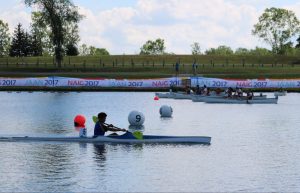
An unbiased or impartial investigator, particularly one with decision-making authority, is a fundamental principle of procedural fairness. Investigators must be impartial, free from any conflict of interest, and must approach matters under investigation with an “open mind”. There are two types of bias: actual bias, and perceived or reasonably apprehended bias.
Bias and conflict of interest are often used interchangeably. A conflict of interest occurs where a party is involved in multiple interests and serving one of those interests could involve simultaneously working against one of the other interests. The conflicting interest could involve any number of things including a financial interest, one’s reputation, a relationship, or access to knowledge of some sort. A person’s involvement in the vested interest raises a question of whether their actions, judgment or decision-making can be unbiased. The conflict is the situation; the bias is the actual or perceived prejudicial behaviour due to the situation. When such a situation occurs in the context of an investigation, the investigator should remove themselves and avoid any engagement in the matter.
For example, if the appointed investigator has a personal or business relationship with one of the parties, there could be the perception of bias in that the investigator may favour that party. As another example, where the investigator is being paid directly by the sport organization and the complaint is against the organization, there could be a perception that the investigator might favour the party paying the bill.To mitigate this risk of bias, the sport organization could pay another body that retains the investigator (e.g. the NIM or SDRCC), as opposed to directly paying the investigator. Where an investigator has publicly commented on the situation being investigated, or a similar situation, and distinctly favoured a particular perspective, an actual bias may exist and the investigator should excuse themselves from the investigation.
The investigator must maintain an open mind through all phases of the investigation. The SDRCC adjudicator in McInnisMcInnis v. Athletics Canada, 2020, para. 164 (see the case study below – McInnis v. Athletics Canada) summed up the investigator’s role highlighting the impartial and unbiased approach that must be maintained:
“The role of an investigator is always to conduct an impartial investigation of the facts giving rise to the complaint. It is not the investigator’s role to prove a case. Investigators should enter the investigation with an open mind of ‘what does the evidence show occurred’ and should not try to prove the allegations and tailor the evidence to support their ‘theory of the case’. The only theory is what the evidence shows. The investigator should not make up their mind until the last witness is interviewed and the last document reviewed. Of course, as the evidence develops there is nothing improper in gathering corroborating evidence as long as anything that does not support a finding is given equal consideration.”

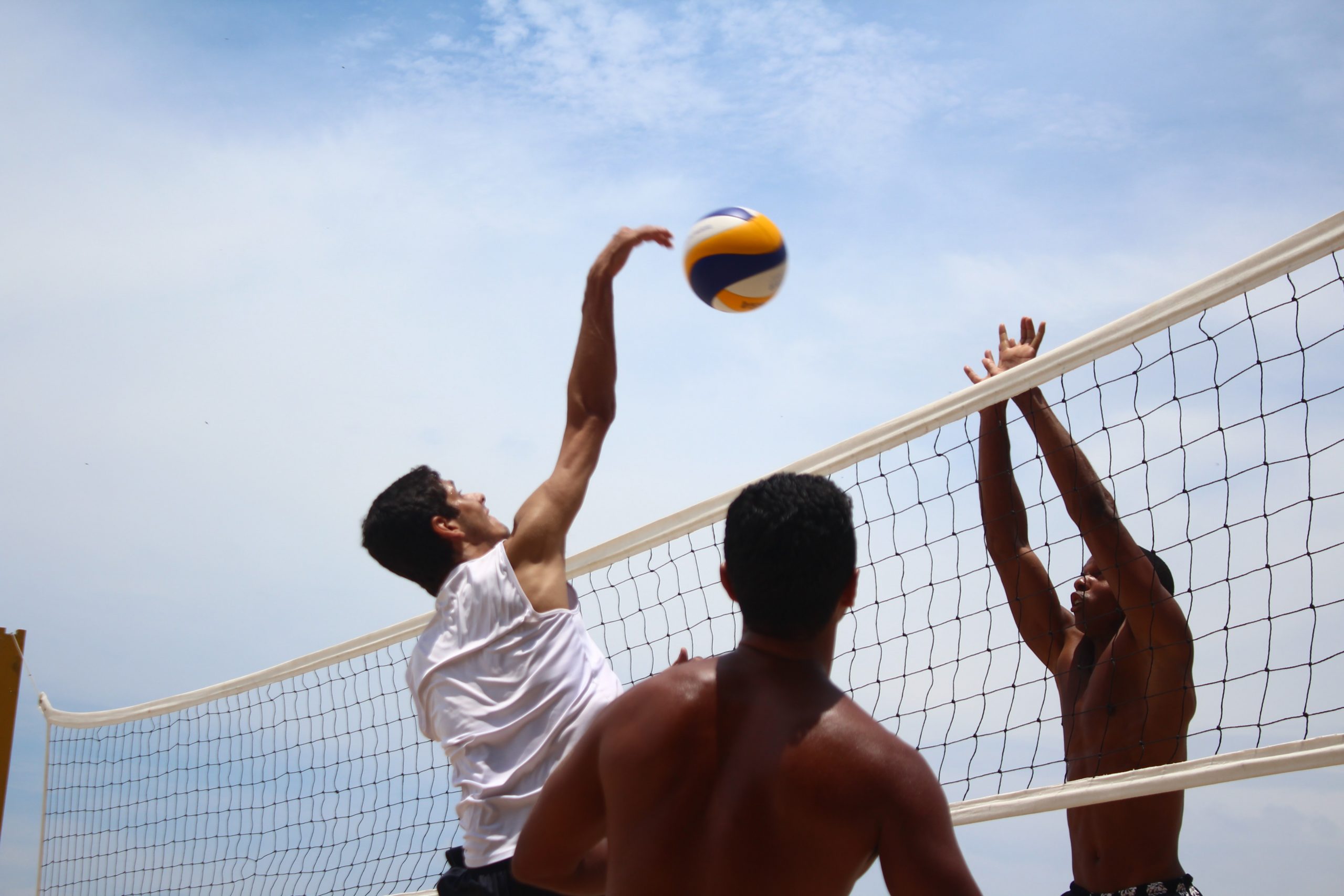
A national team coach is also the head coach of a university’s varsity team. A number of the coach’s varsity players have been members of the national team for several years and are vying for a spot on the current national team. The national team selection policy states that the national team coach and assistant coach will select a slate of players, which will then be reviewed and either confirmed or rejected by the National Team Committee, a committee made up of three members of the national sport organization.
An allegation of bias is made by a player who does not play on the varsity team but is seeking selection on the national team. The player is concerned that the national team coach will favour athletes from the varsity team.
Do you think this is an example of bias? Is it perceived bias or actual bias? What steps might you take to avoid bias?
The above scenario was the situation in the SDRCC case of Wilton v. Softball Canada.Wilton v. Softball Canada, 2004 Wilton was an elite softball athlete vying for selection to Canada’s national softball team competing at the 2004 Summer Olympic Games. Based on an assessment of performance statistics and players’ strengths and weaknesses, Wilton was selected as an alternate by the national team coach. The decision was then reviewed and supported by only the chair of Softball Canada’s National Team Committee (NTC).
The adjudicator found that the coach was not biased but that the second part of the selection process wherein the NTC as a whole, not just the chair of the committee, was to review and either confirm or reject the selected players. The adjudicator ordered a meeting of the full NTC, including the athlete representative, to hear a presentation by the head coach of his proposed team selection and rationale for his recommendations.
This scenario is an example of how a situation that may present a conflict of interest can be structured to avoid it. The adjudicator found no compelling evidence that the national team coach would jeopardize the chances for success at the Olympic Team just to have more university team members on the national team. However, it was acknowledged that a coach who is more familiar with one player over another would choose the known player over a lesser-known player. Having the NTC oversee and review the selection and, in fact, have ultimate authority to make the selection was intentionally set up to counter this, and other possibilities related to a perceived possible conflict of interest.

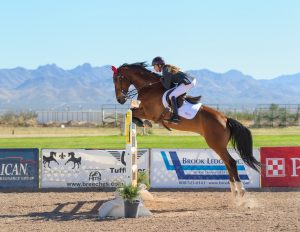
Two people are running for election to the position of president of a national sport organization. Person A is the current president and member of the Board of Directors of the organization. Person B is a member of the Board of Directors of an organization doing business with one of the provincial sport organization members of the national organization. The relationship could breach the national organization’s conflict of interest policy. Person B disputes any conflict. The current Board of Directors of the national organization has been asked to determine if Person B is eligible for election. Person A, the current president (and person running for re-election) recuses himself from the matter. The rest of the Board makes a determination that Person B is not eligible. In doing so, the Board ignores certain information provided to it by Person B.
Person B appeals the Board’s decision, alleging the Board is biased.
Is this perceived or actual bias and how might you avoid bias in this situation?
This above example was the situation in the SDRCC case of Sharara v. Table Tennis Canada.Sharara v. Table Tennis Canada, 2019
The adjudicator clarified that the party alleging bias has the onus of proving the bias and the threshold for finding a real or perceived bias is high. Person B argued that because the members of the Board currently work with Person A and Person A is the only person to benefit should the Board of Directors find Person B ineligible to stand for election, the Board is thus in a conflict of interest between their allegiance to their current colleague and their duties as board members. The adjudicator found that such a relationship would not result in a conflict of interest in every case (otherwise, it would mean that anytime one Board member declared a conflict and recused themselves, the rest of the Board would be in a conflict of interest) but, in this case, the relationship considered in light of the Board’s decision to ignore information brought to its attention by Person B, gives rise to a reasonable apprehension of bias on the part of the Board.
The right to legal counsel is not an absolute legal right. Nonetheless, it is prudent to allow the parties to designate someone to accompany them during the investigation, whether a friend, partner or legal counsel. During the investigation, this person does not speak on behalf of the party, but is there to lend moral support and assist the party in understanding the situation where necessary.SDRCC, 2018
In cases where a party or a witness is under the age of majority in their province or territory of residence, a parent or legal guardian should be informed prior to an interview being conducted and the minor may be accompanied by a responsible adult during the interview.
A complainant and respondent have a right to a reasoned decision following an investigation. As noted above, this post-investigative submission would be made by the NIM or sport organization based on the outcome of the investigation. To assist the post-investigation decision-maker a final investigative report should present the findings of the investigation in an impartial and comprehensive manner, documenting the steps taken, the evidence evaluated and ultimately provide the decision-maker with the facts necessary to decide the matter. The report is the means by which the investigator communicates how and why certain findings of fact were made during the investigation, and shows the parties what evidence was considered and that the investigation was done in a fair and transparent manner. Where decisions are based on the findings of the investigation, the parties should have the opportunity to review and respond to the report.
The UCCMS represents a legal regime for addressing maltreatment in sport. As discussed in Chapter 6, this legal regime is contractual, similar to other aspects of the sport system, such as anti-doping rules. This private contractual regime operates in parallel to domestic laws created by government, including Canadian criminal laws and provincial or territorial child protection laws.
The parallel operation of these private and public legal regimes creates interesting dynamics. Historically, sport organizations have sought autonomy to regulate and govern their sports and members free from government control and intervention. Canadian governments have largely accepted the self-regulating status of sport organizations by not making laws to specifically regulate sport organizations or aspects of sport, with some notable exceptions relating to combative sports and concussion safety.See, for example, See, for example, Ontario’s Rowan's Law (Concussion Safety), 2018 and Combative Sports Act, 2019(not yet in force). While this lack of legislative action can be explained, in part, on Canada’s federal structure and the division of legislative powers between the federal and provincial or territorial governments (see Chapter 6), it also represents governments’ unwillingness to regulate the private affairs of sport.
This does not mean that domestic federal and provincial or territorial laws do not apply to sport. To the contrary, many aspects of sport are regulated by laws of general application that regulate many areas of society, such as those relating to human rights, occupational health and safety, and employment standards. However, despite the general application of these laws to sport, there can still be a tendency to view sport as insulated from or an exception to aspects of these laws.
One example of sport’s insulation or exceptionalism in relation to domestic laws involves doping matters. Doping in sport is primarily regulated by private anti-doping rules. These anti-doping rules are created at the international level by the World Anti-Doping Agency (WADA), and adopted and enforced by international and national sport organizations, including the International Olympic Committee (IOC), international sport federations, and national anti-doping organizations. As private entities within the sport system, WADA and other anti-doping organizations are protective of their autonomy and control over the regulation of doping in sport.WADA is a private entity at law even though it is partially funded by national governments and includes representatives selected by national governments in its governance structure. This public-private aspect of WADA was proposed by the international sport community at the 1999 World Conference on Doping in Sport following a major doping scandal at the 1998 Tour de France where athletes and support personnel were arrested, detained and charged with criminal offences under French law. The prospect that doping in sport would become regulated by the criminal law and the parallel intervention of national governments into sport that would accompany such regulation was viewed as undesirable by the international sport community: see Pound (2002)
When national governments have attempted to use domestic laws to regulate doping in sport, the IOC and WADA have pushed back on this intervention. For example, during the 2006 Olympics in Turin, Italy, the IOC expressed concern about the application of Italian criminal laws to athletes caught doping and asked the Italian government to suspend its criminal laws for the duration of the Olympic Games. The Italian government refused, but a compromise was reached whereby the IOC was responsible for all doping control testing, and Italian authorities would only conduct searches of athlete residences if acting on “important information”.
 In the News:
In the News: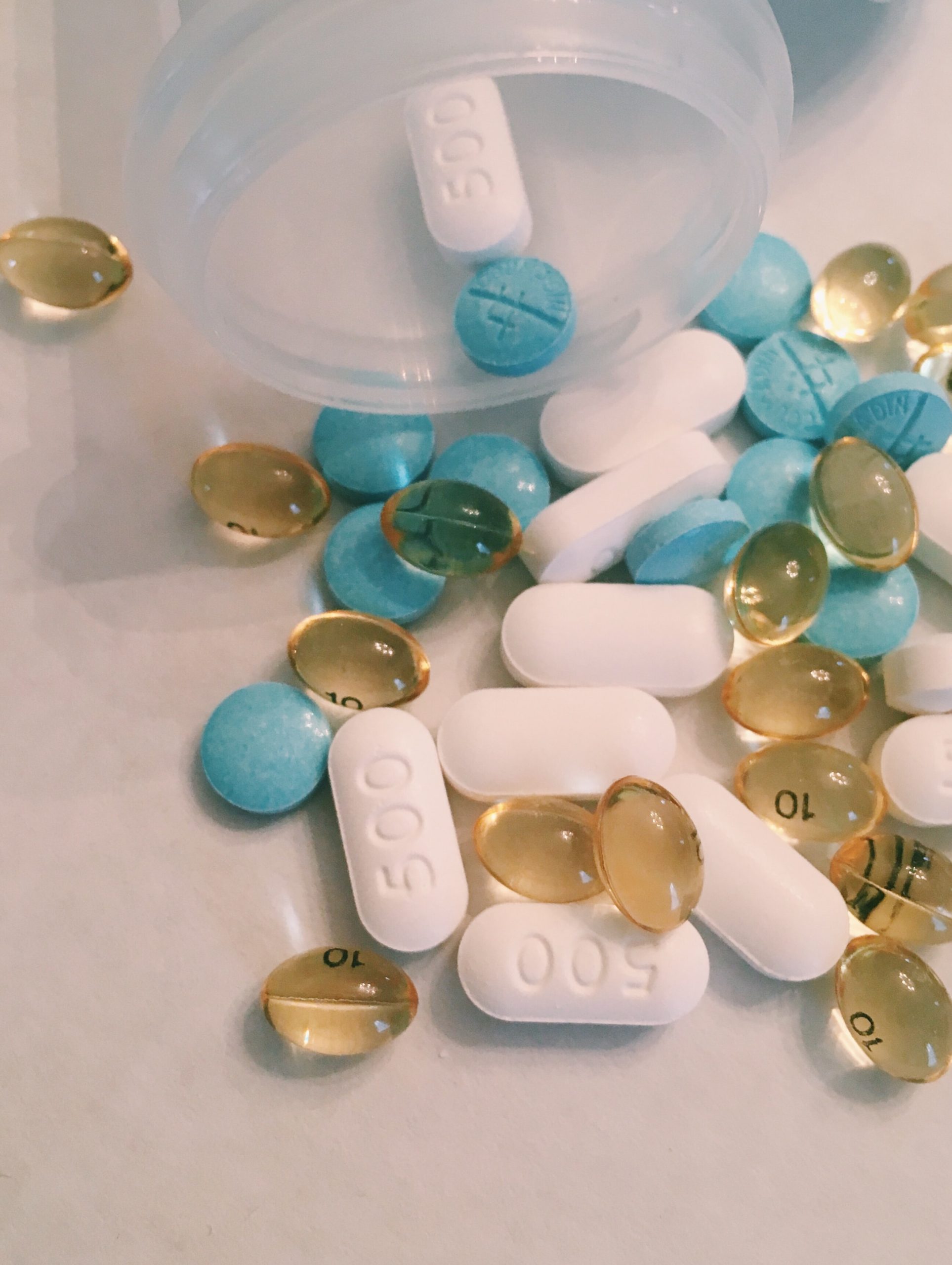
“Italy’s Strict Anti-Doping Laws Clash with Olympic Rules” by Tom Goldman, NPR All Things Considered, December 8, 2005 (audio and transcript).
In the lead-up to the 2006 Winter Olympics in Turin, Italy, a controversy arose regarding the outlook on athlete drug use, and how potential violators were to be punished. In Italy, athletes who took performance-enhancing drugs faced criminal prosecution and possibly even a jail sentence. The IOC’s stance was not as harsh, and officials were pushing to keep jail time out of the picture. When interviewed, some athletes agreed with the IOC, while others felt that by eliminating the Italian laws, the Olympic committee was losing its greatest doping deterrent. How might a compromise be reached in this sort of situation?
More recently, the United States passed the Rodchenkov Anti-Doping Act to, among other things, establish criminal penalties for those who participate in a commercial scheme to influence major international sport competitions through doping. Before the Act was passed and signed into law, then WADA President Witold Bańka issued a public statement cautioning the U.S. Senate about enacting a law that would operate in parallel to global anti-doping rules:
“WADA calls on the US Senate to consider widely held and legitimate concerns about the Rodchenkov Act. The bill in its current form could lead to overlapping laws in different jurisdictions that would compromise having a single set of rules for all athletes, all sports and all anti-doping organizations that are subject to the World Anti-Doping Code. This harmonization of rules is at the very core of the global anti-doping program.”WADA, 2020
Maltreatment in sport may be another example of this exceptionalism or autonomy from domestic laws. Although the types of maltreatment defined in the UCCMS are addressed in federal criminal laws (see Table 7.1 below) or provincial or territorial child protection legislation, the sport community has learned that these domestic laws are not sufficient to protect sport participants from maltreatment, and that parallel sport-specific rules (i.e., the UCCMS) are necessary. However, unlike anti-doping rules, the creation of the UCCMS should not deter the reporting and investigation of allegations of maltreatment under parallel domestic laws.
| UCCMS Provision | Criminal Code Provision |
| Psychological Maltreatment – Verbal Acts | Section 372(1): Harassing communications – everyone commits an offence who, without lawful excuse and with intent to harass a person, repeatedly communicates, or causes repeated communications to be made, with them by means of telecommunication. |
| Non-Assaultive Physical Acts | Section 423(1): Intimidation |
| Acts that Deny Attention or Support | Section 219: Criminal Negligence (if respondent owes duty to complainant) |
| Contact Behaviours | Section 265(1): Assault |
| Non-contact Behaviours | Section 219: Criminal Negligence |
| Sexual Maltreatment | Section 271: Sexual Assault Section 153(1): Sexual Exploitation Section 151: Sexual Interference |
| Neglect | Section 219: Criminal Negligence |
| Grooming | Section 153(1): Sexual Exploitation |
| Retaliation | Section 423(1): Intimidation |
The following two sections examine the duty to report allegations of maltreatment to police and child protection authorities, and the possibility of parallel investigations of alleged maltreatment conducted by sport authorities (NIM or ITP), the police, and child protection authorities.
When an allegation of maltreatment in sport is reported to the NIM, or surfaces during the course of an investigation conducted by the NIM or an ITP, then it is necessary to consider whether there is a duty to report that allegation to authorities outside of sport that might have jurisdiction under domestic laws. In Canada, these relevant authorities are the police (in the case of criminal laws) and child protection authorities (in the case of provincial or territorial child protection laws).
There is no explicit duty to report alleged maltreatment to police under Canada’s criminal laws.McLaren Global Sport Solutions, 2020 However, in certain circumstances, a failure to report maltreatment could constitute a criminal offence under Canadian law, especially if combined with other acts or omissions. For example, section 21 of Canada’s Criminal Code provides that a person is a party to a criminal offence if they do or omit to do anything for the purposes of aiding another person to commit the offence. Section 21 also provides that a person is a party to a criminal offence if they abet (i.e. assist or encourage) another person to commit the offence.
As a result, where maltreatment under the UCCMS is also a criminal offence (see Table 7.1 above), then a person who knows about the maltreatment and allows it to continue to happen through their actions or inactions, could be made a party to the offence. This provision is unlikely to apply to a NIM or ITP investigator who is investigating an allegation of maltreatment in sport as they are taking active steps to verify an allegation (as opposed to ignoring it) and may recommend preliminary measures that limit a respondent’s interactions with a complainant and other sport participants pending the outcome of an investigation. However, section 21 of the Criminal Code could apply to sport participants (e.g. coaches, officials, administrators) who suspect maltreatment and take no steps to address or report it.
Although there is no explicit duty to report allegations of maltreatment to the police under Canada’s criminal laws, there may be a duty to report allegations to police (or to recommend to a complainant that they should file a report with police) under a sport organization’s rules. For example, in the McInnis case described above, Athletics Canada’s rules placed a positive obligation on an investigator to advise complainants to report criminal allegations to the police. Similarly, section 2.2.7.1 of the UCCMS requires adult participants who know of or suspect psychological maltreatment, sexual maltreatment, physical maltreatment or neglect involving a minor participant to report that knowledge or suspicion to “law enforcement or child protection services (when applicable).” A person who fails to comply with this duty to report shall be subject to disciplinary action under the UCCMS.
Unfortunately, the reference to “or” and “when applicable” in the above provision creates some ambiguity. It is not clear whether the UCCMS requirement is intended to create a standalone duty to report maltreatment to police and child protection services where the knowledge or a suspicion of maltreatment against a minor exists, or whether the requirement under the UCCMS is only triggered where there is a separate duty to report under other law. If the former interpretation is correct, then it is unclear why the phrase “when applicable” is used. If the latter interpretation is correct, then the provision is still confusing because, as mentioned above, there is no duty to report maltreatment to the police under federal criminal laws. The more likely interpretation is that the phrase is meant to qualify the duty to report to child protection authorities.
As discussed below, the duty to report under provincial or territorial child protection legislation varies by jurisdiction (and in many jurisdictions may not apply to maltreatment in sport). Nevertheless, the reference to “or” suggests that an adult participant could avoid disciplinary action under the UCCMS if they reported maltreatment against a minor participant to either the police or child protection authorities. It is unclear why reporting to both the police and child protection authorities is not required.
It is our recommendation that this section of the UCCMS be revised to clarify its application. Ideally, the UCCMS duty to report should not be limited to instances where the reporting is required under other laws. The duty to report should apply regardless of whether it is required under federal criminal laws or provincial or territorial child protection laws. If the enforcement authority receiving the report is not able to act on the information because it is outside of their jurisdiction (e.g. not a criminal offence), then the reporting errs on the side of caution in favour of preventing and addressing maltreatment in sport.
Every province or territory in Canada has child protection legislation to safeguard children from abuse and neglect. Child protection authorities are given powers under this legislation to conduct investigations and make decisions about child protection and intervention. Despite this apparent breadth, aspects of the legislation and the work of child protection authorities are largely focused on preventing children from abuse and neglect in the home setting.
The existence of a legal duty to report alleged maltreatment to child protection authorities depends on where the alleged maltreatment took place due to different reporting requirements under provincial and territorial child protection legislation (see Table 7.2 below). In British Columbia, Alberta, Saskatchewan, Quebec, Newfoundland and Labrador, New Brunswick, Prince Edward Island, Yukon and Nunavut, a person’s duty to report maltreatment to child protection authorities is only triggered where the person suspects that the maltreatment is the result of an act or failure to act of a parent or legal guardian, and not third parties (such as athletes, coaches or administrators). As a result, if a person (such as a NIM or ITP investigator, or a sport administrator) has no reason to believe that the maltreatment of a child athlete is linked to an act or failure to act of a parent or guardian, then there would be no duty to report the alleged maltreatment to child protection authorities in these provinces and territories.
| P/T Jurisdiction | Legislation | Third Party’s Duty to Report Triggered by their Suspicion of an Act or Failure to Act Involving: |
| British Columbia | Child, Family and Community Service Act, RSBC 1996, c 46 | Parent |
| Alberta | Child, Youth and Family Enhancement Act, RSA 2000, c C-12 | Legal guardian |
| Saskatchewan | The Child and Family Services Act, SS 1989-90, c C-7.2 | Parent |
| Manitoba | The Child and Family Services Act, C.C.S.M. c. C80 | Person with care, custody, control, or charge of childThe duty to report under Manitoba’s legislation also triggered where there is a suspicion of harms against a child not associated with any particular person, such as where child is abused, in danger of abuse, or subject to aggression or sexual harassment. |
| Ontario | Child, Youth and Family Services Act, 2017, S.O. 2017, c. 14, Sched. 1 | Parent or person with charge of the child |
| Quebec | Youth Protection Act, CQLR c P-34.1 | Parent |
| New Brunswick | Family Services Act, SNB 1980, c F-2.2 | Not associated with any particular person |
| Newfoundland & Labrador | Child and Youth Care and Protection Act, SNL 2010, c C-12.2 | Parent |
| Nova Scotia | Children and Family Services Act, SNS 1990, c 5 | Parent |
| Prince Edward Island | Child Protection Act, RSPEI 1988, c C-5.1 | Parent |
| Yukon | Children’s Act, c 31 | Parent |
| Nunavut | Child and Family Services Act, S.N.W.T. 1997, c 13 | Parent |
In contrast, in Ontario and Manitoba, a person’s duty to report exists if they believe the alleged maltreatment arises from the act or failure to act of a parent or “other person who has care/charge of the child”. This broader description would likely capture coaches and administrators in circumstances where a child athlete is under their care, such as during training practices or at competitions. For example, in the case of R. v. Kates, an Ontario court held that the phrase “person having charge of the child” in Ontario’s Child and Family Services Act (as it was then known) was broad enough to include the employee of a day care who was alleged to have been abusive against children at the day care, thus triggering a duty to report for the operator of the day care who knew about the allegations.
Finally, New Brunswick’s legislation has the broadest duty to report and would apply in the sport context as it is triggered if a child experiences certain forms of maltreatment due to the actions or inactions of any person, and not only a parent, a guardian or a person who has care or charge of a child.
An investigation into sport maltreatment could be commenced by the police, a child protection authority, or both, following their receipt of a complaint or report of alleged maltreatment. However, what happens when such an investigation coincides with a parallel investigation being planned or conducted by the NIM or ITP? Can the different investigations proceed in parallel or should the NIM or ITP investigation be deferred pending the outcome of the police or child protection authority investigation? Is one investigation more important or time-sensitive than the other? Should parallel investigations be avoided to ensure that one investigation doesn’t interfere or conflict with the other?
Some insight into these questions can be obtained from international comparators. In the United Kingdom, it is recommended that investigations into sport maltreatment conducted by sport organizations (or ITPs retained by sport organizations) be deferred until the completion of investigations conducted by statutory enforcement authorities, such as the police and child protection authorities.Chamberlain et al., n.d. In contrast, in the United States, an investigation into sport maltreatment conducted by the Center for SafeSport is not automatically impacted by parallel criminal investigations. Instead, the Center may contact the criminal law enforcement agency to discuss the status of their investigation and, at request of the agency, the Center may delay its investigation until the evidence-gathering phase of the criminal investigation has ended.U.S. Centre for SafeSport, 2021 Importantly, the Center does not propose to defer its investigation pending the outcome of criminal charges or proceedings.
It is our recommendation that the NIM (and ITPs) follow the U.S. SafeSport model when investigating alleged maltreatment while parallel investigations conducted by the police or child protection authorities are underway. This recommendation is based on the following three considerations:
Investigations of alleged maltreatment are likely to involve verbal recollections of events from the complainant, respondent and witnesses that may fade over time. To preserve the freshness of this evidence in order to make findings of fact and fairly assess credibility, it is important that an investigation not be unduly delayed.
In the sport maltreatment context, both the NIM/ITP and other investigative bodies (police, child protection authority) will bring a certain type of expertise to an investigation. One investigator may be able to obtain information or have particular insight regarding the information they have gathered that another investigator may not, and vice versa. As a result, subject to applicable privacy lawsInformation obtained by child protection authorities during an investigation may be subject to confidentiality restrictions under provincial or territorial child protection legislation or privacy legislation. and constitutional limits,Generally speaking, police require court orders (e.g. search warrants or production orders) in order to search or seize someone’s private property to avoid violating section 8 of the Charter of Rights and Freedoms (which protects against unreasonable search or seizure). Physical or documentary evidence obtained through these court orders can be restricted to use in criminal investigations and proceedings, and, if so, could not be used in parallel investigations conducted by other bodies until the information becomes public in a court proceeding. parallel investigations can allow investigative bodies to share, in a timely manner, the information that they receive to assist each other’s investigation. For example, the U.S. Center for SafeSport will ask a criminal law enforcement agency whether any information obtained by that agency can be disclosed to the Center to assist with the Center’s investigation, and the Center may, in turn, provide some or all of its case information, documentation or evidence to the law enforcement agency.U.S. Centre for SafeSport, 2021
This final consideration relates to a parallel criminal investigation. The purpose of a criminal investigation is to gather evidence to determine whether a criminal offence has been committed. In order for the investigation to lead to a criminal charge and subsequent conviction in court, the evidence gathered must prove that a person committed the criminal offence beyond a reasonable doubt. This threshold is known as a standard of proof. In contrast, in the context of the UCCMS process, the standard of proof will be much lower. The threshold is whether it is more likely than not that a respondent violated the UCCMS (known as a balance of probabilities). Figure 7.3 below provides a visual representation of these standards of proof.
The following figure displays the standards of a “balance of probabilities” and “beyond a reasonable doubt” as partially filled glasses of water. The water represents the evidence supporting the existence of a fact and the unfilled portion represents doubt about the existence of the fact. This doubt can arise due to gaps in the supporting evidence or contradictory evidence.

These different standards of proof impact how an investigation may be conducted since the investigator is considering what threshold needs to be met to prove that a particular fact occurred. For example, while a NIM or ITP investigator may be satisfied that maltreatment occurred based on interviews with a complainant, a respondent and witnesses, a criminal investigator may require supporting documentary or physical evidence before recommending that criminal charges be pursued. This difference in the investigative approach means that there may not be complete overlap between the investigations conducted by the NIM/ITP and the police and that both investigations can proceed in parallel.

The following audio recording is a firsthand dialogue of a person falsely accused of sexual harassment. As you listen, follow along as pieces of the investigation unfold and as the implications of the allegations take hold.
Listen to “The Accusation ” by The Daily on Apple Podcasts (approx. 52 minutes). Find additional material, including a link to the print version in the New York Times, on the episode website.
The difference in standards of proof also means that, if there is a desire to sequence the investigations, as opposed to having them operate in parallel, then the NIM/ITP investigation should not be deferred beyond the evidence-gathering phase of the criminal investigation. Waiting for the outcome of the criminal process (investigation, laying of charges, trial) will not assist the NIM/ITP investigation (or later stages of the UCCMS process) as a finding that no criminal offence was committed (whether following an investigation or trial) is not an indicator that maltreatment in violation of the UCCMS did not occur. In other words, the criminal process does not dictate how the UCCMS process should unfold in terms of findings of maltreatment or consequences for maltreatment.
 Case Study:
Case Study:

“Athletics Canada Upholds Lifetime Ban of Ottawa Track Coach” CBC News, July 9, 2020.
As you read through this case, consider the process used to investigate a complaint of harassment made against a coach. The investigation process itself was seriously flawed and the investigator showed bias in the writing of the investigative report. Can you identify the flaws? Do you think the decision was fair?
The Facts
Andy McInnis was a successful coach with the Ottawa Lions Track & Field Club (“OLTFC”). A complaint involving harassment and sexual harassment was filed with the OLTFC against McInnis. The OLTFC hired an investigator to review the complaint. Concerns were subsequently brought forward that the OLTFC was not conducting an impartial investigation and a further complaint of harassment was filed against McInnis by another party (“Eliza”). Athletics Canada assumed responsibility for investigating this second complaint of harassment, appointed an investigator and suspended the OLTFC investigation. The OLTFC investigation was subsequently re-commenced, running in parallel to the one authorized by Athletics Canada.
At the end of the investigation, the Athletics Canada Investigator declared two of the complaints brought by Eliza to be founded and seven of the complaints brought by the original complainant to the OLTFC to be founded. The OLTFC Investigator of the original complaint dismissed all but one of the original complaints as being unfounded on the basis of a lack of evidence. Based on the findings and recommendations of the Athletics Canada Investigator, an Athletics Canada Commissioner rendered a lifetime suspension of McInnis from Athletics Canada.
The Issues
McInnis appealed the Athletics Canada decision. The appeal raised two critical questions:
On the question of procedural fairness, McInnis argued that he had not received sufficient information to fully understand the case to be met and to make a full and accurate response, and that the person authorized to make the final decision in the case (the Athletics Canada Commissioner) did not do so, wrongly deferring to the recommendations of the Investigator. Specifically, McInnis maintained that:
He had not received details of the specific complaints, including the specific policy sections he was alleged to have breached, and detailed information as required under Athletics Canada’s rules and required by the principles of procedural fairness, all of which were essential for him to make a full response;
He was not provided with all of the evidence, including recordings of interviews with the witnesses and complainants; he received only a copy of paraphrased allegations, many of which were out of context;
He was not given an opportunity to make his case – either as part of the investigation or as part of a hearing, either in-person or by conference call; and
By simply accepting the outcome and recommendations contained in the Investigator’s report, the Athletics Canada Commissioner wrongly delegated his authority to make the final decision to the Investigator and, in so doing, did not fully and fairly consider McInnis’s case in accordance with the principles of fairness but deferred to the Investigator.
On the question of bias, McInnis argued that the Investigator’s report gave rise to a reasonable apprehension of bias on the part of the Investigator that coloured the Commissioner’s final decision. Specifically, he maintained that:
The Decision
The SDRCC Adjudicator found that McInnis had been denied procedural fairness during the investigation and decision-making phases of the process. He emphasized that while Athletics Canada is entitled to some deference in selecting details of the investigatory process, the serious impact a decision could have on McInnis’s ability to continue with his livelihood demanded a significant degree of procedural protection and a fair process.
The SDRCC Adjudicator found that the right to procedural fairness was not as broad as that argued by McInnis but Athletics Canada failed to provide him with a fair process. The Adjudicator pointed to several errors:

The lack of time that McInnis had to review and respond to the Investigator’s report (only 10 days) was unreasonable given the seriousness of the matter and the repercussions of any decision based on the investigative report;
While the ultimate decision-maker (in this case the Commissioner of Athletics Canada) had discretion to determine the nature and format of any hearing, such determination must be consistent with the duty of fairness owed to McInnis. In this case, more than the submission of a written statement was necessary. McInnis should have been given the opportunity to test the evidence against him and to question the complaints that were being relied upon to determine his guilt or innocence.
However, the SDRCC Adjudicator rejected a number of the procedural protections sought by McInnis. For example, the Adjudicator noted that an investigation is different than a hearing and what is owed to a respondent in an investigation from a procedural perspective is less formal. The duty of an investigator is to put to the respondent any and all allegations on which the investigator will make findings. Prior to any interview with the investigator, the respondent is not owed details of the allegations relating to the complaints or full reports.
The Adjudicator also concluded that the investigation in this case was conducted in a biased manner. He raised the following points as supporting a finding of actual bias.
The use of language in the report was often inflammatory, highly editorial and prejudicial serving no purpose other than to infer McInnis’s guilt;
Allegations against McInnis were conflated with those against a third party, treating them as one and the same. Allegations against the third party were separate, not part of the complaint and should not have been brought into the investigation. They properly should have been part of another separate investigation conducted by another investigator;
Bringing in commentary and issues outside the scope of the investigation that had the effect of colouring the investigation;
Making unsupported findings and completely ignoring facts that contradicted McInnis’s guilt; and
Because the final decision made by the Commissioner of Athletics Canada was based solely on the investigative report and did not consider at all the OLTCF’s parallel investigative report that produced contrary findings, the bias of the investigator’s findings and conclusions resulted in a biased post-investigation decision.
As part of his judgment, the SDRCC Adjudicator included a non-exhaustive list of elements characteristic of a good and procedurally fair investigation, including:McInnis v. Athletics Canada, 2020, para. 165
Further Research
A concern raised with the US SafeSportUnited States Centre for Safe Sport, n.d. model is that it is complaint-based and investigations are limited to the parameters of the complaint. There is often no opportunity to extend an investigation to include aspects of organizational culture and practice. Having regard to abuse-based situations that were allowed to persist for years and even decades (such as Bertrand Charest at Alpine Canada, Larry Nassar at U.S.A. Gymnastics, and Alberto Salazar at the Nike Oregon Project, to name a few), investigations must go beyond the actions of individual respondents and include what goes on within a sport organization to allow situations to fester and go unanswered, and even single instances of abuse to occur.
Can the UCCMS and the NIM be used to address this broader perspective? Is there a better approach? Could the Philadelphia Case Review Model referred to in “In The News” box noted earlier in this chapter be used or modified for such use?
Key Terms
An interactive H5P element has been excluded from this version of the text. You can view it online here:
https://ecampusontario.pressbooks.pub/safesport/?p=178#h5p-17
Suggested Assignments
Image Descriptions
Figure 7.1 This graphic demonstrates the pathway of a complaint in the investigative phase. It begins with the intake of a complaint, the formal complaint of maltreatment, and then goes to the National Independent Mechanism (NIM) preliminary assessment. Next comes the investigation, either by the NIM or an Independent Third Party (ITP). Finally, the investigation decision & report is made by either the NIM or the sport organization. [return to text]
Figure 7.3 This graphic illustrates the standards of proof thresholds. On the left, little to no evidence is demonstrated by a rectangular shape shaded in slightly, with the caption “being less than 10% sure that a fact occurred.” The middle rectangle with the balance of probabilities is half shaded in and captioned “being at least 51% sure that a fact occurred.” The last rectangle showing beyond a reasonable doubt is almost fully shaded in, and captioned “being more than 90% sure that a fact occurred.” [return to text]
Sources
Canadian Safe Sport Program. (2020). Sport Information Resource Centre: Universal Code of Conduct to Prevent and Address Maltreatment in Sport (UCCMS),(5)1, 1-16. https://sirc.ca/wp-content/uploads/2020/01/UCCMS-v5.1-FINAL-Eng.pdf
CBC News. (2020, June 9). Athletics Canada upholds lifetime ban of Ottawa track coach. Retrieved December 21, 2021, from https://www.cbc.ca/news/canada/ottawa/andy-mcinnis-ban-1.5604921
Chamberlain, C., Quinlan, C., & Wernick, S. (n.d.). Practical guide to undertaking safeguarding investigations in sport. Sport Resolutions. http://www.sportresolutions.com/images/uploads/files/2021_NSP_Investigation_Guide_1.pdf
Child and Family Services Act, S.N.W.T. 1997, c 13
Child and Youth Care and Protection Act, SNL 2010, c C-12.2
Child Protection Act, RSPEI 1988, c C-5.1
Child, Family and Community Service Act, RSBC 1996, c 46
Child, Youth and Family Enhancement Act, RSA 2000, c C-12
Child, Youth and Family Services Act, 2017, S.O. 2017, c. 14, Sched. 1
Children and Family Services Act, SNS 1990, c 5
Children’s Act, c 31
Combative Sports Act, 2019, S.O. 2019, c. 7, Sched. 9
Family Services Act, SNB 1980, c F-2.2
Goldman, T. (2005, December 8). Italy’s strict anti-doping laws clash with Olympic rules. National Public Radio. Retrieved December 5, 2021, from https://www.npr.org/templates/story/story.php?storyId=5044688
Legislative Assembly of Ontario. (2018). An act to enact Rowan’s Law (concussion safety), 2018 and to amend the Education Act. https://www.ola.org/sites/default/files/node-files/bill/document/pdf/2018/2018-03/bill—text-41-2-en-b193ra_e.pdf
McInnis v. Athletics Canada, SDRCC (2020), No. 19-0401
McLaren Global Sport Solutions. (2020). Aiming high: Independent approaches to administer The Universal Code of Conduct to Prevent and Address Maltreatment in Sport in Canada, final report. http://sirc.ca/wp-content/uploads/2020/12/MGSS-Report-on-Independent-Approaches-December-2020.pdf
Paterson v. Skate Canada, (2004), 373 A.R. 81 (QB.)
Pound, R. (2002). The World Anti-Doping Agency: An experiment in international law. International Sports Law Review, 2.
Prime, K. (Producer). (2020, July 26). The Sunday read: ‘The accusation’ [Audio podcast episode]. In The Daily. The New York Times Company. https://podcasts.apple.com/ca/podcast/the-daily/id1200361736?i=1000486163535
R. v. Kates, Ontario District Court – York Judicial District, [1987] O.J. No. 2032.
Rowan’s Law (Concussion Safety), 2018, S.O. 2018, c. 1: https://www.ontario.ca/laws/statute/18r01
Sharara v. Table Tennis Canada, SDRCC (2019), No. 19-0376.
Sport Dispute Resolution Centre of Canada (SDRCC). (2018). Investigation unit: Investigation guidelines. http://www.crdsc-sdrcc.ca/eng/documents/Investigations-Investigation_Guidelines_EN_Final.pdf
Sport Law. (n.d.) Maintaining ‘fairness’ in investigations and hearings. Retrieved December 21, 2021, from https://sportlaw.ca/maintaining-fairness-in-investigations-and-hearings/
Sport Resolutions. (n.d.). https://www.sportresolutions.com
The Child and Family Services Act, C.C.S.M. c. C80The Child and Family Services Act, SS 1989-90, c C-7.2
U. S. Center for SafeSport. (n.d.). SafeSport code. Retrieved December 5, 2021, from https://uscenterforsafesport.org/response-and-resolution/safesport-code/
World Anti-Doping Agency (WADA). (n.d.). Retrieved December 21, 2021, from https://www.wada-ama.org
WADA. (2001, May). Coordinating investigations and sharing anti-doping information and evidence. https://www.wada-ama.org/sites/default/files/resources/files/WADA_Investigations_Guidelines_May2011_EN.pdf
WADA. (2020, March 12). WADA calls on US Senate to consider widely held concerns about Rodchenkov Act. Retrieved December 5, 2021, from https://www.wada-ama.org/en/media/news/2020-03/wada-calls-on-us-senate-to-consider-widely-held-concerns-about-rodchenkov-act
Ward, L. & Strashin, J. (2019, February 10). Sex offences against minors: Investigation reveals more than 200 Canadian coaches convicted in last 20 years. CBC News. Retrieved December 21, 2021, from https://www.cbc.ca/sports/amateur-sports-coaches-sexual-offences-minors-1.5006609
Wilton v. Softball Canada, SDRCC (2004), No. 04-0015.
Women’s Law Project. (2017, August 3).Ottawa police latest to adopt the “Philadelphia Case Review Model” for reviewing unfounded rape cases. Retrieved December 5, 2021, from www.womenslawproject.org/2017/08/03/ottawa-police-latest-to-adopt-the-philadelphia-case-review-model-for-reviewing-unfounded-rape-cases/
Youth Protection Act, CQLR c P-34.1
8
Hilary Findlay
Marcus Mazzucco
Sports Law
Dispute Resolution in Sport
Sport Arbitration
When you have completed this chapter, you will be able to:
L01 Describe the stage at which disputes may arise in the sport maltreatment context;
L02 Describe arbitration and explain how it is different than litigation in courts;
L03 Explain the principles of impartiality and independence in the context of arbitration;
L04 Explain the importance of having diverse and appropriately trained arbitrators to resolve sport maltreatment disputes in a fair and effective manner; and
L05 Explain the value of a system of precedent in arbitration.
This chapter examines the use of arbitration to resolve disputes arising from investigations into alleged violations of the Universal Code of Conduct to Prevent and Address Maltreatment in Sport. Key issues related to the institutional aspects of arbitration will be considered, including the importance of having impartial, diverse and appropriately trained adjudicators, as well as the value of a system of precedent for arbitration decisions. Existing sport arbitration institutions, including the Court of Arbitration for Sport and the Sport Dispute Resolution Centre of Canada, will be used as examples to discuss these issues.
An interactive H5P element has been excluded from this version of the text. You can view it online here:
https://ecampusontario.pressbooks.pub/safesport/?p=191#h5p-18
Once an investigation has concluded and a decision has been made about a violation of the Universal Code of Conduct to Prevent and Address Maltreatment in Sport (UCCMS), a dispute about that post-investigation decision may arise.Disputes may also arise from temporary or provisional measures issued against a respondent during an investigation or prior to a post-investigation decision. A respondent may wish to challenge the issuance of these provisional or temporary measures Depending on who conducted the investigation, who made the decision, and the substance of the decision, the nature of the dispute and the parties involved may differ. The parties may involve the complainant,In this chapter, “complainant” refers to the individual who reports or files a complaint about another person’s alleged violation of the UCCMS, including an individual who is the subject of alleged maltreatment the respondent,In this chapter, “respondent” refers to individual who is alleged to have violated the UCCMS the relevant sport organization, and the decision-maker whose ruling on a violation or sanction under the UCCMS is being challenged. In many cases, the decision-maker will be the national independent mechanism (NIM). This chapter examines the availability of private arbitration to resolve disputes in this post-investigation context.Other types of dispute resolution may be incorporated into the investigation stage of the process, including resolution facilitation and mediation

Arbitration is a process whereby parties refer their dispute to a mutually acceptable, knowledgeable, independent person (an arbitrator) to determine a resolution. The parties usually agree beforehand to be bound by the arbitrator’s decision. Further, by agreeing to resolve a dispute by arbitration, the parties generally forego the opportunity to resolve their dispute through litigation in court.
Arbitration is commonly used to resolve disputes in sport as is evident by the creation of sport-specific arbitration institutions at the international and national levels, such as the international Court of Arbitration for Sport (CAS) and the Sport Dispute Resolution Centre of Canada (SDRCC). In the maltreatment in sport context, arbitration is used to resolve disputes arising from investigations, as seen in the United States (U.S.) with the Judicial Arbitration Management Service, in the United Kingdom (U.K.) with the Sport Resolutions’ National Safeguarding Panel, and in Canada with the SDRCC’s Safeguarding Tribunal.

What is arbitration and how does it work? Watch this short video on “Arbitration Agreement Explained by Hesham Elrafei.
Arbitration differs from an internal appeal mechanism that may exist within a sport organization as the resolution of the dispute is handled by a third party that is external to the sport organization. Arbitration also differs from traditional litigation in courts or tribunals as it occurs in a private context and is consent-based. It is consent-based because both parties have agreed, either prior to a dispute or after a dispute has arisen, to resolve their conflict through arbitration. In contrast, litigation tends to be a more adversarial process whereby one party (a plaintiff) seeks to enforce certain legal rights against another party (a defendant), without any prior agreement on that method of dispute resolution. These distinctions are important to understand because in the Canadian sport context, arbitration is considered to be the most effective dispute resolution process.
The consent of the parties to resolve a dispute by arbitration is reflected in an arbitration agreement.
An arbitration agreement can be a standalone agreement entered into by parties after a dispute has arisen, or it can be part of a contract that establishes a legal relationship between two parties prior to any dispute, such as an employment or commercial agreement. For example, in the sport context, an agreement to arbitrate can be incorporated into the policies of the sport organization with which sport participants agree to comply as a condition of participating in the sport or incorporated into a national team agreement between a national sport organization and an athlete (see below for an example of an arbitration clause). However, as previously discussed in Chapter 6 the concept of consent in the sport context can be criticized for being forced or coerced since participants are faced with the option of agreeing to the sport organization’s rules (including those governing the arbitration of disputes) or not participating in the sport.

Example of an Arbitration Clause in a Sport Organization Policy or Contract
“Any dispute arising from or related to this [policy or contract] will be submitted exclusively to the dispute resolution secretariat of the Sport Dispute Resolution Centre of Canada and resolved definitively in accordance with the Canadian Sport Dispute Resolution Code, as amended from time to time”.SDRCC, 2006
The remainder of this chapter explores three key issues relating to the institutional“Institutional” refers to the structure and operations of an organization that provides arbitration services aspects of arbitration in the sport maltreatment context, as set out below:
An individual has a fundamental right to an independent and impartial adjudicator. This right is protected in provincial and territorial arbitration legislation that governs private arbitration proceedings in Canada.For example, see section 11 of Ontario’s Arbitration Act, 1991 Independence and impartiality are necessary to ensure public confidence in a dispute resolution system, and are consistent with the guiding principles of the UCCMS that call for a fair and independently-administered process.
The principle of impartiality requires an arbitrator to decide a dispute with an objective and open mind, free from any actual or perceived bias. Actual bias exists where an arbitrator is predisposed to decide a matter in one particular way over another and may arise where the arbitrator has a direct material interest in the outcome or has publicly favoured one outcome over another. For example, in a dispute about the outcome of a soccer match where bad faith or poor refereeing is alleged, an arbitrator would have a direct material interest in the outcome if they had placed a bet on the winner of the match. In contrast, perceived bias may exist where an informed person holds a reasonable suspicion that the arbitrator is or may be biased and cannot decide a matter fairly. This suspicion of bias may be based on contextual factors such as a personal, financial, or other relationship between the arbitrator and individuals participating in the arbitration process. For example, in a dispute involving a sport organization, if the arbitrator is on the board of directors of the organization, then that relationship may lead to a suspicion that the arbitrator is going to decide the dispute unfairly by favouring the sport organization.
The principle of independence refers to an arbitrator’s freedom from the control or influence of others and it is related to the principle of impartiality as independence avoids the appearance of bias. The independence of an arbitrator has several aspects. First, an arbitrator must be independent from the parties to a dispute, including their representatives, and any witnesses in the proceeding. As noted above, the parties to a dispute in the maltreatment context may include the complainant, the respondent, the relevant sport organization and the NIM. While these parties may be involved in selecting an arbitrator to resolve their dispute, that arbitrator cannot have any personal, financial, or business ties to the parties that may jeopardize the arbitrator’s independence and ability to decide matters free from a conflict of interest.
Second, where arbitration services are provided by an institution, such as CAS or SDRCC, the arbitrators must be independent of the institution meaning that they must have the freedom to hear the matter objectively and make a fair decision without fear of losing their tenure and without administrative controls that might interfere with their exercise of discretion. A lack of administrative control would exist where the arbitrator is required to share a draft of their decision with an officer or director of the arbitration institution for the latter’s input before finalizing the decision. Third, where an arbitration institution is involved, the institution must be sufficiently independent from the parties likely to require arbitration services. This final aspect of independence led to structural changes at CAS. From 1984 to 1994, the International Olympic Committee (IOC) administered CAS; however, due to concerns that decisions of CAS could be challenged on the basis that CAS lacked independence where the IOC was a party to a dispute, an independent body – the International Council of Arbitration in Sport (ICAS) – was created to administer CAS.
In the sport maltreatment context, various safeguards are needed to ensure arbitrator independence and impartiality. For the most part, these safeguards are successfully met by existing sport arbitration institutions, as seen from the examples in Table 8.1 below.
| Safeguard | Description/Rationale | Examples |
| Private, external administration | To ensure that arbitration services are provided by an entity that is separate from the parties requiring arbitration services | SDRCC– not part of the Canadian government or sport organizations; overseen by a board of directors appointed by federal Minister based on guidelines established in consultation with sport sector.Physical Activity and Sport Act, 2003 |
| U.S. SafeSport – arbitration services provided by a private company, Judicial Arbitration and Mediation Services (JAMS), that is separate from Center for SafeSport, the United States Olympic and Paralympic Committee (USOPC), and national sport governing bodies (NGBs).U.S. Center for Safe Sport, 2021 | ||
| U.K. National Safeguarding Panel (NSP)– administered by an independent, not-for-profit company, Sport Resolutions, that is separate from NGBs.Sport Resolutions, 2021a | ||
| Arbitrator independence from arbitration institution | To ensure arbitrators have security of tenure and independent administrative control | SDRCC– arbitrators have a statutory mandate to be independent from SDRCC;Physical Activity and Sport Act, 2003 arbitrators are not employees of SDRCC;SDRCC (2015a), Bylaw no. 1, as amended, http://www.crdsc-sdrcc.ca/eng/documents/General_By-Law_No_1-2015_Board_Approved_ENG.pdf SDRCC oversight focused on ensuring that arbitrators comply with code of conduct, and not reviewing, changing or overturning the decisions rendered by arbitrators.SDRCC, 2018a U.S. SafeSport – arbitrators are “neutrals” of JAMS, not employees.JAMS, n.d.a |
| U.K. NSP – arbitrators are appointed for 3-year terms; only have contractual accountability to the Chair of Sport Resolutions that is separate from their adjudicative duties.Sport Resolutions, 2021b | ||
| Arbitrator selection | To ensure a fair process to select arbitrators to hear a specific dispute that either involves the agreement of the parties and/or selection by the arbitration institution | SDRCC – parties to agree on arbitrator within certain timelines failing which the SDRCC selects the arbitrator from a roster.SDRCC, 2021a |
| U.S. SafeSport – arbitrator selected by JAMS based on short-list that includes input from parties.U.S. Center for Safe Sport, 2021 | ||
| U.K. NSP – arbitrator selected by President of NSP.Sport Resolutions, 2021c | ||
| Conflict of interest declaration | To ensure arbitrators declare any actual or perceived conflict of interest that may impact their ability to decide a matter impartially | SDRCC – arbitrator must immediately disclose any interest or relationship that may adversely affect their independence or impartiality.SDRCC (2014), Code of Conduct for SDRCC Mediators and Arbitrators, http://www.crdsc-sdrcc.ca/eng/documents/ROSTER_CODE_OF_CONDUCT_adopted_27-Sep-2013_EN.pdf |
| U.S. SafeSport – arbitrator selected must disclose any circumstance that could impact impartiality or independence, including bias, financial interest, personal interest.U.S Center for Safe Sport, 2021 | ||
| U.K. NSP – arbitrators must disclose anything that might be perceived as a conflict of interest.Sport Resolutions, 2020a | ||
| Challenge to appointment | To enable parties to challenge an arbitrator’s appointment if they believe an actual or perceived conflict of interest exists | SDRCC – party may challenge arbitrator on grounds of conflict of interest or reasonable apprehension of bias.Existing source: SDRCC (2021a), Procedural Code, http://www.crdsc-sdrcc.ca/eng/documents/Code_SDRCC_2021_-_Final_EN.pdf |
| U.S. SafeSport – parties can file objection to arbitrator’s continued service based on conflict of interest concerns.U.S. Center for Safe Sport, 2021 | ||
| U.K. NSP – party may challenge selection of arbitrator due to doubts about independence or impartiality.Sport Resolutions, 2021c |
Despite the above safeguards, there may be unique considerations for ensuring arbitrator independence and impartiality in the Canadian sport maltreatment context. The first issue relates to the dual function that an institution, such as the NIM, would have if it provides investigative and arbitration services. In the U.S. SafeSport model, this dual function is avoided by having the Center provide investigation services, and a separate and independent entity, JAMS, provide arbitration services. In contrast, the U.K., Sport Resolutions provides both investigative and arbitration services.
The SDRCC has been selected by the federal government to act as the NIM and will provide both investigative and arbitration services relating to participants of federally funded sport organizations. It is absolutely essential that the SDRCC’s arbitration services be separate from any investigative function to ensure independence and impartiality. This may require organizational structures, information technology measures, and human resource policies to ensure an adequate division of functions. For example, when the SDRCC created a pilot project involving an Investigation Unit and the Safeguarding Tribunal, the SDRCC established a policy to ensure a division between these bodies.SDRCC, 2018b Only mediators from the SDRCC roster could be members of the Investigation Unit.SDRCC, 2018b Conversely, arbitrators wishing to become members of the Investigation Unit would have to resign as an arbitrator before commencing any investigative role.SDRCC, 2018b A similar policy will be needed once SDRCC, as the NIM, creates a new Maltreatment Tribunal (or expands the Safeguarding Tribunal) to provide arbitration services to resolve disputes involving post-investigation decisions made by the NIM.
It is not yet known who would provide investigative and arbitration services if the UCCMS is implemented at the provincial, territorial, and local levels of sport. It is possible that SDRCC will outsource investigative and arbitration services to separate, local entities, such as provincial alternative dispute resolution institutes for arbitration services. If this occurs, then the above dual-function concerns would not be applicable.
A second issue concerning independence and impartiality that is relevant to the Canadian sport maltreatment context relates to the selection of arbitrators for hearings. As noted in Table 8.1 above, the selection of an arbitrator to preside over a matter can involve the agreement of the parties. However, where a roster of arbitrators is established specifically to resolve disputes concerning the UCCMS, there is a risk that the parties’ selection of arbitrators may favour a party that repeatedly appears before those arbitrators. For example, the NIM is likely to be a frequent party to arbitration hearings conducted by the SDRCC, and therefore may have an advantage of knowing which arbitrators are more likely to decide in the NIM’s favour. The NIM’s preferred arbitrator may be accepted by the other party to the dispute due to that other party’s unfamiliarity with the arbitration process or a power imbalance that leads the other party to accept the NIM’s choice of arbitrator.
In the context of CAS, this issue has been identified as potentially creating an unfair arbitral process.Lenskyj, 2018 The unfairness arises because the party whose preferred arbitrator is selected will have an advantage of knowing the arbitrator’s reasoning process and can therefore tailor their arguments to appeal to that reasoning process, more so than the other party who is less familiar with the arbitrator. To mitigate this concern, an arbitration institution should have a greater role in selecting the arbitrator for a hearing. For example, in the U.S., the responsible arbitration body (JAMS) sends the parties a short-list of nine arbitrators. Each party can strike two arbitrators from the short-list.U.S. Center for SafeSport, 2021 From the remaining arbitrators on the list, JAMS selects the arbitrator to hear the dispute.U.S. Center for SafeSport, 2021 The SDRCC should seriously consider a similar process for selecting arbitrators to hear disputes involving the UCCMS, provided that the SDRCC’s role as the provider of arbitration services can be adequately separated from its other functions, particularly its investigation and post-investigation decision-making functions.
An oft-cited advantage of using arbitration to resolve disputes in sport is having arbitrators who are knowledgeable of the sport system and experts in sports law. This specialization is reflected in the organizational structure of some sport-specific arbitration institutions. CAS, for example, is comprised of several divisions:
Similarly, SDRCC has an Ordinary Tribunal, Doping Tribunal, a Safeguarding Tribunal, and an Appeals Tribunal (for appeals of Doping Tribunal and Safeguarding Tribunal decisions). The Ordinary Tribunal typically hears disputes after the parties have exhausted any internal process within the sport organization. These disputes can involve team selection, eligibility, discipline, governance, funding, and competition outcomes. The Doping Tribunal acts as the first-instance adjudicator for any anti-doping rule violations alleged by Canada’s national anti-doping organization (the Canadian Centre for Ethics in Sport) that are contested.
Within these specialized divisions or tribunals are arbitrators with backgrounds in certain types of sports disputes or aspects relevant to those disputes, such as CAS arbitrators who have a particular knowledge of football (soccer) to adjudicate transfer of player disputes or CAS arbitrators familiar with the science underlying anti-doping disputes.Pound, 2015 In accordance with CAS procedural rules, these arbitrators are often selected by parties to decide disputes because of their specialized expertise in a given area (see Section 1 of this chapter on the selection of arbitrators in relation to arbitrator independence and impartiality). While this knowledge of the sport system or aspects thereof is undoubtedly helpful for an arbitrator, some scholars have raised concerns about the diversity and expertise of CAS arbitrators to resolve disputes involving violations of human rights, such as discrimination against disadvantaged or marginalized groups.Patel, 2021; West, 2019
These types of disputes involve the balancing of competing rights, complex medico-legal and policy issues, and may require an adjudicator to assess the broader societal context of the dispute. It is for this reason that domestic legal systems have specialized courts or tribunals to resolve human rights matters (e.g. provincial or territorial human rights tribunals in Canada, and the European Court of Human Rights), and some scholars have advocated for the creation of specialized arbitration tribunals to hear disputes involving human rights violations in sport.Patel, 2021; West, 2019 In the absence of such human rights specialization in sport-specific arbitration tribunals, and sometimes in response to unsuccessful outcomes at CAS, some athletes have attempted to bring their human rights concerns to domestic courts.
For example, CAS’s decision to dismiss South African middle-distance runner Caster Semenya’s challenge to World Athletics’ eligibility regulations for females with differences of sex development was widely criticized by the sport community, human rights advocates and medical associations, and led Semenya to bring a challenge under the European Convention of Human Rights to the European Court of Human Rights. Similarly, Canadian cyclist Kristen Worley decided to bring a human rights application under the Ontario Human Rights Code to the Human Rights Tribunal of Ontario alleging discrimination against the Union Cycliste Internationale, the IOC and World Anti-Doping Agency (WADA) (among others), rather than pursue the complaint to the UCI’s internal arbitral panel, and thereafter CAS.Kristen Worley v. UCI, 2016
Unique considerations also apply to the resolution of disputes in the sport maltreatment context. Arbitrators require a specialized knowledge of maltreatment issues to make factual findings or make rulings on the admissibility of evidence that involve assessing the credibility of a witness’s testimony or weighing the relevance of evidence against its potentially harmful impact on a party (see Chapter 9 for a discussion on scope of review options for arbitration and their procedural implications). In Canada, the need for arbitrators to have such expertise is supported by the following guiding principles set out in the UCCMS for determining maltreatment and the imposition of sanctions:
An examination of international comparators supports the use of arbitrators who have a background or are trained in maltreatment issues. For example, in the U.S. SafeSport model, arbitrators must have experience working as a criminal law judge, district attorney or defence attorney with specific experience in sexual misconduct, as a law enforcement official with specific experience in sexual misconduct, as a social worker, as a Title IX coordinator or investigator, as a guardian ad litem, or have other comparable work experience.U.S. Center for SafeSport, 2021 In addition, arbitrators are preferred if they have experience involving emotional, physical, and sexual misconduct in sport, and all arbitrators must undergo specialized training.U.S. Center for SafeSport, 2021 Similarly, in the U.K., National Safeguarding Panel arbitrators have backgrounds in law, social work, offender management, policing, medicine and sport, and must participate in specialized training and development programmes.Sport Resolutions, 2020b
With respect to SDRCC arbitrators, the Physical Activity and Sport Act authorizes the SDRCC’s board of directors to make bylaws setting out the qualifications of arbitrators and mediators. However, the SDRCC’s general bylaw does not list any specific qualifications and only references the board’s authority to approve qualification criteria from time to time. The SDRCC website only has a general statement that arbitrators have received intensive training to ensure an intimate knowledge of the Canadian sport system, sport law issues and unique needs of members of the Canadian sport system.SDRCC, n.d.a However, a recruitment notice for the SDRCC Safeguarding Tribunal specifies that arbitrators must have experience judging or conducting arbitrations relating to human rights issues, family law, workplace harassment / employment law, or criminal law.SDRCC, 2021b
Currently, the arbitrators assigned to the SDRCC Safeguarding Tribunal are also assigned to the SDRCC’s other tribunals.SDRCC, n.d.a This suggests that the arbitrators may have been selected for the Safeguarding Tribunal based on their expertise in sports arbitration in general, as opposed to maltreatment, and that the SDRCC may focus on training its existing arbitrators, instead of recruiting arbitrators who have a specific background in maltreatment issues. The SDRCC should establish qualifications and a recruitment process for arbitrators are appropriately tailored to the sport maltreatment context to ensure that arbitrators have the necessary background, experience and training to decide maltreatment disputes competently, ensure public confidence in the arbitration process, and ensure alignment with the UCCMS guiding principles.
The social diversity of arbitrators is another important consideration. In this context, social diversity refers to arbitrators who represent the relevant social groups in Canadian society, especially those who have historically been excluded from positions of power, such as women, racialized persons, Indigenous persons, persons with disabilities, and members of the LGBTIQA community. Diversity in arbitration is important because it ensure the process is representative of the population it serves and allows for a broader range of perspectives to ensure a fair and effective resolution.
This concept of representativeness can be seen in Canadian sports governance and administration. Over the past few decades, attempts have been made to increase the diversity of boards of directors and executives within sport organizations in Canada to ensure the representation of women and the ultimate subjects of a sport organization’s authority – athletes. For example, in the case of 2021 statistics – the Canadian Olympic Committee (COC), 8/19 directors and 4/8 executives are women, and the board of directors includes two athlete representatives from the COC’s Athletes’ Commission.COC, 2021 Similarly, for the Coaching Association of Canada (CAC), 8/15 directors and 1/3 executives are women, and the board of directors includes one athlete member.CAC, n.d.a; CAC, n.d.b However, racialized persons are underrepresented in director and executive positions within these organizations. In the case of the COC, only 2/19 directors and 1/8 executives are racialized personsCOC, 2021 and, in the case of the CAC, only 1/15 directors and 1/3 executives are racialized persons.CAC, n.d.a; CAC, n.d.b
A commitment to representativeness in governance structures can also be seen in the SDRCC. Under the Physical Activity and Sport Act, the responsible federal Minister has the authority to appoint directors to the SDRCC board based on guidelines established in consultation with the sport community. The guidelines must provide for the appointment of directors who are representative of the sport sector and the diversity and bilingual character of Canadian society. Formal guidelines do not appear to be published; however, diversity criteria are included on the SDRCC’s website and in SDRCC recruitment notices for new directors with an apparent emphasis on sport sector representation, rather than social diversity.SDRCC, n.d.b; SDRCC, 2021c For example, both the website and recruitment notice provide that at least three SDRCC board directors must be athletes, one must be a coach, one must be a director or administrator of a national sport organization, and one must be a director or administrator of a major games organization.SDRCC, n.d.b; SDRCC, 2021c The current SDRCC board includes equal gender representation, but only includes one racialized person.SDRCC, n.d.b
However, the representativeness of an organization is only one benefit of diversity. In the adjudicative context, representativeness, although important to ensure public confidence in a decision-making body, can also be perceived as a formal or superficial aspect of diversity.Nishikawa, 2009 A more substantive benefit of diversity is that socially diverse adjudicators will have different and non-traditional perspectives on legal and policy issues due to their unique background and experience, including that of marginalization.Nishikawa, 2009 This becomes important when adjudicators are required to consider the norms and values underlying a particular law and apply it to a novel situation, or exercise discretion when making findings of fact or ruling on the admissibility of evidence.Nishikawa, 2009 This is especially true in the arbitration context where, unlike courts, arbitrators can have greater flexibility over the scope of their review, the rules of evidence, and the scope of remedies that may be granted. As Lenskyj (2018), citing the work of Menkel-Meadow, notes “diversity among dispute resolvers in terms of gender, ethnicity and special class is essential for democratic representation and for extending the possibility of diverse ideas and approaches to problem solving”.Menkel-Meadow, n.d. as cited in Lenskyj, 2018, p. 19
The need for diversity in the arbitration of disputes involving maltreatment in sport is also reflected in the following commitments expressed in the UCCMS for a system to address and prevent maltreatment in sport.
Unfortunately, there is a significant lack of social diversity of among arbitrators within certain sport-specific arbitration institutions, such as CAS and SDRCC. In separate reviews of the CAS, Lenskyj (2018) and Lindholm (2019) found that, amongst arbitrators, men continue to outnumber women, with older white males being overrepresented. This may be explained, in part, by the lack of diversity amongst the ICAS, which governs CAS. ICAS did not achieve gender equality until 2016, some 23 years after its creation.Lenskyj, 2018 Similarly, the roster of arbitrators for SDRCC’s Safeguarding Tribunal shows an overrepresentation of older white men. Perhaps this too can be explained by a lack of diversity amongst the SDRCC’s board of directors, as mentioned above, as well as a lack of diversity in the broader legal profession.
Nevertheless, this lack of diversity among sport arbitrators should not be accepted as a norm or as inevitable, especially at a time when arbitration mechanisms are expanding to include sport maltreatment cases. Accordingly, SDRCC should consider changes to its qualification requirements and recruitment process for arbitrators to ensure greater social diversity amongst arbitrators to advance the principle of representativeness and expand the knowledge, experience and perspectives brought to the resolution of disputes in the sport maltreatment context.
The doctrine of precedent describes a practice whereby a decision-maker is guided by the past decisions of the same or other decision-makers. For example, if one decision-maker decides a dispute by establishing and applying a certain legal principle or rule to a set of facts, then that legal rule or principle can be relied upon by future decision-makers in resolving disputes with the same or similar facts. In common law legal systems, the doctrine of precedent is known as stare decisis (Latin for “to stand by things decided”).
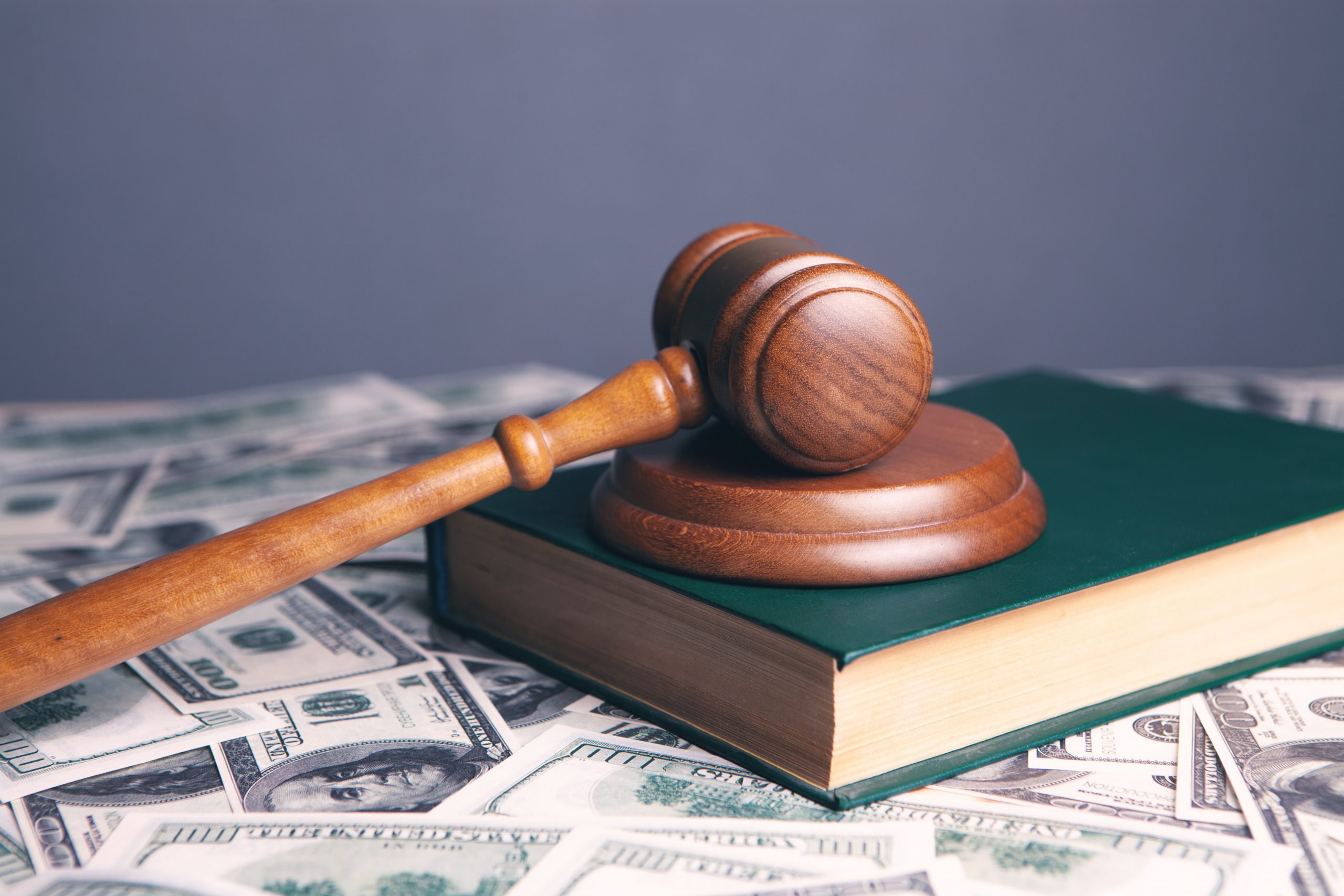
How Does Precedent Work?
Watch the video Precedent–Legal Studies Terms by Wimble Don on YouTube for a summary of the doctrine of precedent.
The doctrine precedent can be classified in various ways. First, precedent can be categorized based on its binding or non-binding effect. Binding precedent refers to a mandatory requirement to follow past decisions, whereas as non-binding precedent describes an optional ability to follow past decisions. Second, the binding or non-binding nature of precedent can be set out in law (known as de jure precedent) or can be observed in practice based on how decision-makers actually relate to past decisions (known as de facto precedent) – for example, do they naturally follow past decisions or disregard them?
Third, precedent can operate vertically or horizontally. Vertical precedent occurs where a decision made by a decision-making body that is higher than others in a hierarchy acts as a precedent for lower level decision-makers. Horizontal precedent occurs where a decision made by a decision-making body becomes a precedent for that decision-making body in future cases or for other decision-making bodies operating at the same level in a hierarchy.
In the Canadian court system, a binding and de jure doctrine of precedent operates vertically when a legal principle or rule established by the Supreme Court of Canada (the highest court in the country) or a provincial or territorial appeal court (the highest court in the province or territory) becomes a precedent that lower-level courts must follow. However, a non-binding and de facto doctrine of precedent also operates horizontally in the Canadian court system when the decision of one court may become a precedent for that court in subsequent cases or other courts at the same level in the hierarchy. See Figure 8.3 for a visual representation of these vertical and horizontal relationships.
In the sports arbitration context, non-binding and de facto systems of precedent operate horizontally and vertically. For instance, within CAS, legal scholars have found CAS arbitrators are significantly guided by past CAS decisions and will generally follow legal rules or principles articulated in those past decisions, unless they can be differentiated from the present case or a party to the arbitration can demonstrate that the previous CAS decision involved an error.Lindholm, 2019; Kaufmann-Kohler, 2006 Similarly, SDRCC arbitrators have shown a preference to follow the legal rules or principles expressed in past SDRCC decisions.Findlay & Mazzucco, 2010 This is so, despite a rule in the SDRCC’s procedural rules that an arbitrator is not bound by previous decisions.SDRCC, 2021a The justifications provided by sport arbitrators when relying on past arbitration decisions as precedent has been respect for fellow arbitrators and the need for consistency in deciding sport disputes.For example, see A.C. V. FINA, 1996 and Mayer v. Canadian Fencing Federation, 2008
With respect to the vertical operation of non-binding de facto precedent in sport arbitration, national sport arbitration panels and decision-making bodies within international sport federations have relied on CAS decisions as precedent – either out of respect for CAS arbitrators and their expertise in sports law or because the decisions of these bodies may be appealed to CAS. For example, in Canada, SDRCC arbitrators have applied legal rules and principles established by CAS in disputes involving competition outcomes For example, see Stewart v. Wrestling Canada Lutte, 2014 and anti-doping matters, the latter of which can be appealed to CAS in certain circumstances.See Canadian Anti-Doping Program (2021), rules 13.2.3.1 and 13.2.3.2. Similarly, the Dispute Resolution Chamber (an arbitration tribunal established by the Fédération Internationale de Football Association) has applied legal rules and principles established by CAS in player transfer disputes, since the Chamber’s decisions can be appealed to CAS.Lindholm, 2019 See Figure 8.4 for a visual representation of these vertical and horizontal relationships.
Systems of precedent are valuable because they ensure consistency and foreseeability in the application of the law. This allows individuals to determine their rights and obligations under the law and either continue or change their behaviour to ensure compliance with the law. For disputing parties, precedent also ensures predictability in how disputes about the interpretation or application of a law will be resolved, and whether it is worthwhile to arbitrate a dispute. In addition, precedent contributes to efficient decision-making as arbitrators will be able to rely on the relevant and applicable legal rules or principles established by previous arbitrators to resolve present-day disputes without “reinventing the wheel”.
As Lindholm (2019) states in his study of CAS decisions, precedent also has forward-looking implications:
“To a body that is about to render a decision, the forward-looking aspect of precedent means having to consider what consequences a contemplated decision in the case at hand will have on future cases. In choosing between different possible rulings, the decision maker must not only consider the outcome of the case in question, but also the outcome of hypothetical future cases where those deciding those cases will tend to adhere to the contemplated decision.”Lindholm, 2019, p. 106
Lindholm (2019) found that CAS occasionally acknowledges that it is aware of the precedent-setting effect of its decisions and may, for example, consciously attempt to limit a decision’s use as precedent in subsequent cases by highlighting the exceptional nature of its facts.
In the sport maltreatment context, a non-binding system of precedent may be particularly helpful. The UCCMS, like many sport codes of conduct (such as anti-doping rules) is a legalistic document that may be challenging for sport participants to interpret and apply. The UCCMS also includes provisions that might be unclear in their interpretation and application to a particular set of facts. Consider the following examples:
One of the guiding principles set out in the UCCMS is harmonization – that is, the consistent application of the UCCMS to all sport participants across Canada. A system of precedent for arbitration decisions in the sport maltreatment context would advance this principle. Arbitrators, parties to disputes, and the broader sport community would benefit from a system of precedent as it would guide their common understanding of the UCCMS and their behaviour when participating in sport or resolving disputes about the UCCMS. However, a challenge with having a system of precedent is that its effectiveness depends on whether arbitration decisions are published (see Chapter 9 for a discussion on the confidentiality of arbitration proceedings).
If arbitration decisions are not published, this means that only the arbitrators and the parties to the arbitration hearings have access to the decisions. This could result in unfairness if one party (e.g. the NIM) frequently appears before arbitration panels and has the benefit of accessing and referring to the panels’ decisions in subsequent cases. However, this concern can be mitigated if the party opposite to the NIM is granted access to the unpublished decision by the arbitrator and given time to consider its application to the current case and present arguments on whether it should be relied upon as precedent. This mitigation strategy could be incorporated into the SDRCC’s procedural rules for arbitration hearings as a requirement that arbitrators must follow and as a right that parties in an arbitration can enforce.
Additionally, if the publication of arbitration decisions is not possible (due to privacy considerations), then the arbitration decisions should be reviewed by the arbitration institution or the NIM on a periodic basis and used to publish commentary regarding the interpretation of certain provisions in the UCCMS and the procedural rules that apply to arbitration proceedings in the sport maltreatment context. Such published commentary would be aligned with the following examples of transparency that already exist in the Canadian sport system:


Miranda v. Canadian Amateur Diving Association is an example of the challenges that may arise in interpreting certain terms (e.g. “coach-athlete relationship”) that seem to have clear meanings at first glance, but can be challenging to apply to a set of facts. The case involved a disciplinary dispute that arose from a sexual relationship between two athletes with a significant age gap (15 years old vs. 32 years old). The older athlete, Miranda, was disciplined by the national sport organization for the sexual relationship, and Miranda appealed the discipline decision to the SDRCC.
The main issue at arbitration was whether Miranda’s actions violated the sport organization’s code of conduct. The code of conduct in place at the time did not prohibit sexual relationships between athletes but did prohibit conduct that was “unreasonable and would bring the sport into disrepute”.
The arbitrator considered whether the age gap between Miranda and the complainant or the existence of a coach-athlete relationship between them violated this prohibition. With respect to the age gap, the arbitrator found that the sexual relationship was not a criminal offence because the complainant was over 14 years of age, and Miranda was not in a position of trust or authority towards the complainant. Further, while the age gap could be considered immoral it could not be used as a justification for misconduct against a vague standard of “bringing the sport into disrepute”. With respect to the existence of a coach-athlete relationship, the arbitrator concluded that no such relationship existed since Miranda was only a coach of the complainant on a temporary five-day basis when the complainant’s regular coach was unavailable two years prior to sexual encounter.
Key Terms
An interactive H5P element has been excluded from this version of the text. You can view it online here:
https://ecampusontario.pressbooks.pub/safesport/?p=191#h5p-20
Suggested Assignments
Image Descriptions
Figure 8.1 This figure shows the four main parties involved in dispute resolution. This includes the complainant, respondent, decision-maker, and sport organization all fitting together like four puzzle pieces. [return to text]
Figure 8.2 This figure demonstrates the four different Sport Dispute Resolution Centre of Canada (SDRCC) Tribunals. This includes the Ordinary Tribunal, the Doping Tribunal, the Safeguarding Tribunal, and the Appeals Tribunal. [return to text]
Figure 8.3 This figure demonstrates the hierarchy of Canadian courts and tribunals. At the top is the Supreme Court of Canada, the highest court in the country. Lower-level courts include the court martial appeal court, provincial/territorial courts of appeal, and the federal court of appeal. Military courts are listed as a sublevel of the court martial appeal court. Provincial/territorial superior courts are listed as a sublevel beneath provincial/territorial courts of appeal, with provincial/territorial courts and provincial administrative tribunals listed as sublevels beneath the superior courts. The Tax Court of Canada and federal court are both listed as sub-levels beneath the federal court of appeal, with federal administrative tribunals listed as a sub-level beneath the federal court. [return to text]
Figure 8.4 This figure demonstrates the decision-making hierarchy in the sports system. At the very top is the Court of Arbitration for Sport (CAS). The CAS is directly connected via vertical operation to the National Anti-Doping Organization Arbitration Tribunal, such as the Sport Dispute Resolution Centre of Canada (SDRCC) Doping Tribunal and Appeals Tribunal. The International Sport Federation Arbitration Tribunals such as the FIFA Dispute Resolution Chamber also rely on CAS decisions via a vertical relationship. Another vertical relationship is that of the National Sport Arbitration Tribunal like the SDRCC Ordinary Tribunal with a National Sport Organization Decision-Making Body such as an internal appeal panel, or a competition jury. [return to text]
Sources
A.C. v. FINA, CAS Appeals, No. 96/149
Arbitration Act, 1991, Ontario, Canada.
Associated Press. (2021, May 18). Swim star Sun Yang’s three-day retrial at sports court next week. Retrieved December 23, 2021, from https://www.sportsnet.ca/olympics/article/swim-star-sun-yangs-three-day-retrial-sports-court-next-week/
Binner, A. (2021, February 25). Caster Semenya appeals to the European Court of Human Rights. International Olympic Committee. Retrieved December 23, 2021, from https://olympics.com/en/news/caster-semenya-appeal-european-court-human-rights
Brenner, S. (2021, April 23). Caster Semenya: ‘They’re killing sport. People want extraordinary performances’. The Guardian. Retrieved December 23, 2021, from https://www.theguardian.com/sport/2021/apr/23/caster-semenya-theyre-killing-sport-people-want-extraordinary-performances
Canadian Anti-Doping Program (CADP). (2021). Canadian anti-doping program: Part C – Canadian anti-doping program rules. https://cces.ca/sites/default/files/content/docs/pdf/2021-cces-policy-cadp-2021-final-draft-e.pdf
Canadian Cycling Magazine. (n.d.). Retrieved December 23, 2021, from https://cyclingmagazine.ca/advocacy/transgender-kristen-worley-settlement-rights/
Canadian Olympic Committee (COC). About us: Governance. Retrieved November 4, 2021, from https://olympic.ca/canadian-olympic-committee/governance/
Canadian Safe Sport Program. (2020). Sport Information Resource Centre: Universal Code of Conduct to Prevent and Address Maltreatment in Sport (UCCMS), (5)1, 1-16. https://sirc.ca/wp-content/uploads/2020/01/UCCMS-v5.1-FINAL-Eng.pdf
CBC Sports. (2005, December 21). Tennis’ Puerta banned 8 years for doping. Retrieved December 23, 2021, from https://www.cbc.ca/sports/tennis-puerta-banned-8-years-for-doping-1.529904
Claudia Pechstein v. Deutscher Olympischer Sportbund (DOSB) & International Olympic Committee (IOC), CAS, No. 10/004
Coaching Association of Canada (CAC). (n.d.a). About CAC: Board of directors. Retrieved November 4, 2021, from https://coach.ca/board-directors
Coaching Association of Canada (CAC). (n.d.b). About CAC: Staff. Retrieved November 4, 2021, from https://coach.ca/staff
Court of Arbitration for Sport. (2021a). Code of sports-related arbitration. https://www.tas-cas.org/fileadmin/user_upload/CAS_Code_2021__EN_.pdf
Court of Arbitration for Sport. (2021b). Arbitration rules: CAS anti-doping division. https://www.tas-cas.org/fileadmin/user_upload/CAS_ADD_Rules__2021_.pdf
Court of Arbitration for Sport. (n.d.). Retrieved December 23, 2021, from https://www.tas-cas.org/en/index.html
European Court on Human Rights (2021), Notice regarding Caster Semenya
Findlay, H. & Mazzucco, M. (2010). Degrees of intervention in sport-specific arbitration: Are we moving towards a universal model of decision-making?. Yearbook on Arbitration and Mediation, Penn State University, 2.
Government of Canada. (n.d.). Department of Justice: Age of consent to sexual activity. Retrieved December 23, 2021, from https://www.justice.gc.ca/eng/rp-pr/other-autre/clp/faq.html
Government of Ontario MCCSS. (2016). Standard 5, concluding a child protection investigation. Retrieved December 23, 2021, from http://www.children.gov.on.ca/htdocs/English/professionals/childwelfare/protection-standards/standard5.aspx
Gundel v. FEI, CAS decision
Gundel v. FEI, SFT decision
Ingle, S. (2021, February 25). Caster Semenya launches final bid to save career and defend Olympic title. The Guardian. Retrieved December 23, 2021, from https://www.theguardian.com/sport/2021/feb/25/caster-semenya-career-olympics-european-court-human-rights
Judicial Arbitration Management Service (JAMS). (n.d.a). ADR services: Arbitrators & arbitration services. Retrieved November 4, 2021, from https://www.jamsadr.com/arbitration
JAMS. (n.d.b). Retrieved December 23, 2021, from https://www.jamsadr.com
Kaufmann-Kohler, G. (2006). Arbitral precedent: Dream, necessity or excuse?. Arbitration International, 23(3), 357-378. https://cdn.arbitration-icca.org/s3fs-public/document/media_document/media01231914308713000950001.pdf
Lenskyj, H. (2018). Gender, athletes’ rights, and the Court of Arbitration for Sport. Emerald Publishing Limited.
Lex Animate Law Visualized | Hesham Elrafei. (2021, April 28). Arbitration Agreement Explained | Lex Animate by Hesham Elrafei [Video]. Youtube. https://www.youtube.com/watch?v=CzLiJvLitm4
Lindholm, J. (2019). The Court of Arbitration for Sport and its jurisprudence: An empirical inquiry into lex sportiva. T.M.C. Asser Press.
Mayer v. Canadian Fencing Federation, SDRCC Ordinary, No. 08-0077
Miranda v. Canadian Amateur Diving Association (2005), SDRCC decision. http://www.crdsc-sdrcc.ca/resource_centre/pdf/English/402_SDRCC_05-0030.pdf
Mutu and Pechstein v Switzerland (2018), ECHR, (Applications no. 40575/10 and no. 67474/10
Nishikawa, S. Y. (2009). Diversity on adjudicative administrative tribunals: An integrative conception. ProQuest Dissertations Publishing.
Patel, S. (2021). Gaps in the protection of athletes gender rights in sport—a regulatory riddle. International Sports Law Journal 21, 257–275.
Physical Activity and Sport Act, SC 2003, c 2. https://laws-lois.justice.gc.ca/eng/acts/p-13.4/20030702/P1TT3xt3.html
Pound, R. (2015). Sports arbitration: How it works and why it works. McGill Journal of Dispute Resolution, 1(2), 76-85. https://mjdr.openum.ca/files/sites/154/2018/05/010276_Pound_SportsArbitration.pdf
Puerta v. ITF (2006), CAS decision, A/1025
R. v. International Equestrian Federation (1999), CAS, No. 99/A/246
Sport Dispute Resolution Centre of Canada (SDRCC). (n.d.a). Dispute resolution secretariat (tribunal): Arbitrators and mediators. Retrieved November 8, 2021, from http://www.crdsc-sdrcc.ca/eng/dispute-resolution-arbitrators
SDRCC. (n.d.b). Board of directors. Retrieved November 8, 2021, from http://www.crdsc-sdrcc.ca/eng/about-bod
SDRCC. (n.d.c). Retrieved December 23, 2021, from http://www.crdsc-sdrcc.ca/eng/home
SDRCC. (2005). Miranda v. Canadian Amateur Diving Association summary. http://www.crdsc-sdrcc.ca/resource_centre/pdf/Summary/401_SDRCC%2005-0030-summary.pdf
SDRCC. (2006). Draft arbitration clause. http://www.crdsc-sdrcc.ca/eng/documents/Template_Arbitration_Clause_EN.pdf
SDRCC. (2014). Code of conduct for SDRCC mediators and arbitrators. http://www.crdsc-sdrcc.ca/eng/documents/ROSTER_CODE_OF_CONDUCT_adopted_27-Sep-2013_EN.pdf
SDRCC. (2015a). Bylaw no. 1, as amended. http://www.crdsc-sdrcc.ca/eng/documents/General_By-Law_No_1-2015_Board_Approved_ENG.pdf
SDRCC. (2015b). Procedural code.
SDRCC. (2018a). Complaints process policy. Retrieved November 8, 2021, from http://www.crdsc-sdrcc.ca/eng/documents/Complaint_Process_Policy-EN_2018_Final.pdf
SDRCC. (2018b). Investigation unit: Investigation guidelines. Retrieved November 8, 2021, from http://www.crdsc-sdrcc.ca/eng/documents/Investigations-Investigation_Guidelines_EN_Final.pdf
SDRCC. (2021a). Procedural code.
SDRCC. (2021b). Call for applications for arbitrators and mediators. http://www.crdsc-sdrcc.ca/eng/documents/SDRCC_2021_Roster_Call_for_Applications_EN.pdf
SDRCC. (2021c). Nomination opportunity. http://www.crdsc-sdrcc.ca/eng/documents/SDRCC_-_Nomination_Opportunity_2021_EN_Final.pdf
Sport Resolutions. (2020a). Panel code of conduct. Retrieved November 4, 2021, from https://www.sportresolutions.com/images/uploads/files/E_2_-_Panel_Code_of_Conduct.pdf
Sport Resolutions. (2020b). Child safeguarding policy. Retrieved November 4, 2021, from https://www.sportresolutions.com/images/uploads/files/D_11_-_Child_Safeguarding_Policy.pdf
Sport Resolutions. (2021a). Who are we?: About sport resolutions. Retrieved November 3, 2021, from https://www.sportresolutions.com/about-us/who-we-are/overview
Sport Resolutions. (2021b). Panels: Join our panels. Retrieved November 4, 2021, from https://www.sportresolutions.com/about-us/panels/join-our-panels
Sport Resolutions. (2021c). 2021 NSP procedural rules. Retrieved November 4, 2021, from https://www.sportresolutions.com/images/uploads/files/D_2_-_2021_NSP_Procedural_Rules.pdf
Strasbourg Observers. (2018, November 30). Mutu and Pechstein v. Switzerland: Strasbourg’s assessment of the right to a fair hearing in sports arbitration. Retrieved December 23, 2021, from https://strasbourgobservers.com/2018/11/30/mutu-and-pechstein-v-switzerland-strasbourgs-assessment-of-the-right-to-a-fair-hearing-in-sports-arbitration/
U. S. Center for SafeSport. (n.d.). SafeSport Code. Retrieved December 5, 2021, from https://uscenterforsafesport.org/response-and-resolution/safesport-code/
West, D. (2019). Revitalising a phantom regime: The adjudication of human rights complaints in sport. International Sports Law Journal 19, 2–17.
Wimble Don. (2016, June 17). Precedent – Legal studies terms [Video]. Youtube. https://www.youtube.com/watch?v=tkh8qs-o3OI
World Anti-Doping Agency (WADA). (2021). World anti-doping code 2021. https://www.wada-ama.org/sites/default/files/resources/files/2021_wada_code.pdf
Worley v. Ontario Cycling Association, 2016 HRTO 952 (CanLII)
9
Hilary Findlay
Marcus Mazzucco
Sports law
Dispute resolution in sport
Sport arbitration
When you have completed this chapter, you will be able to:
L01 Identify the typical parties to an arbitration hearing in the sport maltreatment context;
L02 Identify the scope of review options for an arbitrator;
L03 Describe a burden of proof and provide two examples of standards of proof;
L04 Explain the connection between the confidentiality of an arbitration process and the right to a fair hearing;
L05 Identify two different approaches that can be used by an arbitrator to interpret a code of conduct; and
L06 Explain the principle of proportionality in relation to disciplinary sanctions.
This chapter will examine the use of arbitration to resolve disputes arising from investigations into alleged violations of the Universal Code of Conduct to Prevent and Address Maltreatment in Sport. Key issues related to the procedural and substantive aspects of arbitration will be considered, including the rights of parties to request arbitration, the scope of an arbitrator’s authority, the confidentiality of arbitration proceedings, and the principles of law used by arbitrators to interpret codes of conduct and determine appropriate sanctions for violations. Existing sport arbitration institutions, including the Court of Arbitration for Sport and the Sport Dispute Resolution Centre of Canada, will be used as examples to discuss these issues.
An interactive H5P element has been excluded from this version of the text. You can view it online here:
https://ecampusontario.pressbooks.pub/safesport/?p=203#h5p-21
As discussed in Chapter 8, once an investigation has concluded and a decision has been made about a violation of the Universal Code of Conduct to Prevent and Address Maltreatment in Sport (UCCMS), a dispute about that post-investigation decision may arise and will be resolved by arbitration.
Arbitration is commonly used to resolve disputes in sport as is evident by the creation of sport-specific arbitration institutions at the international and national levels, such as the international Court of Arbitration for Sport (CAS) and the Sport Dispute Resolution Centre of Canada (SDRCC). Please refer to Chapter 8 for a short backgrounder on CAS and SDRCC. In the maltreatment in sport context, arbitration is used to resolve disputes arising from investigations, as seen in the United States (U.S.) with the Judicial Arbitration Management Service (JAMS),JAMS, n.d. in the United Kingdom (U.K.) with the Sport Resolutions’ National Safeguarding Panel (NSP),Sport Resolutions, 2021 and in Canada with the SDRCC’s Safeguarding Tribunal.SDRCC, n.d.
Chapter 8 examined the key institutional issues associated with arbitration. This chapter explores the following six issues related to the procedural and substantive aspects of arbitration in the sport maltreatment context:
As mentioned in Chapter 8, the nature of a dispute involving a post-investigation decision and the parties involved will depend on various factors, including who conducted the investigation, who made the decision, and the substance of the decision itself. Consider the examples in Figure 9.1 below.
An interactive H5P element has been excluded from this version of the text. You can view it online here:
https://ecampusontario.pressbooks.pub/safesport/?p=203#h5p-22
A key issue is determining who will have rights to challenge a post-investigation decision by arbitration. Some insight into this issue can be obtained from international comparators and the SDRCC’s Safeguarding Tribunal. In the U.S., for example, investigations conducted by the U.S. Center for SafeSport may result in a formal decision issued by the Center,Other outcomes are the administrative closure of a matter or the informal resolution of a matter whereby a respondent accepts responsibility for a policy violation. and only the respondent may request an arbitration hearing to challenge the decision.U.S. Center for SafeSport, 2021 In contrast, in the U.K., a national governing bodyIn the U.K., a national governing body may also request that the Sport Resolutions National Safeguarding Panel hold an arbitration hearing to review investigative findings and issue a decision based on those findings. In such cases, the Panel would be acting as a first-instance decision-maker. First-instance decisions issued by the Panel can also be appealed to a separate Appeal Panel within Sport Resolutions. or any person who is subject to the rules and regulations of a national governing body and is affected by a decision made by the national governing body (or a decision-maker authorized by the body) may challenge a post-investigation decision relating to maltreatment.Sport Resolutions, 2021 This latter type of person could include the respondent or the complainant.
Finally, the SDRCC Safeguarding Tribunal allows the following persons to request an arbitration hearing to challenge a post-investigation decision: the respondent, the complainant,In this chapter, “complainant” refers to the individual who reports or files a complaint about another person’s alleged violation of the UCCMS, including an individual who is the subject of alleged maltreatment. However, the SDRCC’s procedural rules use the term “alleged victim(s) of the alleged violation” to describe a complainant. As a result, references in this chapter to a “complainant” in the context of the SDRCC Safeguarding Tribunal refer to the alleged victim of the alleged violation. the relevant sport organization, or a person who is pursuing the violation, if not the sport organization itself (e.g. an independent third party).The rights of persons to request an arbitration under the SDRCC’s procedural rules are subject to the applicable conduct rules of the sport organization, which may narrow the rights of the persons to challenge a post-investigation decision (SDRCC, 2021a). However, unlike the other parties, a complainant is only permitted to challenge a finding on a code of conduct violation, and is not permitted to challenge a proposed sanction issued under the code of conduct.SDRCC, 2021a
In all three of the above examples, a respondent has a right to request an arbitration hearing if they want to challenge a finding that a code of conduct violation has occurred or challenge the severity of a sanction. This is not controversial as the respondent should have such rights as it is their reputation and participation in sport that is at risk. However, with respect to the rights of a complainant or sport organization to request an arbitration hearing, the U.S. SafeSport model is arguably inadequate.
A complainant whose complaint or report is investigated should have an opportunity to request a hearing if they believe that a finding on a violation of a code of conduct is wrong, or a sanction issued under that code of conduct is not severe enough. This is especially important where the complainant believes that the investigation into the code of conduct violation was flawed on procedural fairness grounds (see Chapter 7 for a discussion on procedural fairness protections for an investigation). Similarly, the relevant sport organization ought to have similar appeal rights as they may be familiar with the alleged maltreatment and will be impacted by a sanction that prevents a respondent from participating in the organization’s operations or activities.
Interestingly, the rules for the SDRCC’s Safeguarding Tribunal permit a sport organization to challenge a proposed sanction under a code of conduct but do not grant the same right to a complainant. Instead, the rules permit the complainant to attend the hearing as an observer and require an arbitrator to allow the complainant to submit a written impact statement and read it aloud at the hearing.SDRCC, 2021a As discussed later on in this chapter, the sanctions issued under the UCCMS are intended to be proportionate and reasonable relative to the maltreatment that has occurred.
As a result, it is arguable that a complainant who is the subject of maltreatment should have the right to request an arbitration hearing to challenge a sanction imposed under the UCCMS. Otherwise, there may be circumstances where the rights of the complainant to participate in a hearing as an observer or presenter of a written impact statement cannot be exercised where no other party (respondent, sport organization, NIM) requests a hearing. The U.K. model seems to strike the right balance by providing a right to request a hearing to any person who is subject to the rules and regulations of a sport organization and is affected by a post-investigation decision made by or on behalf of the organization.Sport Resolutions, 2021
A final consideration involves the ability of the NIM to request an arbitration hearing where an investigation is conducted by an independent third party and a post-investigation decision is made by the relevant sport organization. The NIM may wish to challenge the decision as the independent body responsible for the implementation of the UCCMS. The NIM’s right to challenge the decision would be similar to the World Anti-Doping Agency (WADA)’s authority to challenge anti-doping decisions made by national or international anti-doping organizations. Alternatively, the NIM could have a more passive role as an “observer” in the proceeding, which is also a right of WADA and international sport federations in the case of doping disputes heard by the SDRCC.SDRCC, 2021a
This supervisory role of the NIM was noted by the McLaren Global Solutions Group (2020), which envisioned a similar role where a complaint falls outside the mandatory investigative jurisdiction of the NIM, and leads to an investigation by an independent third party that is overseen by a NIM investigator. A supervisory role would also address concerns raised by the sport sector about relying on the sport organization to review an independent third party’s investigative findings and determine an appropriate sanction.McLaren Global Solutions Group, 2020
The term “scope of review” relates to the breadth of an arbitrator’s authority to resolve a dispute involving a decision made by another decision-maker (the “original decision”). For the purposes of this chapter, the original decision would be a decision made by the NIM, the relevant sport organization or an adjudicator retained by the relevant sport organization, following an investigation into a violation of the UCCMS.
A narrow scope of review involves the arbitrator reviewing the original decision on specific grounds or for specific errors, such as an error made in interpreting or applying the applicable code of conduct or the use of an unfair procedure (see Chapter 7 for procedural fairness considerations for an investigation and post-investigation decision).
A broad scope of review involves the arbitrator conducting a whole new hearing of a matter without considering the original decision (known as a de novo hearing – which is Latin for “from the new”). In a de novo hearing, the arbitrator makes their own findings of fact based on admissible evidence (e.g. witness testimony or documentary evidence) and applies the relevant code of conduct to those facts to resolve the dispute as if the arbitrator was the original decision-maker. Figure 9.2 below depicts the scope of review options for an arbitrator in relation to the original decision as an hourglass.
 In Practice:
In Practice:
The above section has discussed the role of arbitrators in making findings of fact in a de novo hearing. In making a finding of fact, an arbitrator answers a question of whether an alleged fact occurred (a question of fact). In contrast, arbitrators can also make conclusions of law that answer questions about the interpretation of a law or a legal principle (a question of law). Finally, arbitrators can make findings that answer questions that have factual and legal aspects (questions of mixed fact and law). Examples of a question of mixed fact and law could include interpreting a law and applying it to a set of facts or interpreting a contract.
Interpreting a contract is considered a question of mixed fact and law because the adjudicator is determining what the parties agreed upon (a factual question) based on the wording of the contract (a legal question).
To better understand an arbitrator’s role, complete the following activity by categorizing the following questions relating to the UCCMS as questions of fact, questions of law, or questions of mixed fact and law.
The scope of an arbitrator’s authority is agreed to by the parties. The parties’ agreement is documented in an arbitration agreement, the procedural rules of the arbitration institution (with which the parties agree to comply when they submit their dispute to the institution for resolution), or the applicable rules of the relevant sport organization (with which the parties agree to comply as a condition of participating in the sport), or a combination of these documents. For example, for appeals of selection, funding and eligibility decisions made by sport organizations, the SDRCC Ordinary Tribunal has the authority to conduct a de novo hearing, and must do so in certain circumstances, including where the process used by the previous decision-maker was procedurally unfair.SDRCC, 2021a
However, where the SDRCC Ordinary Tribunal’s authority to conduct a de novo hearing is discretionary under the SDRCC’s procedural rules, its authority may be narrowed by the rules of the relevant sport organization that only permits an appeal to SDRCC on certain grounds.For example, Swimming Natation Canada’s appeal policy only permits appeals to SDRCC on certain grounds: unauthorized decision, unauthorized process, bias, improper use of discretion, decision unsupported by evidence, decision grossly unreasonable (Swimming Canada, 2017) In addition, where the option for a de novo hearing is discretionary and not restricted by the relevant sport organization’s rules, SDRCC Ordinary Tribunal arbitrators typically choose a narrower scope of review that is similar to the scope of review used by Canadian courts to review the decisions of statutory decision-makers, such as government officials or administrative tribunals (known as “judicial review”) (see the Case Study below for more information).For example, see Mehmedovic and Tritton v. Judo Canada, 2012
In a scope of review that is similar to judicial review, the arbitrator will review the procedural and substantive aspects of the original decision.
The procedural aspects relate to the procedural fairness considerations discussed in Chapter 7, including a decision-making process that provides advanced notice to the respondent of an impending decision, an opportunity for the respondent to make representations to the decision-maker, and an unbiased decision-maker.
The substantive aspects relate to whether the original decision-maker had the power to make the decision and whether the decision was reasonable.
In the context of a sport organization, the authority of a decision-maker will be set out in the organization’s constitution, bylaws, or policies. The reasonableness of a decision focuses on the outcome of the decision and the decision-maker’s reasoning process, which must be transparent, understandable, and justified.Canada v. Vavilov, 2019 A decision will be unreasonable if it is arbitrary, illogical, based on improper considerations, or if it ignores relevant considerations.


For many years, it was believed that the decisions of private sport organizations could be challenged by way of judicial review in courts. However, the Supreme Court of Canada recently clarified that the decisions of private associations, such as sport organizations, are not subject to judicial review in courts (Highwood Congregation of Jehovah’s Witnesses (Judicial Committee) v. Wall, 2018).
Instead, courts will only review the decisions of a sport organization where a plaintiff has a cause of action and the subject matter of the dispute is justiciable – that is, appropriate for the court to decide. In the case of sport disputes, the most common type of cause of action is breach of contract .
For example, if a sport organization agrees to select athletes to a national team based on selection criteria set out in a policy or contract, and the organization does not follow the selection criteria, then an athlete could bring a lawsuit to challenge the decision on the basis of breach of contract.
However, if that selection policy or contract specifies that disputes about the team selection must be resolved by arbitration, then a court will decline to hear the matter on the basis that it is not justiciable. It is not justiciable because the parties have previously agreed to resolve their dispute by arbitration, and not in court.
The previous availability of judicial review to challenge the decisions of sport organizations may have been a factor in the selection of that scope of review by SDRCC arbitrators. The rationale may have been that, if the sport organization’s decision was subject to judicial review in the absence of an agreement to arbitrate, then arbitrators should treat the arbitration hearing as though it is a judicial review.
However, SDRCC arbitrators may also believe that a scope of review similar to judicial review is appropriate because sport organizations are similar to many administrative tribunals and government decision-makers whose decisions are subject to judicial review, and that the institutional role of SDRCC arbitrators to oversee the sport system is similar to a court.
Several procedural considerations apply when selecting the appropriate scope of review. For example, one consideration for a de novo hearing is that it fixes any procedural unfairness associated with the original decision. This is because the arbitrator holds a new hearing and allows both parties to present their case on which facts exist and how the law applies to those facts, as opposed to making submissions on whether the original decision was right or wrong. This advantage has been noted by CAS arbitrators in the context of anti-doping appeals, which are heard by CAS on a de novo basis.Arbitration CUSA Shooting & Q. v. Union Internationale de Tir, 1994 However, because a de novo hearing is a new hearing, it requires an arbitrator to make findings of fact as those made by the original decision-maker are not considered. An arbitrator can make findings of fact based on witness testimony, documentary evidence, and evidentiary presumptions.For example, see the powers of arbitrators in section 5.7 of the SDRCC’s procedural rules (SDRCC, 2021a).
Having an arbitrator conduct a fact-finding process is helpful if the process used by the original decision-maker was flawed, but it can result in inefficiencies if the fact-finding process used by the original decision-maker was comprehensive and fair to both parties. In the context of the UCCMS, this risk of inefficiency may be high if an original decision is based on a lengthy investigation conducted by the NIM or an independent third party, and that investigative process needs to be repeated or supplemented in the arbitration hearing.
In contrast, in a scope of review that is similar to judicial review, there is no fact-finding process as the factual record before the original decision-maker is used by the arbitrator to review procedural and substantive aspects of the original decision, without considering any new facts that might have arisen after the original decision was made. Instead of a fact-finding inquiry, the arbitrator will review the procedural and substantive aspects of the original decision to identify errors, which raises a separate procedural issue – specifically, the applicable standard for determining whether the original decision-maker made an error (known as the “standard of review”).
Examples of standards of review for reviewing an original decision (or an aspect thereof, such as a question of law, question of fact, or question of mixed law and fact) are correctness, reasonableness, and palpable and overriding error.
In court, the appropriate standard of review depends on whether the court is reviewing the original decision as an appeal or a judicial review. As noted above, in a judicial review context, a court will consider whether the original decision was reasonable, which involves an assessment of the outcome of the decision and the decision-maker’s reasoning process. In an appeal or judicial review context, a court’s assessment of whether an original decision was procedurally fair does not involve any of the above standards of review. Instead, the court will review what level of procedural fairness is necessary in the circumstances and whether that level has been met. Figure 9.3 below provides more information about the different standard of review used by courts in appeals and judicial reviews, including assessments of procedural fairness.
Note 1: The following figure depicts various standards of review on a sliding scale based on the amount of deference given by the court to the original decision-maker. On the left side, the level of deference given to the original decision-maker is low, and therefore the court will scrutinize the original decision (or an aspect of it) to see whether an error was made. In contrast, on the right side of the scale, the level of deference given to the original decision-maker is high, and therefore the court will conduct a more superficial review of the decision (or an aspect of it) and only intervene if the court finds that the original decision contains a clear and obvious error.
Note 2: For each point on the sliding scale of deference (low, medium, high) is an example of the standard of review applied by courts in various settings. Procedural fairness is included near the middle because a court can defer to the choice of procedure adopted by an original decision-maker.
Shifting to the sport arbitration context, the most common standard of review used by the SDRCC Ordinary Tribunal is reasonableness due to the fact that the original decision-maker (i.e. the sport organization) has a certain level of expertise in the subject matter of the original decision and ought to be afforded deference by the arbitrator.For example, see the SDRCC’s remarks in Béchard v. CABA (2006); Marchant and DuChene v. Athletics Canada (2012); Mehmedovic and Tritton v. Judo Canada (2012); and Beaulieu v. Gardner (2013) However, it is up to the party whose decision is being challenged to explain why such deference should be granted by the arbitrator when reviewing the original decision.SDRCC, 2021a A sport organization can usually persuade an arbitrator that the appropriate standard is reasonableness in disputes involving team selection, funding and eligibility, as the sport organization has specialized knowledge in those areas.
In contrast, the procedural rules for the SDRCC Safeguarding Tribunal specify that, in the context of a challenge to a finding regarding a violation of a code of conduct, the standard of reasonableness applies to assessing whether the original decision-maker made certain errors (such as misinterpreting or misapplying the code of conduct), whether there was a breach of procedural fairness, or whether there is new evidence to consider.SDRCC, 2021a This standard of reasonableness is arguably inappropriate for several reasons:
Where the original decision is made by the NIM following an investigation conducted by the NIM, a standard of reasonableness may be appropriate since NIM will presumably have expertise in interpreting and applying the UCCMS. In contrast, where the original decision is made by a sport organization or a third party adjudicator retained by the sport organization, a less deferential standard, such as correctness, may be more appropriate as the sport organization or other decision-maker may have less expertise in interpreting and applying the UCCMS, at least in the infancy of implementing the UCCMS.
A final procedural consideration that applies when selecting the appropriate scope of review is the scope of remedies that may be granted by the arbitrator. In a de novo hearing, an arbitrator is not considering the original decision and will therefore issue a new decision that replaces the original decision. In contrast, in a narrower scope of review, an arbitrator may refer the matter back to the original decision-maker with instructions to correct any error identified by the arbitrator, if a resolution of the dispute is not urgent and the original decision-maker (i.e. the sport organization) has a particular expertise over the subject-matter underlying the dispute, such as a team selection decision involving the exercise of discretion.For examples where SDRCC arbitrators have referred matters back to original decision-makers in team selection disputes, see Dutton v. Speed Skating Canada (2018); Wilton v. Softball Canada, SDRCC (2004)
The procedural rules of a sport arbitration institution typically give an arbitrator a broad scope of authority to grant remedies – likely to reflect that the scope of the arbitrator’s review may vary depending on the circumstances. For example, for SDRCC’s procedural rules authorize the SDRCC Ordinary Tribunal to substitute its decision for the original decision or to grant such remedies that the Tribunal deems just and equitable in the circumstances,SDRCC, 2021a which may include referring the matter back to the original decision-maker to re-make the decision after correcting any procedural or substantive errors identified by the arbitrator. Similarly, the SDRCC procedural rules authorize the Safeguarding Tribunal, in certain circumstances, to impose such consequences and/or risk management measures as seem fair and just, after considering the relevant sport organization’s rules.SDRCC, 2021a (See Section 6 of this chapter “The Principle of Proportionality and Sanctions under the UCCMS” for further discussion on sanctions).
What is the appropriate scope of review for disputes involving post-investigation decisions related to maltreatment in sport based on the procedural implications discussed above? To answer this question, it is helpful to look at the context in which the dispute will arise. As noted earlier, the dispute involves a decision made by the NIM or the relevant sport organization following an investigation into a violation of the UCCMS.
Chapter 7 discusses the elements required for a procedurally fair investigation and original decision. Assuming those elements are incorporated into the investigation and decision-making processes, it may be unnecessary to have a de novo arbitration hearing that makes new or fresh findings of fact. Repeating or supplementing a fact-finding process at the arbitration stage could re-traumatize complainants and witnesses, as well as substantially increase the time and resources required for the arbitration hearing. As a result, it may be appropriate to limit the availability of a de novo hearing to instances where the original decision was made in a procedurally unfair manner that can only be remedied by a new decision-making process conducted by the arbitrator.
Where a de novo hearing is not warranted, the arbitrator’s role could be limited to reviewing the original decision on specified grounds (e.g. an error in interpreting or applying the UCCMS or procedural unfairness). In other words, the arbitrator begins with a narrower scope of review and only expands to a de novo hearing to remedy procedural unfairness in the making of the original decision. In a narrower scope of review, consideration must be given to the appropriate standard of review .

To learn more about the different types of arbitration hearings available in the United States Safe Sport model, watch the video Hearing Process: Response and Relation.
This narrow-to-broad scope of review approach is taken by the SDRCC’s Safeguarding Tribunal and may provide insight into how the SDRCC would determine the scope of review of arbitrators that review decisions made by the NIM. However, this narrow-to-broad approach would be somewhat inconsistent with the safe sport arbitration models in the U.S. and the U.K. The U.S. model permits a de novo hearing where a respondent challenges the merits of the Center’s finding of a code violation, and a strict narrower scope of review where a respondent challenges a sanction or a finding of a code violation based on a criminal charge or disposition, such as a conviction.U.S. Center for SafeSport, 2021 In contrast, in the U.K. model, the NSP Safeguarding Panel’s arbitration rules are silent on the applicable scope of review, likely to allow the parties and arbitration panel to decide on the appropriate scope and related procedural matters prior to the hearingSport Resolutions, 2021
Table 9.1 below compares the scope of review and related procedures of arbitrators in the U.S. SafeSport, U.K National Safeguarding Panel, and SDRCC’s Safeguarding Tribunal models.
| Jurisdiction | Scope of Review | Related Procedures (Standard of Review, Evidence & Remedies) |
|---|---|---|
|
U.S. SafeSport Arbitration.U.S. Center for SafeSport, 2021. |
In the case of a merit-based hearing – de novo hearing |
No standard of review. Flexible and comprehensive rules of evidence to enable fact-finding on alleged violations of SafeSport Code. Arbitrator may grant such remedy or relief as they deem just and equitable within scope of the Code and sanctioning guidelines. |
|
In the case of a hearing concerning sanctions or violation of SafeSport Code due to criminal charges or dispositions – appeal/review on narrow ground (whether abuse of discretion occurred). |
No standard of review as arbitrator is assessing whether the Center abused its discretion, not whether the Center’s decision or an aspect of the decision involved an error. No fact-finding as violation of code and underlying facts are established and irrefutable. Arbitrator’s review is based on Center’s decision, parties written submissions, and oral submissions (if permitted by arbitrator). Arbitrator may modify sanction issued by Center if abuse of discretion is found. |
|
|
U.K. National Safeguarding Panel Arbitration.Sport Resolutions, 2021. |
Scope of review determined by arbitrator and parties prior to hearing |
Procedural rules silent on standard of review. (If not a de novo hearing, then, presumably, arbitrator would select standard of review based on parties’ submissions). Flexible and comprehensive rules of evidence to align with scope of review, including appointing independent experts and requiring production of documents. Arbitrator can issue sanctions or risk management measures as seem fair and just (which would replace original decision). |
|
SDRCC – Safeguarding Tribunal.SDRCC, 2021c |
In the case of a challenge to a finding on a code violation – appeal on narrow grounds (specific errors, procedural unfairness, new evidence). |
Standard of review is reasonableness. Review based on documentation (not testimony), unless panel orders otherwise. Silent on scope of remedies. |
|
In the case of a challenge to a proposed sanction – similar to judicial review. |
SDRCC Code silent on standard of review. (presumably, arbitrator to select standard of review based on parties’ submissions). Presumably, no fact-finding if review focused on appropriateness of sanction. Arbitrator can issue sanctions or risk management measures as seem fair and just (which would replace original decision). |
|
|
If a challenge to finding on a code violation reveals bias, then arbitrator conducts a de novo hearing. |
No standard of review. Flexible and comprehensive rules of evidence to align with scope of review, including appointing independent experts and requiring production of documents. Silent on scope of remedies. |
A burden of proof refers to a party’s responsibility to prove a particular fact or matter in a legal proceeding. Burdens of proof impact how a party behaves in a proceeding in terms of what arguments they make and what evidence they introduce. A party with a burden to prove a certain fact must take proactive steps to meet that burden.
In contrast, a party without a burden may decide to do nothing (as they don’t have to assist the other party in meeting the burden) or may decide to take reactive steps to rebut the arguments made or evidence introduced by the other party to prevent that other party from meeting their burden.
To use a sport analogy, a party with a burden of proof is on the offensive, while the other party is on the defensive. See Figure 9.4 below for further explanation.
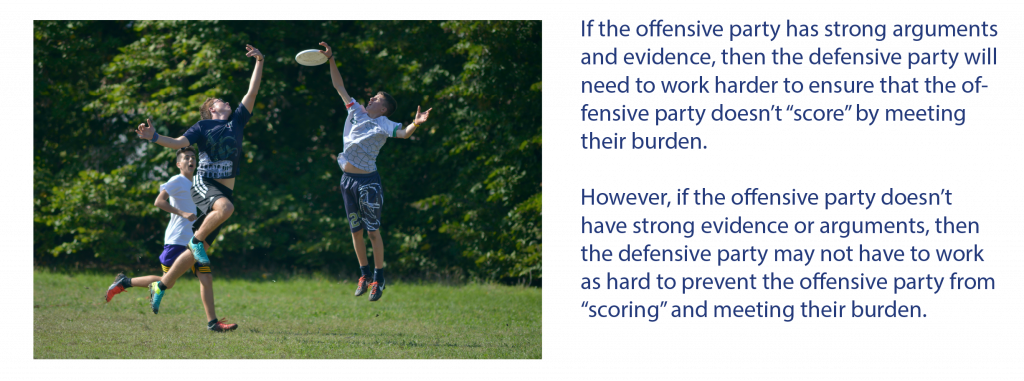
To determine whether a party has met their burden to prove a particular fact or matter, a threshold or standard must be applied (known as the standard of proof). To return to our sport analogy, the standard of proof would be the end zone that the offensive party must enter to score. The higher the standard, the further away the end zone is from the offensive party. There is a sliding scale of standards of proof in law. Figure 9.5 depicts the various standards of proof as different end zones on a sports field.
An interactive H5P element has been excluded from this version of the text. You can view it online here:
https://ecampusontario.pressbooks.pub/safesport/?p=203#h5p-23
Burdens of proof can be assigned to both parties in a legal proceeding. In the sport maltreatment context, the allocation of a burden of proof will depend on an arbitrator’s scope of review (see Section 2 “Scope of Review and its Procedural Implications” above). For example, in a de novo hearing where the arbitrator is making factual findings to determine whether a violation of the UCMMS occurred, it is fair to assign the burden of proving a violation to the party pursuing the violation, which will be the NIM or the relevant sport organization whose original decision was challenged.
If a violation of the UCCMS is established, then each party would have the burden to prove why their proposed sanction should be accepted by the arbitrator by proving the existence or application of certain factors. However, if a presumptive sanction applies based on the UCCMS violation, such as a permanent ineligibility, then the respondent will have the burden to explain why that sanction is not fair and appropriate based on certain factors (see Section 6 “The Principle of Proportionality and Sanctions under the UCCMS” below for a discussion on the proportionality of sanctions).
In a narrower scope of review, there is no burden of proof to be assigned because the arbitrator is reviewing the original decision for specific errors, and not engaging in fact finding process that requires a party to prove a fact based on a certain standard. For example, if a party is challenging an original decision on specific grounds (such as an error made in interpreting or applying the UCCMS or procedural unfairness), then the focus is on the relevant standard of review (see Section 2 “Scope of Review and its Procedural Implications” above).
However, where an arbitrator concludes that an original decision is procedurally unfair or contains a substantive error, the arbitrator may assume a fact-finding role requiring the allocation of burdens of proof. For example, if an arbitrator concludes that an original decision should be overturned and replaced because the sanction imposed is unreasonable, then the arbitrator may require the parties to make submissions on appropriate sanctions that requires them to prove certain factors.
Similarly, if the arbitrator concludes that the original decision was procedurally unfair and that this should be remedied by a de novo hearing conducted by the arbitrator, then the above discussion about allocating burdens of proof in a de novo hearing applies.
To summarize, an arbitration institution’s procedural rules for allocating burden of proof will depend on an arbitrator’s scope of review and the type of hearing that flows from that scope. In the U.S., for example, because a de novo hearing is offered for merit-based challenges to an original decision made by the Center, the procedural rules for that type of hearing specify that the Center has the burden of proof. In contrast, for the SDRCC Safeguarding Tribunal, because there are different types of hearings contemplated (a de novo hearing or a narrower scope of review), the procedural rules include one general rule that the party asserting a particular fact or matter has the burden to prove it.
This latter type of procedural rule is appropriate where there is flexibility in the breadth of an arbitrator’s scope of review and type of hearing. However, it will be the responsibility of the arbitrator to clarify for the parties how the rule will be applied in the context of a de novo hearing compared to a narrow review of an original decision on specific grounds. This clarification should be provided during any preliminary meetings amongst the parties and arbitrator prior to the start of the hearing so that the parties know what to expect during the hearing.
Once burdens of proof have been allocated between or amongst parties to an arbitration proceeding, the relevant standard(s) of proof must be determined. Figure 9.5 above provides examples of the different standards of proof that exist in law. What is the appropriate standard of proof in the sport maltreatment context?
In the U.S. and U.K. safe sport models, and in the SDRCC Safeguarding Tribunal, the relevant standard of proof is a “balance of probabilities.” As noted above, this standard is met when an arbitrator is satisfied that it is more likely that something is true than false (i.e. being 51% sure of something). This requires evidence that is clear, convincing, and persuasive.F.H. v. McDougall, 2008 A balance of probabilities is the only standard of proof used in civil lawsuits, including those involving sexual assault and battery.F.H. v. McDougall, 2008 It is also the standard used by child protection authorities in Ontario when conducting an investigation.Government of Ontario, 2016
In contrast, in the anti-doping and disciplinary contexts of sport, CAS has held that the applicable standard of proof is a “comfortable satisfaction”.FK Pobeda et al v. UEFA, 2009 This standard is greater than a balance of probabilities but less that proof beyond a reasonable doubt, and it is met when an arbitrator is comfortably satisfied that it is far more likely that something is true than false. CAS has justified the standard due to the seriousness of allegations involved in doping and disciplinary disputes and their consequences.Lindholm, 2019 Following CAS decisions, the standard of a comfortable satisfaction was incorporated into the World Anti-Doping Code. However, the standard only applies to an anti-doping organization’s burden to prove an anti-doping rule violation and, for all other burdens that might arise in a doping hearing, the applicable standard of proof is a balance of probabilities.WADA, 2021
The comfortable satisfaction standard is very similar to the standard of “clear and convincing evidence”. The clear and convincing standard is used in the discipline hearings of certain regulated professions in Canada, but only if the standard is set out in legislation (see, for example, Ontario’s Police Services Act ). In the U.S., the standard is also used in some civil proceedings involving morally blameworthy conduct, such as fraud or conduct giving rise to punitive damages.For example, see California Civil Code, section 3294. Punitive monetary damages seek to punish a person for their intentional or malicious behaviour and can be differentiated to the more common compensatory monetary damages that seek to compensate a victim. It is also used in U.S. administrative proceedings where personal liberties are at stake, such as withdrawing life supportCruzan v. Director, 1990 or child custody determinations.Santosky v. Kramer, 1982

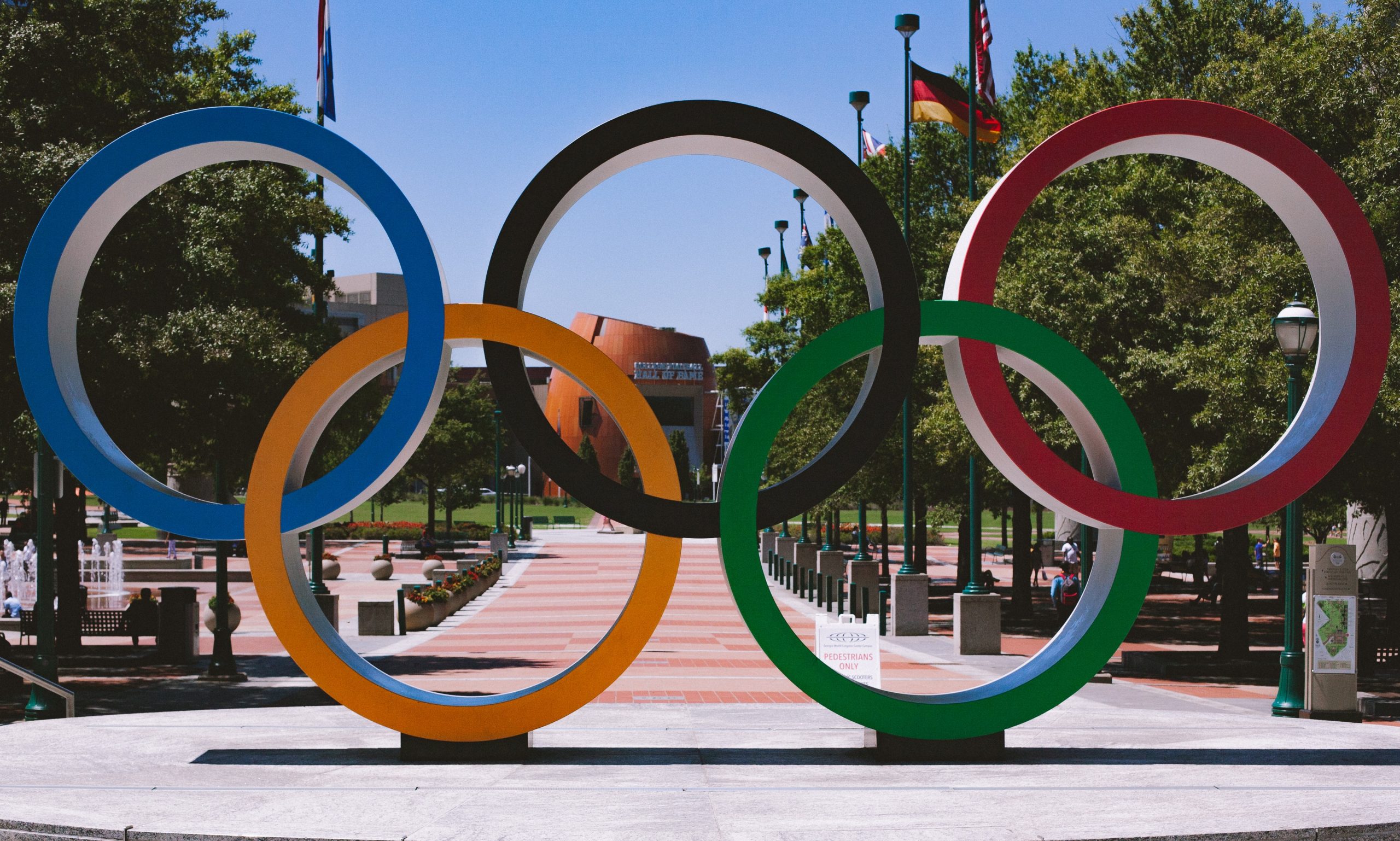
“The Russian Doping Scandal,” Commission on Security and Cooperation in Europe, Feb. 22, 2018.
“Russian Doping Scandal: Athletes Face Potential Ban from Global Sport,” BBC, Dec. 9, 2019.
“How Russian Doping Scandal Unfolded,” France24, Dec. 17, 2020.
Following investigative journalism into state-sponsored doping in Russia and a 2016 WADA investigation into the same issue, the IOC established a disciplinary commission to conduct hearings involving Russian athletes who were implicated in the WADA investigation. The IOC disciplinary commission concluded that the athletes had committed anti-doping rule violations through their participation in a state-sponsored doping scheme at the 2014 Olympic Games in Sochi and, as a consequence of those violations, disqualified the athletes’ results at the 2014 Olympic Games and banned them from competing at any future Olympic Games.
The athletes appealed the IOC disciplinary commission’s decision to CAS. CAS upheld the majority of the athletes’ appeals and overturned the IOC’s sanctions on the basis that the indirect evidence obtained from the 2016 WADA investigation did not meet the standard of proof for proving the alleged anti-doping rule violations (see, for example, Smolentseva v. IOC, 2017). This outcome was somewhat surprising as CAS had relied on indirect evidence to be comfortably satisfied of an anti-doping rule violation in previous decisions.Lensykj, 2018
The answer involves a balancing of rights and interests. From the perspective of a respondent, an alleged violation of the UCCMS is serious due to its moral blameworthiness and its potential consequences to the respondent’s reputation, livelihood, and ability to participate in sport. The seriousness of the allegations and their related consequences is comparable to that seen in doping disputes before CAS, which suggests that a standard of comfortable satisfaction may be more appropriate than a balance of probabilities.
However, it is important to keep in mind that the disputes heard by CAS involve international-level athletes and officials, and therefore the consequences of an alleged violation may be more serious than the consequences at lower levels of sport where a respondent may only be a volunteer.
Further, and perhaps more importantly, CAS may not be the most appropriate comparator for the sport maltreatment context, despite being an institution in the sport system. Domestic legal systems may be a better comparator due to their overlap with the subject matter of the sport maltreatment context. For example, a violation of the UCCMS may lead to a civil lawsuit for assault or battery where the standard of a balance of probabilities would apply.
Similarly, a violation of the UCCMS may also trigger an investigation or proceedings under provincial or territorial child protection legislation, where the balance of probabilities standard would be used. Finally, even in domestic legal proceedings outside of Canada that use a standard of clear and convincing evidence due to the liberty interests at stake (e.g. ending life support, suspending parental rights), the interests of a respondent under the UCCMS arguably do not reach the same level of importance.
From the perspective of the complainant, the NIM or other person pursuing the violation of the UCCMS, it is important to recognize the evidentiary burden associated with a standard of proof that is higher than a balance of probabilities, such as a comfortable satisfaction. The evidence available in a maltreatment case may be very different than the evidence available in a doping case, so imposing a standard higher than a balance of probabilities may be unfair to complainants and those pursuing violations. Evidence in maltreatment cases will typically involve the allegations of complainants and witnesses expressed through interviews with an investigator or testimony at an arbitration hearing.
In some cases, physical and documentary evidence may also exist to corroborate the allegations of complainants and witnesses. In the absence of such corroborating evidence, an arbitrator in a de novo hearing will assess the allegations of complainants and witnesses based on their credibility.
In contrast, the evidence in doping hearings to prove an anti-doping rule violation is usually an adverse analytical finding from an athlete’s urine sample, which will meet the comfortable satisfaction standard, provided that the specimen collection and laboratory analysis complied with applicable requirements. However, where other evidence is used in doping hearings to prove anti-doping rule violations, such as indirect evidence from an investigation into state-sponsored doping,CAS has held that indirect evidence of blood doping obtained from longitudinal analysis meets the comfortable satisfaction standard: see Pechstein case. then the standard of a comfortable satisfaction may not be met (see “In the News: Russian Doping Scandal” above).
The evidentiary burden associated with a higher standard of proof also has practical implications for an arbitrator. As noted by the Supreme Court of Canada in the case of F.H. v. McDougall (2008), at para. 43:
An intermediate standard of proof presents practical problems. As expressed by Rothstein, Centa and Adams, at pp. 466-67 [in “Balancing Probabilities: The Overlooked Complexity of the Civil Standard of Proof,” in Special Lectures of the Law Society of Upper Canada 2003: The Law of Evidence]:
“[S]uggesting that the standard of proof is ‘higher’ than the ‘mere balance of probabilities’ inevitably leads one to inquire: what percentage of probability must be met? This is unhelpful because while the concept of ’51 percent probability,’ or ‘more likely than not’ can be understood by decisionmakers, the concept of 60 percent or 70 percent probability cannot.”
In other words, a standard of a comfortable satisfaction or clear and convincing evidence may be difficult to apply in practice. Although sport arbitrators may be familiar with this standard in the doping context, the type of evidence used to establish an anti-doping rule violation in doping hearings is different than the evidence used in the sport maltreatment context.
Further, where sport arbitrators have had to consider indirect or circumstantial evidence of an anti-doping rule violation, there seems to be inconsistency in how the standard is applied to such evidence (see “In the News: Russian Doping Scandal” above), which is an important consideration for the sport maltreatment context. Finally, it is worth repeating that, in the doping context, for burdens to prove something other than an anti-doping rule violation (such as an athlete’s level of fault or negligence when determining a period of ineligibility), the lower standard of a balance of probabilities applies, and the type of evidence used to satisfy those burdens is likely to be similar to the type of evidence relevant to a sport maltreatment hearing (e.g. testimonial evidence).
In summary, in the sport maltreatment context, a standard of a balance of probabilities is the most appropriate standard of proof having regard to the rights and interests at play and would be consistent with the standard of proof used in Canada where similar misconduct is alleged in civil litigation, as well as the arbitration rules used for the U.S. SafeSport model, the U.K. National Safeguarding Panel, and the SDRCC Safeguarding Tribunal.
The final procedural issue discussed in this chapter concerns the confidentiality of the arbitration process. When we think about the resolution of disputes in a legal proceeding, we may picture a busy courtroom with a judge, the parties and their representatives, as well as observers who have an interest in the case, such as the media or other members of the public.
As noted in the introduction to Chapter 8, one of the key differences between resolving disputes through litigation in courts compared to private arbitration is the publicness or openness of litigation in courts. In Canada, this openness extends to the proceeding in the courtroom, any written submissions or evidence filed by the parties in court, and the court’s decision. This principle of openness in courts is protected under the Canadian Charter of Rights and Freedoms, particularly in criminal cases, and is linked to the freedom granted to the press to report on what happens in court.Re Vancouver Sun, 2004 Aspects of a court proceeding can be protected from public disclosure through publication bans and court orders that seal elements of a court file to protect privacy rights and other interests; however, such measures are an exception to the general rule of openness.
In contrast, private arbitration proceedings can be confidential and closed to the public, if the parties to the arbitration agree. This confidentiality can apply to the arbitration hearing (including the submissions and evidence filed by the parties), and the arbitrator’s decision. Like other aspects of the sport arbitration process, the parties’ agreement on the confidentiality of an arbitration proceeding can be documented in an arbitration agreement, the procedural rules of the relevant arbitration institution, or the rules of the relevant sport organization, or a combination of these documents. Table 9.2 below provides a summary of the confidentiality rules in the procedural rules of CAS and SDRCC.
|
CAS |
SDRCC |
|
|---|---|---|
|
Arbitration Hearing |
General rule: confidential and closed to the public, unless both parties agree otherwise.CAS, 2021a; CAS, 2021b Exception: in the case of disciplinary and doping hearings, one party may request a public hearing, but this request may be denied in the interests of morals, public order, national security, to protect the interests of minors or privacy interests, to avoid harm to the interests of justice, or where the hearing is exclusively related to a question of law.CAS, 2021a; CAS, 2021b |
General rule: confidential and closed to the public.SDRCC, 2021a Exception: in the case of a doping hearing, one party may request a public hearing, but this request may be denied in the interests of morals, public order, national security, to protect the interests of minors or privacy interests, to avoid harm to the interests of justice, or where the hearing is exclusively related to a question of law.SDRCC, 2021a |
|
Arbitration Decision |
Ordinary Arbitration Division – decision is confidential, unless both parties agree otherwise.CAS, 2021a Appeals Arbitration Division – decision is made public, unless both agree otherwise.CAS, 2021a Anti-Doping Division – decision is published.CAS, 2021b |
Ordinary Tribunal – decision is made public, unless both agree otherwise.SDRCC, 2021a Doping Tribunal – decision is published.SDRCC, 2021a |
The confidentiality of arbitration proceedings in the sport maltreatment context raises three main questions listed below. The following sections address these three questions in turn.
Q1 Based on the concerns discussed in Chapter 6 relating to the forced or coerced nature of consent in sport contracts, how does that impact how consent-based confidentiality rules are viewed?
Q2 Are there any limitations on a party’s ability to consent to an open or non-confidential arbitration proceeding and how do they relate to the sport maltreatment context?
Q3 What unique confidentiality rules or exceptions may be needed for the sport maltreatment arbitration context?
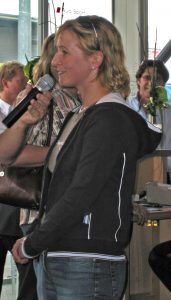
The issue of consent was considered in a recent case spanning over 10 years and involving German speedskater Claudia Pechstein. At the 2009 World Championships organized by the International Skating Union (ISU), Pechstein underwent a doping control test that examined a sample of her blood. Although the test did not identify the presence of a prohibited substance, it revealed certain parameters that were deemed irregular based on a longitudinal analysis of her blood over a period of time (also known as a biologic passport). Based on this indirect evidence, the ISU’s disciplinary panel concluded that a doping violation had occurred, and suspended Pechstein from competition for two years.
Pechstein appealed the ISU’s decision to CAS. She challenged the reliability and accuracy of the doping control test and argued that any irregularity found was due to an inherited condition. Pechstein requested a public hearing, but her request was denied in accordance with the CAS procedural rules in force at the time. CAS dismissed Pechstein’s appeal and upheld the ISU’s decision. Subsequently, Pechstein appealed the CAS decision to the Swiss Federal Tribunal (SFT) and argued that the CAS arbitration panel was not independent and impartial. SFT dismissed the appeal, so Pechstein then sought relief from German courts.
Pechstein had varying degrees of success at the trial and appeal in German courts, but ultimately lost in German’s highest court – the German Federal Tribunal. Finally, Pechstein sought recourse from the European Court of Human Rights (EHCR) by alleging that CAS procedures, including those relating to confidential hearings, violated article 6 of the European Convention on Human Rights (Convention), which protects the right to a fair trial.
The EHCR noted that the public nature of legal proceedings was a fundamental aspect of the right to a fair trial protected under Article 6 of the Convention. The EHCR reasoned that holding a public hearing protects parties against justice being administered in secret without public scrutiny and was necessary to ensure public confidence in courts. It also held that this right may be limited in certain circumstances, such as:
The EHCR ultimately held that Pechstein’s rights under article 6 of the Convention had been breached by CAS. It held that the question of whether Pechstein was justifiably banned for doping and the hearing of expert testimony on that issue made it necessary to a hold a hearing under public scrutiny. The EHCR highlighted that the facts were disputed and that the ban imposed on Pechstein carried a degree of stigma and was likely to adversely affect her professional honour and reputation.
However, one of the most important aspects of the EHCR’s decision was the court’s interpretation of the right to a public hearing in the context of a consent-based arbitration process. The EHCR held that article 6 does not prevent an individual from waiving, of their own free will, the right to have their case heard in public. However, where arbitration is compulsory (as was the case for Pechstein), the individual should have the choice of a public hearing, unless one of the above limitations apply. This interpretation impacts how consent is viewed in the arbitration context.
As discussed throughout this chapter and Chapter 8, many aspects of the arbitration process (including the decision to arbitrate) depend on having the consent of both parties to the dispute. However, this consent model is problematic for two reasons. First, a sport participant’s consent to the rules of sport (including rules requiring the resolution of disputes through arbitration) is forced, and arguably illusory, because the rules are imposed unilaterally on the participant. The participant has the option to accept the rules or not participate in the sport, and for many participants, this may not be seen as a fair or free choice.
Second, even if a participant’s consent to sport rules is considered valid, the requirement for both parties to agree on the confidentiality of an arbitration proceeding means that one party can always override the other party’s wishes. This two-party consent model is incompatible with an individual’s right to a public hearing, as the individual cannot exercise the right independently and freely. As a result, in the context of the confidentiality of a public hearing, one party should have the ability to request a public hearing, and that request should not be conditional on the other party’s consent.
This reasoning should apply to the sport maltreatment arbitration context. As discussed in earlier sections, the arbitration proceeding in a sport maltreatment case may involve a de novo hearing where disputed facts and the credibility of witness are central. In addition, allegations of violations of the UCCMS are serious due to their immoral character and the potential consequences of a violation on a respondent’s reputation, livelihood, and ability to participate in sport. As a result, the right to a public hearing should be available in the sport maltreatment context, subject to the limitations discussed below.
Following the EHCR’s decision in the Pechstein case, CAS amended its procedural rules to specify that, in the case of doping and disciplinary hearings, one party may request a public hearing, and that the request should be granted, unless the limitations specified above apply (see Table 9. 2 above). Although the EHCR’s decision is not binding in Canada, it also led to similar changes to the SDRCC’s procedural rules for doping hearings in 2021 (also see Table 9. 2 above).
One key difference between the CAS and SDRCC rules relates to the process for denying a request to a public hearing. In the case of CAS doping and disciplinary hearings, the request for a public hearing can be denied if the arbitration panel concludes, on its own initiative, that a specified limitation applies.CAS, 2021a; CAS, 2021b In contrast, for SDRCC doping hearings, the other party to the proceeding must object to the public hearing in order for the arbitration panel to deny the request on one of the specified limitations.SDRCC, 2021a This difference raises an interesting question about the role of the arbitration panel in reviewing requests for a public hearing.
Should the panel have the ability to decide, at is own initiative, that a public hearing not be granted, or should the panel’s authority only arise where the other party has objected to the request for a public hearing?
The former option requires the arbitrator to take on a proactive role, whereas the latter option requires the arbitrator to assume a more reactive role.
Which option is more appropriate?
Arguably, the CAS approach is more appropriate as it requires the arbitrator to take on a supervisory role over the proceeding, which is consistent with other typical powers of an arbitrator to control the hearing process. In addition, it avoids a potential issue with relying on a party to object to the request for a public hearing, when the rights or interests of that party do not overlap with any of the specified limitations to a public hearing. This issue also relates to our earlier discussion regarding the persons who can request an arbitration hearing (see Section 1).
If, for example, the parties to a sport maltreatment arbitration hearing are the respondent (who wants to exercise their right to a public hearing) and the NIM or relevant sport organization (whose original decision is being challenged), and a closed hearing is necessary to protect the interests of a minor who is a complainant or witness but not a party to the proceeding, then it will be up to the NIM or sport organization to raise an objection as an advocate for the minor’s interests. While the NIM or sport organization could certainly fulfill this advocacy role, it puts an obligation on them that may, in certain circumstances, conflict with their interests that might favour an open or transparent hearing. To avoid such conflicts, the arbitrator should have the discretion to reject a request for a public hearing on their own initiative.
Turning to the limitations on the right to a public hearing, it is necessary to apply the limitations to the sport maltreatment arbitration context. With respect to the interests of morals and public order, discussing specific allegations of maltreatment in a public hearing may incite violence or threats of violence towards the parties to the hearing, such as the respondent or a sport organization. For example, in the Larry Nassar trial featured in the Case Study video above, one of the parents of Nassar’s victims physically attacked Nassar in the courtroom and his lawyers (and their children) received death threats.Baldas, 2018
With respect to the protections of minors and privacy interests, these limitations are particularly relevant. Allegations of maltreatment under the UCCMS are likely to involve minors, as well as sensitive personal information about complainants and witnesses, such as their physical integrity, mental health, and sexual history – all of which are associated with a high expectation of privacy in society. The protection of this information from disclosure through a public hearing would also reduce the risk of re-traumatizing complainants and witnesses, which is a guiding principle contained in the UCCMS.
A public hearing could also cause harm to the interests of justice from the perspective of a respondent and future complainants. In the case of a respondent, a public hearing that attracts media attention and leads to members of the public expressing their views on the case could jeopardize a respondent’s right to a fair hearing before an independent and impartial adjudicator. In the case of future complainants, a public hearing that injures the reputation of a complainant or witness could discourage the reporting of complaints under the UCCMS or the participation of individuals as witnesses in future UCCMS investigations and arbitration hearings, which would be contrary to the interests of justice. Finally, a public hearing may not be warranted in an arbitration proceeding that is not a de novo hearing, such as a narrow scope of review where the arbitrator is not engaged in fact-finding and is only reviewing the procedural and substantive aspects of the original decision.
In summary, all of the limitations to a public hearing noted by the EHCR in the Pechstein case are applicable to the sport maltreatment arbitration context. However, it may be inappropriate to assume that this will always be the case and, therefore, consideration should be given as to whether a party to an arbitration proceeding should have a right to request a public hearing, subject to the arbitrator’s discretion to reject the request based on the application of the above limitations to the specific context of the hearing.
Consideration should also be given to whether any risks associated with a public hearing could be mitigated by its format and the issuance of a publication ban. For example, in the case of SDRCC doping cases, public attendance in the hearing is limited to listening through an audio link, as opposed to in-person attendance or video link.SDRCC, 2021a A publication ban would prohibit any person who attends the hearing from publishing any information about a complainant or witness, and would be less restrictive than the current SDRCC rule that prohibits any attendee of a hearing from disclosing any information obtained during the hearing to a third party, with some exceptions.SDRCC, 2021a
If a sport maltreatment arbitration hearing is confidential and closed to the public, then two additional considerations exist. First, what accommodations may be needed to support a minor or vulnerable person who participates in the hearing? Under the SDRCC procedural rules, the only persons permitted to attend a closed arbitration hearing are the arbitrator, the parties, the parties’ representatives and advisors, and witnesses.(SDRCC, 2021a) For doping hearings, observers are also permitted. Observers include WADA, the relevant international sport federation, and the Government of Canada (SDRCC, 2021a).
However, for the SDRCC Safeguarding Tribunal, an arbitrator can accommodate a person’s vulnerability by allowing a support person to be present or to participate in the hearing.SDRCC, 2021a A minor, vulnerable person, and any adult witness who is not a minor or vulnerable person, but over whom a respondent has authority or power, may request this procedural accommodation.SDRCC, 2021a As a general rule, this procedural must be granted by the arbitrator, unless the arbitrator believes it would interfere with the proper administration of justice.SDRCC, 2021a
The second consideration relates to the publication of the arbitrator’s decision. To ensure a procedurally fair arbitration process, the arbitrator’s decision must be disclosed to the parties so that they know the reasons for the arbitrator’s decision. However, outside of this disclosure to the parties, there are various options for the publication of decisions. For example, a full or summary version of the decision could be published, with or without redactions that anonymize the parties. Alternatively, the publication could be restricted and only involve the disclosure of the decision (full, summary, anonymized) to select third parties on a need-to-know basis.
The central question to any option for disclosing an arbitration decision is identifying the purpose(s) of the disclosure, its relation to any rights or interests of persons who may be impacted by the disclosure, whether any of those rights or interests outweigh the purpose of the disclosure, and whether the purpose of the disclosure can be met by a level of disclosure that least intrudes on the affected rights and interests. For example, in Chapter 8 we examined the value of a system of precedent for arbitration decisions in the sport maltreatment context, and how a system of precedent could be enhanced by the publication of arbitration decisions. However, in Chapter 6 we also discussed how the benefits of a system of precedent could be obtained without publishing full arbitration decisions, such as through annotated versions of the UCCMS or SDRCC procedural rules that explain key rules and principles based on arbitration decisions.
An additional purpose of disclosing an arbitration decision could be to assist with the enforcement of a sanction under the UCCMS. However, as discussed in Chapter 8, enforcement of UCCMS sanctions can be effectively achieved by publishing the identity of a respondent, the type of maltreatment they committed, and their sanction, without additional particulars.
With respect to the relevant rights and interests that would be impacted by the disclosure of a decision, many of the considerations for rejecting a request for a public hearing would be relevant and may trump certain purposes of disclosing a decision. Table 9.3 below provides examples of purposes of disclosure and the countervailing considerations.
| Purpose of Disclosing Arbitration Decision | Countervailing Consideration |
|---|---|
|
|
To summarize, the confidentiality of arbitration proceedings raises complex policy considerations that intersect with the rights and interests of the parties involved. With respect to the confidentiality of a hearing, there is a strong rationale for providing a party with a right to request a public hearing, subject to certain limitations. With respect to the publication or disclosure of decisions, several options exist, and the appropriate option requires a balancing of the purpose of the disclosure and the rights and interests of persons likely to be impacted by the disclosure. Table 9.4 below provides a summary of the confidentiality rules for sport maltreatment arbitration proceedings in the United States, the United Kingdom and the SDRCC’s Safeguarding Tribunal.
|
United States SafeSport |
United Kingdom National Safeguarding Panel (NSP) |
SDRCC Safeguarding Tribunal |
|
|---|---|---|---|
|
Arbitration Hearing |
Confidential and closed to the public.U.S. Center for SafeSport, 2021 |
Confidential and closed to the public, unless a party provides good cause for a more open hearing. Procedural accommodations that allow support persons for minors and vulnerable persons.Sport Resolutions, 2021 |
Confidential and closed to the public. Procedural accommodations that allow support persons for minors and vulnerable persons.SDRCC, 2021a |
|
Arbitration Decision |
Decision delivered to parties is redacted to remove identifying information about the complainant and witnesses. If the arbitrator concludes that the respondent has not violated the code, then the respondent may request the redaction of their identifying information. Summary of decision can be disclosed to U.S. Olympic and Paralympic Committee and national sport organizations on a need-to-know basis to assist with enforcement.U.S. Center for SafeSport, 2021 |
Several options:
|
Several options:
|
Have you ever read a rule in a sport regulation or a contract that was unclear in its meaning or had more than one possible interpretation? Was the meaning of the rule confusing, in general, or was it only confusing when applied to a unique set of facts? How did you resolve the unclear or ambiguous wording? Did you search for meaning in the text itself or did you seek out an external resource?
Unclear or ambiguous rules in laws, contracts and other documents are a common source of legal disputes. One party may have an opinion on the interpretation of the rule and another party may have a different interpretation. The difference in opinion can be long-standing and pre-date any dispute, or it can arise at the dispute resolution stage when one party is accused of violating the rule and is looking for an interpretation that avoids a finding that a violation occurred.
The focus of this section is on the substantive principles of law that are likely to be applied by arbitrators to resolve disputes involving the interpretation of the UCCMS.Interpretive principles are only one type of substantive law that might be applied by arbitrators in the sport maltreatment context. Another example of substantive law is the assessment of whether an investigation and post-investigation decision are procedurally fair. This topic was covered in Chapter 7 and will not be repeated here. Another substantive principle of law that will discussed in Section 6 “The Principle of Proportionality and Sanctions under the UCCMS” is the principle of proportionality and how it applies to the determination of sanctions under sport maltreatment codes of conduct.
 Ambiguities in Language
Ambiguities in LanguageRead the two facts listed below and respond to the questions provided in the response tool.Exercise adapted from Toedt III, 2018
Fact 1: A federal law requires a 10-year mandatory prison sentence in certain cases where the defendant had previously been convicted of crimes “relating to aggravated sexual abuse, sexual abuse, or abusive sexual conduct involving a minor or ward.”
Fact 2: A convicted defendant argues that the qualifier, “involving a minor or ward,” applies not just to the third-listed item (abusive sexual conduct), but also to the first two (aggravated sexual abuse and sexual abuse).
Optional Reading: See the case of Lockhart v. United States, No. 14-8358 (U.S. March 1, 2016). The U.S. Supreme Court rejected the defendant’s interpretation. Interestingly, the courts below the Supreme Court each had differing views on the interpretation of the law.
An interactive H5P element has been excluded from this version of the text. You can view it online here:
https://ecampusontario.pressbooks.pub/safesport/?p=203#h5p-24
Scholars have reviewed sport arbitration decisions issued by international and national arbitration institutions to identify patterns in decision-making and categorize the substantive legal principles applied by arbitrators in hearings to determine whether they are specific to sport (and therefore a type of specialized sports law) or just the application of legal principles rooted in domestic legal systems.In the case of CAS decisions, see Foster (2006) and Erbsen (2006). In the case of SDRCC, see Findlay & Mazzucco (2010). With some possible exceptions,An example of a sport-specific principle may be the “field of play” doctrine. This doctrine refers to a sport arbitrator’s unwillingness to review the decisions of game or match officials (e.g. referees, umpires, judges), unless there is evidence that the official exercised bad faith, bias, or improper motive. Despite the seeming specificity of this doctrine, it can be linked to a domestic court’s authority to deny jurisdiction over a dispute on the basis that the subject-matter of the dispute (i.e. determining whether a game official’s decision was right or wrong) is not appropriate for a court to decide. it can be argued that arbitrators apply legal principles rooted in domestic laws.Lindholm, 2019 In the case of the SDRCC, the relevant domestic law to be applied is Ontario law.SDRCC, 2021a Thus, the key question is: what sources or general principles of Ontario law will be used by arbitrators to interpret the UCCMS?
Substantive principles of interpretation will be relevant for an arbitrator regardless of their scope of review in a hearing. For example, in a de novo hearing, the arbitrator must interpret the UCCMS and apply it to findings of fact made by the arbitrator. In a narrower scope of review where the arbitrator is reviewing an original decision made by the NIM or a sport organization, the arbitrator must still interpret the UCCMS to determine whether the original decision was reasonable or contained an error. However, there are different sources and principles of Ontario law that arbitrators may rely upon to interpret the UCCMS.
One possible source of interpretive principles is contract law. This requires the arbitrator to interpret the UCCMS as a contract, which it is for the jurisdictional reasons discussed in Chapter 6. Principles of contract interpretation are commonly relied upon by SDRCC arbitrators.i.e., Laberge v. Bobsleigh Canada Skelton, 2013 Some SDRCC arbitrators have also relied upon principles of contract interpretation based on the use of such principles by CAS arbitrators (see Chapter 8 discussion on precedent).For example, see University of Regina v. Canadian Interuniversity Sport (2006)
The general principles of contract interpretation focus on determining the intent of the parties and what they intended to agree upon.Sattva Capital Corp. v Creston Moly Corp., 2014 This involves reading the contract as a whole and giving the words used their ordinary and grammatical meaning, consistent with the surrounding circumstances known to the parties at the time the contract was formed.Sattva Capital Corp. v. Creston Moly Corp., 2014
However, when an ambiguity in a contract exists that cannot be resolved by applying the general principles above, then the doctrine of contra proferentum applies.Sabean v. Portage LaPrairie Mutual Insurance Company (2017 SCC 7), at para. 12 Contra proferentum is Latin for “against the offeror” and it provides that an ambiguous term should be interpreted against the interests of the party that drafted the term or requested its inclusion in the contract. The doctrine has been applied by SDRCC arbitrators in past decisions.i.e., McAulay v. Canadian Curling Association, 2012; University of Regina v. CIS, 2009
In the context of the UCCMS, the general principles of contract interpretation will be helpful for an arbitrator to determine the meaning of a provision whose meaning is disputed. The requirement to read the contract as a whole will allow for careful consideration of the general principles and commitments set out in the UCCMS. In addition, the surrounding circumstances may include any educational or training resources used to educate participants about the UCCMS. However, the application of the doctrine of contra proferentum may be limited to hearings where the relevant sport organization is a party, as it is the sport organization that imposed the terms of the UCCMS into a contract with the respondent, as discussed in Chapter 6.
Some scholars have criticized the use of contract law principles to interpret sport rules (or even contracts between sport organizations and participants). It is challenging to view the relationship between a sport organization and participant as contractual because of the power imbalance that exists between the two parties. In the context of CAS decisions interpreting the rules and regulations of international sport federations, Foster (2003) notes:
“Although the relationship between an international sport federation and an athlete is nominally said to be contractual, the sociological analysis is entirely different. The power relationship between a powerful global international sporting federation, exercising a monopoly over competitive opportunities in the sport and a single athlete is so unbalanced as to suggest that the legal form of the relationship should not be contractual. Rather like the employment contract, a formal equality disguises a substantive inequality and a reciprocal form belies am asymmetrical relationship.”Foster, 2003, pp.15-16.
As Findlay and Mazzucco (2010) note, this unbalanced power relationship is equally present at the Canadian national sport level between an athlete and their respective national sport organization. Participants have practically no authority to participate in the negotiation of a contract, or a sport policy that is incorporated by reference into a contract. This is not to suggest that a sport organization shouldn’t have control over the rules and regulations it drafts and imposes on participants. In many cases, such as the sport maltreatment context, such control is necessary to ensure the proper implementation of minimum standards and rules for the sport sector.
However, the concern is that because the rules do not take the form of a freely negotiated contract, the principles of contract interpretation may not be the most appropriate method for resolving interpretative disputes. For example, if the principles of contract interpretation are focused on discerning the intent of both parties to the contract, then this becomes a bit of a fiction in the sport context where the sport organization’s rules are imposed unilaterally on one party.
As an alternative to contracts, sport rules can be seen as more similar to legislation (i.e. a statute or regulation made by elected members of government). For example, anti-doping rules, such as the World Anti-doping Code, can be viewed as quasi-legislative in nature.Teetzel & Mazzucco, 2014 Similar to legislation, sport rules are made by officials (e.g. a board of directors) who are elected by members of the organization. However, a challenge with this interpretation is that not all subjects of a sport organization’s authority are members of the organization. Depending on the type of organization and its level in the organizational structure of the sport system, the members of the organization may be other organizations and not individual participants, such as athletes. This type of membership structure minimizes the democratic accountability of the elected officials to the ultimate subjects of their authority. This concern has led some scholars to characterize the monopolistic authority exercised by sport organizations, particularly at the international level, as undemocratic and illegitimateFreeburn, 2018
Despite these concerns, viewing sport rules and regulations as quasi-legislative may be helpful insofar is it allows arbitrators to utilize principles of statutory interpretation to resolve disputes over the interpretation of a sport rule. SDRCC arbitrators have applied principles of statutory interpretation to interpret ambiguous sport rules.For example, see Mehmedovic and Tritton v. Judo Canada (2012)
In Canada, the modern approach to statutory interpretation used by courts involves reading the words of a statute in their entire context and in their grammatical and ordinary sense, harmoniously with the scheme of the statute, the object of the statute, and the intention of the legislative body that enacted the statute.Re Rizzo & Rizzo Shoes Ltd., 1998 This modern approach is also supported by provincial and territorial statutes governing the interpretation of legislation, which generally provide that legislation shall be interpreted as being remedial and shall be given such fair, large, and liberal interpretation as best ensures the attainment of its objects.See, for example, section 64 of Ontario’s Legislation Act, 2006.
However, where this modern approach to statutory interpretation does not resolve ambiguity in the reading of legislation, then additional interpretive principles may apply. Ambiguity arises where the words of a provision are reasonably capable of more than one interpretation, after considering the context of the entire provision and its objectives.Bell ExpressVu Limited Partnership v. Rex, 2002 One interpretive principle that applies to resolve ambiguity involving provisions that impose penalties, is interpreting the ambiguous provision strictly.Bell ExpressVu Limited Partnership v. Rex, 2002 This means that, when faced with two reasonable interpretations of a provision, the more lenient interpretation that avoids the imposition of the penalty applies.R. v. Goulis, 1981 Another interpretive principle used to resolve ambiguity is the use of external interpretive aids, such as recordings of debates in the legislature about the passage of the statute.
The above principles of statutory interpretation would be helpful for arbitrators in interpreting the UCCMS. The modern approach to interpretation would require arbitrators to read the entire UCCMS in its context, including its definitions, guiding principles and commitments, to determine the meaning of a particular provision. In addition, where true ambiguity arises in the meaning of a provision, then arbitrators may consider adopting a strict, but reasonable, interpretation that avoids the imposition of a penalty against a respondent, as well as external interpretive aids. The relevant external aids may include the UCCMS itself, in cases where a sport organization has drafted a policy or contract that includes the provisions of the UCCMS, with some necessary modifications to suit the needs of the sport or organization. Other external aids may include previous drafts of the UCCMS, training and education materials used to implement the UCCMS, and documents arising from the various working groups and consultations that gave rise to the UCCMS.
Administrative law is a final source of interpretive principles that might be relevant to arbitrators in interpreting the UCCMS. Administrative law principles would be relevant where the arbitrator has a narrow scope of review that is similar to judicial review. As discussed in Section 2 of this chapter(“Scope of Review and its Procedural Implications”), in a scope of review that is similar to judicial review, an arbitrator will review an original decision made by another body to determine whether the decision, as a whole, or a specific interpretation or findings in the original decision is reasonable. In other words, reasonability becomes the standard at which the arbitrator reviews the original decision (the standard of review). As previously noted, SDRCC arbitrators have a tendency to select this scope and standard of review when reviewing the decisions of sport organizations. In addition, the SDRCC Safeguarding Tribunal’s procedural rules specify that a standard of reasonableness applies where an arbitrator is reviewing an original decision for certain errors, such as misinterpretation or misapplication of a code of conduct.SDRCC, 2021a
In the recent case of Canada (Minister of Citizenship and Immigration) v. Vavilov (2019), the Supreme Court of Canada clarified how the standard of review should be applied in the context of a judicial review. SDRCC arbitrators are likely to rely on this case when applying a standard of reasonableness, as was seen in the case of Moore v. Wrestling Canada Lutte (2020). Figure 9.7 below outlines the principles articulated by the court in Vavilov (2019) would be relevant to an arbitrator’s review of an original decision that contains interpretations of the UCCMS.
An interactive H5P element has been excluded from this version of the text. You can view it online here:
https://ecampusontario.pressbooks.pub/safesport/?p=203#h5p-25
In summary, there are various interpretive principles that could be used by arbitrators to resolve disputes about the interpretation of the UCCMS. These interpretive principles derive from contract law, the interpretation of statutes, and administrative law. However, there is inconsistency in how arbitrators rely on these principles of interpretation to resolve disputes. For example, in the context of de novo hearings, some arbitrators have utilized principles of contract interpretation, whereas others have relied on principles of statutory interpretation. In contrast, in hearings with a narrower scope of review that is similar to judicial review, arbitrators have relied upon the principles used by courts when determining the reasonability of an original decision or an interpretation contained in an original decision.
While the various interpretive approaches and principles share certain commonalities, there is a potential for inconsistency in the interpretation of the UCCMS if one common approach to interpretation is not followed. As a result, it is recommended that the UCCMS be amended to include universal rules or principles for its interpretation. Such rules or principles could provide a roadmap for an arbitrator (or any other reader) when interpreting the UCCMS, including explaining how the intent or objects underlying the UCCMS can be extracted, what provisions in the UCCMS take precedence over others in the event of a conflict, and how external interpretive aids may be used, if at all.
The final section of this chapter relates to the sanctions that may be issued against respondents who have been found to violate the UCCMS and what authority an arbitrator has to modify or replace a sanction issued under the UCCMS.
In a disciplinary context, such as the UCCMS, there can be different types of sanctions or penalties that can be issued against a person who has engaged in misconduct: discretionary sanctions, mandatory sanctions, and presumptive sanctions.
Mandatory sanctions can be perceived as unfair as they do not allow for flexibility or the exercise of discretion. For example, under anti-doping rules, a doping violation in individual sports in connection with an in-competition doping control test automatically leads to the disqualification of the result in that competition, and the forfeiture of any medals, points and prizes.WADA, 2021 This mandatory penalty has led to unfortunate outcomes where athletes have committed an anti-doping rule violation due to the accidental ingestion of a prohibited substance in a mislabelled or contaminated product at a major competition, such as the Olympic Games (see the case of Andreea Răducan discussed below).” Presumptive sanctions are often preferable to mandatory sanctions as they allow flexibility to ensure that a sanction is reasonable and proportionate in the circumstances.
The UCCMS only includes discretionary and presumptive sanctions, not mandatory sanctions. Discretionary sanctions include verbal or written warnings, education, probation (i.e. a probationary period during which additional sanctions can be imposed if further violations of the UCCMS occur), suspension, eligibility restrictions, loss of privileges, no contact directives, monetary fines, and permanent ineligibility.UCCMS, section 3.1 The UCCMS also includes various factors that decision-makers can consider when determining which discretionary sanction is reasonable and appropriate in the circumstances, including:
The UCCMS also includes certain presumptive sanctions that are presumed to be fair and appropriate, unless the respondent can prove that they are not. For example, sexual maltreatment involving a minor complainant carries a presumptive sanction of permanent ineligibility. As another example, sexual maltreatment, physical maltreatment involving contact, and maltreatment related to the UCCMS process (e.g. failing to report maltreatment or obstructing an investigation) have a presumptive sanction of either a suspension or eligibility restrictions.
 Case Study:
Case Study:“Andreea Râducan’s Story” by Kimberly Casella, YouTube, November 26, 2010.
“Court Supports IOC over Râducan” BBC Sports, September 28, 2000.
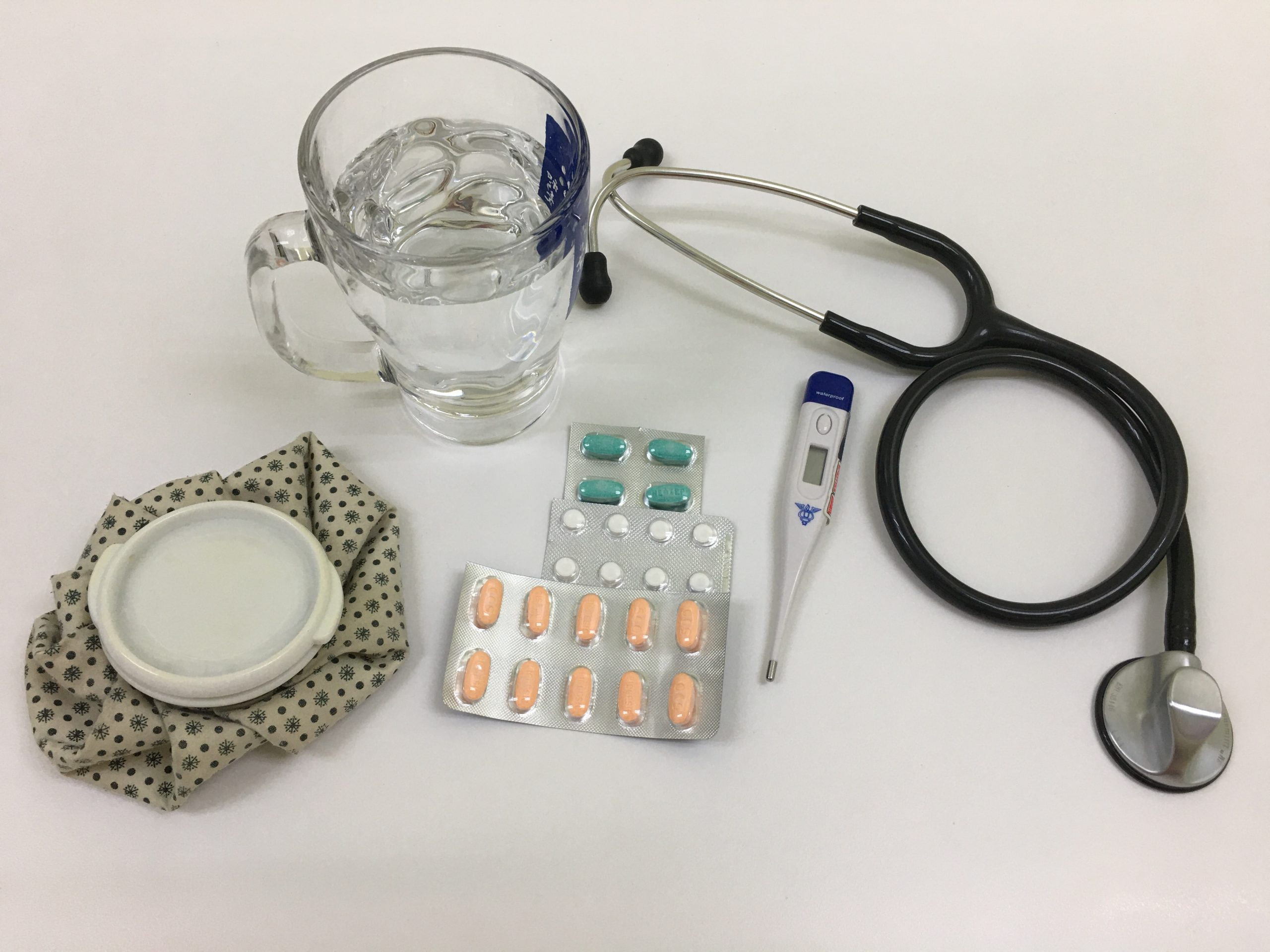
At the 2000 Olympics in Sydney, Australia, 16-year old Romanian gymnast Andreea Râducan won gold in the women’s individual all-around event. However, a doping control test after the competition revealed the presence of a prohibited substance (pseudoephedrine) in her urine sample. This resulted from Râducan’s ingestion of an over-the-counter cold and flu tablet provided by her team doctor to treat a headache on the day of the competition, and the day prior. In accordance with anti-doping rules, this violation resulted in the IOC disqualifying Râducan’s results from the women’s individual all-around final and the forfeiture of her gold medal.
Râducan appealed the IOC’s decision to CAS on several grounds, including that a more reasonable sanction would be a warning. CAS dismissed the appeal and upheld the IOC’s decision based on the strict wording of the anti-doping rules that imposed mandatory disqualification. In response to the incident, Jacques Rogge, who was a member of the IOC Executive Board at the time, commented: “This is one of the worst experiences I have had in my Olympic life. Having to strip the gold medal from the individual gymnastic champion for something she did not intentionally do is very tough. But the rules are the rules”.BBC, 2000
With respect to an arbitrator’s authority over sanctions issued under the UCCMS, this topic was addressed generally in Section 2 of this chapter when discussing the scope of an arbitrator’s remedies in relation to their scope of review.
In a de novo hearing context, an arbitrator is making findings of fact and then applying the UCCMS to those facts to determine if maltreatment exists and, if so, what the applicable sanction should be. This involves interpreting the UCCMS provisions regarding the discretionary and presumptive sanctions described above using the interpretive principles discussed in Section 5. Whatever sanction is imposed by the arbitrator will replace any sanction in the original decision.
In a hearing with a narrower scope of review, such as one similar to judicial review, an arbitrator is assessing whether any sanction imposed in the original decision is reasonable having regard to the rules described above for discretionary and presumptive sanctions, the objectives of the UCCMS, and their relation to any findings of maltreatment made by the original decision-maker. If the arbitrator concludes that a sanction in the original decision is unreasonable or incorrect, then the arbitrator can issue a new sanction that replaces the sanction imposed in the original decision, or send the matter back to the original decision-maker to issue a new sanction after correcting any error identified by the arbitrator.
At first glance, the above principles seem generally consistent with the procedural rules for the SDRCC Safeguarding Tribunal, which provide that, in the context of a challenge to a proposed sanction in an original decision, where the arbitrator determines that the respondent has presented or presents a risk to the welfare of minors or vulnerable persons, the arbitrator shall impose such consequences and/or risk management measures as seem fair and just, after considering the relevant sport organization’s rules.SDRCC, 2021a This procedural rule is virtually identical to the rules of the U.K. National Safeguarding Panel.Sport Resolutions, 2021 However, upon deeper analysis, there are two limitations of the rule that the SDRCC should consider addressing as it assumes responsibility for arbitrating disputes under the UCCMS .
The first limitation is that the provision may be too narrow as it is specific to a request for arbitration to challenge a proposed sanction in an original decision. However, the rules describe other types of requests for arbitration that may lead an arbitrator to review the appropriateness of a sanction, even though a party’s request for arbitration was not specific to the sanction.
For example, the procedural rules contemplate a request for arbitration on the grounds that an original decision was procedurally unfair, which can lead to a de novo hearing if the procedural unfairness involves a biased original decision-maker.SDRCC, 2021a At the stage of a de novo hearing, the arbitrator’s scope of authority will need to be broad enough to include the ability to issue a sanction. However, the procedural rules are silent on the scope of the arbitrator’s authority to issue a sanction in this scenario.
As another example of this limitation, the procedural rules only permit a complainant to request arbitration if they are challenging a finding on a code of conduct violation in the original decision. The complainant is not permitted to request arbitration to challenge a proposed sanction in the original decision (see Section 1 of this chapter). As a result, if the complainant is successful in proving that the original decision-maker should have found a code violation, then it is unclear what remedy could be granted by the arbitrator in relation to the appropriate sanction.
The SDRCC rules state that, to the extent that a procedure or rule is not specifically addressed for the Safeguarding Tribunal, then other rules applicable to the Ordinary Tribunal shall apply. Although the Ordinary Tribunal includes a broad scope of remedies for an arbitrator (as discussed in Section 2 of this chapter), it is unclear how that broad scope of remedies should be applied to the Safeguarding Tribunal.
To remedy the above issues, the SDRCC procedural rules could be revised to clarify an arbitrator’s authority to issue or modify sanctions for any request for arbitration .
The second limitation of the procedural rule relates to its specific language. As mentioned above, the rule is almost identical to that used by the U.K. National Safeguarding Panel. However, the language is unnecessarily narrow as it would limit the arbitrator’s authority to issue a sanction only after determining that the respondent has presented or presents a risk to the welfare of minors or vulnerable persons. This language is not aligned with the rule in the UCCMS that a sanction may be issued for any maltreatment that violates the UCCMS and does not reflect that a respondent may pose a threat to individuals other than minors and adults with a vulnerability. To remedy this concern, the SDRCC procedural rules could be amended to ensure alignment with the many circumstances in which a sanction may be imposed under the UCCMS .
Assuming the SDRCC’s procedural rules will be amended to expand an arbitrator’s scope of authority to replace or modify sanctions imposed in original decisions, it is necessary to consider whether an arbitrator could impose a sanction not provided for in the UCCMS based on the principle of proportionality.
The principle of proportionality provides that a measure must be both appropriate and necessary for the purpose of achieving a legitimate objective and a proper balance must be struck between the objective and the right or interest that it infringes upon. This principle is embedded in many areas of law and legal systems. For example, in the criminal law context, the principle is expressed in section 12 of the Canadian Charter of Rights and Freedoms, which protects an individual’s freedom from cruel and unusual punishments in Canada. Courts have used section 12 of the Charter to strike down provisions in statutes that imposed minimum penalties that were grossly disproportionate in the circumstances.R. v. Smith, 1987 Grossly disproportionate means that the punishment would offend standards of decency and be considered intolerable to society.R. v. Morrisey, 2000
In the sport arbitration context, the principle of proportionality has been applied by CAS arbitrators in doping and disciplinary hearings. CAS has held that the severity of a penalty must be in proportion with the seriousness of the violation,W. v. International Equestrian Federation, 1999 and that it has the authority to intervene if a penalty provided by the relevant sport rules can be deemed excessive or unfair on their face.FIN v. FINA, 1996
One of the best-known examples of CAS’s intervention to set aside a penalty imposed by a sport rule is in the case of Puerta v. ITF (2006) discussed in Chapter 8. Puerta failed a doping control test at the 2005 French Open, after accidentally ingesting trace amounts of his wife’s medicine. The anti-doping rule violation was the second violation in Puerta’s career; the first violation occurring in 2003 and involving the accidental use of an inhaler containing a prohibited substance to treat an asthma attack. Because the violation was Puerta’s second, the anti-doping rules in force at the time imposed a lifetime ban, unless the anti-doping rule violation was not the result of any significant fault or negligence on Puerta’s part, in which case the period of ineligibility would be reduced to eight years. The ITF’s discipline tribunal agreed that an eight-year ban was applicable based on Puerta’s lack of significant fault or negligence.
Puerta appealed the ITF’s decision to CAS on the basis that the sanction was disproportionate. CAS agreed and reduced the period of ineligibility to two years. CAS observed that, in this particular case, a ban of eight years would be disproportionate as the two anti-doping rule violations were not due to any significant fault or negligence by Puerta, and that an eight year ban would be practically the same as a lifetime ban for Puerta due to this age and expected career length. CAS cautioned that, in all but very rare cases such as this one, anti-doping rules provide a just and proportionate sanction based on an athlete’s level of fault or negligence. However, in the very rare case where anti-doping rules do not provide a just and proportionate sanction, there is a gap that must be filled by the arbitrator based on the principle of justice and proportionality upon which all systems of law are based.
Following the CAS decision in the Puerta case, WADA amended the World Anti-Doping Code to include more flexibility in how periods of ineligibility are determined for consecutive anti-doping rule violations.
The Puerta case illustrates how the principle of proportionality is most likely to be triggered where a rule imposes a penalty in a strict manner that prevents a decision-maker from tailoring the penalty to the seriousness of a violation and any mitigating factors.
In the case of the UCCMS, the principle of proportionality seems to be well incorporated through the use of rules for discretionary sanctions that give a decision-maker sufficient flexibility to impose a sanction from a range of options based on relevant considerations, including mitigating and aggravating factors. Similarly, the presumptive sanctions, although strict, can be rebutted by a respondent on the grounds that they are not fair and appropriate in the circumstances. As a result, it seems unlikely that an arbitrator would need to rely on the principle of proportionality to fill a gap in the UCCMS. However, if the UCCMS is revised over time, those involved should keep the principle of proportionality in mind to ensure it continues to be reflected in the rules for determining sanctions.
Key Terms
An interactive H5P element has been excluded from this version of the text. You can view it online here:
https://ecampusontario.pressbooks.pub/safesport/?p=203#h5p-26
Suggested Assignments
Image Descriptions
Figure 9.1 This interactive figure demonstrates the dispute scenarios for post-investigation decisions. The first branching scenario lists the National Independent Mechanism (NIM) Investigation & Decision at the top, branching into the UCCMS Violation & Sanction and the No UCCMS Violation options. From the UCCMS violation there are three more branches including respondent challenge, sport organization challenge, and complainant challenge. From the no UCCMS violation there are two branches including complainant challenge and sport organization challenge. The second branching scenario lists the ITP Investigation & Sport Organization Decision at the top, branching into the UCCMS Violation & Sanction and the No UCCMS Violation options. From the UCCMS violation there are three more branches including respondent challenge, NIM challenge, and complainant challenge. From the no UCCMS violation there are two branches including complainant challenge and NIM challenge. [return to text]
Figure 9.2 This figure demonstrates the scope of review options, using an hourglass to aid with visualization. At the top of the hourglass is the original decision. The decision maker makes findings of fact and applies UCCMS to those facts to reach a decision. In the middle of the hourglass is Arbitrator – Narrow scope of Review, where the arbitrator only reviews the original decision for certain errors. If no errors are identified, then the original decision is upheld. At the bottom of the hourglass is Arbitrator – Broad Scope of Review, where the arbitrator conducts a new hearing. The arbitrator makes findings of fact and applies UCCMS to those facts to reach a decision. [return to text]
Figure 9.3 This diagram demonstrates the standards of review and deference to original decision-makers, listing examples of Standard of Review from low to high. At the low end of the scale is Correctness. Was the original decision right or wrong? This refers to the applicable standard for reviewing questions of law in appeals (including legal aspects of questions of mixed law and fact). It can be the standard of review in a judicial review, if a standard or reasonableness does not apply. Next is Procedural Fairness. Was the original decision made in a procedurally fair manner? This refers to the approach for assessing procedural fairness in judicial reviews and appeals. Even higher on the deference scale is Reasonableness. Was the original decision (or an aspect of it) transparent, understandable, and justified? This refers to the default standard in judicial reviews, unless a standard of correctness applies. At the highest part of this scale is Palpable & Overriding Error. Did the original decision contain an error that was plain, obvious, and affected the outcome? This refers to the applicable standard for reviewing questions of fact in appeals (including factual aspects of a question of mixed law and fact). [return to text]
Figure 9.4 This figure demonstrates burdens of proof as a sporting analogy. An image of three young males playing ultimate frisbee accompanies the following text. “If the offensive party has strong arguments and evidence, then the defensive party will need to work harder to ensure that the offensive party doesn’t ‘score; by meeting their burden. However, if the offensive party doesn’t have strong evidence or arguments, then the defensive party may not have to work as hard to prevent the offensive party from ‘scoring’ and meeting their burden.” [return to text]
Figure 9.5 This interactive figure demonstrates the standards of proof illustrated. The beginning point is the “standards of proof,” which is the starting point for the party with the burden of proof (offensive party). From that point, the next step is the scintilla, which is a small amount of evidence used in some legal systems as a threshold that must be reached to proceed to a full hearing or trial in certain cases. After that comes the air of reality, or a minimum foundation of evidence that is assumed to be true; used in criminal law to determine whether a defense to a crime should be presented to the person making findings of fact (e.g. judge or jury). Next comes reasonable suspicion, or a justifiable suspicion that something possibly occurred based on specific facts or circumstances; used by law enforcement to exercise certain powers, such as roadside screening. After that is probable cause, or reasonable and probable grounds – something more than a justifiable suspicion, but less than a firm belief, that is based on specific facts or circumstances; used by law enforcement to exercise certain powers that are more intrusive than those exercised based on a reasonable suspicion, such as arrests and searches. Next comes the balance of probabilities, also known as preponderance of evidence – being satisfied that it is more likely than not that an event occurred (e.g. being 51% sure of something); used in civil lawsuits, such as those related to breach of contract and torts. Then we have comfortable satisfaction, which is similar to the standard of clear and convincing evidence – being comfortably satisfied that something occurred or being convinced that it is far more likely than not that an event occurred; used to establish anti-doping rule violations in sport, also used outside of Canada in criminal and civil legal proceedings that involve morally blameworthy conduct or restrictions on liberties. After that comes proof beyond a reasonable doubt, or being satisfied that something is true without any reasonable doubt; used in Canadian criminal trials in order to convict someone of a criminal offence. The end point for the standards of proof is proof beyond a shadow of a doubt. This means being certain that something is true without any doubts; rarely recognized in legal systems because of its impossibility to achieve. [return to text]
Figure 9.7 This figure demonstrates the administrative law principles relevant to an arbitrator’s review of an original decision that interprets the UCCMS. Governing policy means the original decision must comply with any constraints by the governing policy, such as definitions and principles that describe the extent of the original decision-maker’s discretion and how it should be exercised. As noted earlier, the UCCMS sets out guiding principles, commitments, presumptions, and definitions that would set the parameters for any interpretation of a provision. Principles of interpretation means the interpretation of any terms in the policy should be consistent with the text, context, and purpose of the policy. The text, context, and purpose of the UCCMS would be found within the document itself and could be supplemented by the external interpretive aids mentioned earlier in this section in the context of contractual and statutory principles of interpretation. Representation of the parties means the original decision-maker should take into account representations made by the parties, if any, and explain why certain representations central to the issues under consideration are accepted or rejected. The representations of the parties should be reflected in the original decision made by the NIM or the relevant sport organization, in accordance with the procedural fairness principles discussed in Chapter 7. Past and present decisions means if the original decision-maker has exercised their discretion in a certain way in past cases, then they should consider whether that precedent should be followed for consistency or departed from with justification. This principle may be particularly relevant where an original decision made by the NIM is being reviewed, as the NIM is likely to be the most frequent decision-maker given its intended jurisdiction. [return to text]
Sources
Arbitration CUSA Shooting & Q. / Union Internationale de Tir (UIT), CAS, 1995, AS 94/129
Beaulieu v. Gardner, SDRCC (2013), No. 13-0214
Béchard v. Canadian Amateur Boxing Association, SDRCC (2006), No. 06-0044
Bell ExpressVu Limited Partnership v. Rex, 2002 SCC 42 (CanLII)
California Civil Code, section 3294
Canada (Minister of Citizenship and Immigration) v. Vavilov, 2019 (SCC) 65
Canadian Anti-Doping Program (CADP). (2021). Canadian anti-doping program: Part C – Canadian anti-doping program rules. https://cces.ca/sites/default/files/content/docs/pdf/2021-cces-policy-cadp-2021-final-draft-e.pdf
Canadian Safe Sport Program. (2020). Sport Information Resource Centre: Universal Code of Conduct to Prevent and Address Maltreatment in Sport (UCCMS), 5(1), 1-16. https://sirc.ca/wp-content/uploads/2020/01/UCCMS-v5.1-FINAL-Eng.pdf
Claudia Pechstein v. Deutscher Olympischer Sportbund (DOSB) & International Olympic Committee (IOC), CAS, No. 10/004
Court of Arbitration for Sport (CAS). (2021a). Arbitration rules: CAS anti-doping division. https://www.tas-cas.org/fileadmin/user_upload/CAS_ADD_Rules__2021_.pdf
CAS. (2021b). Code of sports-related arbitration. https://www.tas-cas.org/fileadmin/user_upload/CAS_Code_2021__EN_.pdf
Cruzan v. Director, Missouri Department of Health, 497 U.S. 261 (1990)
Dutton v. Speed Skating Canada, SDRCC (2018), No. 18-0344
Ekaterina Smolentseva v. International Olympic Committee, CAS 2017/A/5472
Erbsen, A. (2006). “The substance and illusion of Lex Sportiva”. In I. Blackshaw, R. Siekmann & J. Soek (Eds.), The Court of Arbitration for Sport: 1984-2004. T.M.C. Asser Press.
F.H. v. McDougall, 2008, SCC
Federazione Italiana Nuoto (FIN) / Fédération Internationale de Natation Amateur (FINA) (1997), CAS 96/157
Findlay, H. & Mazzucco, M. (2010). Degrees of intervention in sport-specific arbitration: Are we moving towards a universal model of decision-making?. Yearbook on Arbitration and Mediation, Penn State University, 2.
FK Pobeda, Aleksandar Zabrcanec, Nikolce Zdraveski v. UEFA, CAS 2009/A/1920
Foster, K. (2003). Is there a global sports law? Entertainment and Sports Law Journal, 2(1), 1-18. https://doi.org/10.16997/eslj.146
Foster, K. (2006). Lex Sportiva and Lex Ludica: The Court of Arbitration for Sport’s jurisprudence. In I. Blackshaw, R. Siekmann & J. Soek (Eds.), The Court of Arbitration for Sport: 1984-2004. T.M.C. Asser Press.
Freeburn, L. (2018). Regulating international sport: Power, authority and legitimacy. ProtoView, (41). Ringgold, Inc.
Highwood Congregation of Jehovah’s Witnesses (Judicial Committee) v. Wall, 2018 (SCC) 26.
Judicial Arbitration Management Service (JAMS). (n.d.). ADR services: Arbitrators & arbitration services. Retrieved November 4, 2021, from https://www.jamsadr.com/arbitration
Laberge v. Bobsleigh Canada Skelton (2013), SDRCC No. 13-0211
Legislation Act, 2006, S.O. 2006, c. 21, Sched. F
Lensykj, H. (2018). Gender, athletes’ rights, and the Court of Arbitration for Sport. Emerald Publishing Limited.
Lindholm, J. (2019). The Court of Arbitration for Sport and its jurisprudence: An empirical inquiry into lex sportiva. T.M.C. Asser Press.
McAulay v. Canadian Curling Association (2012), SDRCC
McLaren Global Sports Solutions. (2020). Aim High: Independent approaches to administer the Universal Code of Conduct to Prevent and Address Maltreatment in Sport in Canada, final report. https://sirc.ca/wp-content/uploads/2020/12/MGSS-Report-on-Independent-Approaches-December-2020.pdf.
Moore v. Wrestling Canada Lutte (2020), SDRCC 20-0453
Mutu and Pechstein v Switzerland (2018), EHCR, (Applications no. 40575/10 and no. 67474/10
Police Services Act, R.S.O. 1990, c. P.15
Puerta v. ITF (2006), CAS decision, A/1025
R. v. Goulis (1981), 1981 CanLII 1642 (ON CA), 33 O.R. (2d) 55 (C.A.)
R. v. Morrisey [2000] 2 SCR 90
R. v. Smith (Edward Dewey), SCC, [1987] 1 SCR 1045
Râducan v. IOC (2000), CAS
Re Rizzo & Rizzo Shoes Ltd., 1998, SCC 27
Re Vancouver Sun, [2004] 2 S.C.R. 332 (SCC)
Sabean v. Portage La Prairie Mutual Insurance Co., 2017 SCC 7, [2017] 1 S.C.R. 121
Santosky v. Kramer, 455 U.S. 745 (1982)
Sattva Capital Corp. v. Creston Moly Corp., 2014 SCC 53, [2014] 2 S.C.R. 633
Sport Dispute Resolution Centre of Canada (SDRCC). (n.d.) Dispute resolution secretariat (tribunal): Arbitrators and mediators. Retrieved November 8, 2021, from http://www.crdsc-sdrcc.ca/eng/dispute-resolution-arbitrators
Sport Resolutions. (2021). 2021 NSP procedural rules. Retrieved November 4, 2021, from https://www.sportresolutions.com/images/uploads/files/D_2_-_2021_NSP_Procedural_Rules.pdf
Swimming Canada. (2017). Swimming Canada Appeal Policy. https://swimming.ca/content/uploads/2017/05/2017appealspolicyandprocedure_21apr2017.pdf
Teetzel & Mazzucco, M. (2014). Minor problems: The recognition of young athletes in the development of international anti-doping policies. International Journal of the History of Sport, 31(8), 914–933. https://doi.org/10.1080/09523367.2013.854774
U. S. Center for SafeSport. (2021). Safe sport code for the U.S Olympic and Paralympic movement. https://uscenterforsafesport.org/wp-content/uploads/2021/04/SafeSportCode2021_040121_V3.pdf
University of Regina v. Canadian Interuniversity Sport (2006), SDRCC, No. 06-0039
W. v. International Equestrian Federation (1999), CAS, No. 99/A/246
World Anti-Doping Agency (WADA). (2021). World anti-doping code 2021. https://www.wada-ama.org/sites/default/files/resources/files/2021_wada_code.pdf
10
Hilary Findlay
Marcus Mazzucco
Sports arbitration
Privacy law in sport
Contractual obligations
When you have completed this chapter, you will be able to:
L01 Describe when a sanction issued under a code of conduct is considered final and binding;
L02 Identify the different pathways to challenge an arbitration decision that affirms or imposes a sanction for a code of conduct violation;
L03 Identify the purposes of publishing sanctions for code of conduct violations;
L04 Describe the privacy law principles that could govern the publication of sanctions; and
L05 Describe the legal obligations that could exist to enforce sanctions in the sport system.
This chapter examines the enforcement of sanctions issued under the Universal Code of Conduct to Prevent and Address Maltreatment in Sport (UCCMS). Part one discusses how sanctions affirmed or imposed in an arbitration decision can be challenged, as any such challenge will prevent a sanction from being final, binding, and capable of enforcement. Part two discusses considerations for the effective enforcement of sanctions issued under the UCCMS, including the publication of sanctions and related privacy law considerations, and the obligations that can be placed on participants in the sport system to enforce sanctions.
An interactive H5P element has been excluded from this version of the text. You can view it online here:
https://ecampusontario.pressbooks.pub/safesport/?p=212#h5p-27
The focus of this chapter is on the enforcement of sanctions issued under the UCCMS from two perspectives: (1) challenges to an arbitration decision that imposes a sanction or affirms a sanction in an original decision, and (2) the enforcement of a sanction that is final.
As discussed in Chapter 8 and Chapter 9, after an investigation into an alleged violation of the UCCMS, a decision-maker (the National Independent Mechanism (NIM) or the relevant sport organization) may make a decision about whether a violation occurred and, if so, what the appropriate sanction is. This is known as the original decision. Several parties may request an arbitration hearing to challenge the original decision. At the national level, the Sport Dispute Resolution Centre of Canada (SDRCC) will provide the arbitration services (see Figure 8.2 in Chapter 8 for more information about the SDRCC). It remains to be seen whether the SDRCC or another institution will provide arbitration services at the provincial, territorial, and local levels of sport, should the UCCMS be implemented at those levels (see Chapter 6 for a discussion on jurisdiction ).
At the arbitration stage, an arbitrator may conduct a new hearing to consider whether a violation of the UCCMS occurred and, if so, an appropriate sanction (this is known as a de novo hearing). Alternatively, the arbitrator may have a narrower scope of review that involves assessing the original decision for certain errors, such as procedural unfairness, the misinterpretation or misapplication of the UCCMS, or a disproportionate sanction.
Once the arbitration decision is issued, the parties will need to decide whether they want to challenge the arbitration decision. There are three pathways for challenging an arbitration decision:
As will be discussed later on in this section, the first two pathways (appeals to another arbitrator or court) may not be available in all cases; as a result, the pathways should not be considered sequential in nature. However, where the first two pathways are available, a party should move through the pathways sequentially, but only after considering the strength of their case to challenge the arbitration decision and whether it is worth spending the time and resources to bring the challenge.
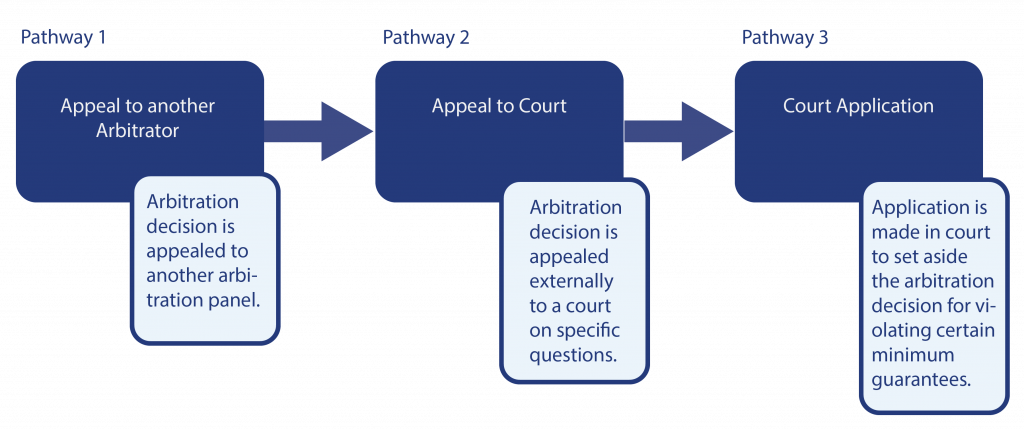
The availability of an appeal of an arbitration decision to another arbitration panel depends on the parties’ arbitration agreement (see Chapter 8 for a discussion on arbitration agreements). In many cases, the arbitration agreement will specify that the arbitration proceeding will be conducted in accordance with the procedural rules of the arbitration institution (in Chapter 8 see “Example of an Arbitration Clause in a Sport Organization Policy or Contract”). For example, in the case of doping disputes, the SDRCC’s procedural rules specify that the arbitration decision of the SDRCC Doping Tribunal may be internally appealed to the SDRCC Appeal Tribunal.SDRCC, 2021 The procedural rules also provide that decisions of the SDRCC Appeal Tribunal can be appealed by the World Anti-Doping Agency (WADA), the International Olympic Committee (IOC), the International Paralympic Committee (IPC) and the relevant international sport federation (IF) to the Court of Arbitration for Sport (CAS), in accordance with the rules of the Canadian Anti-Doping Program (CADP). International-level athletes may also appeal decisions of the Doping Tribunal directly to CAS, in accordance with the CADPSDRCC, 2021 (For more information about CAS, see in Chapter 8 “In Practice: Court of Arbitration for Sport)”.
In Canada, appeals of a sport arbitration decision to an external arbitration institution, such as CAS, are limited to doping cases. Some IFs may utilize a similar approach whereby the decision of an arbitration tribunal established by the IF is appealed externally to CAS, rather than internally within the IF’s arbitration tribunal. For example, decisions of the Dispute Resolution Chamber (an arbitration tribunal established by the Fédération Internationale de Football Association) can be appealed to CAS (see Figure 8.4 in Chapter 8 for a visual representation).
In the sport maltreatment context, any rights to appeal an arbitration decision to another arbitration panel are limited to internal appeals within the arbitration institution. For example, in the United Kingdom (U.K.), arbitration decisions of the National Safeguarding Panel (NSP) can be internally appealed to an Appeal Tribunal within the NSP.Sport Resolutions, 2021 Similarly, in Canada, arbitration decisions of the SDRCC’s Safeguarding Tribunal can be internally appealed to the SDRCC’s Appeal Tribunal.SDRCC, 2021 In contrast, in the United States (U.S.), arbitration decisions of the Judicial Arbitration Management Service (JAMS) cannot be appealed to another arbitration panel.U.S Center for SafeSport, 2021
In the context of the UCCMS, if there is a right to appeal an SDRCC arbitration decision, that appeal will very likely be to the Appeal Tribunal within SDRCC (an internal appeal), as opposed to an external appeal to CAS. The reason for this is that the UCCMS is a product of the Canadian sport system and disputes about it are best addressed through arbitration at the national level. In contrast, anti-doping rules are a product of the international sport system and although they apply at the national, provincial/territorial, and local levels of sport through national rules (i.e. the CADP), they retain a global element and explicitly provide appeal rights to international level organizations (e.g. WADA, IOC, IPC, IFs) that are best managed by an international arbitration institution (CAS).
How would an internal appeal of a SDRCC arbitration decision relating to the UCCMS work?
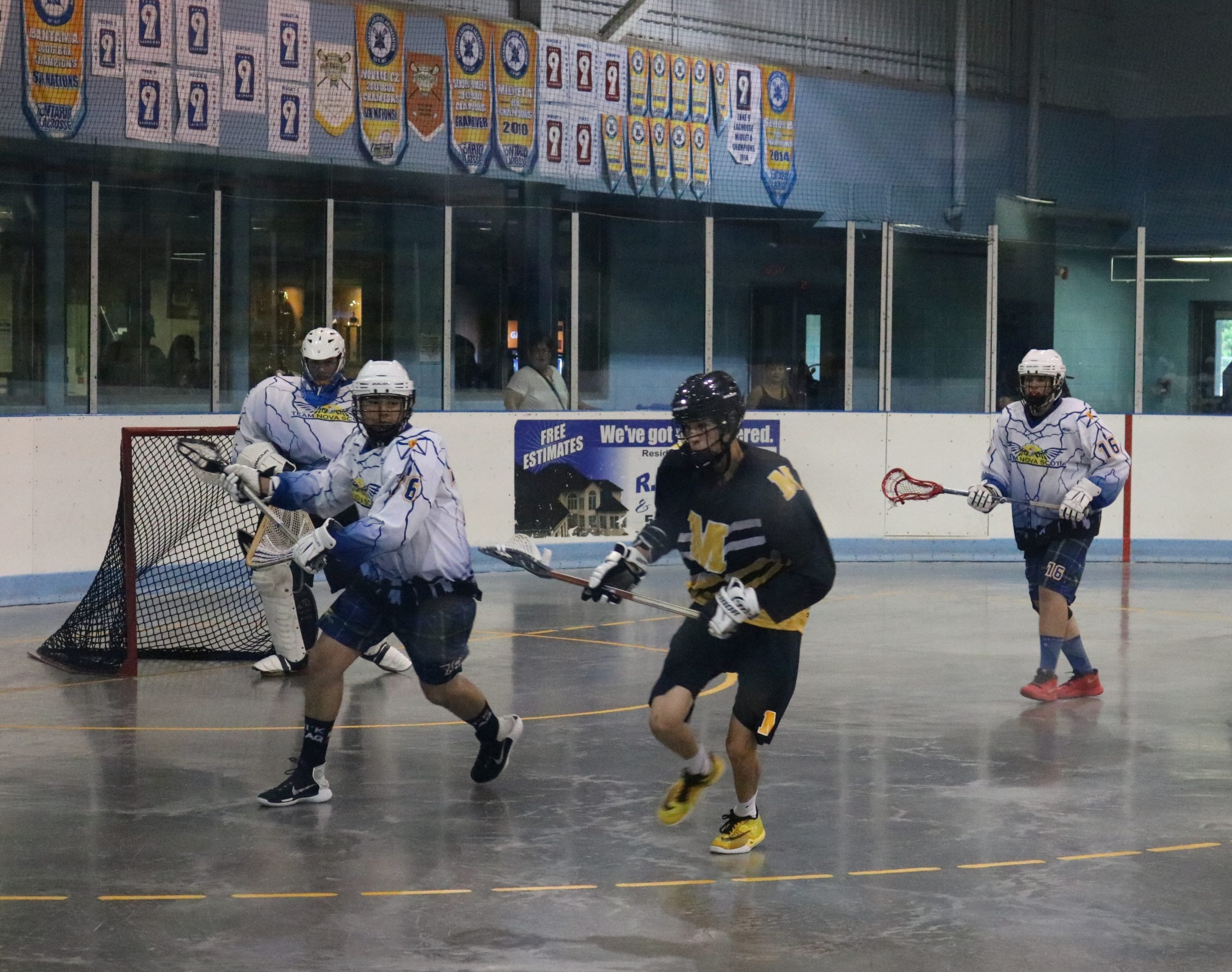
Some insight into this question can be obtained from the current procedural rules of the SDRCC, with the caveat that these rules may be revised as the SDRCC begins providing arbitration services as the NIM. Currently, a decision of the SDRCC Safeguarding Tribunal can be appealed to the SDRCC Appeal Tribunal, but only as the decision pertains to a sanction and only if the appeal is brought by a party that was before the Safeguarding Tribunal.SDRCC, 2021 This means that a party who disagrees with the Safeguarding Tribunal’s finding on a violation of the UCCMS (i.e. that a violation occurred or did not occur) cannot bring an appeal to the Appeal Tribunal.
This narrow right of appeal to the SDRCC Appeal Tribunal may have implications for complainants. As was discussed in Section 1 of Chapter 9, under current SDRCC rules, only certain parties may request an arbitration hearing before the Safeguarding Tribunal. Complainants may request an arbitration hearing to challenge an original decision-maker’s finding about a code of conduct violation, but they cannot request an arbitration hearing to challenge a sanction imposed in an original decision.SDRCC, 2021 As a result, if at the Safeguarding Tribunal, a complainant is successful in showing that a violation of the code of conduct occurred and that leads to the issuance of a sanction by the arbitrator, but that sanction does not satisfy the complainant, the complainant may not be able to appeal the arbitrator’s decision to the Appeal Tribunal, as the complainant did not have a right to challenge a sanction by arbitration in the first place. While this potential limitation on the appeal rights of a complainant may be consistent with the right of a complainant to request an arbitration hearing before the Safeguarding Tribunal, it raises the same questions about fairness and access to justice discussed in Section 1 “Rights to Request Arbitration”of Chapter 9.”
Other structural and procedural aspects of an appeal of a Safeguarding Tribunal decision to the Appeal Tribunal include the following:
The second pathway to challenge an arbitration decision involves an appeal to a provincial or territorial superior court (see Figure 8.3 in Chapter 8 for the organizational hierarchy of courts in Canada). Such appeals are governed by provincial/territorial arbitration legislation.
Arbitration decisions issued by the SDRCC are governed by Ontario law. As a result, any rights to appeal an SDRCC arbitration decision to the Ontario Superior Court of Justice are dealt with under Ontario’s Arbitration Act, 1991. The Arbitration Act, 1991 provides various appeal rights depending on whether the appeal involves a question of law, a question of fact or a question of mixed fact and law.
The “In Practice: Step into the Shoes of an Arbitrator” in Chapter 9 provides an overview of what is considered a question of law, question of fact, and a question of mixed fact and law. As a refresher, a question of law is purely legal question, such as how a particular statute or regulation should be interpreted. In contrast, a question of fact is a question about whether a particular fact occurred. Finally, a question of mixed fact and law falls somewhere in the middle as it involves factual and legal elements. For example, assessing how a rule in a statute or regulation applies to a set of facts is a question of mixed fact and law. As another example, the interpretation of a contract is a question of mixed fact and law as it involves interpreting a legal document (a legal question) based on what the parties intended to agree upon (a factual question).Sattva Capital Corp. v. Creston Molly Corp., 2014
As discussed in Chapter 6, the UCCMS will be implemented through contracts between sport organizations and participants. As a result, it is likely that a question about how to interpret the UCCMS will be considered a question of mixed fact and law, as opposed to a question of law. This is so, despite the fact that some scholars and arbitrators have described sport rules, such as codes of conduct, as quasi-legislative in nature (see Section 5“Substantive Principles of Law for Interpreting the UCCMS” in Chapter 9). This distinction between a question of law and a question of mixed fact and law becomes important when we consider what appeal rights exist under Ontario’s Arbitration Act, 1991.
Section 45 of the Arbitration Act, 1991 provides the following rules for appeals of arbitration decisions:
With respect to appeals on questions of law, a court will only grant permission to hear the appeal if it is satisfied that the matters at stake in the arbitration are sufficiently important to the parties to justify an appeal and determining the question of law will significantly impact the rights of the parties (Arbitration Act, 1991). An example of a question of law that meets this threshold could involve an interpretation of a rule in a statute or regulation that will impact subsequent findings about whether an individual violated that rule and will be subject to a penalty.
The SDRCC’s procedural rules are inconsistent on the issue of appeal rights. The rules for the Ordinary Tribunal specify that its decisions are final and binding on the parties, and that there is no right of appeal on questions of law, questions of fact, or questions of mixed fact and law.SDRCC, 2021 However, for decisions of the Safeguarding Tribunal that cannot be appealed to the SDRCC Appeal Tribunal and decisions of the Appeal Tribunal, the SDRCC rules state that the decisions are only final and binding on the parties. While this language means that there is no agreement to appeal an arbitration decision on a question of fact or a question of mixed fact and law, it does not explicitly exclude appeals on questions of law.
Courts have interpreted the phrase “final and binding” as not excluding rights of appeal on questions of law.Piazza Family Trust v. Veillette, 2011 As a result, it is likely that a court would conclude that an arbitration agreement that incorporates SDRCC procedural rules does not exclude appeals of Safeguarding or Appeal Tribunal decisions on questions of law. However, it is unlikely that many sport arbitration decisions of the Safeguarding or Appeal Tribunal would be appealable on questions of law. As mentioned above, sport rules are considered contractual in nature, and the interpretation of those contracts involves a question of mixed fact and law, not a pure question of law. Accordingly, to the extent that a Safeguarding or Appeal Tribunal decision is limited to interpreting a sport rule and applying it to a set of facts, it does not raise a question of law that could be appealed under arbitration legislation. That said, there may be rare cases where a sport arbitrator does consider a pure question of law that would be appealable to a court under arbitration legislation, unless the arbitration agreement specifically excluded appeals on questions of law (see the Case Study below for one such example).
 Case Study:
Case Study: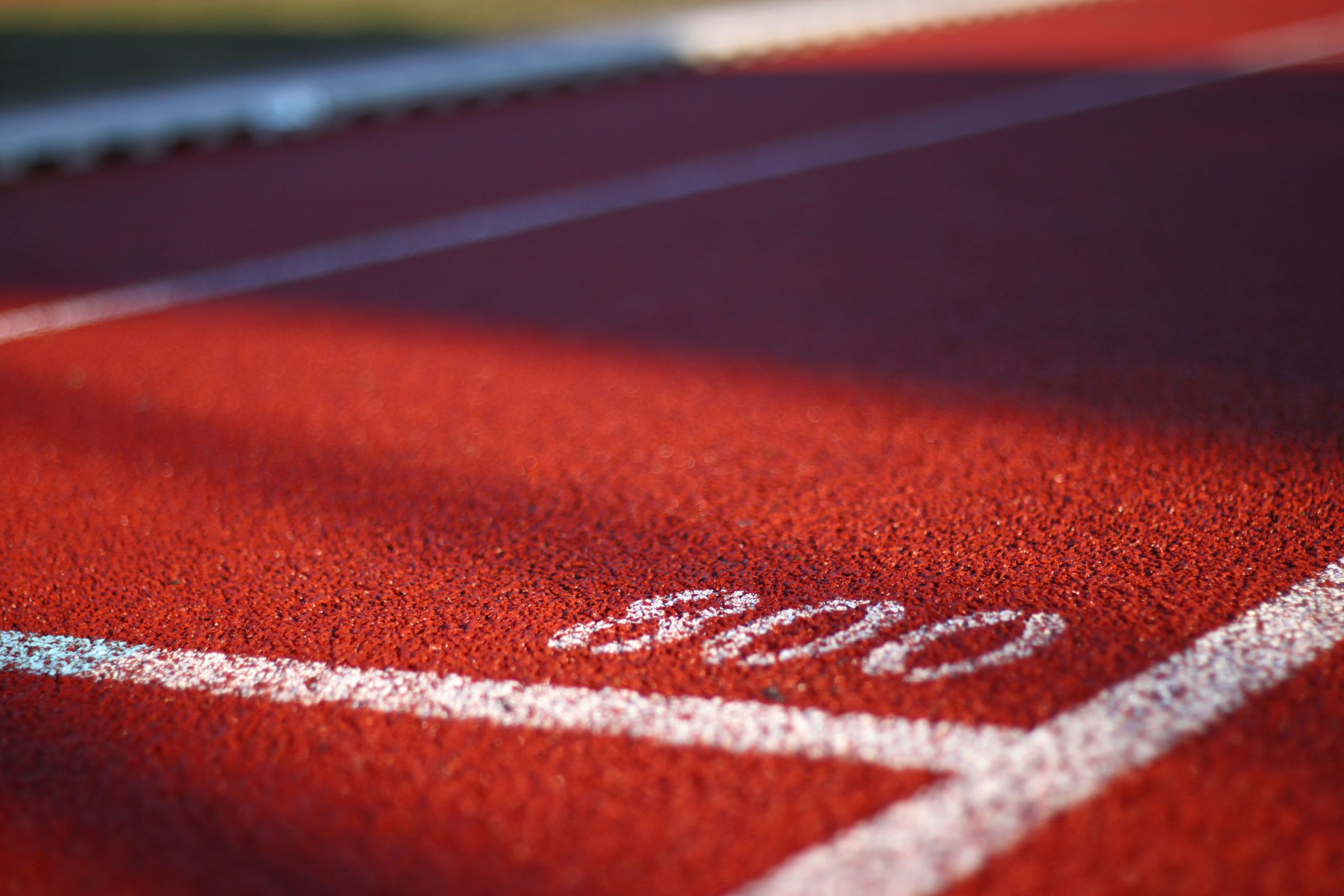
“Malicious Drugging and the Contaminated Catheter: Adams v Canadian Centre For Ethics in Sport” by Paul White, Sports Law eJournal, 2008.
Jeffrey Adams is a Canadian Paralympic athlete who competed at the international level in several wheelchair athletic events. As an international level athlete, Adams was subject to frequent doping control tests under the Canadian Anti-Doping Program (CADP). Adams was accused of an anti-doping rule violation and challenged the violation by arbitration at the SDRCC.
Adams alleged that the violation was due to a non-sterile catheter that he supplied for his doping control test, and that the CADP rules governing testing process were discriminatory against athletes with a disability as they did not require the Canadian Centre for Ethics in Sport (CCES) to supply athletes with a disability with a sterile catheter when providing a urine sample. Adams argued that this discrimination violated the Canadian Charter of Rights and Freedoms (Charter), the Canadian Human Rights Act and Ontario’s Human Rights Code. The SDRCC Doping Tribunal found that neither the Charter nor the Canadian Human Rights Act applied to the CADP, and that the Ontario Human Rights Code, while applicable to the CADP, had not been violated. The Doping Tribunal also imposed a two-year ban for the doping violation.
Adams appealed the Doping Tribunal’s decision to CAS, in accordance with the CADP rules. CAS partially upheld Adams’ appeal by eliminating his period of ineligibility (as the violation was not due to his fault or negligence); however, CAS did not overturn the SDRCC Doping Tribunal’s findings regarding discrimination.
Subsequently, Adams attempted to bring an application for judicial review in an Ontario court to challenge the CAS decision. The Ontario court dismissed Adams’ application on the basis that arbitration decisions are not subject to judicial review and can only be challenged in accordance with the Arbitration Act, 1991. The court noted that appealing the CAS decision on a question of law under the Arbitration Act, 1991 was an option available to Adams. The question of law in this case involved the interpretation of the Charter and human rights legislation.
The final pathway to challenge an arbitration decision involves bringing a court application under provincial/territorial arbitration legislation to have a court set aside the decision for violating certain minimum standards set out in the legislation. The standards relate to the validity of the parties’ arbitration agreement and the fairness of the arbitration process. The rationale for this pathway is that parties cannot contract out of the court’s supervisory jurisdiction when they agree to resolve a dispute by arbitration. Courts have a responsibility to ensure that the arbitration process is fair and just for both parties.
In the case of SDRCC arbitration decisions, section 46 of the Ontario Arbitration Act, 1991 provides the Ontario Superior Court of Justice with the power to set aside an arbitration decision on several grounds. Table 10.1 below sets out these grounds and examples of when they might apply.
| Ground | Example |
|---|---|
| A party to arbitration agreement did not have legal capacity | A respondent did not have the mental capacity to enter into the arbitration agreement due to a cognitive disability. |
| The arbitration agreement is invalid | The arbitration agreement was signed by a party under duress, such as a threat of harm. |
| The arbitration decision deals with a dispute or covers a matter that is beyond the scope of the arbitration agreement | An arbitrator upholds a sanction against an athlete/respondent that involves a suspension from a team and selects another athlete to replace the respondent on the team. |
| The arbitration panel was improperly established | The arbitrator does not meet the qualifications set out in the arbitration agreement, such as a particular expertise or training in the subject-matter. |
| The subject-matter of the dispute is not capable of being subject to arbitration under Ontario law | Criminal matters, such as whether a respondent should be charged or convicted of a criminal offence. |
| Arbitration procedures did not comply with arbitration legislation | A procedurally unfair arbitration hearing where the arbitrator does not allow both parties to be heard. |
| Arbitrator committed fraud or was corrupt or there is a reasonable apprehension of bias | The arbitrator had a personal or financial relationship with one of the parties that resulted in the arbitrator treating one party more favourably than another or deciding the dispute in a pre-determined way to receive a benefit. |
| Arbitration award obtained by fraud | A party intentionally gives false evidence that shapes the outcome of the arbitration decision. |
Once a sanction is issued under the UCCMS and all attempts to challenge the sanction by arbitration or in court have been exhausted or waived, the final stage of the process is to enforce the sanction.
The effective enforcement of disciplinary sanctions is dependent on two factors:
(a) transparency or knowability of the sanction; and
(b) having obligations to enforce the sanction.
The final section of this chapter discusses both of these key issues.
The transparency of a sanction serves several enforcement purposes.
First, knowledge of the sanction by someone other than the sanctioned individual may be necessary to implement aspects of the sanction. For example, if a coach is suspended from a national team, then the organizers of that team may need to take steps to remove the coach’s accreditations to take part in national team activities, such as training camps and international competitions.
Second, knowledge of a sanction is important to ensure that a system is in place to monitor and report on the sanctioned individual’s compliance with the sanction. A sanction that is not monitored for compliance is not effective and may undermine the purposes of the sanction.
Third, where a sanction is imposed due to concerns about an individual’s ability to participate in an activity without causing harm or increasing risk to other participants, then it is important for participants to be aware of the sanction to protect their interests.
Fourth, the knowability of a sanction advances the principles of denunciation and deterrence. Denunciation is a public disapproval of something or someone. While a code of conduct represents a public condemnation of certain behaviour, the public reporting of sanctions against an individual under that code of conduct further expresses a public disapproval of that behaviour and the particular individual’s actions. Deterrence is the act of discouraging undesired behaviour by instilling fear of punishment. The public reporting of a sanction acts as a deterrent for the general public as it serves as an example of the consequences that arise from certain behaviour. Figure 10.2 below illustrates how the above considerations apply in the sport maltreatment context.
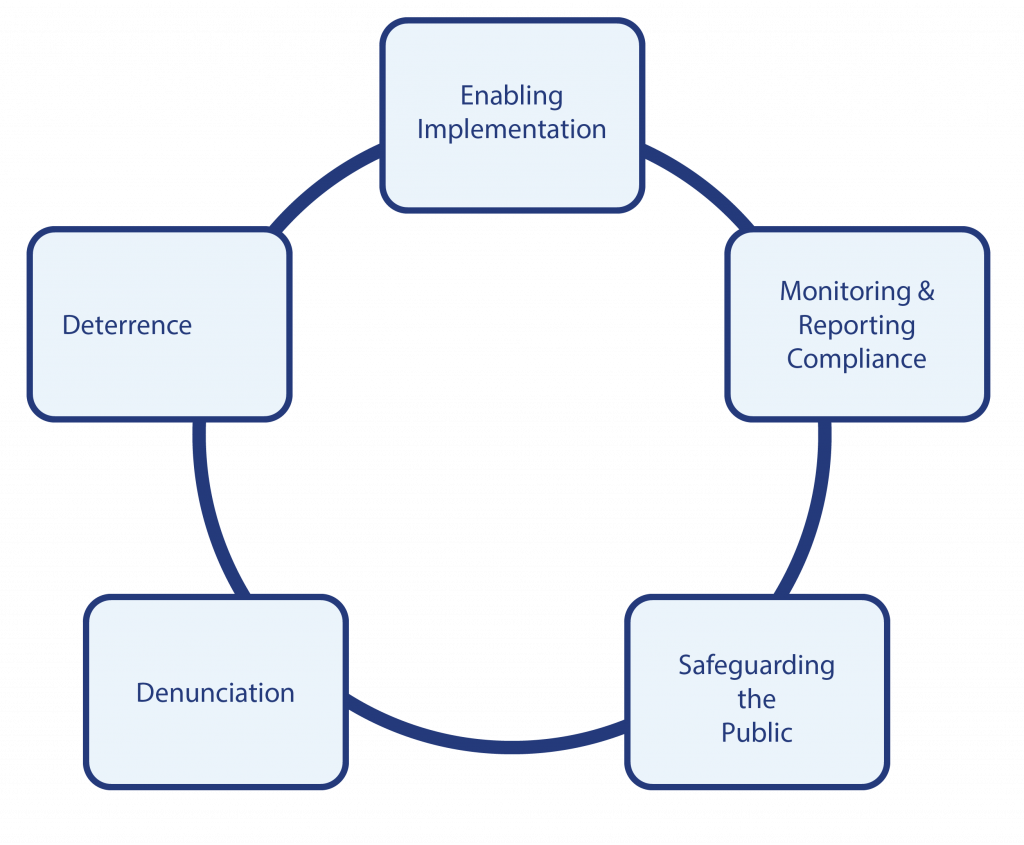
The transparency of a sanction is closely related to the confidentiality of an arbitration process described in Section 6 of Chapter 9. However, as discussed in that section, publicizing or disclosing aspects of the arbitration process (such as an arbitration decision) involves a balancing of the purpose of the disclosure against the rights and interests of those impacted by the disclosure, such as the privacy interests of a respondent.
Based on the objectives set out in Figure 10.2 above, do you believe that sanctions issued under the UCCMS should be publicly disclosed? If yes, what level of information should be disclosed?
In the U.S., the Center for SafeSport has a centralized database that includes the following information about sanctions:
The UCCMS describes a similar centralized database for reporting sanctions issued under the UCCMS. While the details of such a database are not yet known, the UCCMS specifies that the objective of the database is to track sanctions so that sport participants know who has breached the UCCMS and who is ineligible to participate in sport.
The disclosure of identifying information about respondents who are sanctioned under the UCCMS raises an important legal consideration – namely, are there any privacy laws that restrict the public disclosure of identifying information about respondents sanctioned under the UCCMS and, if not, should there be?
In the case of the U.S. SafeSport model, this question is addressed by specific legislative authority for the centralized database. Section 220541(a)(1)(G) of chapter 36 of the United States Code authorizes the Center to “publish and maintain a publicly accessible internet website that contains a comprehensive list of adults who are barred by the Center.”
In Canada, there is no specific legislative authority for a database of individuals sanctioned under the UCCMS for the reasons discussed in Chapter 6 regarding Canada’s federal structure and the division of powers amongst federal, provincial, and territorial governments to enact laws. However, there also appears to be no legislative barrier to creating such a database at this time. Canadian privacy laws are comprised of various federal and provincial/territorial statutes. For example, Ontario has a Freedom of Information and Protection of Privacy Act (FIPPA) that governs the collection, use, and disclosure of personal information by the government and hospitals (known as “institutions”), as well as an individual’s right to access records held by these institutions. Ontario also has a Personal Health Information Protection Act, 2004 (PHIPA) that regulates the collection, use, and disclosure of personal health information by health care providers, medical officers of health, and the Ontario Ministry of Health. Neither of these statutes would regulate the publication of UCCMS sanctions by the NIM, as the NIM is not an institution within the meaning of FIPPA and would not be disclosing personal health information.
At the federal level, there are two privacy law statutes – the Privacy Act and the Personal Information Protection and Electronic Documents Act (PIPEDA). The Privacy Act regulates the federal government’s handing of personal information and is not applicable to the NIM/SDRCC as the SDRCC is not part of the federal government as noted in Table 8.1 in Chapter 8.
PIPEDA applies to the personal information that a federally regulated organization collects, uses, or discloses about its employees (or an applicant seeking employment with the organization). A federally regulated organization includes airports, banks, inter-provincial or international transportation companies, telecommunications companies, as well as a work, undertaking or business outside the exclusive legislative authority of the legislatures of the provinces.PIPEDA, 2000 The SDRCC is considered a federally regulated organization as it is created under federal legislation (the Physical Activity and Sport Act) and its mission to provide a national alternative dispute resolution service for sport disputes is outside the legislative authority of provinces. However, the SDRCC/NIM’s publication of sanctions under the UCCMS would not involve the personal information of employees of the SDRCC; it would involve the personal information of respondents. As a result, the publication would not be regulated under this aspect of PIPEDA.
PIPEDA also applies to any private organization that collects, uses, or discloses personal information in connection with a commercial activity. “Commercial activity” means an act that is of a commercial character.PIPEDA, 2000 It seems unlikely that the NIM/SDRCC’s disclosure of information about sanctions issued under the UCCMS would be considered “in connection with a commercial activity”. The purpose of the disclosure is to address and prevent maltreatment in sport and does not have a commercial character.
A similar interpretation of PIPEDA was taken in relation to the collection, use, and disclosure of personal information by WADA for its interprovincial and international anti-doping activities. WADA’s headquarters are in Montreal, Quebec, and its handling of personal information within the province is subject to Quebec’s private sector privacy legislation. However, WADA’s use of personal information for interprovincial and international anti-doping activities is not regulated under the Quebec legislation, and, up until 2015, was not regulated under PIPEDA. PIPEDA did not apply to WADA as it is not a federally regulated organization and is not engaged in commercial activities.
This gap in the application of Canadian privacy laws concerned some European Union countries as sensitive personal information about their athletes was being collected, used, and disclosed by WADA’s headquarters in Montreal. To address these concerns, the federal government amended PIPEDA in 2015 to extend its application to the personal information collected, used, and disclosed by WADA’s headquarters for interprovincial and international anti-doping activities.WADA’s use of personal information for anti-doping activities in Quebec remains subject to Quebec’s private sector privacy legislation. The amendment to PIPEDA was significant as it set a precedent to broaden the application of the legislation to include an organization that is not a federally regulated organization or otherwise engaged in commercial activities.Privacy Commissioner of Canada, 2015
The timing of the amendments to PIPEDA to include WADA in 2015 was auspicious as a year later, WADA was the victim of a significant privacy breach by the hackers known as “Fancy Bear” who accessed the personal information of thousands of athletes and posted the information on its website. The personal information included confidential and sensitive medical information about athletes who had therapeutic exemptions to use prohibited substances under anti-doping rules. Because WADA was subject to PIPEDA at the time of the privacy breach, the Privacy Commissioner of Canada had jurisdiction to investigate the breach and enter into a compliance agreement with WADA to implement certain remedial measures identified during the investigation.
The lesson from WADA’s privacy breach is it is important from an accountability perspective to have laws that protect the personal information collected, used, and disclosed by organizations. While an organization that is not subject to privacy legislation can have robust internal policies and controls to safeguard personal information from improper use and access, the reality is that privacy breaches can happen and, if they do, it is preferable to have a legislative framework in place to ensure accountability for the breach and the remedial steps required to contain the breach and prevent similar breaches in the future.
PIPEDA imposes the following ten fair information principles for organizations subject to the legislation as outlined in Figure 10.3.
An interactive H5P element has been excluded from this version of the text. You can view it online here:
https://ecampusontario.pressbooks.pub/safesport/?p=212#h5p-28
Should the NIM’s collection, use and disclosure of personal information in relation to administering the UCCMS be subject to the requirements of PIPEDA? The publication of sanctions imposed under the UCCMS is only one component of the NIM’s responsibilities. In overseeing the implementation of the UCCMS in Canada, the NIM will collect, use, and disclose significant amounts of sensitive personal information about complainants, witnesses, and respondents due to NIM’s multiple roles as an overseer, investigator, and adjudicator. The above analysis about the application of PIPEDA to the NIM only relates to the publication of sanctions.
Consideration should be given as to whether NIM is subject to PIPEDA in respect of its collection, use, and disclosure of personal information for activities other than the publication of sanctions. If it is not, then it is recommended that PIPEDA be amended to capture all of the NIM’s activities involving the handling of personal information. If PIPEDA’s requirements and principles apply to the NIM, then the NIM will need to ensure that it has a respondent’s consent before publicly disclosing information about their UCCMS sanction. This consent should be obtained prior to any investigation or arbitration hearing regarding a violation of the UCCMS to avoid a scenario where a respondent declines to grant consent at a time when they are at risk to receive a sanction. Ideally, the contractual process used to make the respondent subject to the UCCMS as a condition of participating in a sport should be leveraged to include a consent to any future publication of a sanction issued under the UCCMS.
The second key aspect of the effective enforcement of sanctions is ensuring that they are respected by the respondent, sport organizations and participants in the sport system. As McLaren Global Sport Solutions (2020) noted in its study of independent approaches to administer the UCCMS, “the enforcement of issued sanctions will be, for all intents and purposes, a team effort for it to be effective across the sport sector”.McLaren Global Sport Solutions, 2020, p. 53 This principle may seem simplistic, but from a legal perspective it requires a consideration of who should have an obligation to respect the sanction and where that obligation comes from. The UCCMS sets out rules for the imposition of sanctions against a respondent who has engaged in maltreatment. However, the rules do not describe how the sanction would be enforced from the perspective of the respondent or sport organizations.
With respect to the respondent’s legal obligation to comply with the sanction, this obligation may arise from two sources. First, if the respondent is a party to a contact with a sport organization, then that contract may include a provision that requires compliance with the UCCMS, including any sanction issued under the UCCMS. If the respondent fails to comply with the sanction in accordance with the contract, then they could be sued for breach of contract. However, in the case of a temporary suspension or permanent eligibility, these sanctions may result in the termination of the respondent’s contract with the sport organization. Once the contract is terminated, any obligation to comply with the UCCMS ends, unless the parties agreed that the obligation survives the termination of the contract.
A second potential source of a respondent’s obligation to comply with a sanction is a court order. If the sanction is imposed on the respondent following an arbitration hearing, then a provincial or territorial superior court can issue an order enforcing the arbitration decision. For example, section 50 of Ontario’s Arbitration Act, 1991 provides that a person who is entitled to enforcement of an award made in Ontario or elsewhere in Canada may make an application to the court for an order to that effect. If such a court order is issued, and a respondent refuses to comply, then they can be held in contempt of court and charged with a criminal offence under section 127 of the Criminal Code.
While the above obligations that can be imposed on a respondent are helpful, they are unlikely to be the primary tool used to ensure compliance with a sanction. The true effectiveness of a sanction is dependent on the ability of others in the sport system to respect it. For example, if a respondent is suspended from participating in all coaching activities in a particular sport, then all organizations and participants within that sport have a moral responsibility to implement the sanction by refusing to engage with the respondent in a coaching capacity during the length of the suspension. Depending on the organization or participant, fulfilling this responsibility may involve terminating an employment, service, or lease agreement with the respondent, or ending a coaching relationship with the respondent.
Ideally, organizations and participants will carry out this responsibility to follow sanctions through their shared commitment to prevent and address maltreatment in sport. However, for some, the desire to succeed in sport may trump this responsibility and lead to instances where an organization or participant wants to continue having a business or professional relationship with a respondent, even though such a relationship will result in the respondent violating a sanction imposed under the UCCMS (see the Case Study below). As a result, it becomes necessary to consider how a moral responsibility to uphold UCCMS sanctions can be supplemented by legal obligations.
The anti-doping movement is a helpful comparator when considering the responsibilities of levels of the sport sector. Article 10.14.1 of the World Anti-Doping Code (2021a) provides that, when an athlete or other person is subject to a period of ineligibility, they cannot participate in any capacity in a competition or activity (other than anti-doping education or rehabilitation programs) authorized or organized by any signatory of the World Anti-Doping Code, any member of a signatory, or any club or other member organization of a signatory’s member organization, or in competitions authorized by any professional league or any international- or national-level event organization or any elite or national-level sporting activity funded by a governmental agency. This rule captures virtually every aspect of the sport system. Compliance with sanctions by the sport sector is also achieved through article 15 of the World Anti-Doping Code and the International Standard for Code Compliance by Signatories, which require signatories to enforce anti-doping sanctions and report on this enforcement, along with other compliance requirements.WADA, 2021a; WADA, 2021b Once the obligation to enforce the sanction is imposed on the signatory of the World Anti-Doping Code (e.g. CCES, Canadian Olympic Committee, Canadian Paralympic Committee), it becomes the signatory’s responsibility to ensure that this obligation is also met by any organizations that are members of or affiliated with the signatory. This trickle-down effect allows for anti-doping sanctions to be enforced at almost all levels of the sport system. However, as seen in the Case Study here, enforcement of a sanction can still be difficult and requires the collective action of all participants.
Returning to the sport maltreatment context, in the U.S., the requirement for sport organizations to comply with sanctions issued by the U.S. Center for SafeSport arises from legislation. In accordance with section 220505(d)(1)(C) of Chapter 36 of the United States Code (2021), the U.S. Olympic and Paralympic Committee, national sport governing bodies and local affiliated organizations are responsible for enforcing eligibility determinations and sanctions imposed by the Center for SafeSport. Such legislation does not exist in Canada. However, the obligation to comply with UCCMS sanctions could be imposed on organizations and participants using the contractual framework discussed in Chapter 6. This contractual framework (see Figure 10.4) could be similar to that used in the anti-doping movement and can be described using a top-down approach, as follows:
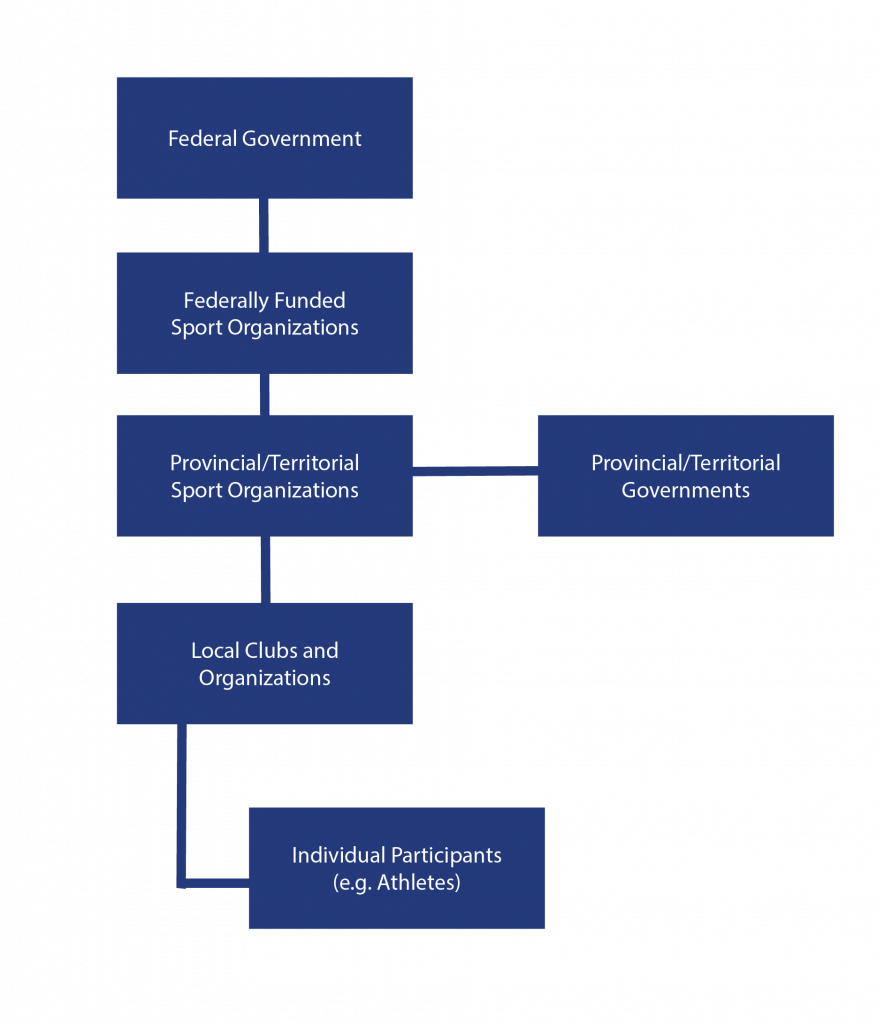
A final consideration is what obligations can be imposed on governments that publicly fund sport organizations to ensure the enforcement of sanctions imposed under the UCCMS. For many years, federally funded sport organization have been required to have policies to deal with incidents of harassment and abuse, to have arm’s length trained harassment officers, and to report to Sport Canada annually on their compliance with these requirements.Donnelly & Kerr, 2018 However, as discovered in a 2016 study, many sport organizations have encountered difficulties in implementing these requirements and the requirements are not being enforced by the federal government under funding agreementsDonnelly et al., 2016 (challenges such as these were further addressed in Chapter 4 ). As the implementation of the UCCMS is now a requirement for federally funded sport organizations under funding agreements with Sport Canada, there is a fresh opportunity for Sport Canada to ensure that sport organizations comply with this requirement to implement the UCCMS, which includes the enforcement of sanctions issued under the UCCMS.
However, based on the federal government’s history in enforcing funding requirements, there is reason to be skeptical of their ability or willingness to enforce. As a result, it is necessary to consider what mechanisms exist to improve the federal government’s accountability to enforce the funding conditions.
Alternate options to enforce sanctions imposed under the UCCMS through publicly funded sport organizations include:
These options would also be available a the provincial, territorial, and local levels of sport, should the UCCMS be implemented at these levels.
Further Research
The final part of this chapter examined how legal obligations to enforce sanctions can be imposed primarily within the sport system through a web of contracts between organizations and participants. What mechanisms external to the sport system could be used to ensure the enforcement of sanctions under the UCCMS? For example, could insurance providers make it a best practice for sport organizations to comply with the UCCMS through their insurance contracts?
Key Terms
An interactive H5P element has been excluded from this version of the text. You can view it online here:
https://ecampusontario.pressbooks.pub/safesport/?p=212#h5p-29
Suggested Assignments
Image Descriptions
Figure 10.1 This figure demonstrates the pathways for challenging a sport maltreatment arbitration decision. First is the appeal to another arbitrator, where the arbitration decision is appealed to another arbitration panel. Next comes the appeal to court, where the arbitration decision is appealed externally to a court on specific questions. Lastly is the court application, where the application is made in court to set aside the arbitration decision for violating certain minimum guarantees. [return to text]
Figure 10.2 This figure demonstrates the objectives of publicly reporting sanctions in the sport maltreatment context. There are five elements in this continuous circle including enabling implementation, monitoring & reporting compliance, safeguarding the public, denunciation, and deterrence. [return to text]
Figure 10.3 This figure demonstrates the ten Personal Information Protection and Electronic Documents Act (PIPEDA) principles. Accountability – An organization is responsible for personal information in its possession or control and must assign someone to be responsible for ensuring compliance with PIPEDA and its principles. Identifying purposes – An organization must identify the purpose for any collection, use, or disclosure of personal information it carries out. Consent – An organization must obtain the informed consent of an individual in order to collect, use, or disclose their personal information, unless an exception applies. Limiting collection – An organization cannot collect more personal information than is necessary to meet the purpose of the collection. Limiting use, disclosure and retention – An organization can only use and disclose personal information for the purpose for which it was collected, unless the individual consents to the use or disclosure for a different purpose. An organization must also only retain personal information for as long as required to meet the purpose of a collection, use or disclosure. Accuracy – An organization must ensure that the personal information in its possession or control is accurate, complete, and up-to-date. Safeguards – An organization must secure personal information using measures that are proportional to the sensitivity of the information. Openness – An organization must be transparent about its policies and practices for handling personal information. Individual access – An organization must respect an individual’s right to be informed about the existence, use and disclosure of their personal information, their right to access their personal information, and their right to correct errors in their personal information. Challenging compliance – An organization can be the subject of an individual’s complaint about non-compliance with PIPEDA. [return to text]
Figure 10.4. This diagram demonstrates contractual relationships in sport to enforce sanctions. At the top of the branching scenario is the federal government, beneath that are federally funded sport organizations, and beneath that are provincial/territorial sport organizations (PTSOs), of which provincial/ territorial governments are a branch. Local clubs and organizations are one level below PTSOs, and individual participants (e.g. Athletes) are listed as the very last branch. [return to text]
Sources
Adams v. Canada and Canadian Centre for Ethics in Sport (2011), 2011 ONSC 325
Arbitration Act, 1991, Ontario, Canada.
Canadian Anti-Doping Program (CADP). (2021). Canadian anti-doping program: Part C – Canadian anti-doping program rules. https://cces.ca/sites/default/files/content/docs/pdf/2021-cces-policy-cadp-2021-final-draft-e.pdf
Canadian Safe Sport Program. (2020). Sport Information Resource Centre: Universal Code of Conduct to Prevent and Address Maltreatment in Sport (UCCMS), (5)1, 1-16. https://sirc.ca/wp-content/uploads/2020/01/UCCMS-v5.1-FINAL-Eng.pdf
Criminal Code, C, s 127.
Designation of United States Center for SafeSport, 36 USC 220541 (2021).
Donnelly, P., & Kerr, G. (2018). Revising Canada’s policies on harassment and abuse in sport: A position paper and recommendations. Centre for Sport Policy Studies Positions Paper. https://kpe.utoronto.ca/sites/default/files/harassment_and_abuse_in_sport_csps_position_paper_3.pdf
Donnelly, P., Kerr, G., Heron, A., & DiCarlo, D. (2016). Protecting youth in sport: An examination of harassment policies. International Journal of Sport Policy and Politics, 8(1), 33–50. https://doi.org/10.1080/19406940.2014.958180
Freedom of Information and Protection of Privacy Act, R.S.O. 1990, c. F.31. Retrieved December 9, 2021, from https://www.ontario.ca/laws/statute/90f31
Government of Canada. (2021, November 15). Office of the taxpayers’ Ombudsperson. Retrieved December 8, 2021, from https://www.canada.ca/en/taxpayers-ombudsperson.html
McLaren Global Sports Solutions. (2020). Aim High: Independent approaches to administer the Universal Code of Conduct to Prevent and Address Maltreatment in Sport in Canada, final report. https://sirc.ca/wp-content/uploads/2020/12/MGSS-Report-on-Independent-Approaches-December-2020.pdf.
Office of the Auditor General of Canada. (n.d.). Retrieved December 8, 2021, from https://www.oag-bvg.gc.ca/internet/english/admin_e_41.html
Office of the Privacy Commissioner of Canada. (2015, June 1). Submission to the standing senate committee on national finance. Retrieved December 8, 2021, from https://www.priv.gc.ca/en/opc-actions-and-decisions/advice-to-parliament/2015/parl_sub_150601/
Personal Health Information Protection Act, S.O. 2004. c. 3. Retrieved December 9, 2021, from https://www.ontario.ca/laws/statute/04p03
Personal Information Protection and Electronic Documents Act, S.C. 2000. c. 5. https://laws-lois.justice.gc.ca/PDF/P-8.6.pdf
Piazza Family Trust v. Veillette (2011), ONSC, [2011] O.J. No. 2094
Privacy Act, R.S.C. 1985. c. P-21. https://laws-lois.justice.gc.ca/PDF/P-21.pdf
Sattva Capital Corp. v. Creston Moly Corp. (2014), SCC, [2014] S.C.J. No. 53
Sport Dispute Resolution Centre of Canada (SDRCC). (2021). Canadian sport dispute resolution code. http://www.crdsc-sdrcc.ca/eng/documents/Code_SDRCC_2021_-_Final_EN.pdf
Sport Resolutions. (2021). 2021 procedural rules of the national safeguarding panel. https://www.sportresolutions.com/images/uploads/files/2021_NSP_Procedural_Rules_-_23.07.2021.pdf
Starkman, R. (2007, June 22). Lifetime swim ban sinks like a rock. Toronto Star. Retrieved December 8, 2021, from https://www.thestar.com/sports/olympics/2007/06/22/lifetime_swim_ban_sinks_like_a_rock.html?rf
U. S. Center for SafeSport. (n.d.). SafeSport code. Retrieved December 5, 2021, from https://uscenterforsafesport.org/response-and-resolution/safesport-code/
World Anti-Doping Agency (WADA). (2021a). World anti-doping code 2021. https://www.wada-ama.org/sites/default/files/resources/files/2021_wada_code.pdf
WADA. (2021b). International standard for code compliance by signatories 2021. https://www.wada-ama.org/sites/default/files/resources/files/international_standard_isccs_2021.pdf
V
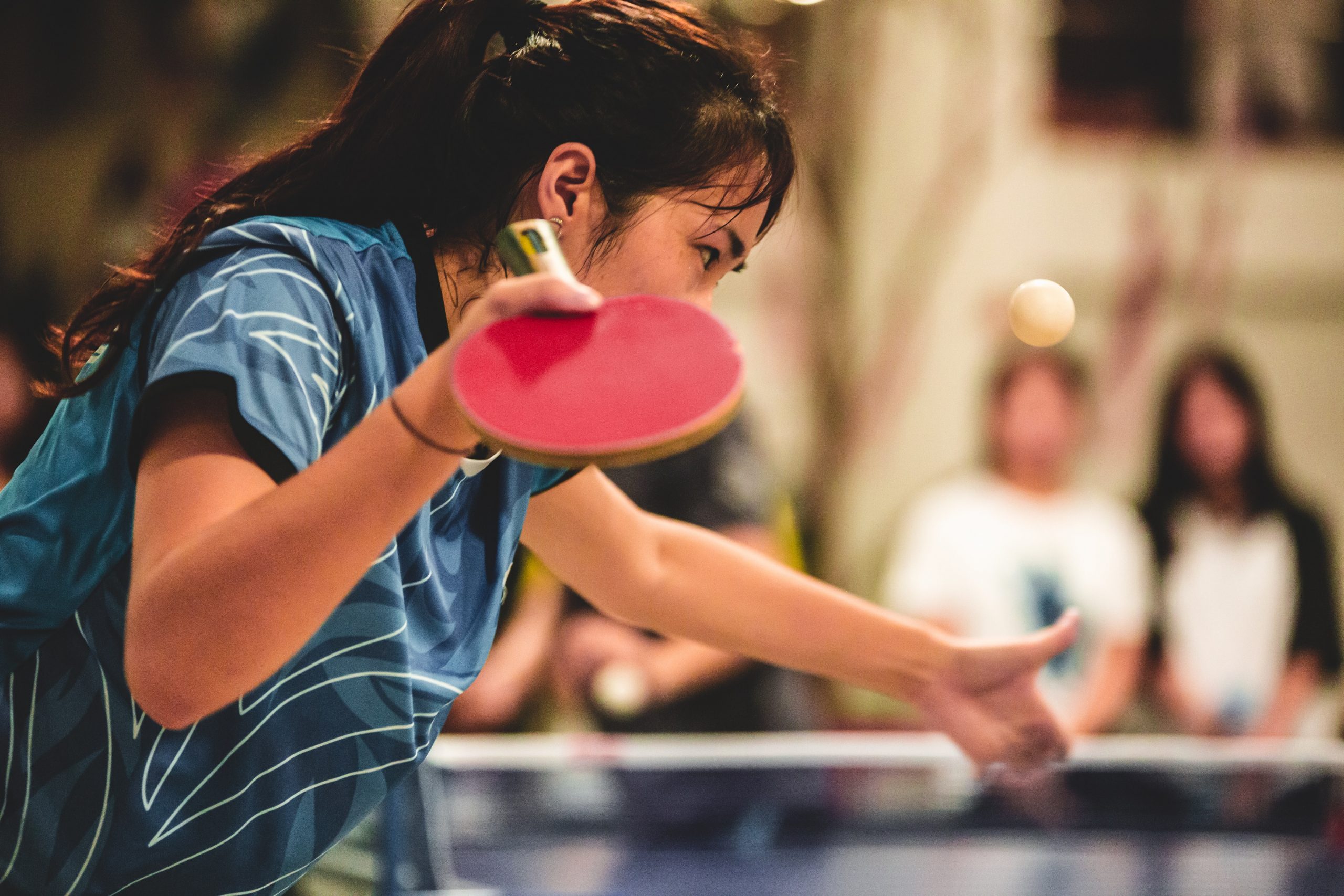
Another stakeholder in Canada’s sport system are sport organizations. This includes national sport organizations (NSOs), provincial/territorial sport organizations (P/TSOs), community sport organizations (CSOs), multi-sport organizations (MSOs) and other groups that coordinate and implement sporting activities nationwide. In Part 5, authors from two sport organizations provide unique insight on the safe sport movement and offer suggestions on how to move forward in this journey towards safe sport. Chapter 11 written by Canadian Centre for Ethics in Sport (CCES) representatives Kasey Liboiron and Karri Dawson explains the True Sport approach to values-based sport which aims to instill character in participants, strengthen the communities where sport is played, and increase opportunities for personal and podium excellence. This chapter argues that an intentional, fundamental change in culture is required across the sport system to ensure a safe sport experience for all. Similarly, Chapter 12 written by Ellen MacPherson, PhD, and Ian Moss on behalf of Gymnastics Canada provides an overview of the process of developing a Safe Sport Framework, discusses the implementation of safe sport initiative by the NSO, reviews the challenges Gymnastics Canada faced, and suggests critical areas of focus with resources to bolster students’ and industry professionals’ safe sport toolkits.
11
Kasey Liboiron
Karri Dawson
Values
Amateur Sport
Culture Change
When you have completed this chapter, you will be able to:
LO1 Recognize True Sport as an approach to fostering a positive sport culture;
LO2 Explain the benefits of a True Sport experience;
LO3 Describe how True Sport can support safe sport efforts; and
LO4 Recall the seven True Sport Principles.
In Canada, a fundamental change in culture is required across the sport system to minimize the threats to sport and ensure a safe sport experience for all. True Sport is an approach to values-based sport that is underpinned by seven principles: Go For It, Play Fair, Respect Others, Keep It Fun, Stay Healthy, Include Everyone and Give Back. A good sport experience, one that reflects the True Sport approach, can instill character in our children, strengthen the communities where it is played, and increase opportunities for personal and podium excellence. Good sport doesn’t happen by chance, it takes intentionality. Groups such as Sport Nova Scotia, Gymnastics Canada, BC Artistic Swimming and Field Hockey Canada are actioning True Sport as a holistic, preventative, and positive approach in their safe sport strategies. They also understand that the absence of harm isn’t good enough; learn more about their journeys to deliver the kind of sport Canadians want.
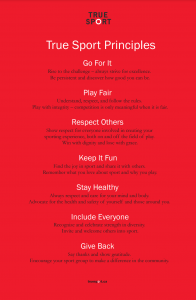
True Sport, an approach to values-based sport, is an initiative of the Canadian Centre for Ethics in Sport (CCES) and is designed to give people, communities, and organizations the means by which to leverage the many benefits of good sport from a platform of shared values and principles.True Sport, n.d.d.
To prevent unethical conduct in sport, all stakeholders must commit to contributing to a positive sport culture grounded in shared values. The True Sport values were identified by Canadians who believe that sport has the power to instill character in participants, strengthen the communities where it is played, and increase opportunities for personal and podium excellence, but who felt the sport system was falling short.Symposium, 2019. The True Sport values of fairness, excellence, inclusion, and fun are underpinned by the seven True Sport Principles:True Sport, n.d.c.
These principles are the foundation for positive and rewarding sport experiences and when incorporated consistently and intentionally, foster an environment for the benefits of good sport to become more fully realized within Canadian communities.
In 2001, at their conference in London Ontario, Canada’s Federal-Provincial/Territorial Ministers responsible for sport came together to discuss how to bring ethics and respectful conduct back into the way Canadians play and compete. They believed that damaging practices—cheating, bullying, violence, aggressive parental behaviour, and even doping—were beginning to undermine the positive impact of community sport in Canada. The first step they took in turning back this negative tide was the signing of what is now known as “The London Declaration”, an unprecedented affirmation of positive sporting values and principles.Government of Ontario, 2001.
In 2002, following this conference, the Canadian Centre for Ethics in Sport (CCES) undertook a nationwide survey to canvas public opinion on the same topics. The survey results confirmed the important role that sport plays in the lives of Canadians, as well as Canadians’ strong desire to uphold a model of sport that reflects and teaches positive values.Gymnastics Canada & True Sport, 2021.
In September of 2003, a diverse group of stakeholders including, leading sport officials, sport champions, parents and youth from across Canada were brought together through a symposium entitled “The Sport We Want.” Several strong messages emerged from this gathering. First, Canadians believe sport has the power to foster community engagement and teach young people important skills and principles. Second, Canadians believe sport could be doing more to fulfill its potential. Third, Canadians at many levels of sport—from parents and community coaches to Olympians and other elite competitors—were eager for a national values-based initiative that would engage communities and sport organizations across the country.Symposium, 2003.
In 2018, keys stakeholders from across Canada convened through a series of round table discussions and a culminating national symposium, “The Values Proposition: Building a Stronger Canada Through Values-based Sport”, to discuss the merits of more intentionally infusing values into the Canadian sport system.Symposium, 2019. The overwhelming take-away was that values-based sport experiences have an incredible ability to create positive change at the individual, community and national levels. As such, a key outcome of the symposium was a series of clear and coherent game plans designed to guide the integration of values-based sport across all sectors and levels of competition.Symposium, 2019. Activation of these game plans from grassroots to high-performance will serve to further reinforce the need outlined in the 2012 Canadian Sport Policy.


If you believe that good sport can make a great difference, you too can become a champion for True Sport. Whether you are an athlete, a coach, an official, a parent, a sport administrator, or have some other role in sport, there are True Sport resources, initiatives, and tools that can help you get started.
Step 1:
Join True Sport – add your name to the growing list of Canadians who are committed to doing their part to ensure sport maximizes the benefits for everyone who is involved. By publicly declaring your commitment to True Sport you are making a statement about the kind of sport you expect for yourself and others.
Step 2:
Start conversations with those you participate with, about why you come together to play, train, and compete and agree on what you want to strive for and how you can incorporate the True Sport Principles. Communicating your belief that creating a fair, safe, and open environment where good sport can flourish will bring out the best in people and communities.
Where you go from here will depend on your role in sport and your desire to influence others.
The CCES recognizes the difference that True Sport can make for individuals, communities, and our Nation. As such, the CCES is committed to working collaboratively with partners in the Canadian sport system in order to activate a values-based sport system, advocate for sport that is fair, safe, and open, and protect the integrity of sport.
As part of this mission, the CCES and the Coaching Association of Canada developed a partnership to launch the Responsible Coaching Movement (RCM).Canadian Centre for Ethics in Sport, 2002. The RCM is a call to action for sport organizations and coaches to maximize the positive benefits of sport through values-based coaching. The RCM is a Canada-wide initiative that is the result of ongoing consultations with the Canadian sport community.
In addition to providing athletes with sport-specific skills, coaches are also in a unique and privileged position of power. The RCM aims to protect athletes and coaches from unethical and illegal behaviour through the implementation of measures such as: the Rule of Two and background screening and ethics training.Coaching Association of Canada, n.d. The RCM recognizes the impact that coaching can have on athletes which is why the RCM seeks to have coaches consider how they coach, not just what they coach. Through this initiative, the difference between a safe sport environment and one that elicits positive growth and personal development can be achieved.
Following the introduction of the rule of two, background screening and ethics training, the next phase of the RCM focuses on identifying and addressing negative coaching behaviours, while moving toward positive coaching behaviours that can make sport a more welcoming and inclusive environment. Future RCM work will address parental behaviour, highlight transformational coaching, and offer additional tools and resources including a social media policy.CAC, n.d.
Video provided by True Sport. Used with permission. [Transcript]
The Canadian sport community has identified safe sport as a prevalent issue and is committed to addressing and preventing it. Several strategies are required to act on this commitment; as a key prevention strategy, the CCES is working to create a system-wide culture change in sport by activating values-based sport through an approach called True Sport.
True Sport provides a platform of shared values and principles upon which to build various initiatives that contribute to good sport. Connecting True Sport to safe sport practices helps provide a proactive and positive framing to safe sport. True Sport provides a framework for stakeholder education and engagement and reflects a clear desire to not only minimize harm within the sport experience, but to strive for sport optimization by ensuring a culture of good sport underpinned by the seven True Sport Principles.
Canadian sport governing bodies can choose to take a reactive approach and focus on safe sport issues one by one as they emerge, or they can take a proactive approach and work collectively to foster and nurture safe and welcoming sport environments that provide more opportunity for sport to do good. Together, we can be guided by a set of principles and commit to igniting positive change that minimizes maltreatment in sport while setting a safe sport standard for future generations to build upon.
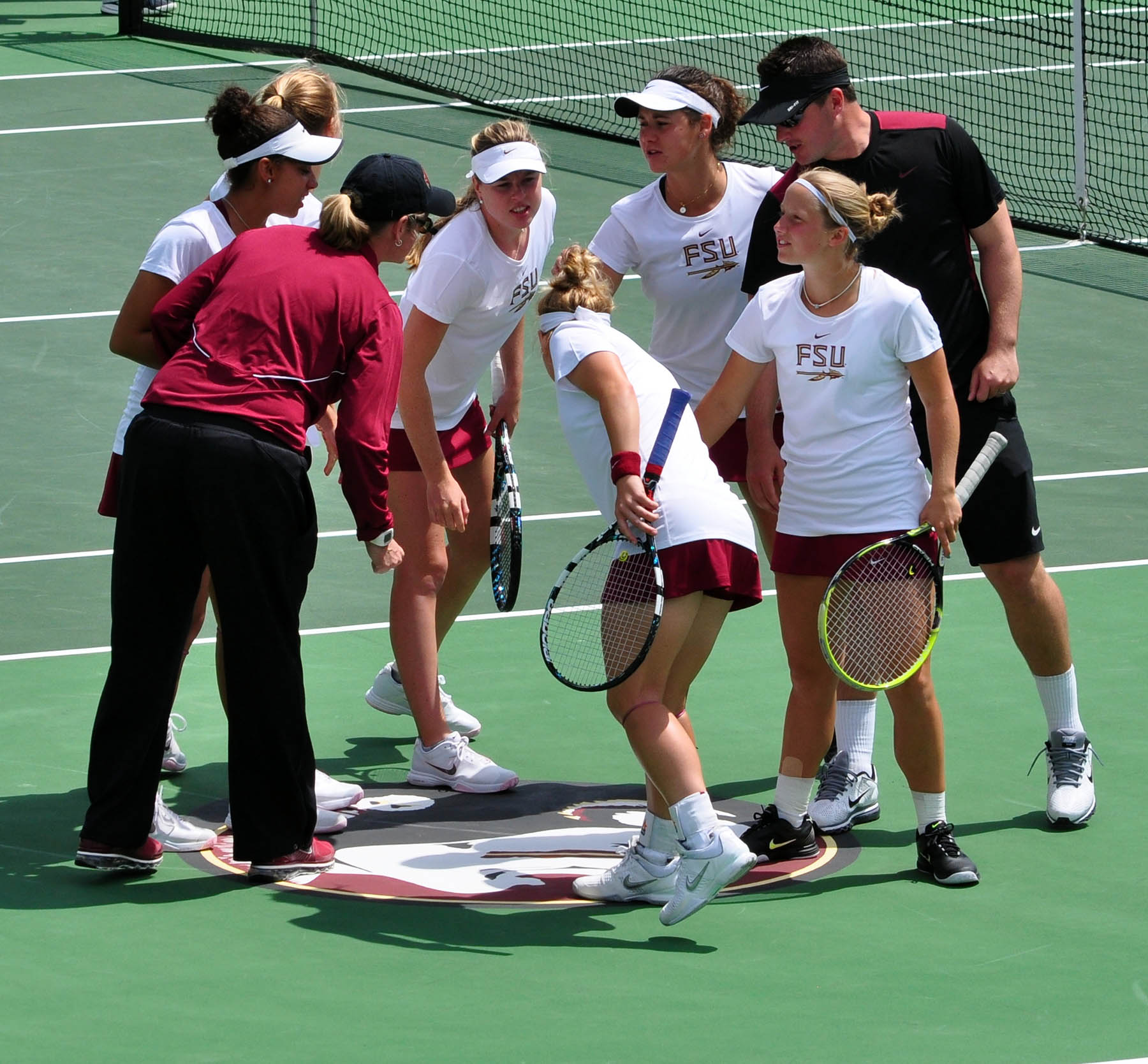
Sport groups across Canada are prioritizing their commitment to safe sport. These groups have developed strategies and policies, have committed financial and human resources, and are implementing new practices and procedures in order to curb incidences of maltreatment. Still, many are left asking:
Nevertheless, research indicates that it’s time for a change. Previously accepted practices, such as the use of extreme exercise as punishment, is not only problematic but we have also learned that disciplinary strategies are far more effective.Kerr, 2021. Coaching practices that rely on aggression and criticism as a way to develop tougher athletes may now be considered emotionally abusive.Kerr, 2021. These kinds of approaches are beginning to be viewed differently because evidence is mounting regarding the negative short and long-term impacts on participant mental health and overall well-being. We also know that these kinds of approaches not only contradict the way people learn best but maybe more importantly, athletes who are subject to this kind of behaviour are more likely to leave sport for good.Kerr, 2021.
In the last two years, several sport organizations, such as Sport Nova Scotia and the Canadian Sport Centre Atlantic with their Nova Scotia True Sport Athlete Ambassador Program, and Gymnastics Canada’s values-based coaching module, have leaned into True Sport as an upstream, solution focused approach that engages all stakeholders in fostering a positive safe sport environment minimizing maltreatment.Gymnastics Canada & True Sport, 2020. A commitment to True Sport helps communicate that the absence of harm is not the objective; the true desire of these sport organizations is to create an environment that allows for sport optimization.
Groups like Field Hockey Canada appointed a True Sport Lead instead of a Manager of Safe Sport, a title that describes the type of sport experience they seek versus the kind of experiences they’re working to mitigate. One of Gymnastics Canada’s first True Sport initiatives was the development of a values-based coaching module, an online learning course aimed at educating coaches on the organization’s commitment to True Sport and an invitation to help lead the promotion of this significant culture shift within the sport.Gymnastics Canada, n.d. BC Artistic Swimming (BCAS) has been trail-blazing a meaningful commitment to culture change in their sport through their activation of True Sport since 2017. Since that time, they have continued to explore innovative and fun ways to bring True Sport to life within their network such as:

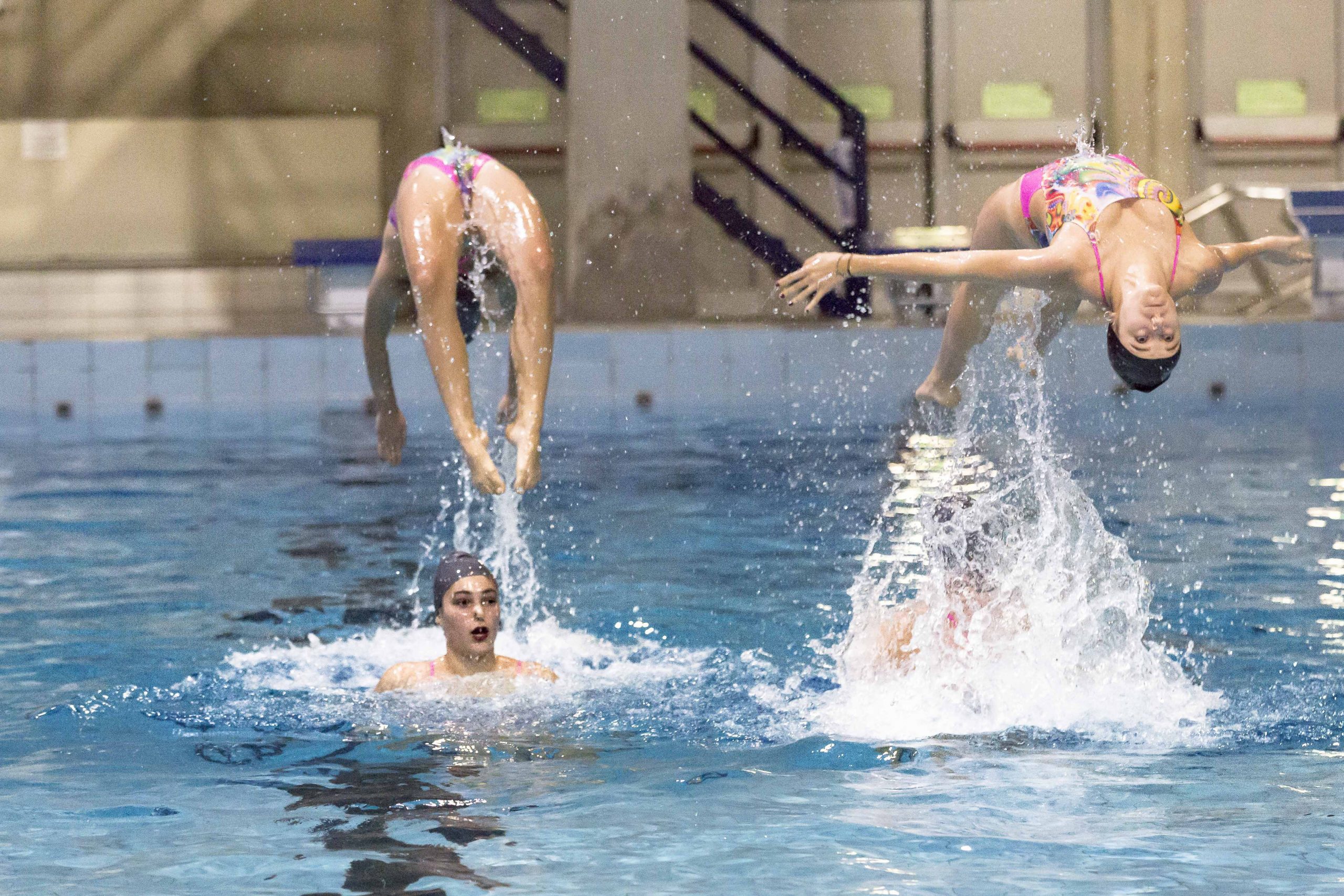
“EVOLVE: How one organization is tackling culture change” CCES, November 25, 2021
Jennifer Keith, Executive Director of BC Artistic Swimming, highlighted BCAS’s focus upon a positive sport experience for all by stating: “Our commitment to True Sport helps us ensure that the sport we are offering is providing a fun, safe, welcoming space for all members – not just for our athletes but also volunteers, staff, coaches, and officials”.True Sport, n.d.b., para. 3.
“Field Hockey Canada Announces Jenn Beagan as True Sport Manager” Field Hockey Canada, April 15, 2021.
This brief article by Field Hockey Canada announces the creation of a new position within the organization. Jenn Beagan – former player and professional coach – takes on the role of ‘True Sport Manager’ in an effort to weave safe sport values and guidelines throughout all areas of Field Hockey Canada. The article highlights the importance of an equitable, diverse, and fun environment while creating a safe space for athletes, officials, and staff.Field Hockey Canada, 2021.
“The Absence of Harm is Not Enough” by Elana Liberman, Sport Nova Scotia, September 28, 2020.
This article from Sport Nova Scotia details Safe Sport Lead Elana Liberman’s journey of realizing safe sport. She recalls the emphasis placed on the absence of harm (abuse, harassment, and discrimination) when discussing safe sport, however, she highlights the ambiguity that the word “safe” encompasses. Within her role at Sport Nova Scotia, Liberman expands on the definition of ‘safe’, adopting a values-based approach that makes everyone feel welcome. Sport Nova Scotia’s action in achieving ‘safe’ sport under the organization’s expanded definition are also discussed:Elana Liberman, 2020
To ensure safe sport and positive sport experiences for all, we need to change the deep-rooted culture of Canadian sport. From to 2001 to 2018 numerous touch points, including round tables, symposiums and surveys have been commissioned and have reaffirmed that a values-based approach is the ideal way to achieve culture change.
True Sport and its seven principles are a holistic approach applicable to all sports, at all levels and touches all stakeholders. A commitment to these principles on and off the field of play should collectively get us closer to the culture we seek. In addition to the organizations highlighted above, there are more than 4700 groups, representing millions of Canadians, that have declared their commitment to the principles by joining True Sport.
To make change we need to be intentional about what we want to do and how we are going to do it. Using True Sport as the approach, we can be intentional and consistent in our application of the principles across all policies, programs and practices. When we activate values-based sport, the likelihood of positive experiences for participants and all other stakeholders will increase. When participants enjoy sport, they stay involved and participate over a longer period and often encourage those around them to get involved as well. When more people are participating and contributing to a positive sport culture, the wealth of benefits that emerge in communities begins to take shape.
The True Sport Report offers overwhelming evidence that good community sport can deliver a broad spectrum of benefits that Canadians care about.True Sport, n.d.a. Beyond the obvious health and wellness benefits, communities experience social, economic and environmental benefits to name but a few – in short, good sport can instill character in our children, strengthen our communities and increase opportunities for personal and podium excellence.True Sport, n.d.a. The realization of these benefits is contingent on and enhanced by the adoption of True Sport as the foundation of the sport experience.
This notion has been at the heart of True Sport for many years. Unfortunately, bad things still happen in sport and those stories infiltrate our newsfeeds daily. These headlines are often the result of win at all costs attitudes. Negative issues are not singular in focus, sport is vulnerable to poor parental behaviour, maltreatment of officials, weak sport governance, etc. Theses negative sport stories can overshadow all that is good about sport and ultimately drive people out of sport for good.Canada Games, 2021.
These issues contribute to why kids are dropping out of sport, why parents are thinking twice before enrolling their children in sport, and why some athletes say they won’t return to organized sport post pandemic. When this happens, people, communities, and Canadian society as a whole lose the opportunity to benefit from all the good that sport can offer.
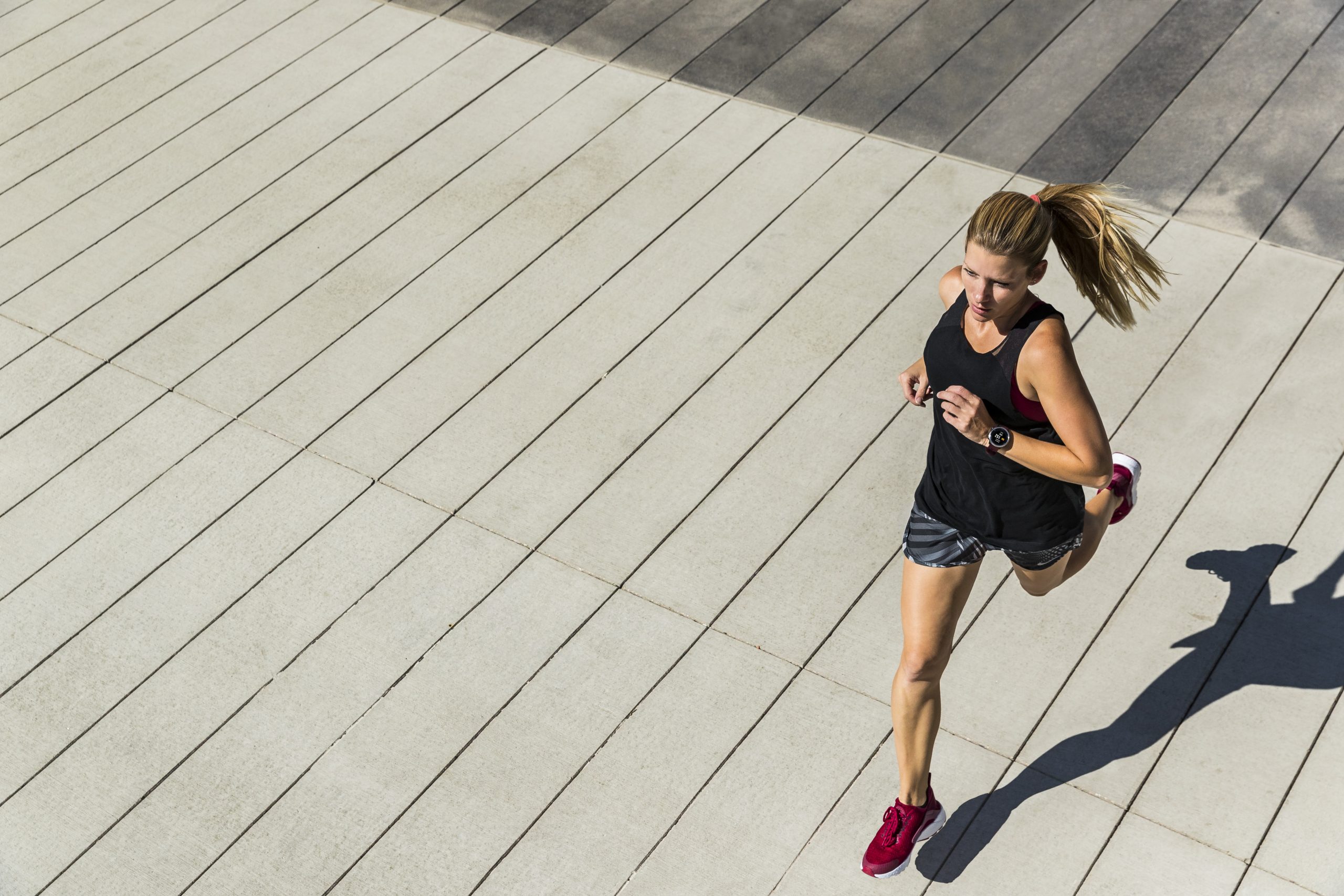
In a recent article, Dr. Gretchen Kerr discusses next steps along the safe sport journey and states “When sport is safe, welcoming, inclusive, and fulfilling, and is respectful of individuals’ rights and welfare, prevention of harms occurs naturally.”Kerr, 2021.

Can the culture of sport truly work to guard against maltreatment and other safe sport issues? Why or why not? Won’t predators do as they wish regardless of the culture?
Should parents be more involved in their children’s sporting experiences? Should they monitor their children’s sport-related activities and relationships more closely? Do some parents’ “win at all costs” mentalities give license to others to use strategies that could be considered maltreatment?
Does safe sport mean sport leaders can no longer be “tough” on athletes? How can sport leaders apply effective coaching techniques that produce podium caliber athletes under increased scrutiny within a hyper-sensitive environment? How can coaches apply consequences without making themselves more vulnerable to accusations of abuse?
Changing culture is a long game – it’s the day to day, consistent and continual commitment by all stakeholders to live the True Sport Principles that will foster the sport culture Canadian’s say they want. Over the last few years a lot of time has been spent talking about what’s wrong in sport and developing the policies and frameworks to address the issues. Expected standards of what not to do are well in place; it’s now time to move to what we can and should be doing.
True Sport is a commitment that each and every stakeholder in the Canadian sport system can make to contribute to a sport system that we can all be proud of. True Sport is a positive, upstream approach that when consistently and intentionally activated, can help us achieve the safe, welcoming, inclusive and beneficial sport environments that we seek.
Canadians believe that good sport can make a great difference. Everyone has a role to play in ensuring they are making a positive contribution – what role will you play?


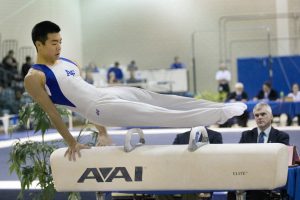
In response to increasing incidences of maltreatment in the sport of gymnastics, the Canadian sport governing body, Gymnastics Canada, sought the guidance and support of the Canadian Centre for Ethics in Sport to help them foster a more consistent values-based sport experience. They recognized that True Sport, as a holistic, preventative, and positive approach could drive the culture change that was desperately needed in their sport. Their engagement efforts began with several staff members participating in a True Sport Activation Workshop to learn more about how True Sport could be integrated into their policies, programs, and procedures.
Staff identified priority areas which included coach education, event education and team selection processes. Their first True Sport Strategy action item was to produce an online learning course for coaches. The Values-Based Coaching Module introduces gymnastics coaches to the values and principles of True Sport, expands their understanding of the connections between values-based sport, Gymnastics Canada’s Safe Sport Framework and the long-term development model, and provides practical exercises to help coaches implement key learnings in real-life situations. Early survey results showed that 96% of respondents who completed the values-based coaching module believe that intentionally engaging in True Sport will benefit themselves as a coach as well as their athletes. Gymnastics Canada remains committed to True Sport and continues to identify opportunities and methods to incorporate values and principles into their organization and sport.
For more insight about Gymnastics Canada and its safe sport initiatives, see Chapter 12.
Key Terms
Suggested Assignments
Image Descriptions
Figure 11.1 This figure shows the member types/stakeholders associated with True Sport. The centre text reads “TRUE SPORT LIVES HERE” and the ten items listed around the centre text include coaches, communities, events, facilities, leagues, officials, organizations, parents, schools and teams. [return to text]
Sources & Further Reading
Canada Games. (2021, April 1). Stories: Canadians miss youth sport, but not all plan to return according to new research from Canada Games. Retrieved October 29, 2021, from https://www.canadagames.ca/stories/canadians-miss-youth-sport-but-not-all-plan-to-return-according-to-new-research-from-canada-games
Canadian Centre for Ethics in Sport (CCES). (n.d.). Responsible coaching movement. Retrieved October 29, 2021, from https://cces.ca/responsible-coaching-movement
CCES. (2002). 2002 Canadian public opinion survey on youth and sport: Final report July 2002. https://cces.ca/sites/default/files/content/docs/pdf/cces-rpt-2002survey-e.pdf
Coaching Association of Canada (CAC). (n.d.). Responsible coaching movement. Retrieved October 29, 2021, from https://coach.ca/responsible-coaching-movement
Liberman, E. (2020, September 28). The absence of harm is not enough. Sport Nova Scotia. Retrieved October 29, 2021, from https://www.safesportns.ca/uncategorized/the-absence-of-harm-is-not-enough/#:~:text=Sport%20Nova%20Scotia%20believes%20that,participants%20in%20sport%20and%20recreation.
Field Hockey Canada. (2021, April 15). Field Hockey Canada Announces Jenn Beagan as True Sport Manager. Retrieved October 29, 2021, from https://fieldhockey.ca/field-hockey-canada-announces-jenn-beagan-as-true-sport-manager/
Government of Ontario. (2001, August 10). Ministry of heritage, sport, tourism, and culture industries: Expectations for fairness in sport. Retrieved October 29, 2021, from http://www.mtc.gov.on.ca/en/sport/sport/expectations-e.pdf
Gymnastics Canada & True Sport. (2020, September 30). A true sport journey: Canada’s new values-based coaching module. Sport Information Resource Centre (SIRC). Retrieved October 29, 2021, from https://sirc.ca/blog/gymnastics-canada-values-based-coaching/
Gymnastics Canada. (n.d.). Coaching tool. Retrieved October 29, 2021, from http://www.gymcan.org/resources/for-coaches/coaching-tool
Kerr, G. (2021, April 19). Next steps in the safe sport journey: From prevention of harm to optimizing experiences. Sircuit. Retrieved October 17, 2021, from https://sirc.ca/blog/next-steps-in-the-safe-sport-journey/.
Ministers of Sport, Physical Activity, and Recreation. (2012). Canadian Sport Policy 2012. Retrieved November 3, 2021, from https://www2.gnb.ca/content/dam/gnb/Departments/thc-tpc/pdf/SportRecreation-SportLoisirs/CanadianSportPolicy.pdf
Symposium. (2003, September 13). The sport we want: Symposium final report. https://cces.ca/sites/default/files/content/docs/pdf/cces-rpt-tswwfinalreport-e.pdf
Symposium. (2019, March). The values proposition: Building a stronger Canada through values-based sport. https://cces.ca/sites/default/files/content/docs/pdf/thevaluesproposition-ppf-march2019-en.pdf
True Sport. (n.d.a) True sport report. Retrieved October 29, 2021, from https://truesportpur.ca/true-sport-report
True Sport. (n.d.b) True sport spotlight: BC artistic swimming. Retrieved October 29, 2021, from https://truesportpur.ca/voices/true-sport-spotlight-bc-artistic-swimming
True Sport. (n.d.c) True sport: True sport principles. Retrieved October 29, 2021, from https://truesportpur.ca/true-sport-principles
True Sport. (n.d.d) True sport: What is true sport?. Retrieved October 29, 2021, from https://truesportpur.ca/aboutus
True Sport pur. (2015, March 11). The power of true sport [Video]. Youtube. https://www.youtube.com/watch?v=UWwkoPbfEY4
True Sport pur. (2016, May 15). True sport lives here Manitoba [Video]. Youtube. https://www.youtube.com/watch?v=SpD-4N34Ksw
True Sport pur. (2016, November 28). The ride home [Video]. Youtube. https://www.youtube.com/watch?v=-0e8zvvY-x8
True Sport pur. (2018, November 19). A recipe for good sport [Video]. Youtube. https://www.youtube.com/watch?v=COYepHh2aAE&t=1s
Volleyball Canada. (2021, April 22). All news: Safe sport training now required. Retrieved October 29, 2021, from https://volleyball.ca/en/news/safe-sport-training-now-required
12
Ellen MacPherson
Ian Moss
Program development and delivery
Stakeholder engagement
National level sport
When you have completed this chapter, you will be able to:
LO1 Identify the steps used by a national sport organization to conceptualize, develop, and deliver a Safe Sport program;
LO2 Identify the stakeholders involved in developing a comprehensive Safe Sport program and describe examples of each stakeholder’s role and responsibilities;
LO3 Identify examples of GymCan’s knowledge mobilization activities, wherein up-to-date research is translated to practice; and
LO4 Describe potential challenges associated with the design and delivery of Safe Sport.
In early 2018, in response to the international movement to shift the culture of sport, Gymnastics Canada (GymCan) became one of the first National Sport Organizations (NSOs) in Canada to hire a full-time Director, Safe Sport. The core focus of the Director, Safe Sport’s portfolio is to develop, implement, and evaluate organizational initiatives that create and promote safe, healthy, and inclusive experiences for all individuals in the sport. A cornerstone of GymCan’s Safe Sport portfolio is the Safe Sport Framework, which serves as the guiding strategic plan for the organization’s Safe Sport program and includes GymCan’s definition and vision of “safe sport”, organizational principles for safe gymnastics environments, the broad topics comprising the program, and the corresponding policy, education, and advocacy initiatives required to promote positive, healthy, and safe practices.
This chapter provides an overview of the process of developing GymCan’s Safe Sport Framework, discussesdesign and implementation of a few key safe sportpolicy, education, and advocacy initiatives, reviews some of the challenges encountered and lessons learned along the way, suggestscritical areas of focus to enhance impact (e.g., athlete’s voice, shared responsibility and collaboration, evidence-based programming), and provides sample activities, learning modules, podcasts, and other resources to bolster students’ and industry professionals’ safe sport toolkits.
The International Gymnastics Federation (FIG) is considered the governing body for the sport of gymnastics worldwide and remains the oldest established international federation for sport in the Olympic era.FIG, n.d. While the FIG sets the international regulations for gymnastics, each member federation (i.e., Gymnastics Canada) is responsible for developing the operating rules, regulations and policies, as well as overall sport experience at the national level.Kilijanek & Sanchez, 2020 As a result, national governing bodies typically set the overarching values, standards, safety regulations, education, and development for individuals in their programs.Kilijanek & Sanchez, 2020
In consideration of the position of an NSO in the overarching sport structure, this chapter explores the role of Gymnastics Canada in developing, supporting, and fostering safe sport, including a general overview of the sport of gymnastics, the unique challenges of the sport, the organizational structure of GymCan, the factors influencing the development of a dedicated safe sport portfolio, steps to developing a Safe Sport Framework and considerations for future program development.
The sport of gymnastics has eight different disciplines, with each discipline possessing distinct technical rules, regulations, eligibility requirements and artistic elements.Kilijanek & Sanchez, 2020 The gymnastics disciplines include: women’s and men’s artistic gymnastics, rhythmic gymnastics, trampoline and tumbling, acrobatic gymnastics, aerobic gymnastics, parkour, and Gymnastics for All. Each of the disciplines will be briefly explained below.
An interactive H5P element has been excluded from this version of the text. You can view it online here:
https://ecampusontario.pressbooks.pub/safesport/?p=239#h5p-34
In general, gymnastics presents a few unique challenges with respect to the development and effective implementation of Safe Sport parameters across the sport. GymCan works collaboratively with its Provincial/Territorial sport organizations to mitigate and manage these ongoing challenges.
Examples of these challenges include but are not limited to:
To illustrate the role of the GymCan in the design and delivery of gymnastics programming in Canada, please refer to Figure 12.2, which illustrates GymCan’s organizational chart and lists the areas of operation and roles within each program. It is also important to understand GymCan’s vision, mission, and values in order to appreciate the full context of their safe sport initiatives.
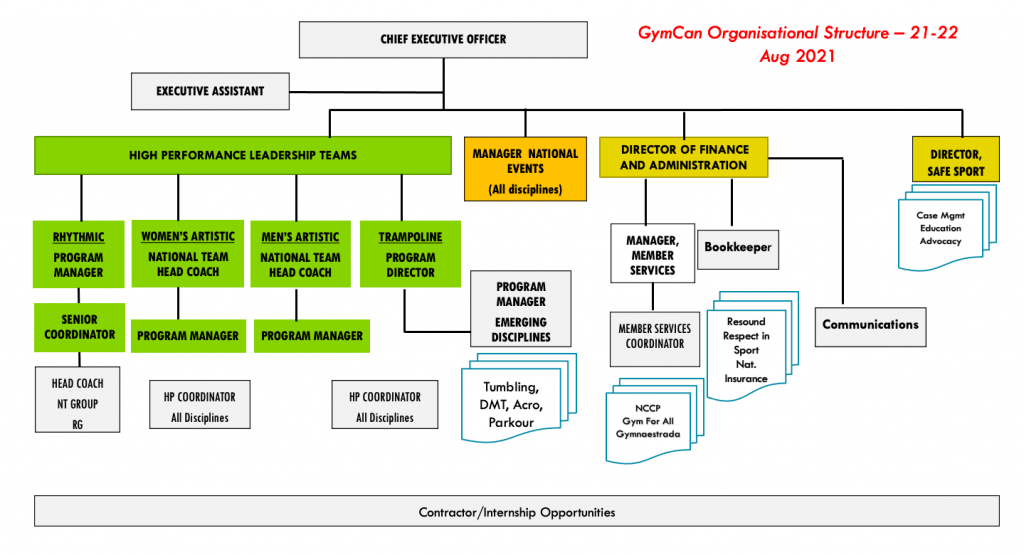
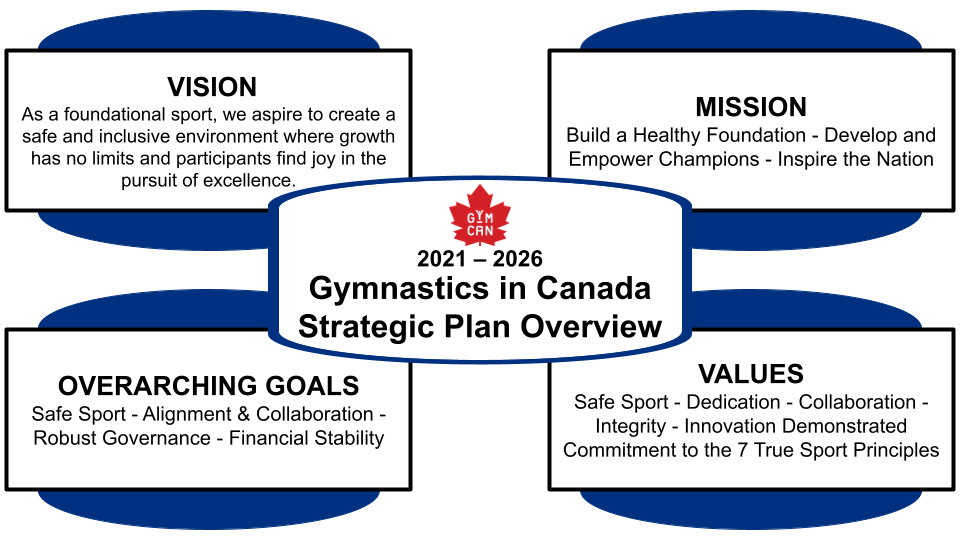

“Gymnastics Canada: From Here, We Soar” celebrates the role of GymCan in supporting the mastery of movement in Canada for the past five decades.
Although GymCan and its provincial organizations implemented some initiatives considered under the umbrella of “safe sport” in past, including Respect in Sport training, there was not a stand-alone portfolio developed to support the conceptualization, delivery and evaluation of safe sport initiatives until 2018. The following section will briefly identify some of the factors that led to the creation of a dedicated safe sport portfolio, including:
Dr. Larry Nassar began working with the United States gymnastics team in 1986 and continued providing medical care until 2015, shortly before he was accused of sexually assaulting more than three hundred people with whom he interacted, primarily through his medical practices at Michigan State University and USA Gymnastics (USAG).Kirby, 2018 Nassar pleaded guilty to the criminal charges against him and received a sentencing of sixty years in prison.Kirby, 2018 At the trial, over 150 women – many of whom were female athletes – shared testimonies of the abuse carried out by Nassar.Kirby, 2018
The case of Larry Nassar and USAG has since been the subject of a Netflix documentary titled “Athlete A” and sparked current and former athletes worldwide to speak out about their experiences with maltreatment in gymnastics under the social media hashtag #GymnastAlliance.Macur, 2020 In addition, many of the survivors in this case continue to share their experiences, including the lasting harmful effects of the abuse in different realms (e.g., social media, federal government hearings, traditional media)Jalonick, 2021 to advocate, call for change, and prevent maltreatment from occurring in the future.
Safe Sport issues have not been immune to the Canadian context, with high-profile maltreatment cases occurring across all sports for many years, including, gymnastics, athletics, alpine, hockey, and swimming, among others. In a recent study by Willson, Kerr, Stirling, and Buono,Willson et al., 2020 the authors surveyed 1001 current or former Canadian national team winter and summer sport athletes and revealed: 76% of retired athletes and 67% of current athletes reported experiencing at least one neglectful behaviour; 62% of retired athletes and 59% of current athletes reported experiencing at least one psychologically harmful behaviour; 21% of retired athletes and 20% of current athletes reported at least one sexually harmful behaviour; and, 19% of retired athletes and 12% of current athletes reported at least one physically harmful behaviour (for more information about safe sport from an athlete perspective, please see Chapter 2). While the present study focused exclusively on national team level athletes, anecdotal evidence across sport suggests that safe sport issues transcend national teams to reach all levels of sport.

To encourage reporting in the sport of gymnastics, GymCan created a reporting resource page on their website, including external helplines (e.g., Canadian Sport Helpline, Canadian Centre for Child Protection, Kids Help Phone), complaint submission forms, and a GymCan suspended and expelled members list.
According to Hostermann and colleagues,Hostermann et al., 2018 the phrase “Me Too” has been used to empower survivors to share their experiences of sexual assault since 2006. However, the phrase gained momentum in the public sphere in 2017 when actor Alyssa Milano posted a social media request for her followers to comment #MeToo if affected by sexual assault after revealing she was assaulted by producer Harvey Weinstein.Hostermann et al., 2018 Since then, #MeToo has empowered millions of individuals worldwide from diverse industries to share their stories of maltreatment in solidarity and advocate for accountability for these experiences.Hostermann et al., 2018; Zacharek et al., 2017
In addition to the key factors listed previously, there was recognition and acknowledgment from stakeholders in the Canadian gymnastics community that a cultural shift towards enhanced policy, education and advocacy that prioritized participant well-being and safety was necessary. The first step towards realizing this overarching goal was to hire a full-time employee to conceptualize the organization’s Safe Sport Framework and manage the corresponding program.
In summary, these four key factors contributed to the creation of a dedicated safe sport portfolio at the national governing body for gymnastics and the hiring of a full-time employee to facilitate the program. Once the full-time employee was in place, development of GymCan’s Safe Sport Framework began. The following section provides an overview of the general purpose of the Safe Sport Framework as well as an outline of the six key steps engaged in by GymCan to facilitate development of the Framework.
The Safe Sport Framework is GymCan’s Strategic Plan for safe sport created with the purpose of minimizing risks and strengthening the administration and delivery of all programs, events, and services. The overarching goal of the Safe Sport Framework is to encourage a cultural shift towards more positive, inclusive, and healthy gymnastics environments from grassroots to the national level. The framework document includes the organization’s purpose, philosophy and principles, topic areas, pillars, objectives, and corresponding initiatives related to Safe Sport.
Each of these key components is described in the following section. It is important to note that when the Safe Sport Framework was conceptualized in 2018, it was considered an ever-evolving document that would be reviewed, revised, and expanded upon as the organization continued to make enhancements in the area of policy, education and advocacy.
Throughout this section, we provide insight into the initial approach GymCan took to operationalize the Safe Sport Framework and provide a few practical examples of policy, education, and advocacy initiatives completed to date.
Safe Sport Policy. In accordance with the Safe Sport Framework and corresponding prioritization of initiatives, the first pillar undertaken by GymCan was policy. This pillar was selected to ensure there was a solid foundation and set of clear principles in place to establish expected standards for behaviour and promote accountability in the environment. The overarching objectives for policy development and implementation are as follows:
Across all objectives, GymCan aims to ensure that participant welfare is at the forefront of all policy development, commits to regular review and updates of the policies following the initial revitalization of the policy suite, recognizes the need to develop independent and expert-led processes that remove decision-making power from the NSO in disciplinary cases, and strives to ensure that participants across the country are operating under similar expectations of practice and standards of care.
With the core objectives in mind, the first phase of Safe Sport policy revitalization included the following:
Navigate through the interactive flip cards using the right and left arrows at the bottom. Flip the card over to read more about each each of the policies included in safe sport policy revitalization.
From a broad perspective, policies and procedures related to safe sport require continuous expansion, refinement, and updates as new evidence (e.g., research, lived experiences, learnings) becomes available to enhance expected standards, knowledge, and practice. Click hereto view GymCan’s up-to-date Safe Sport policies.
Finally, in conjunction with safe sport policy updates, it is also critical to engage in ongoing review and revision of organizational documents to ensure the same principles and standards for behaviour outlined in the policies are incorporated throughout all operational documents and procedures. For instance, as part of the safe sport policy suite revitalization, GymCan’s National Team Agreement, National Team Responsibilities Manual, and the National Team Handbook were revised to incorporate updated terminology, roles/responsibilities, best practices and conduct expectations for positive, healthy and athlete-centered national team environments.
Safe Sport Education. Implementation of educational measures are integral to enhance knowledge and develop reasoning and judgment, as well as foster positive interactions and practices in the community. The following core objectives serve to guide the educational initiatives designed and implemented by GymCan:
With these objectives, GymCan aims to build knowledge and capacity to create, maintain, and foster safe, inclusive, and positive environments for all participants. To provide context to the organization’s approach to Safe Sport education, it is important to consider that the core focus in the early years of safe sport programming was policy development with the intention to strengthen the foundation for safe sport at GymCan. As a result, to date, Safe Sport education at GymCan has been implemented in a variety of both short-term and long-term ways that the organization intends to build upon with a refined focus in the future.
Included in these initial Safe Sport educational initiatives are mandatory training mechanisms for key stakeholders in the GymCan community in accordance with Sport Canada, including the Respect in Sport for Activity Leaders certification, as well as custom in-person workshops for GymCan’s National Teams (e.g., athletes, coaches, judges), and optional community-wide learning activities. For example, GymCan’s Safe Sport Learning Series takes an evidence-based approach to safe sport education by pairing expert researchers with a practitioner or individual with lived experience to share knowledge and provide concrete strategies to help influence and inspire a more athlete-centered, positive and healthy culture in practice.
Further, GymCan encourages self-directed learning through the Safe Sport section of GymCan’s website, which provides links to the organization’s up-to-date safe sport policies; free resources covering a variety of topics related to maltreatment, equity and inclusion, health and wellbeing, and concussion; information and resources for reporting concerns within and outside of GymCan; and connections to external helplines for assistance on a variety of topics, such as mental health, welfare concerns, and inclusion .
Safe Sport Advocacy. Throughout the development of policy and implementation of education initiatives, GymCan has also engaged in different avenues for safe sport advocacy. There are two key objectives that foster the advocacy initiatives at GymCan (see Table 12.1).
| Advocacy Objective #1 | Advocacy Objective #2 |
| Actively promote GymCan’s commitment to Safe Sport and enhance visibility in the gymnastics community and beyond. | Positively contribute to an athlete-centered culture in sport through collaboration with Safe Sport leaders and external experts. |
In consideration of these two key objectives, GymCan engages in a variety of strategies to support advocacy for safe sport within gymnastics specifically, and the Canadian sport system more broadly. For instance, GymCan’s national platform is leveraged to foster connections and build community relationships with other NSO, MSO, and professional sport partners nationally and internationally to drive culture change system-wide. This includes participation in the Universal Code of Conduct to Prevent and Address Maltreatment in Sport Working Group, participation in the International Gymnastics Working Group for Safe Sport, and collaborations with values-based sport partners (i.e., True Sport) to develop learning materials and elevate the impact of our collective voice for safe sport.
In addition, GymCan’s national platform is leveraged to galvanize public support on issues related to safe sport through consultations, presentations, media interviews, and signing or developing written communications, such as position statements or letters to government. Further, to maximize the influence of GymCan in the safe sport realm, the social media channels (i.e., Facebook, Twitter, and Instagram) for the organization are used to promote learning opportunities and demonstrate GymCan’s participation in external events aimed at building capacity or supporting key issues under the safe sport umbrella, such as participation in the Capital Pride Parade. Advocacy is a critical method for encouraging the prioritization of safe sport across the Canadian Sport System.
The sport environment is often referred to as a microcosm of general society (Cunningham, G. B., & Welty Peachey, J. [2012]) and thus, it is the responsibility of sport leaders to ensure that the management of the sport system properly reflect societal norms, standards, and expectations. In recent years, the #MeToo movement and an enhanced global focus on gender and power inequity in sport have highlighted the critical and immediate need for sport to change the culture and modernize both its systemic and organization-specific architecture, policies, and procedures.
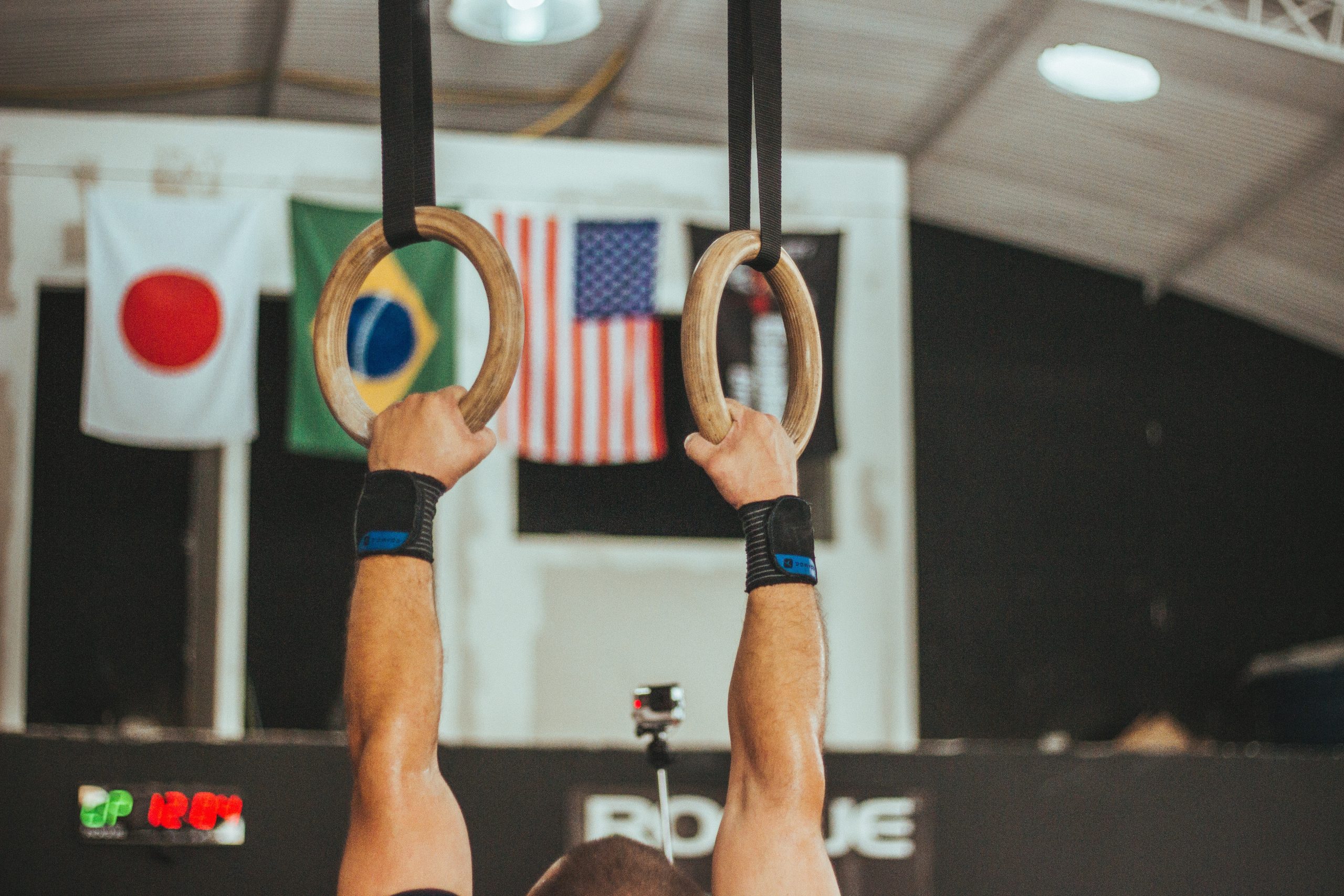
Though the concept and philosophy of safe and healthy sport is not new, the “safe sport movement” has gained significant traction over the last decade due to troubling stories bravely shared by athletes from many different sports about the realities of their athletic experiences. These revelations have led to heightened awareness and an urgent call for enhanced equity, access, and safety within the culture and structure of sport.
For gymnastics, specifically, an outpouring of cases and significant concerns regarding the maltreatment of athletes have been highlighted across the globe. In response, independent cultural reviews of gymnastics have recently been facilitated via external agencies in many countries, including, Belgium, Netherlands, Great Britain, Australia, and New Zealand. The findings from these investigations have been disturbing (e.g., stories of humiliation, control, threats, weight management, blackmail, training through significant injuries, culture of fear), and are a lesson to leaders in all sports as to their responsibilities to provide a safe, healthy, and inclusive environment for all participants.
A few examples of the recommendations for organizations to facilitate culture change gleaned from the investigations concluded to date are:
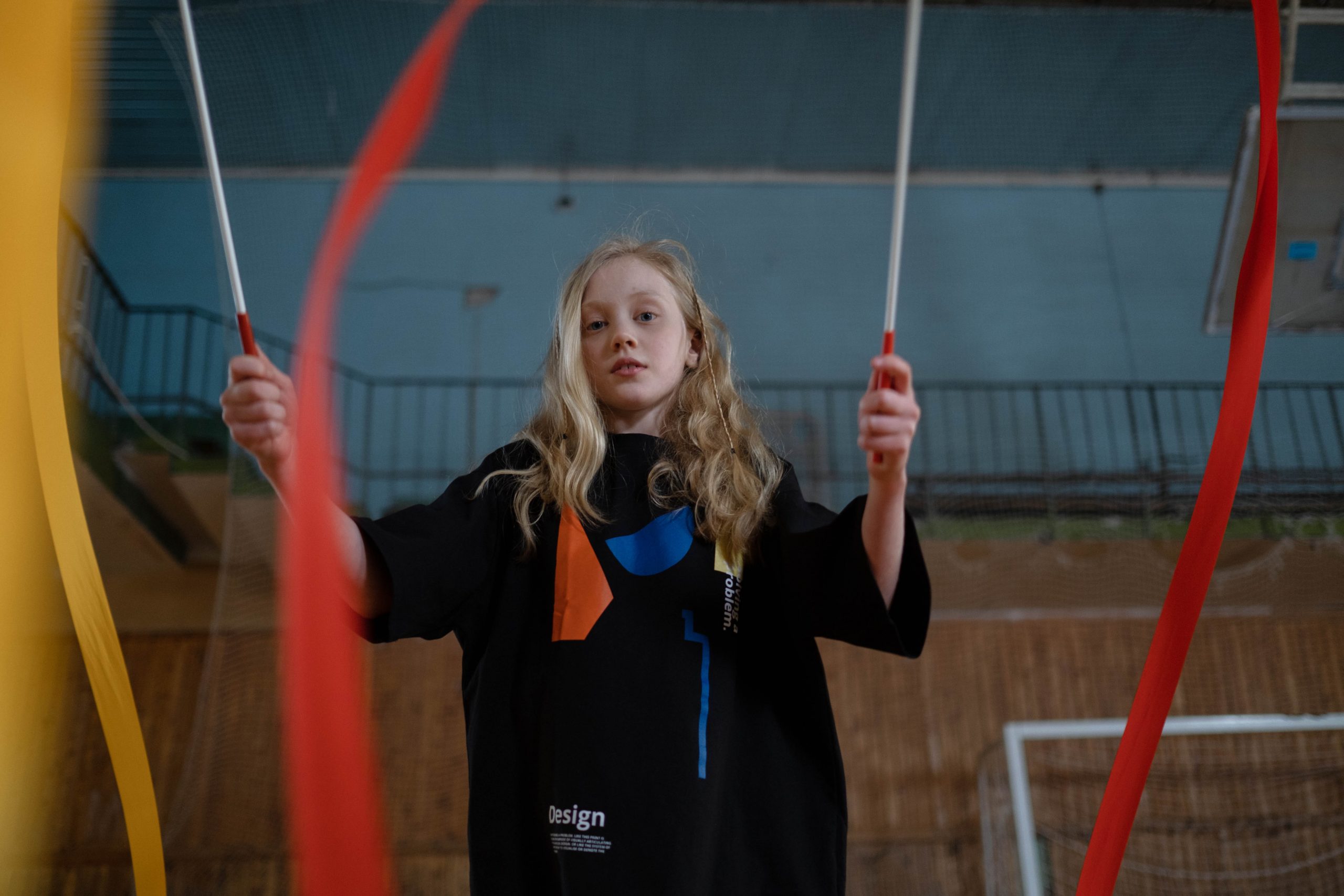
For gymnastics in Canada, the development of the Safe Sport Framework represents the first step of an essential path to enhanced awareness, policies and procedures, education and advocacy for safe sport. To date, some significant progress with respect to safe sport legislation, operations, and engagement has been implemented. However, there is still much work to do to foster and ensure a renewed culture that prioritizes safe, positive, and inclusive environments above all else for all participants across Canada.
The next step for GymCan and its Provincial/ Territorial partners is to assess existing gaps and continue to refine policies and procedures to enhance protection of vulnerable participants and mitigate the unequal power relations that enable maltreatment, develop educational resources and tools to elevate behaviour and practices, create increased opportunities for athlete voices, and address historic issues while developing the foundation for an athlete-centered and holistic culture. In addition, GymCan commits to supporting the Canadian independent safeguarding organization (launching in 2022) and considers the initiation of this organization as a critical step forward for the entire sport system. Finally, the findings emerging from gymnastics cultural reviews worldwide must be reviewed and incorporated into the organization’s strategic planning and next steps for Safe Sport.
Ultimately, the path to Safe Sport has no end – sport must continually adapt and change to align with cultural and societal expectations, while prioritizing the health and well-being of participants. It is our hope that GymCan’s process to develop the Safe Sport Framework outlined throughout this chapter is helpful to students and future sport practitioners, and is recognized as one national sport’s attempts to begin building a stronger foundation for a better future. Finally, it is imperative as sport practitioners that we continue to learn, evolve, and elevate knowledge, understanding, and practice to ensure safe, healthy, and inclusive sport environments for all Canadians.
VI

Coaches are a central element of the movement towards safer sport. In Part 6, we have two chapters written by experts in the coaching field, one from an academic perspective and the other from an organizational standpoint. Chapter 13 written by Michael Van Bussel, PhD, and Kirsty Spence, PhD, Professors of Sport Management at Brock University, focuses on sport relationships and the idea of relational risk management. By developing a care-driven model and relational risk management plan, Van Bussel and Spence explain how this can positively impact sport organizations, administrators, coaches, and athletes.
In Chapter 14, the Coaching Association of Canada’s (CAC) Director of Sport Safety, and Director of Education Partnerships, Policy Development and Long-Term Athlete Development (LTAD) both offer their insight on the role of the coach in achieving safer sport. Isabelle Cayer and Peter Niedre write about the culture shifts that have impacted the safe sport movement, and the ways in which the CAC has taken action to offer and promote training and coach education for individuals and organizations looking to implement change.
|
Coaching Association of Canada |
CAC |
|
National Coaching Certification Program |
NCCP |
|
National Sport Organizations |
NSO |
|
Provincial-Territorial Coaching Representatives |
PTCR |
|
Provincial / Territorial Sport Organizations |
P/TSO |
|
Multiservice Sport Organizations |
MSO |
|
Chartered Professional Coach |
ChPC |
|
Canadian Centre for Ethics in Sport |
CCES |
|
Responsible Coaching Movement |
RCM |
|
Make Ethical Decisions |
MED |
|
Universal Code of Conduct to Prevent and Address Maltreatment in Sport |
UCCMS |
|
Communities of Practice |
CoP |
|
Canadian Centre for Child Protection |
CCCP |
|
High-Performance Director |
HPD |
13
14
Isabelle Cayer
Peter Niedre
Coach Training
Coach Education
Safe Sport Journey
When you have completed this chapter, you will be able to:
LO1 Explain what the CAC is and what its Mission & Values are;
LO2 Identify the role of the coach and sport organizations in the implementation of safe sport practices;
LO3 Identify the role of the CAC in ensuring a safe sport environment;
LO4 Explain the three pillars of the Responsible Coaching Movement; and
LO5 Identify the different coach training and education programs offered by the CAC.
Wherever there is an athlete, there is a coach. Coaches are parents, teachers, neighbours, and ethical leaders in their communities. They listen to, lead, encourage, and inspire our country’s athletes and participants in every sport and at every level. What motivates someone to become a coach? It’s their passion to help others and themselves to achieve higher goals, both in sport and in life. This chapter explains the mandate and activities of the Coaching Association of Canada (CAC) and what we believe to be the role of coaching in promoting the safe sport movement.
The CAC’s mission is to enhance the experiences of all athletes and participants in Canada through quality coaching; and with its partners are stewards of nation-wide standards and ethics in coach education and development. Yet, the responsibility of ensuring safe sport belongs to more than just coaches. The safe sport movement requires support from sport officials, administrators, volunteers, athletes & participants, health professionals in Integrated Support Teams (ISTs), parents and guardians.
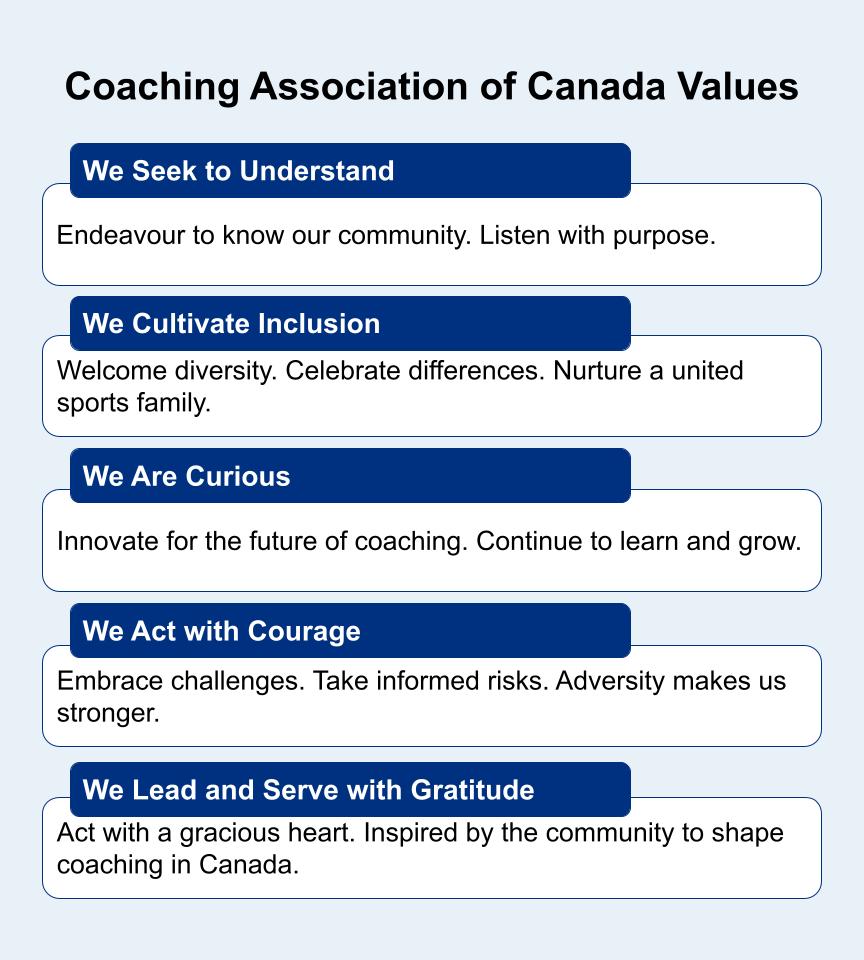
The ever-growing body of research regarding safe sport alongside publicized news stories of athlete maltreatment has influenced the sport system in Canada and around the world to do better. As a result, the CAC has made it one of their core missions to educate sport leaders on safe sport and create a safe and inclusive environment for everyone including athletes, coaches, volunteers, and decision-makers. These decision-makers include sport administrators, officials, CEOs, board chairs and high-performance directors who lead and influence a culture of excellence in sport.
The CAC recognizes sport’s ability to positively impact the lives of Canadians in areas including mental health, physical health, and social change with their vision to inspire the nation through sport. Therefore, the association educates, develops and celebrates the achievement of coaches in Canada from the community level through to high-performance and motivates them to be participant and athlete-centered.
The CAC also unites partners and stakeholders in its commitment to raise the skills and stature of coaches and ultimately expand their reach and influence. We are a partner-driven organization that relies on the strength of its relationships to achieve its mission. The coach and sport leader development and education system in Canada is a result of the work of highly committed individuals from many different organizations who strive for coaching excellence from the playground to the podium. Programming offered by the CAC can empower sport organizations and coaches in Canada with knowledge and skills, it can promote ethical behaviours, foster positive attitudes, build competence and increase the credibility and recognition of coaches.
Video provided by Coaching Association of Canada. Used with permission. [Transcript]
Data and research are of major importance to the CAC. Our research strategy aims to ensure that sport coaching programs are based on evidence-based decision making and are credible. As part of its research strategy, the CAC is developing four interrelated areas of influence. Sport Science and Sport Coaching research informs and inspires the CAC’s programs and services. Sport Science research is at the foundation of the National Coaching Certification Program (NCCP) content, which is in turn transferred to and applied by NCCP coaches. Sport Coaching research is at the foundation of the NCCP learning design as well as of other programs and services targeting Women in Coaching, Diversity and Inclusion, Lifelong Learning and Professional Coaching. The CAC research strategy of knowledge mobilization and dissemination helps inform development of training for coaches and sport leaders in safe sport, and also measures the impact of the training on their self-efficacy.
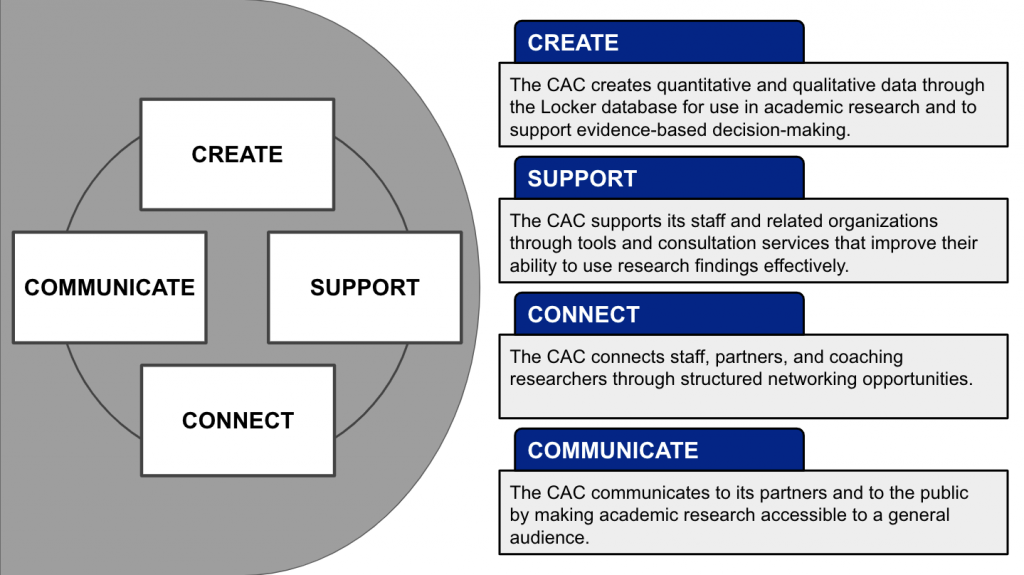
The CAC’s brand equity is built on a 50-year foundation of national and international recognition as the “go to” resource for coaching advice and information. The people who make up the organization believe that every participant deserves a certified coach.
We are mandated by governments to develop a harmonized coaching education program that is available and accessible throughout the country. As part of this mandate, the CAC along with Provincial/Territorial Coaching Representatives (PTCRs), National Sport Organizations (NSOs), and Provincial/Territorial Sport Organizations (PTSOs) share the stewardship of the National Coaching Certification Program (NCCP). The NCCP is the program that delivers coach training and grant certification to coaches and coach developers across 65+ different sports nation-wide.
The CAC produces multi-sport NCCP training content that is delivered by PTCRs and via eLearning. It is committed to enhancing the coaching profession, promoting ethical and responsible coaching practices, and ensuring diversity and inclusion practices are embedded within all coach training and development initiatives.
Because the CAC has numerous categories of partners and stakeholders, we have unique value propositions for each:
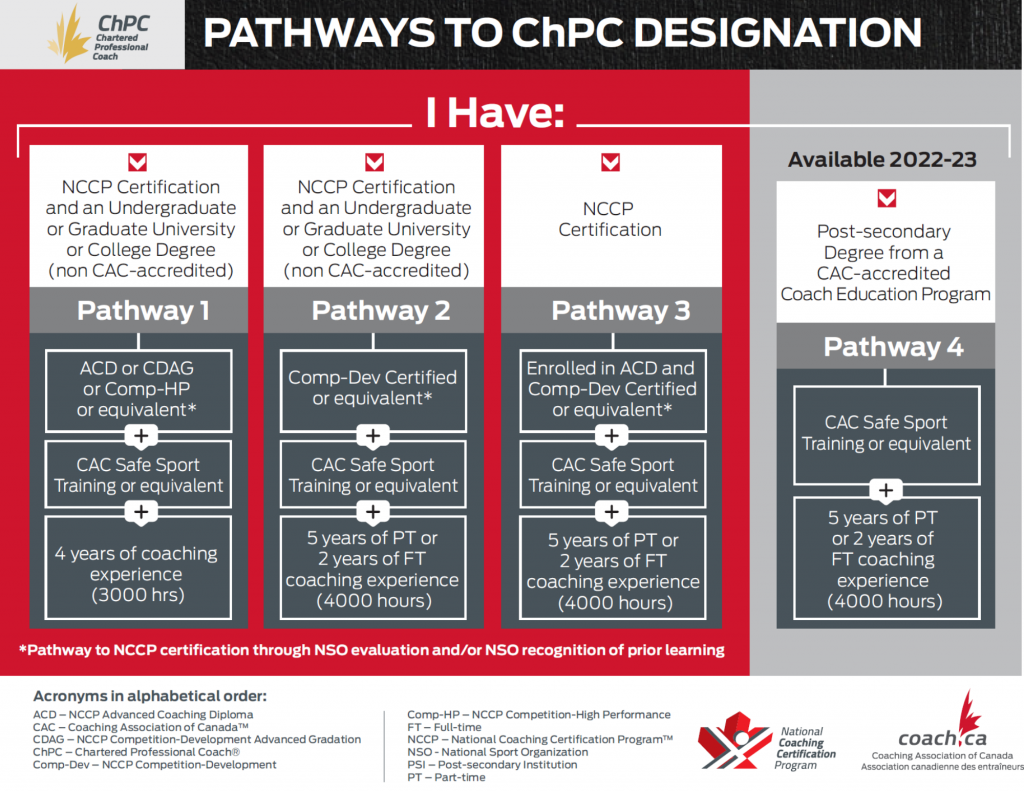
Eligibility:
It is important to understand the driving factors of safe sport and the cultural renovation that sport is currently facing around the world. For centuries, sport has been a building block of society by creating a sense of belonging between different groups of people. In Canada, sport is deeply rooted in Canadian culture as it allows diverse individuals to share a common ground, communicate through a shared passion, and even reconcile differences. Simply put, sport can change lives. Therefore, we see sport as a catalyst for positive change in the world and are convinced of the importance to protect the people it involves. Culture is about people, and people are increasingly desiring to participate in holistic experiences that serve a greater purpose. This means that it has become even more important for individuals to engage meaningfully with their communities and different organizations. Because of societal shifts like these, the development of sport and the rules that govern it have been directly impacted.
Video provided by Brock University Centre for Sport Capacity. Used with permission. [Transcript]
According to the basic tenets of the socio-ecological model, everyone has a role to play in the movement towards safe sport. This model demonstrates the overlapping influence that numerous people and organizations have over safe sport outcomes. For example, Register-Mihalik et. al. argue that this model offers different avenues for understanding the interplay between different levels of society and sport, which can be used to provide education towards preventing sport-related concussions.Register-Mihalik et al., 2017 If we use this same model to identify the risk factors in broader safe sport issues, we can better target the ways in which the community beyond the athlete and coach, such as the sport organizers and government legislators, can impact the implementation of safe sport in the years to come.

Athlete empowerment is critical in understanding the shift from traditional to contemporary sport. Traditionally, athlete voices were absent from conversations in sport as the authority was held by individuals such as coaches, officials, and general managers. This power differential potentially created an unsafe environment for athletes. In some instances, athletes were taught to normalize abusive language, excessive amounts of physical activity as punishment, and in some cases inappropriate or unnecessary touching.Kerr et al., 2019
This is not to suggest that all coach-athlete relationships were harmful, but there have been patterns of abuse in the sport system. However, with the proliferation of modern forms of communication such as social media, athletes have begun to acquire their own voice. Social media has created a space for athletes to share their stories of maltreatment and become advocates for change in areas of sport that require attention. In a contemporary sport model, the athlete and coach co-create the expectations and accountability to performance goals.
Another contributor to the culture shift that sport currently faces is the push for psychological safety. Traditional coaching followed the concept that the coach is the director of the program and makes the decisions. However, athlete empowerment has fostered a transition towards a more contemporary style of coaching that allows athletes to co-create their experience and use their voice, expertise, and opinions in a collaborative effort with coaches to achieve the same goal. Psychological safety promotes the notion that no one will be punished or humiliated for speaking up with their ideas, concerns, or mistakes.Edmonson, 2019 This belief is sourced from the work of Harvard business professor Amy Edmondson, whose research focuses on psychological safety in the workplace, but the principle also applies to the sport world.
As young people mature and enter the workforce with these attitudes, such principles will inevitably impact all other aspects of life. As such, sport has a responsibility to provide a safe environment for sport actors to be vocal about their experiences and express their concerns and ideas around safe sport. Furthermore, there is a responsibility to train those in power (coaches, officials, directors) to respond with empathy, an openness to learn, and support for the individual. It is in these small interactions that safe sport can be achieved. The dynamic of the athlete-coach, coach-coach, coach-high-performance director (HPD), or HPD – CEO relationship influences whether or not psychological safety exists. The concept of win at all costs conflicts with safe sport and coaches are placed in difficult situations to support their athletes and keep their jobs by a results-driven model. Performance and psychological safety can co-exist, but this requires a culture shift.
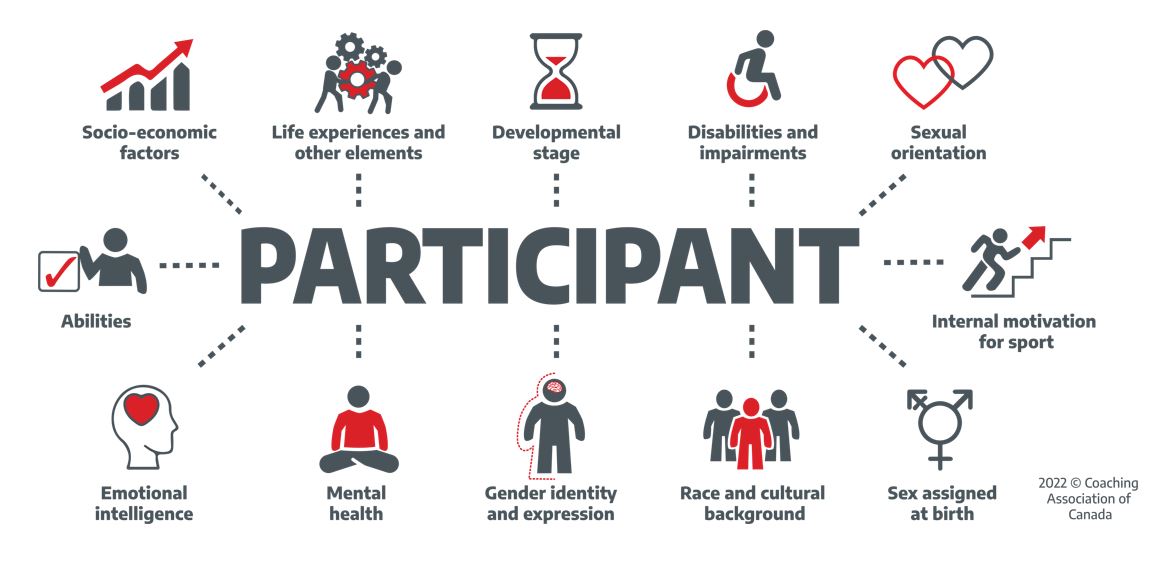
Another factor contributing to the culture shift that sport currently faces is recognizing the uniqueness of athletes as individuals. This means that every individual responds to coaching in different ways. The traditional coaching style may work for some athletes who may see extreme exercise, for example, as a valuable lesson or a push to make them stronger. However, others may see it as harmful to their physical and mental health and ultimately ineffective on their overall performance. Understanding the fine line between pushing athletes to reach their goals while ensuring that they are not being harmed in the process is a challenging task that coaches are faced with today. As such, providing coach education on empathy, openness to learning, and how to identify unique differences between athletes is integral to ensuring safe sport. During this transition, it is important to note that coaches are participating in this culture shift and learning alongside everyone else. Even at the highest level of basketball in the world, Toronto Raptors coach Brittni Donaldson posted to Twitter asking for advice on how to ensure that athletes are being pushed but are not harming themselves in the process. As these examples suggest, a “one size fits all’ approach to coaching will not be acceptable to the new generation of athletes. In short, know your athlete.
Actions Taken Towards Safe Sport
Since 2014, the CAC has experienced a number of important milestones in its movement towards achieving safe sport for all. Here are some of the highlights.
The CAC-led safe sport summits have been key in understanding the concerns of sport stakeholders of provincial/territorial and grassroots sports organizations including sport leaders, sport administrators, coaches, officials, and volunteers. In 2015, an NSO Sexual Abuse in Sport Summit was led by the CAC and the Canadian Centre for Ethics in Sport (CCES). This summit focused on the need to raise the awareness and expectations of ensuring the safety and protection of all participants in sport. In this summit, the personal story of Manitoba hockey player Sheldon Kennedy was shared, including some of the reasons why his sexual abuse as a minor in the 1980s was not revealed until years later. There were discussions about Kennedy’s work in founding Respect Group and the subsequent Respect in Sport training that was developed and has since been accessed by over 1.7 million people in sport in Canada. This summit also covered the lessons learned from Scouts Canada, conversations about legal counsel for safe sport issues, and understanding vicarious liability.


“Ex-ski coach Bertrand Charest gets 12-year prison sentence” by Morgan Lowrie, Globe and Mail, Dec. 8, 2017.
In the winter of 2014-2015, Canadian alpine ski coach Bertrand Charest was charged with fifty-seven counts of sexual abuse/exploitation over approximately twenty years. Of those fifty-seven victims, twelve were under the age of eighteen. In addition to working his way through club and provincial level organizations, Charest also worked with the national level Alpine Canada between 1996 and 1998. This was the tipping point that led to the hosting of a sport summit for NSOs in 2015, led by the CAC and the Canadian Centre for Ethics in Sport.
Following the 2015 NSO summit in partnership with the CCES, there was a clear desire on behalf of the sport partners for continued leadership in safe sport to decrease incidents of maltreatment. These concerns ultimately led to the Responsible Coaching Movement (RCM). The CAC is committed to working with all sport organizations to adopt and implement supportive policies and processes to ensure safety and protection of athletes and coaches, which is why we lead the multi-phase, system-wide RCM in partnership with the CCES. With their support along with that of the national sport system, the RCM was launched in 2016, and to date over 900 sport organizations have taken the pledge to apply its three pillars to their daily operations. These pillars include the rule of two, background screening, and ethics training.
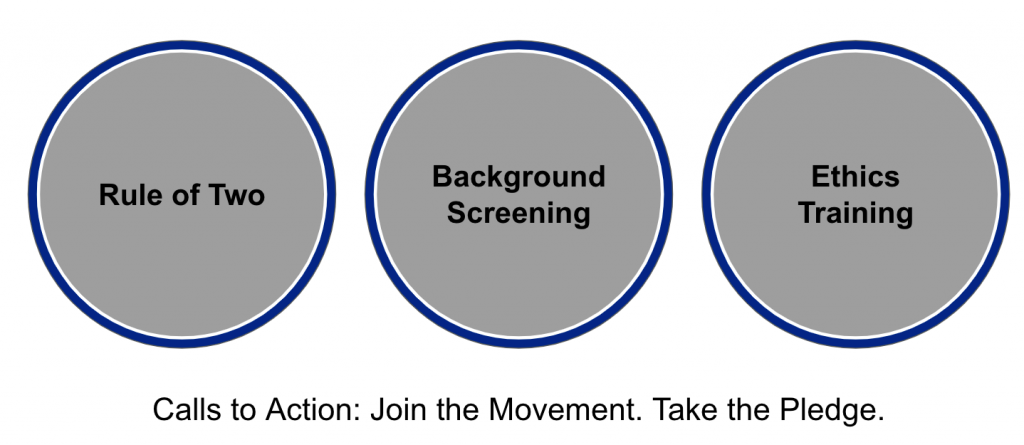
The Rule of Two is a duty of care to ensure that all interactions between athletes and their coaches are open, observable, and justifiable. An open environment is one in which people can be seen and heard such as a meeting in a room with windows and an open door. A hotel room or car is an example of a closed environment. An observable environment is one in which parents and guardians or other people can see and hear participants practicing their sport, such as a glass window, open gym, arena, pool, etc. A justifiable environment is one in which it would be normal to see people like a coach and athlete together practicing sport such as in a gym, on the ice, on a field. A place that might not be justifiable is a coffee shop. While it is open and observable, it may not be justifiable.
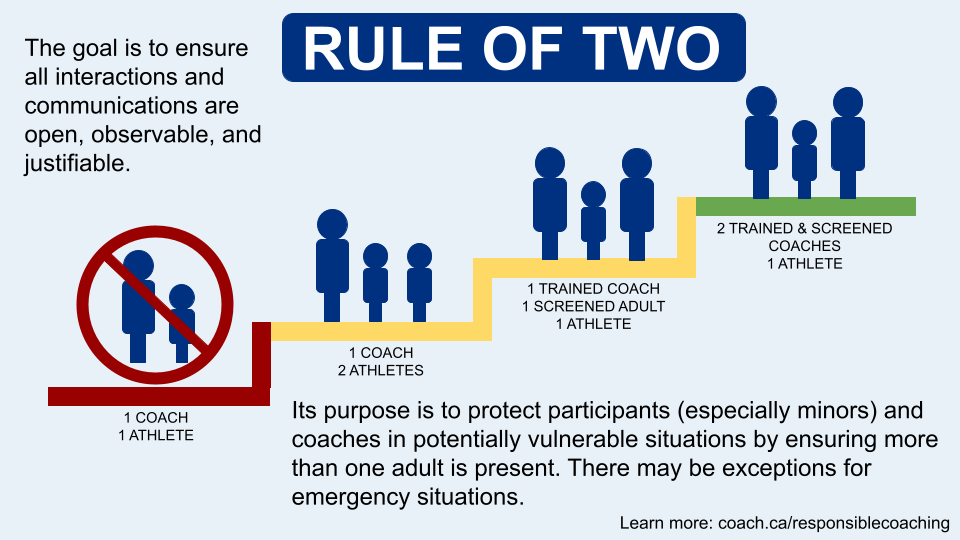
Background screening ensures that applicants to a sport organization such as employees, coaches and volunteers meet the important requirements to participate in sport activities. Screening includes comprehensive job postings, visible policies and processes, police information record checks, interviews, and reference checks, all of which are equally important. Organizations are encouraged to determine the level of risk of an applicant and define and document how they will screen candidates.
The final piece of the RCM includes ethics training. This training is the NCCP Make Ethical Decisions (MED) eLearning module. Ethics training intends to equip coaches with the confidence and skills required to handle ethical and legal situations by applying a six-step process. MED training is required to be an NCCP trained coach, and the MED evaluation is required to be an NCCP certified coach.
In February 2019, the Red Deer Declaration was signed at the Conference of Federal-Provincial-Territorial Ministers Responsible for Sport, Physical Activity, and Recreation. This declaration was a signed promise by sport ministers to commit to the prevention of harassment, abuse and discrimination in sport.
A series of thirteen CAC-led provincial and territorial safe sport summits were then held across the nation between March-April 2019. These summits were organized for stakeholders in Canadian sport to review the definition of harassment and abuse and to provide input on considerations for creating and implementing a universal code for safe sport.
These summits led to the federal-provincial-territorial agreement that all federally funded sport organizations would align with the Universal Code of Conduct to Prevent and Address Maltreatment in Sport (UCCMS) and implement the following:
The CAC’s work on the implementation of the RCM built the foundation for additional legislative changes made by Canada’s then-Minister of Sport Kirsty Duncan in 2018 and 2019. In 2020, the UCCMS was launched as the culminating document with which sport organizations can address and prevent maltreatment, much of it based on the recommendations that arose from these summits.
In March and April of 2020, over 25 coach interviews were conducted to determine the major topics that were to be addressed at the regional safe sport summits that year, despite the onset of Covid-19. Four regional safe sport summits were held virtually from August-September, held in partnership with the Canadian Sport Institutes and Centres delivering the NCCP Advanced Coaching Diploma. There was support for updates to be made to the Advanced Coaching Diploma by embedding safe sport principles into the curriculum. The top coaching concerns that arose in these discussions were:
Finally, on September 22, 2020, the CAC and Own the Podium hosted a National Coach Safe Sport Summit that included 188 participants. There were five main needs addressed:
Have a look at the timeline below to familiarize yourself with the safe sport-driven events that happened between 2015-2021. (Please note some of these are also highlighted in the Key Dates timeline at the beginning of the chapter.)
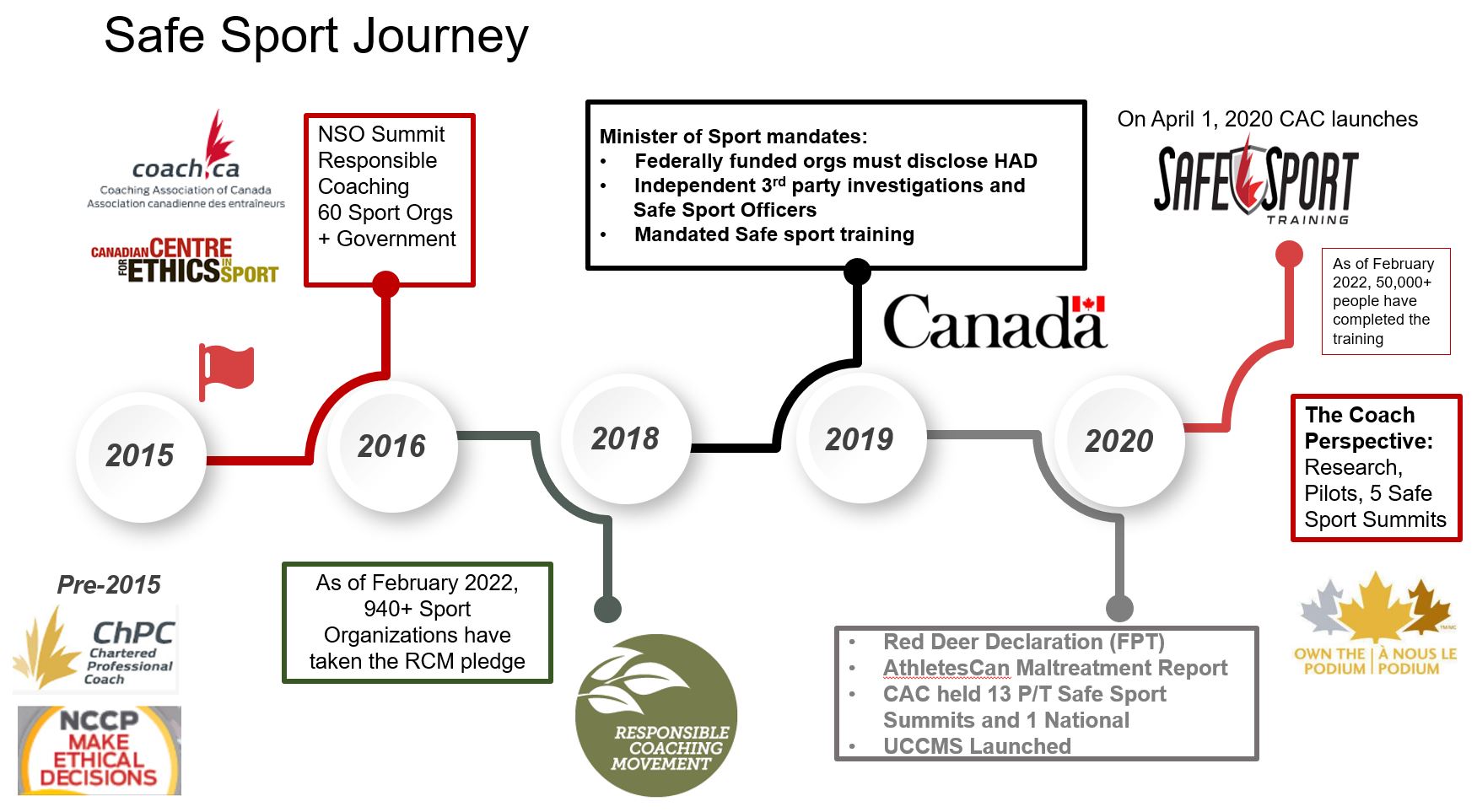
One of the main recommendations put forward by coaches and sport organizers has been to put the dialogue surrounding safe sport into practice. Today, the CAC continues their dedication to supporting the implementation of the Universal Code of Conduct to Prevent and Address Maltreatment in Sport (UCCMS) by offering the following programs and initiatives.
As of February 2022, over 940 sport organizations have taken the pledge to align their practices with the RCM’s three main pillars by ensuring the rule of two, implementing background screening and applying ethical training.
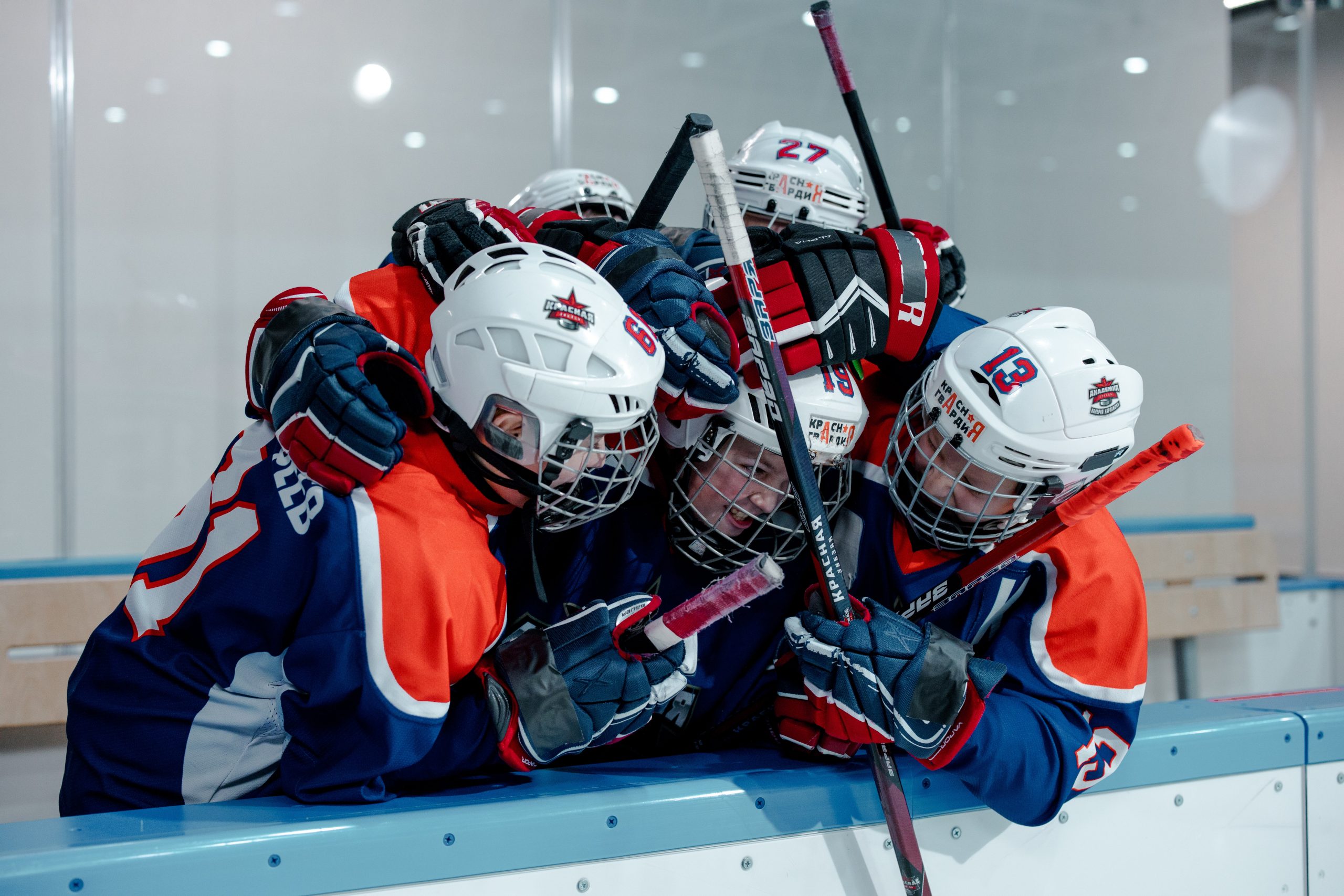
The CAC has also collaborated with the Canadian Centre for Child Protection (CCCP) that launched the Commit to Kids for Coaches training which focuses on the topic of grooming, how to recognize it, how to report it, and how to be proactive against it. Additionally, the CAC’s five-year partnership with Kids Help Phone is an initiative geared towards athletes themselves by offering valuable support services and resources to young people within the sport community in Canada.
By organizing multiple safe sport summits for sport stakeholders, the CAC continues to push for dialogue towards achieving greater safe sport goals.
Following the impactful safe sport events detailed in the timeline above, Sport Canada mandated safe sport training and the CAC launched the free eLearning module on April 1, 2020. In alignment with the requirements of the UCCMS, the training is required for federally funded national sport organizations and specifically for athletes, people in direct contact with athletes, and decision-makers. The UCCMS training includes understanding the definitions of maltreatment, duty to report, third party independent reporting and investigations process, decisions, appeals and record keeping. The requirement presented no cost to the national sport system because it was funded by Sport Canada. As of February 2022, over 50,000 people have taken the CAC Safe Sport training.
Since 2015, the safe sport summits along with the RCM and other key events led to the creation of a Sport Safety Department for the CAC. In 2018 a Manager, Diversity and Inclusion was created. In 2020, this led to the creation of a Director, Sport Safety position which is comprised of three pillars: Equity, Diversity and Inclusion, Professional Coaching, and Safe Sport/Responsible Coaching Movement. The department is supported by a Manager, Sport Safety, Coordinator, Diversity and Inclusion and Coordinator, Professional Coaching. The Professional Coaching Program is aligned with the RCM as it requires coaches to be trained in ethics, complete an enhanced police information check, provide references, and read, agree to, and sign the CAC Code of Conduct and Ethics.
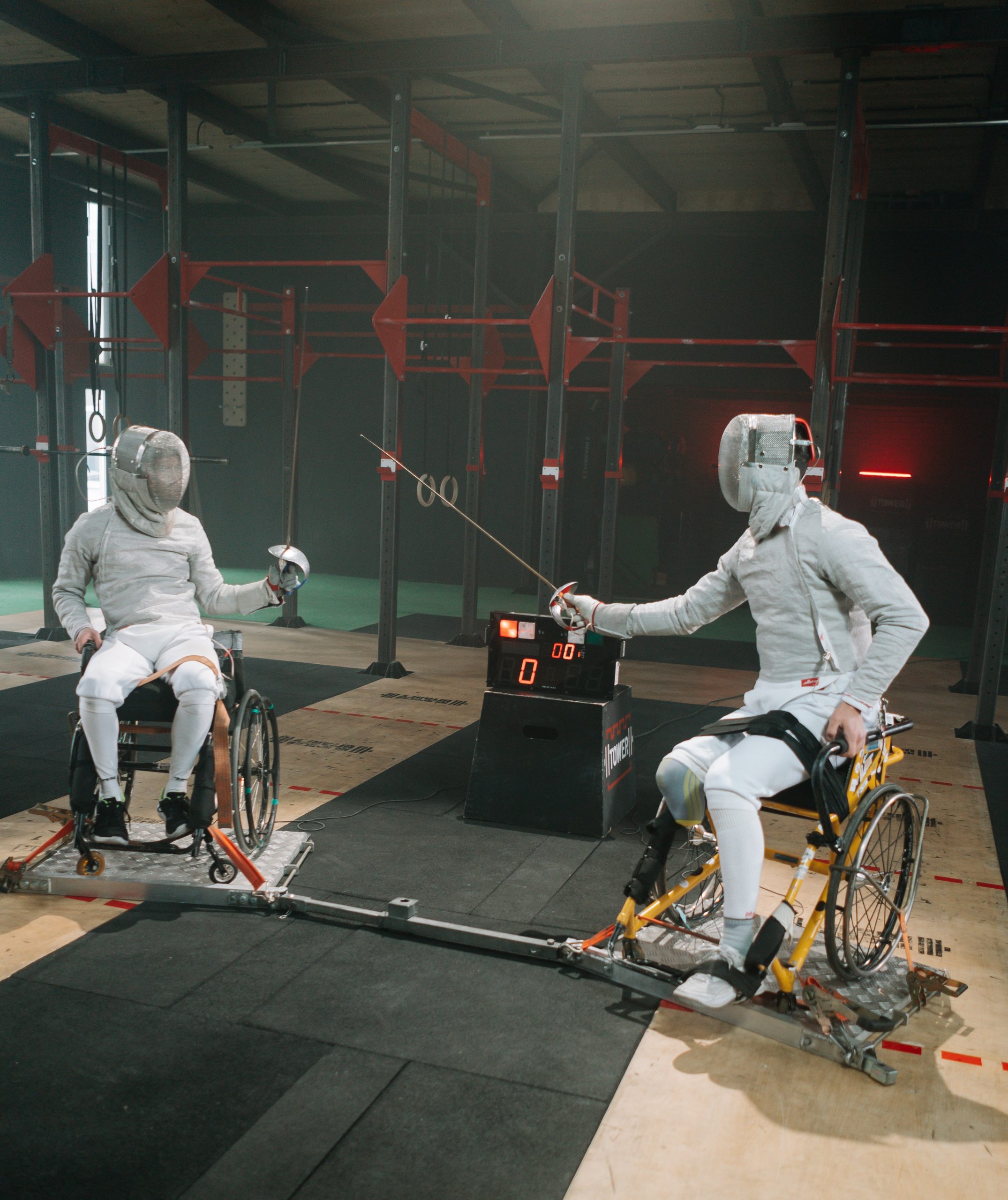
In 2021, the CAC completed a safe sport review that aimed to understand coaches’ perceptions on safe sport through one-on-one interviews with 76 participants and online surveys with over 500 participants.CAC, 2021 Most coaches indicated they are familiar with their organization’s Code of Conduct and have reviewed it within the last year. It was clear that most coaches do believe safe sport is a priority within their sport, and they saw many positive aspects of safe sport, including educating various groups (athletes, coaches, parents). There was an element of fear and concern expressed by coaches regarding the potential for defamation that could result from the complaint process as it is currently perceived to be more in favor of athletes, not coaches. While most coaches concur that safe sport and high-performance can be integrated, they also think that there should be a separate definition of safe sport for high-performance. Coaches are confused by the different messages they have received on safe sport, so it is important to ensure that messaging coming from one or several sources is consistent and in line with best practices in safe sport. Recommendations are offered for sport organizations and the CAC.
The recommendations for sport organizations that arose from this review include implementation of a complaints process, offering communication and support, ensuring the rule of two and effective travel procedures, and establishing system-wide implementation of these goals. There were more specific recommendations for the CAC, as coaches asked for tools and resources on having difficult conversations, high-performance sport, para-sport and the Special Olympics, equity, diversity & inclusion, dealing with stakeholders outside of NSOs, educating other stakeholders, and navigating cultural differences.
The CAC offers an array of resources for sport organizers including various online training and workshops, pamphlets and infographics as educational and marketing tools, and a central website offering access to other important resources offered by Canadian NSOs and PTSOs. The cornerstone module of the NCCP is NCCP Make Ethical Decisions, which guides coaches through a 6-step ethical decision-making model, as well as a model on making decisions that are legal in nature, or where child protection services may be required. The training module is delivered by the PTCR as a workshop, and coaches are also evaluated on the content through an eLearning module hosted in the CAC Locker, which is a central online portal that maintains the records of coach training offered through the NCCP and its partners. The CAC works collaboratively with 65 NSOs and their provincial-territorial partners to support and facilitate the development and delivery of NCCP sport-specific training and certification programs for those looking to coach sports from bowling to soccer.
The CAC has also implemented “Communities of Practice (CoP)”, which is a high-value, low-cost initiative to connect people with a passion for learning, developing, and growing together related to their practice.CAC, n.d.a Whether that learning is focused on supporting professional development, advancing women’s leadership capacities in sport, or developing the learning capabilities of parasport coaches, a CoP can be a cost-effective way to impact learning and change. The CAC and the University of Ottawa have collaborated to prepare a model that provides sport organizations with a step-by-step approach to plan, train, design, implement, assess and maintain a Community of Practice focused on supporting long-term change. The model is for any organization implementing an initiative to support collective learning and will suggest tips, questions to consider, and will guide users through the process.
Another important initiative to note is the CAC’s work in targeting gender-based violence. In 2019, the CAC received funding from the Public Health Agency of Canada to target the problem of gender-based violence and teen dating violence. With this support, we developed and launched four modules entitled “Support Through Sport Series.” The first of the four modules in this series is “Understanding Teen Dating Violence,” which launched on June 1, 2021 and is a powerful resource for coaches to identify teen dating violence and support their participants and model healthy relationships. The three remaining modules will launch on June 1, 2022 and include Bystander Empowerment, Gender-based Violence in Sport, and Modelling Healthy Relationships.
Video provided by Brock University Centre for Sport Capacity. Used with permission. [Transcript]
Our recent safe sport review showed us that coaches are looking for more specific tools and resources in a number of areas. In response to the recommendations from this review, the CAC is currently offering coaches new eLearning modules including “Understanding the Rule of Two” and “Anti-Racism in Coaching”. The CAC is also offering a full RCM refresh complete with an informational video and national campaign to expand the reach of this movement to the larger sport community. In addition, other NCCP modules that launched in early 2021 are Leading a Return to Sport and Mental Health in Sport.
The most recent safe sport module released by the CAC was NCCP Creating a Positive Sport Environment, released in October, 2021. This module covers some elements of maltreatment in sport, but serves to focus on how to use positive coaching strategies to create a positive sport environment, enhance safety, and improve learning and performance. A section on having difficult conversations is included within the module to provide additional tools for coaches.
It is our hope that by continuing to build educational resources and preventive practices that we can continue to lead in the journey towards achieving safer sport in Canada.

“Be mindful of your individual impact and your power to make change happen.”
-Author Unknown
Coaching Association of Canada (CAC). (n.d.a). Communities of practice – A how-to model. Retrieved December 9, 2021, from https://coach.ca/communities-practice-how-model
CAC. (n.d.b). Leading a return to sport participation. Retrieved December 9, 2021, from https://coach.ca/leading-return-sport-participation
CAC. (n.d.c). Mental health in sport. Retrieved December 9, 2021, from https://coach.ca/mental-health-sport
CAC. (n.d.d). NCCP creating a positive sport environment. Retrieved December 9, 2021, from https://coach.ca/nccp-creating-positive-sport-environment
CAC. (n.d.e). NCCP makes ethical decision. Retrieved December 9, 2021, from https://coach.ca/nccp-make-ethical-decisions
CAC. (2020, April 3). Safe sport training promo [Video]. Youtube. https://www.youtube.com/watch?v=DPhwZZ6x2uM
CAC. (2021, September 10). Safe sport review. Retrieved December 9, 2021, from https://coach.ca/safe-sport-review
Campbell, M. (2021, August 18). Exploiting Osaka’s vulnerability isn’t a solution to media’s swindling access. CBC Sports. Retrieved December 9, 2021, form https://www.cbc.ca/sports/opinion-naomi-osaka-media-1.6144374
Canadian Intergovernmental Conference Secretariat. (2019, February 15). Red Deer Declaration – For the prevention of harassment, abuse and discrimination in sport. Retrieved December 9, 2021, from http://scics.ca/en/product-produit/red-deer-declaration-for-the-prevention-of-harassment-abuse-and-discrimination-in-sport/
Donaldson, B [@brittni_d]. (2021, May 24). Coaches/Trainers/Mental Performance Specialists – would love to know any best practices around how you balance encouraging your athletes to dig deep & persevere through adversity (such an important lesson), yet ensuring they are not harming themselves in the process [Tweet]. Twitter. https://twitter.com/brittni__d/status/1396872341569908736
Edmondson, A. C. (2019). The fearless organization: creating psychological safety in the workplace for learning, innovation, and growth. Wiley.
Fendrich, H. (2021, May 31). Naomi Osaka withdraws from French Open, says it’s the best thing’ for her well-being. The Associated Press. Retrieved December 9, 2021, from https://www.cbc.ca/sports/tennis/naomi-osaka-withdraws-french-open-1.6047177
Kerr, G., Willson, E., & Stirling, A. (2019). Prevalence of maltreatment among current and former national team athletes. University of Toronto. 1-51. https://athletescan.com/sites/default/files/images/prevalence_of_maltreatment_reporteng.pdf
Lowrie, M. (2017, December 8). Ex-ski coach Bertrand Charest gets 12-year prison sentence. The Canadian Press. Retrieved December 9, 2021, from https://www.theglobeandmail.com/sports/more-sports/ex-ski-coach-bertrand-charest-gets-12-year-prison-sentence/article37268149/
Register-Mihalik, J., Baugh, C., Kroshus, E., Kerr, Z. Y, Valovich McLeod, T. C. (2017). A multifactorial approach to sport-related concussion prevention and education: Application of the socioecological framework. Journal of Athletic Training, 52(3): 195-205. DOI: 10.4085/1062-6050-51.12.02
Safe Sport eReader. (2021a, December 3). Cayer 2 sport is in a culture renovation [Video]. Youtube. https://www.youtube.com/watch?v=Vc4-Dy0yBeo
Safe Sport eReader. (2021b, December 3). Cayer 3 support through sport series [Video]. Youtube. https://www.youtube.com/watch?v=9r_u0DUkTBg
VII
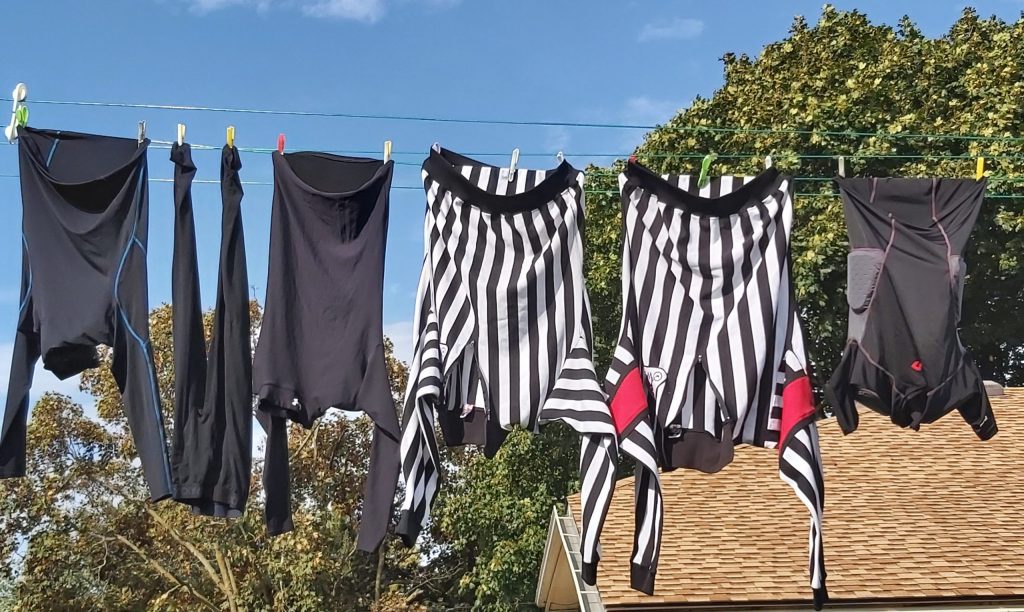
Part 7 of this reader contains two chapters written by two academic experts from Ontario Tech University, who both offer insight into the challenges faced by officials in sport and the ways in which officials can help make sport safer for all. Lori Livingston, PhD, teaches in the Faculty of Health Sciences and is also Provost and Vice-President Academic, and Susan Forbes, PhD, manages the Teaching & Learning Centre. Chapter 15 focuses on the purpose of rules and their role in creating safe playing environments. Chapter 16 outlines the role of officials as essentials parts of the sport ecosystem, how officials have been historically maltreated by spectators, coaches and athletes, and some key concepts and strategies that can be used to counter these issues.
15
Lori A. Livingston
Susan L. Forbes
Rules
Rules classification systems
Rule modification
When you have completed this chapter, you will be able to:
LO1 Identify the different types of sports rules;
LO2 Recognize which rules are intended to promote safe participation;
LO3 Identify who is responsible for ensuring safe sports;
LO4 Identify the role each participant has for following the rules to ensure safe sports; and
LO5 Identify how rules can be modified to ensure safe sports.
Rules play a critical role in imposing structure on sport competitions, thereby creating equitable and safe conditions under which proficiency in physical skills and strategic prowess can be effectively tested between competitors. This chapter introduces the reader to the purpose of rules, rule classification systems, and the importance of using objective data to guide additions to or modifications of existing rule sets. The creation of safe playing environments requires all sport participants including administrators, officials, coaches, players, other team management personnel, and spectators, to understand their obligation to know and abide by the rules of their sport.
An interactive H5P element has been excluded from this version of the text. You can view it online here:
https://ecampusontario.pressbooks.pub/safesport/?p=274#h5p-41
Sports represent games or competitions of physical ability which have been formalized (or codified) with the addition of rules.Livingston et al., 2020. The primary purpose of rules is to impose structure, thereby creating conditions under which proficiency in physical skills, fitness, and strategic prowess may be effectively tested between competitors.Torres, 2010. When implemented efficiently and fairly, rules allow all contestants equal opportunities to perform, excel, and challenge each other in tests of relative abilities.
Rules also aim to clearly delineate all of the necessary conditions for participants to remain unharmed and injury free while allowing for a degree of variability in athletes’ motor behaviours.Arias et al., 2011. Keeping sports safe through rule creation, implementation, and ongoing modification is important as the incidence of sport-related injuries – especially in collision sports such as ice hockey, football, wrestling, and Taekwondo – is a major public health concern.Anderson et al., 2020; Guillaume et al., 2021; Pal, 2020; Hammer et al., 2020. To truly understand the role that rules play in keeping sport safe, sport participants need to understand the purpose of rules as well as their personal obligations with respect to observing them.
In an earlier paper examining the topic of rule modification and rule enforcement as means to reducing injury in the sports of ice hockey, soccer, and basketball,Livingston & Forbes, 2003. we used Shogan’s (1988) rules taxonomy as a framework to group rules into meaningful categories. This rules taxonomy, or classification system, coincides with more recently proposed systems (e.g., Cudd, 2007; Bergmann Drewe, 2000) in that it essentially differentiates between two types of basic rules; that is, those that refer to either the external or internal logic of the sport.Arias et al., 2011. The basic structure of rule classification systems is illustrated in Figure 15.1.
An interactive H5P element has been excluded from this version of the text. You can view it online here:
https://ecampusontario.pressbooks.pub/safesport/?p=274#h5p-42
Rules categorized as regulatory, or pertaining to the external logic of the sport, make it possible to administer competitions efficiently. For example, uniform numbers and team line ups allow those keeping score to accurately record who scored and who assisted on a goal in a game of lacrosse. However, these functions are nonessential as the score could simply be recorded as total number of goals scored by either team without the statistical detail. To that end, regulatory rules may be viewed as nonessential or having minimal impact on a competition.
In contrast, the rules categorized as constitutive, or pertaining to the internal logic of the sport, define the criteria that mark the relationships between a competitor and the rest of their opponents, as well as game time, spaces, and equipment. Constitutive rules may be subcategorized as being descriptive, prescriptive, or proscriptive in nature. Descriptive rules, as their name implies, describe or quantify the temporal aspects of the competition (e.g., total game time or maximum routine duration), as well as the dimensions of the playing area, the number of athletes occupying the space, and the size, shape, material aspects, and weight of the equipment used.Arias et al., 2011; Shogan, 1988. Conceived another way, it is the descriptive rules that define the structural aspects of the competition.
However, prescriptive and proscriptive rules are functional in nature.Arias et al., 2011. They determine athletes’ acceptable actions or their obligations and rights within the playing environment. More specifically, prescriptive rules as their name implies, prescribe those actions which an individual may perform when engaged in a game. The breaking of such a rule is not a penalty but rather a loss of possession. For example, in the sport of basketball players are allowed a maximum number of steps when carrying the ball. If the player exceeds this limit, a skill violation (i.e., travelling) is called and the opposing team is awarded the ball.
Proscriptive rules differ in that they proscribe or prohibit harmful actions which a person must not engage in. The breaking of such a rule leads to the imposition of a penalty. In team sports characterized by body contact, proscriptive rules are used to limit both the nature and magnitude of such contact.
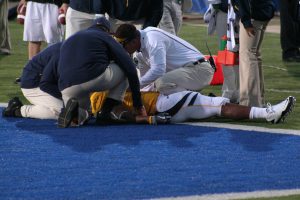
A good example of this comes from the sport of football where game legislators have implemented targeting rules (i.e., the act of taking aim and initiating contact with an opponent above the shoulders with the helmet, forearm, hand, fist, elbow, or shoulders) to control impacts between tacklers and otherwise defenseless players.Obana et al., 2021.
When thinking about the constitutive (or internal logic) rules of sport, it is easy for most people to understand that descriptive rules have always been part of sport. Less well known is that up until the early 20th century, rule sets were largely prescriptive in nature. They were focused on regulating the mechanisms of play with the goal of providing opportunities for individuals to participate to the best of their abilities while competing within an environment based on trust and fairness.Livingston et al., 2020.
For example, in the early 1900s in the sport of women’s field lacrosse, the 12 players per team would equally space themselves throughout the field as they ran, passed, and caught the ball and moved towards the opponent’s goal. The only limitation on player movement pertained to the goal crease area. This sport, which evolved in Great Britain, was the epitome of the ethos of fair play. However, in the late 1980s and early 1990s, it was not unusual at the World Cup level to see all 12 team players (or 24 players from two teams) occupying only the offensive or defensive half of the field. This led to considerable congestion in front of the goal cages and increases in the incidence of injuries caused by collisions between players or as a result of a ball or stick striking the body.
The rule makers had no option but to introduce prescriptive rules to limit the movements of players about the field and proscriptive rules to penalize those who insisted on standing in front of the goal while not actively marking an opponent. With the growth of commercialism and the rise of professional and semi-professional sports, winning has become the primary outcome of interest at all levels of sport. With this transformation came not only the need for more prescriptive rules about how to play, but also more proscriptive rules to manage participant behavioursCashmore, 2005. including those associated with competition induced injuries.

Participation in sport is recommended because of the health benefits associated with maintaining a physically active lifestyle even though such participation may also be associated with injury.Vriend et al., 2017. Rules in and of themselves cannot prevent all injuries from happening, but they may reduce the incidence or nature of the injuries being observed. As sports evolve, so too do their rule sets – by modifying existing rules or adding new ones – in an effort to keep competitions safe and as injury free as possible. In amateur sport, the task of reviewing existing rules lies with committees or panels of knowledge content experts convened by national or international sport governing bodies.
Professional sports organizations tend to conduct their own reviews with an eye to modifying rules to reduce injury as well as to satisfy their specific commercial interests. This is why the rules differ between professional and amateur competitions, and at the amateur level, between nationally- and internationally-sanctioned levels of play. The frequency with which these reviews take place varies (i.e., often occurring on annual, biennial, or quadrennial time frames), yet all decisions to modify rules need to be supported by objective data both prior to and following their implementation.
Case studies, and in particular those captured on video, can provide valuable information upon which to question existing competition rules and the environments in which sports occur. For example, on December 27, 1980, professional ice hockey player Mark Howe of the Philadelphia Flyers was impaled by the pointed metal centre base support post of the hockey net, suffering a catastrophic and almost career ending injury at the base of his spine. This led to a change in ice hockey goal net design now universally seen throughout the sport. In 2012, the tragic death of Canadian ski cross racer Nik Zorocic as a result of hitting the finish line post at an event in Grindelwald, Switzerland led to more stringent rules calling for greater distances between the finish line post, safety netting, and the elimination of hard objects such as large mounds of packed snow near the finish. In both of these instances, video evidence supported changes to the descriptive rules pertaining to the competition environments and the permanent fixtures found within them for the purposes of enhancing athlete safety. However, the gold standard for linking rules and rule modifications to enhanced sport safety necessarily relies on the science of epidemiology.
In 1982, the United States-based National Collegiate Athletic Association (NCAA) established the NCAA Injury Surveillance System with the aim of collecting exposure and injury data from a sample of NCAA colleges and universities.Kerr et al., 2018. For each injury event, an athletic trainer completes a detailed report on the athlete’s demographic information (e.g., age, sex, height, mass), the injury or condition (i.e., body site, diagnosis) and the circumstances (e.g., activity (i.e., sport, position), mechanism of injury (e.g., body contact, illegal behaviour, or rule violation), and event (i.e., competition or practice). A similar national reporting system for high schools in the United States (i.e., High School-Reporting Information Online or HS-RIO) was established later in 2005-2006.
Databases like these, and standalone studies which collect the same type of data, provide sports injury epidemiologists with information to perform the essential first step in describing at-risk sport populations in combination with their injury incidence and burden.van Mechelen et al., 1992. Importantly, epidemiological data and analyses have proven successful in driving rule modifications and hence reduced injury rates in youth contact sports. In rugby, for example, rules of the game regarding line-outs and scrums vary for different age groups.Anderson et al., 2020. Rule changes in youth football leagues, ones aimed at increasing touchbacks and reducing kick returns, have been associated with reduction in concussion injury rates.Wiebe et al., 2018.
Introducing new rules or modifying existing ones is an ongoing and evolving process in every sport. As well intended as such changes may be, they can at times lead to unanticipated or unexpected outcomes.Jankowski et al., 2020; Madera et al., 2017. The truth of the matter is that the effects of rule changes are rarely researched.Madera et al., 2017; Vriend et al., 2017. In addition, even the most rigorously conducted epidemiological studies may not account for additional or constantly evolving factors (e.g., geographical inconsistencies in concussion-related legislation) associated with injury incidence.Guillaume et al., 2021. However, interest in adopting more scientific approaches to understanding the anticipated and unanticipated effects of rule changes in sport has been on the rise over the past decade.
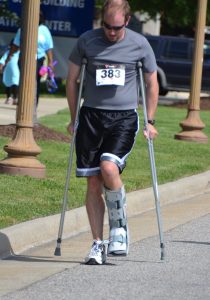
A sport injury epidemiologist studies the distribution (i.e., occurrence and frequency of occurrence) and determinants of sports injuries for the purpose of identifying and implementing measures to prevent their development.A sport injury epidemiologist studies the distribution (i.e., occurrence and frequency of occurrence) and determinants of sports injuries for the purpose of identifying and implementing measures to prevent their development (adapted from https://www.physio-pedia.com/Sport_Injury_Epidemiology)
Wright (2014) convincingly argues that the use of operational research methodologies, or data analytics, can illustrate what happens now under existing rule sets, what has happened as a result of changes made, and how to objectively proceed with making future changes. The pros and cons of differing statistical methodologies are discussed and illustrated by numerous examples of rule changes from a variety of sports (e.g., badminton, basketball, cricket, cycling, ice hockey, motor sports, rugby, soccer, etc.) at mostly the professional or semi-professional level. The author, moreover, importantly links proposals for rule alteration or modification to the differing motivations or objectives of those individuals or organizations pushing for change. These objectives range from that of enhancing participant safety and fairness within competitions to more commercially-related interests including rewards for winning and creating excitement for spectators.
The importance of relying on objective approaches to support creating new rules or modifying existing rules to keep sport safe cannot be overstated. They represent an important and fundamental strategy in the creation of safe sporting environments. However, even when supported by science, rule changes are proposed and driven by human beings who may allow subjective elements (e.g., commercial gain) to influence their thinking. More difficult to predict is how athletes and other sport participants may behaviourally respond to the new rules.
For example, at the 2012 Olympics, controversy arose over whether or not British track cyclist Philip Hindes deliberately crashed after a slow start to take advantage of a rule which allowed for a restart if a crash occurred in the first lap.Hills, 2012. While Hindes in this instance was not injured, the potential for injury to himself and other competitors was real. Hence, effective injury prevention strategies have to rely on more than the rules themselves. In sport, administrators, officials, coaches, athletes, and other support personnel must understand and appreciate how their behaviours and motivations to comply with or ignore the rules contribute to the creation of safe playing environments.
As outlined in the Universal Code of Conduct to Prevent and Address Maltreatment in Sport (UCCMS), keeping sport safe is a collective obligation. The rules provide structure and in so doing, aim to create fair and safe playing environments. Such an outcome can be reasonably expected when each individual recognizes their role, the responsibilities associated with their role, and their willingness to abide by the rules. This includes sport administrators, officials, coaches, other team personnel, the athletes, and the spectators. Rules are everyone’s responsibility.
Sport administrators play a critical role in creating an environment which supports the strengthening of rule-specific knowledge and skill sets and, thereby, participant safety. For example, they are responsible for ensuring that their organizations comply with local laws and mandated legislation (e.g., Rowan’s Law; prescreening requirements for vulnerable pediatric populations) and that those in positions of responsibility are supported in developing their rule-related knowledge bases. This includes the provision of educational workshops and seminars for officials and coaches, as well as opportunities for input into critical decision-making processes (e.g., rule-related discussions and deliberations). Many organizations, in addition, aim to educate others about the rules, including parents who make up a large part of the spectator pool at grassroots amateur sporting events. Unfortunately, the efficacy of these educational programs and efforts remains largely unknown because of a lack of routine program evaluations. In the absence of such evaluations, rules continue to be perceived as largely the domain of officials only.
Sport officials (e.g., referees, umpires, judges, commissaires, etc.) are tasked with the challenge of equitably enforcing the rules to keep sport safe. They must understand the importance of their role while at the same time being diligent in constantly honing their abilities to be an effective official in their sport of choice. They must be competent and ethical in applying the rules. Importantly the extent of their intervention is not and should not be dictated by their wants or desires, but rather by the behaviours of those involved in the athletic contest. If a prescriptive (e.g., travelling in basketball) or proscriptive (e.g., checking from behind in ice hockey) rule is broken, a call is made. If there is no breaking of the rules, the contest should continue. The important concept here is that the problematic behaviour has to occur first (i.e., a priori) before the official acts to enforce the rule (i.e., post hoc).
In a previous investigation, we demonstrated that several invasion games (i.e., basketball, ice hockey, and soccer) already had numerous rules in place to keep sport safe, while at the same time arguing the need for continuous improvement in lowering injury rates through rule modification.Livingston & Forbes, 2003. A key part of defining how effective any rule or rule modification may be, however, rests in part with participants understanding the rules and their responsibilities in the playing environment. In sport in general, there have been too many examples of athletes and their coaches not understanding, or simply ignoring, rules to keep athletes safe during the course of play.
While the lack of understanding can be somewhat managed through educational programming, opting to ignore the rules for unknown reasons is more problematic. It is difficult to accept the most flagrant and unexplainable of such actions, including two now somewhat historical but infamous incidents in the National Hockey League. These include a 1969 stick swinging fight between helmetless players Wayne Maki of the St. Louis Blues and Ted Green of the Boston Bruins that led to Green undergoing a lengthy operation to correct a depressed skull fracture.Deachman, 2020. A much later attack in 2000 when Marty McSorley of the Edmonton Oilers struck Vancouver Canuck Donald Brashear’s head with his stick, left the latter with a Grade 3 concussion.CBC, 2020. Both of these incidents, as well as many others, are well documented.
It is difficult to explain, or even understand, why some individuals opt to break the rules and especially so when the resulting injuries are catastrophic. In a compelling critical review of the influence of money on sport, Woelfel (2018) provides a well-articulated argument linking changing societal attitudes to the pursuit of lucrative professional contracts and endorsement opportunities, a pursuit that now begins in youth sport. The phenomenon, long ago described as the “professionalization of youth sport”,Brower, 1979. highlights the dominance of the win ethic, the privileging of the best athletes, and parents going into debt to support their children in the pursuit of professional sport success. Unfortunately, sport by its very nature places athletes within codified environments which are destined to declare a single winner from a pool of many competitors. The simple but now largely disregarded or lost perspective is that not everyone can win.
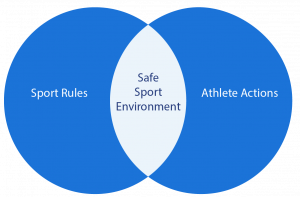
There is no simple answer or obvious solution when it comes to asking all sport participants to respect the rules of the sport in which they participate but sport researchers, now and into the future, need to problematize this issue and seek a solution. What needs to be broadly understood is that rules exist and they exist for two primary reasons; that is, to create fair and equitable competition environments while also aiming to keep all participants safe. We argue that the best way forward is for sport researchers to understand that the addition of new rules and rule modifications need to be supported by solid objective evidence while at same time acknowledging the subjective reasons as to why sport participants opt to obey or disobey the rules. Only when these two perspectives are brought together will we gain a true appreciation for the role that rules play in keeping sport safe and fun for all.
 Record Your Response An interactive H5P element has been excluded from this version of the text. You can view it online here:
Record Your Response An interactive H5P element has been excluded from this version of the text. You can view it online here:
Future Research
One area not sufficiently explored to date is the relationship between injuries and officiating decisions during competition. Work by Anderson et. al, (2018) provides an earlier example and includes the use of technology for investigative purposes but more needs to be done. See “Video analysis of acute injuries and referee decisions during the 24th Men’s Handball World Championship 2015 in Qatar.“
Key Terms
An interactive H5P element has been excluded from this version of the text. You can view it online here:
https://ecampusontario.pressbooks.pub/safesport/?p=274#h5p-44
Suggested Assignments
1. How safe is your sport?
Review the rules of your sport and categorize them using the taxonomy presented in this chapter. Which rules relate directly to injury prevention?
2. Which sport is safest?
Choose three similar sports such as invasion sports (e.g. hockey, soccer, rugby) or combat sports (e.g. boxing, judo, karate). Identify and compare their safety-oriented rules, then compare their injury rates. Which sport is the safest and how do their rules match up to their level of safety?
3. Are rule changes making sports safer?
Design a research study where you study a sport that made rules changes, modifications, and/or additions to improve safety. How would you determine if those changes were effective?
Image Descriptions
Figure 15.1 This figure illustrates the key components of Shogan’s (1988) rules classification system or taxonomy. [return to text]
Figure 15.2 This figure is a simple venn diagram illustrating the safe sport environment. On the outside are sport rules and athlete actions, which overlap and hold the text “safe sport environment.” [return to text]
Sources
Anderson, D. S., Cathcart, J., Wilson, I., Hides, J., Leung, F., & Kerr, D. (2020). Lower limb MSK injuries among school-aged rugby and football players: A systematic review. BMJ Open Sport & Exercise Medicine, 6(1), e000806–e000806. https://doi.org/10.1136/bmjsem-2020-000806
Arias, J. L., Argudo, F. M., & Alonso, J. I. (2011). Review of rule modification in sport. Journal of Sports Science & Medicine, 10(1), 1–8.
Drewe, S. B. (2000). The logical connection between moral education and physical education. Journal of Curriculum Studies, 32(4), 561–573. https://doi.org/10.1080/00220270050033628
Bouzane, B. (2012, March 10). Canadian ski cross racer Nik Zoricic dies following crash in Switzerland. The National Post. Retrieved November 12, 2021, from https://nationalpost.com/sports/canadian-skicross-racer-nick-zoricic-dies-following-crash-in-switzerland
Brower, J. (1979). The professionalization of organized youth sport: Social psychological impacts and outcomes. The Annals of the American Academy of Political and Social Science, 445(1), 39–46. https://doi.org/10.1177/000271627944500106
Canadian Broadcasting Corporation (CBC). (2000, March 8). Bruins’ Marty McSorley charged with assault. Retrieved November 12, 2021, from https://www.cbc.ca/sports/bruins-marty-mcsorley-charged-with-assault-1.200872
Cashmore, E. (2005). Making sense of sports (4th ed.). London: Routledge.
Chen, I. (2020, February 1). Exactly how dangerous is football?. The New Yorker. Retrieved November 12, 2021, from https://www.newyorker.com/culture/annals-of-inquiry/exactly-how-dangerous-is-football
Cudd, A. E. (2007). Sporting metaphors: Competition and the ethos of capitalism. Journal of the Philosophy of Sport, 34(1), 52–67. https://doi.org/10.1080/00948705.2007.9714709
Custance, C. (2011, November 10). Mark Howe’s journey all his own. ESPN. Retrieved November 12, 2021, from https://www.espn.com/nhl/halloffame11/story/_/id/7216908/2011-hockey-hall-fame-look-inductee-mark-howe
Deachman, B. (2020, September 21). That was then: Ottawa hosts exhibition of NHL violence. Ottawa Citizen. Retrieved November 12, 2021, from https://ottawacitizen.com/news/local-news/that-was-then-ottawa-hosts-exhibition-of-nhl-violence
Government of Ontario. (2021). Rowan’s law: Concussion safety. Retrieved November 12, 2021, from https://www.ontario.ca/page/rowans-law-concussion-safety
Guillaume, S., Lincoln, A. E., Hepburn, L., Caswell, S. V., & Kerr, Z. Y. (2021). Rule modifications to reduce checking-related injuries in high school boys’ lacrosse. Journal of Athletic Training, 56(4), 437–445. https://doi.org/10.4085/1062-6050-0489.19
Hammer, E., Brooks, M. A., Hetzel, S., Arakkal, A., & Comstock, R. D. (2020). Epidemiology of injuries sustained in boys’ high school contact and collision sports, 2008-2009 through 2012-2013. Orthopaedic Journal of Sports Medicine, 8(2), 2325967120903699–2325967120903699. https://doi.org/10.1177/2325967120903699
Hills, D. (2012, August 3). Olympic cycling: Philip Hindes crash admission ‘lost in translation’. The Guardian. Retrieved November 12, 2021, from https://www.theguardian.com/sport/2012/aug/03/london-2012-philip-hindes-crash-translation
Janowski, M., Zielinski, J., Ciekot-Soltysiak, M., Schneider, A., & Kusy, K. (2020). The effect of sports rules amendments on exercise intensity during Taekwondo-specific workouts. International Journal of Environmental Research and Public Health, 17(18), 6779–. https://doi.org/10.3390/ijerph17186779
Kerr, Z. Y., Comstock, R. D., Dompier, T. P., & Marshall, S. W. (2018). The first decade of web-based sports injury surveillance (2004-2005 through 2013-2014): Methods of the National Collegiate Athletic Association injury surveillance program and high school reporting information online. Journal of Athletic Training, 53(8), 729–737. https://doi.org/10.4085/1062-6050-143-17
Livingston, L. A., & Forbes, S. L. (2003). Rule modification and strict rule enforcement as a means of reducing injury in invasion games. Avante, 8, 12-20.
Livingston, L. A., Forbes, S. L., Wattie, N., & Cunningham, I. (2020). Sport officiating: Recruitment, development, and retention. London: Routledge.
Madera, J., Tella, V., & Saavedra, J. M. (2017). Effects of rule changes on game-related statistics in men’s water polo matches. Sports (Basel), 5(4), 84–. https://doi.org/10.3390/sports5040084
Obana, K. K., Mueller, J. D., Zhong, J. R., Saltzman, B. M., Lynch, T. S., Parisien, R. L., Ahmad, C. S., & Trofa, D. P. (2021). Targeting rule implementation decreases neck injuries in high school football: A national injury surveillance study. The Physician and Sportsmedicine, 1–5. https://doi.org/10.1080/00913847.2021.1932630
Ontario Rural Softball Association. (2021, July 1). Statement of Safe Sport. https://www.ontarioruralsoftballassociation.ca/wp-content/uploads/2021/08/ORSA-Safe-Sport-Policy-Manual-1-july-2021.pdf
Pal. S. (2020). Preventive methods for case series karate injuries- a review. Journal of Clinical and Diagnostic Research, 14(10), YE09–YE12. https://doi.org/10.7860/JCDR/2020/45510.14154
Puzic, S. (2012, April 23). Skier Nik Zoricic’s death not ‘freak accident’: Family. CTV News. Retrieved November 12, 2021, from https://www.ctvnews.ca/skier-nik-zoricic-s-death-not-freak-accident-family-1.800060
Shogan, D. (1988). Rules, penalties, and officials: Sport and the legality-morality distinction. CAHPERD Journal, 54(6), 6-11.
The Canadian Press. (2014, March 10). Nik Zoricic family feels vindicated by FIS findings. CBC Sports. Retrieved November 12, 2021, from https://www.cbc.ca/sports/olympics/winter/skiing/nik-zoricic-family-feels-vindicated-by-fis-findings-1.2567048
The Hockey History Blog. (2013, January 14). Wayne Maki and the terrible stick swinging incident. Retrieved November 12, 2021, from http://www.greatesthockeylegends.com/2013/01/wayne-maki-and-terrible-stick-swinging.html
Torres, C. R. (2010). The danger of selectively changing the rules in youth sport: The case of the strike zone. Journal of Physical Education, Recreation & Dance, 81(5), 29–34. https://doi.org/10.1080/07303084.2010.10598477
van Mechelen, W., Hlobil, H., & Kemper, H. C. (1992). Incidence, severity, aetiology and prevention of sports injuries: A review of concepts. Sports medicine, 14(2), 82–99. https://doi.org/10.2165/00007256-199214020-00002
Vriend, I., Gouttebarge, V., Finch, C. F., van Mechelen, W., & Verhagen, E. A. L. M. (2017). Intervention strategies used in sport injury prevention studies: A systematic review identifying studies applying the Haddon Matrix. Sports Medicine, 47(10), 2027–2043. https://doi.org/10.1007/s40279-017-0718-y
Wiebe, D. J., D’Alonzo, B. A., Harris, R., Putukian, M., & Campbell-McGovern, C. (2018). Association between the experimental kickoff rule and concussion rates in Ivy League football. Journal of the American Medical Association, 320(19), 2035–2036. https://doi.org/10.1001/jama.2018.14165
Woefel, R. (2018, May). Money ball. Referee Magazine, 43(5), 58-63.
Wright, M. (2014). OR analysis of sporting rules – a survey. European Journal of Operational Research, 232(1), 1-8.
16
Susan L. Forbes
Lori A. Livingston
Safe sport environment
Equity, diversity and inclusion
Institutionalized sport culture
When you have completed this chapter, you will be able to:
LO1 Critically examine sociocultural factors that create a less than inclusive officiating environment;
L02 Identify key components of effective officiating education and training programs; and
L03 Identify the barriers to an inclusive sports environment.
Sport officials play a critical role in upholding both the spirit and the letter of the laws (or rules) to ensure that all competitors are given an opportunity to compete in a predictable and safe environment that is both fair and equitable. They are an essential part of the sport ecosystem, yet they have been historically marginalized and besmirched as sports’ “necessary villains.” This prevailing culture continues today with officials finding themselves challenged by angry athletes, coaches, and spectators, and with these situations often escalating into harmful verbal and physical confrontations. This chapter begins with a brief review of the factors which contribute to unsafe environments for officials, followed by the presentation of key concepts and strategies to counter this problem. Importantly, the creation of equitable, diverse, and inclusive sport environments is the key.
An interactive H5P element has been excluded from this version of the text. You can view it online here:
https://ecampusontario.pressbooks.pub/safesport/?p=285#h5p-45
Organized sport necessitates the involvement of numerous categories of participants, including those who organize competitions, leagues, and clinics for others who wish to join in as athletes, coaches, other specialized roles (e.g., team managers, trainers, etc.), or simply as spectators. Arguably the least celebrated, or appreciated, yet the most essential category of sport participants are those who opt into roles as competition officials (e.g., umpires, referees, judges, scorers, and timers). This may seem like a rather bold statement, but it is valid for two reasons.
First, without rules and the officials who enforce them, sport by definition is merely reduced to play. Livingston et al., 2020. The second, and no less important to understand, is that officials are frequently criticized and demeaned for the role that they play.Livingston & Forbes, 2017. Officials understand that criticism is part of the job,Cuskelly & Hoye, 2013. yet the problem today is that all too frequently the verbal airing of a concern turns into a threat of violence which could jeopardize their physical and or psychological safety.Woelfel, 2020.
For over a century, sport officials have been viewed in a negative light and belittled for the job that they perform. There is ample evidence of this in the sport history literature, e.g., Leslie, 1998; Voigt, 1970. but these overt critiques have been exponentially amplified in recent years, thanks to a number of contributing factors including the evolution of technology. For example, real time video review of officiating decisions began in 1985 when the United States Football League first introduced the concept as part of its televised broadcasts.Woelfel, 2018, April.
Officials’ split second decisions were now being explicitly questioned for the first time through retroactive review. But these have evolved from real time replays of relatively low resolution video images at that time to today’s high-resolution ultra-slow motion frame-by-frame replays which reveal the minutest of details.
Further, these reviews are also no longer restricted to the domain of televised sport. By using their cell phones, spectators at youth sporting events are able to capture high-definition video and camera images which are shared widely thanks to the increasing popularity of social media platforms. These tools are making it easier for critiques – warranted or unwarranted – to be aired with greater frequency than ever before. As a result, this criticism is becoming increasingly aggressive and intimidating, or harassing, and is often coupled with verbal taunts and threats of physical harm.
Data on the incidence of such events is rare, yet it is estimated that 15% of all youth sport competitions in the United States involve some sort of verbal or physical abuse directed at officials from coaches and parents.Tietz, 2018. All too often these overt taunts include sexist, racist, and or homophobic overtones,e.g., Fasting, 2015; Tingle et al., 2014. which are deliberately meant to humiliate and demean. Sadly, a simple search of the World Wide Web using the terms “hockey or soccer referee” and “assault” yields hundreds of media reports of such incidents from around the globe. Concern over the increasing frequency and severity of these attacks is leading many U.S. states to enact legislation to address physical and verbal threats directed at sport officials,Woelfel, 2020. but criminalizing these acute actions does not guarantee that officials will be safe.
Acts of aggression may also be chronic or systemic in nature and emerge in more subtle or ambiguous forms such as microaggressions or periodic incidents of incivility.Fink, 2016. The experiences of female basketball officials offer some clear illustrations of these types of phenomena. A qualitative study of former female basketball referees in different parts of the U.S. identified four themes that were related to and led to their decisions to leave. Tingle et al., 2014. In terms of the organizations to which they belonged, and in comparison to their male peers, there was a lack of mutual respect for their abilities, perceived inequities in the application of policies and processes, a lack of role modeling and mentoring, and gendered abuse. (See Figure 16.1 below.)
Claire Schaeperkoetter’s (2017) autoethnography of her experiences as a female official in the sport of men’s basketball sadly identifies many of the same issues. Her story paints a disturbing picture of the gendered perceptions and lack of respect afforded to her by players, coaches and fans and the challenges she faced as a result. Her story is also one of drop out from the officiating ranks as a result of heightened levels of stress, frustration, and emotion. More recently, a high-profile incident involving LeVar Ball, a controversial coach of a team playing in an event showcasing high school boys’ basketball talent, also more than amply illustrates the existence of sexism in sport.Parrish, 2017.
The harassment of sport officials has been described as a situation that is “out of control” and one that is leading many U.S. states to implement legislation in an effort to protect sport officials.Woelfel, 2020, p. 39. However, the imposition of punitive fines and measures alone will not be sufficient to deter or resolve the issues that exist today. The root of the problem begins within the institution of sport itself, and keeping sport safe for officials needs to begin with the identification of longstanding and well entrenched institutionalized inequities that have for too long served to marginalize and demean officials,Fink, 2016. rather than seeing them as valuable assets within sport. To this end, here are five different strategies for sport organizations to consider in their efforts to create more supportive, positive, and safe environments for their officials.

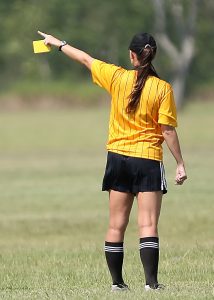
“Referees & abuse: ‘Massive rise in mental health support requests‘” by Ben Croucher, BBC Sport, November 14, 2020.
Following COVID-19 lockdowns in the United Kingdom, Ref Support UK saw a massive increase in football (soccer) officials seeking mental health support. In a new book, Referees, Match Officials & Abuse, 93.7% of match officials interviewed said they have experienced verbal abuse. Of the 2,056 referees in England surveyed, more than nine in ten said they had been verbally abused, with 59.7% experiencing some form of abuse every two games.
Do you think officials in some sports experience more abuse than officials in other sports? What data can you find on referee abuse in your sport?
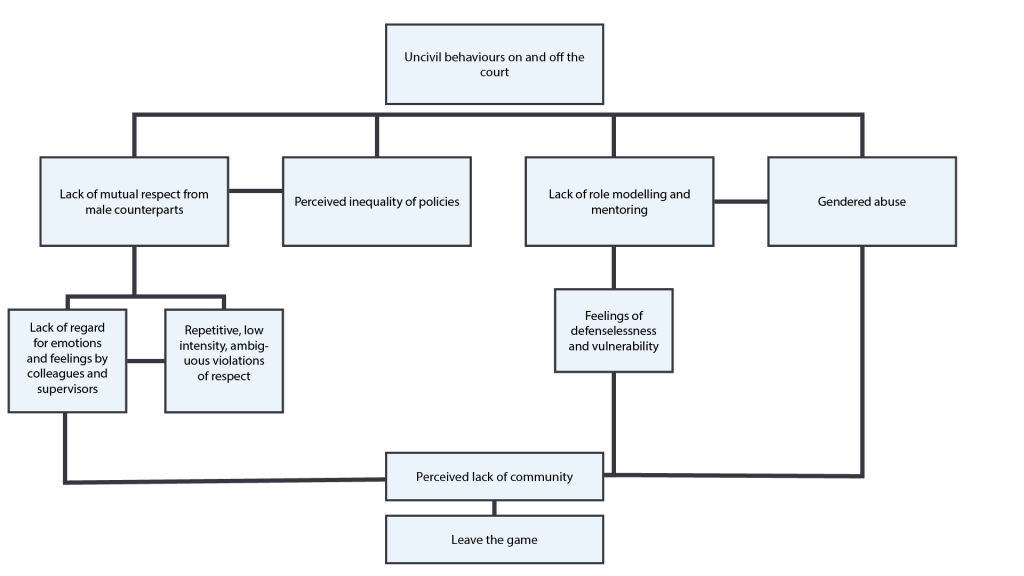

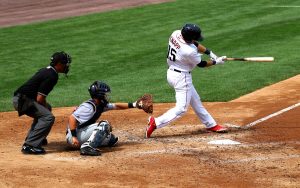
Baseball Canada held a workshop entitled Gendering Realities: The Differing Experiences of Male vs. Female Sports Officials at their 2017 Fall Convention. Using data drawn from a national study, this workshop explored the gendered challenges in sports officiating as well as dealing with sexual violence, and how sports administrations could develop more inclusive officiating environments.
The sociocultural environments found in sport are complex and the product of current and historical initiatives and issues including participation policies, evolving legislation, longstanding public beliefs, and culturally driven social constraints.Dehghansai et al., 2020. These environments vary considerably from sport to sport and significantly influence the participant experience. For officials, there is one consistent and constant feature of their environment that has persisted over time; that is, the presence of constant critique.
To be realistic, it is more than likely that criticism will always be part of a sport official’s occupation. However, organizations may create and in effect deliberately manage the routine presence of such negativity by explicitly supporting their officials.
In creating supportive environments for officials, it is helpful for those charged with doing so to understand the concept of perceived organizational support (POS). POS refers to the degree to which an individual believes that their organization values their contributions, cares about their well-being, and is interested in supporting their socioemotional needs.Eisenberger et al., 1986. When an individual perceives that they are well supported by supervisors, being treated fairly, and rewarded for their efforts, POS is high. Conversely, when an individual concludes that support is lacking, they are being treated unfairly, and rewards are absent, POS is low. Importantly, our research has demonstrated that there is a direct correlation between high levels of POS and sport officials’ decisions to remain active in the role regardless of the extent to which they face adversity.Livingston & Forbes, 2016. Equally important is that with some strategies, dedication to the cause and patience, supportive officiating environments can readily evolve.
We outline the characteristics of these supportive officiating environments below.
Sport officials are all too often treated as an “afterthought” rather than as a required let alone valued participant within sport.Mano, 2018, p. 4. This is driven in part by societal attitudes, but in reality, their participation is also limited by existing barriers in sport organizations. Indeed, all too often existing governance structures and decision-making processes do not allow for representation and or input from the officiating ranks. To counter this, National Sport Organizations (NSOs) and Provincial/Territorial Sport Organizations (PTSOs) in Canada need to ensure that their governing body (e.g., Board of Directors or Executive Committee) includes officiating representatives with voting privileges. Officials should also be included in all strategy and action plan setting meetings to ensure that their perspectives and contributions to the effort are reflected in the resulting documents. By overtly acknowledging and identifying officials as part of their key decision-making processes and activities, established sport organizations may send a strong message of inclusion for this all too often excluded group.
Another way to create an equitable and inclusive organizational culture for officials is through the development of recognition programs and policies within your organization. This can include recognition through online websites and newsletters, as well as awards at season ending events. Athletes, coaches, and volunteers are routinely celebrated, but the officials tend to receive less attention. Developing recognition programs for your sport officials is a relatively simple but powerful way to let everyone know that officials are valued within your sport.
Those aspiring to become officials usually begin the journey through basic educational programs which introduce them to the rules, standards, and technical performance requirements (e.g., correct positioning relative to the field of play, etc.) of officiating in their sport. However, new officials are often then quickly cast into the role and left to learn on the job without the necessary pre-competition training and opportunity to develop confidence in their skills. Some organizations try to offset these challenges by assigning experienced officials to supervise and support new officials during competitions, but this support tends to dwindle over time. Moreover, there is also considerable variation from sport to sport and organization to organization as to the extent to which training sessions (i.e., either at introductory or more advanced levels) are offered, let alone evaluated and thereafter revamped or revised over time.
A commitment to an ongoing cycle of development, planning, implementing, and evaluating for the purposes of improving the quality of training and mentorship programs for officials needs to be adopted as the requirements of being an official today are constantly changing.Mano, 2019. It’s about much more than just understanding the rules or technical requirements of sport. Today’s officials should be developing competencies related to dispute resolution, conflict management, psychological resilience, and other sport-specific related areas. Such efforts would empower officials to play an active role in creating safer environments for not only themselves, but also for all other participants. Equally important is the development of a culture which promotes continuous (or lifelong) learning and professional development, as is the notion of linking demonstrated skill competencies (e.g., minimum fitness standards) and not just seniority or prior experience to officiating at higher levels.
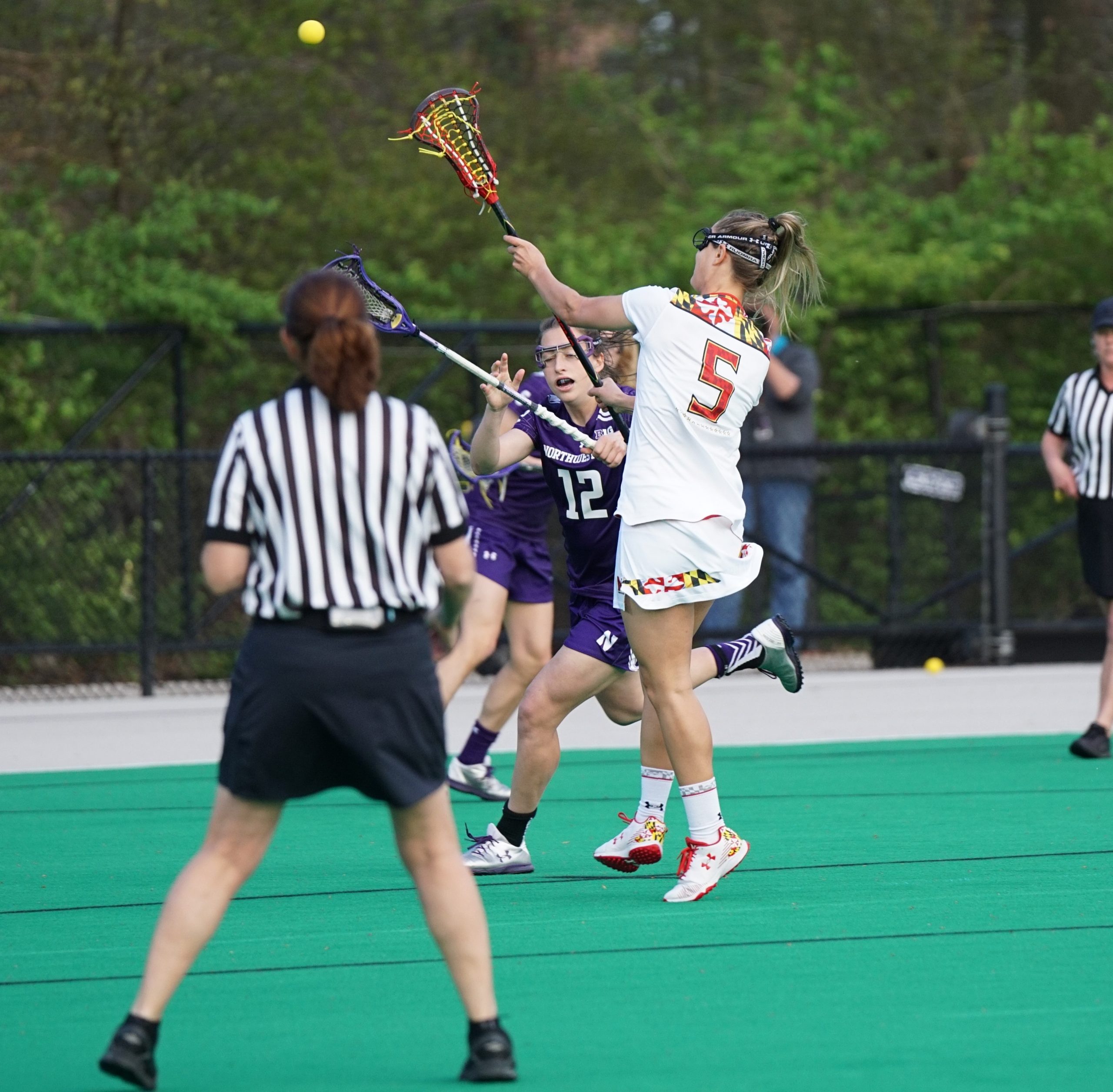
Some organizations have attempted to reduce the incidence of confrontations between officials, athletes, coaches, and spectators through the introduction of educational programs, as well as competition arbitrators and ambassadors.Woelfel, 2018, May. Educational programming in the form of parental seminars and poster programs are very common, but in the absence of formal program evaluations, it is difficult to understand their efficacy. However, there is every reason to believe that their effectiveness would be improved when used in conjunction with competition-related arbitrator and ambassador programs.
While the officials in sport are tasked with adjudicating the within-competition rules, individuals with prior experience as officials or even dedicated knowledgeable volunteers can be assigned as arbitrators to resolve administrative disputes (e.g., player eligibility) or as ambassadors to resolve spectator behaviour issues. The bounds of an arbitrator’s duties may differ between sports and hence, would need to be defined and made known to all participants prior to the beginning of a competition. The same is true for the role of an ambassador, but their presence would extend beyond the bounds of the competition playing area. Their effectiveness is facilitated by the wearing of easily identifiable colour-coded and/or labelled shirts and having a constant presence at the competition site. Importantly, these roles contribute to the creation of a safer environment for sport officials by reducing both the nature and frequency of potentially confrontational interactions between officials and other sport participants.
Common sense tells us that rules, fines, and other forms of penalties in and of themselves are insufficient to deter some from lobbing threats of verbal or physical violence at officials. Therefore, these alone will not protect or keep officials safe. However, when used in combination with the other strategies outlined above, they should be viewed as an essential part of the overall strategy to keep officials safe.
It will take time and a solid short term commitment from everyone within sport to commit to making sport safer in the long term for officials by actively working to change the culture of sport. This will not be simple or comfortable work. Cultural change is not easily effected but creating a culture that is more inclusive and equitable for officials is the key. It is easiest to begin by modifying the environment one step at a time. Each of the strategies outlined in this chapter should be viewed as just that – a single step – that when introduced in combination with all of the others will lead to cumulative cultural change.
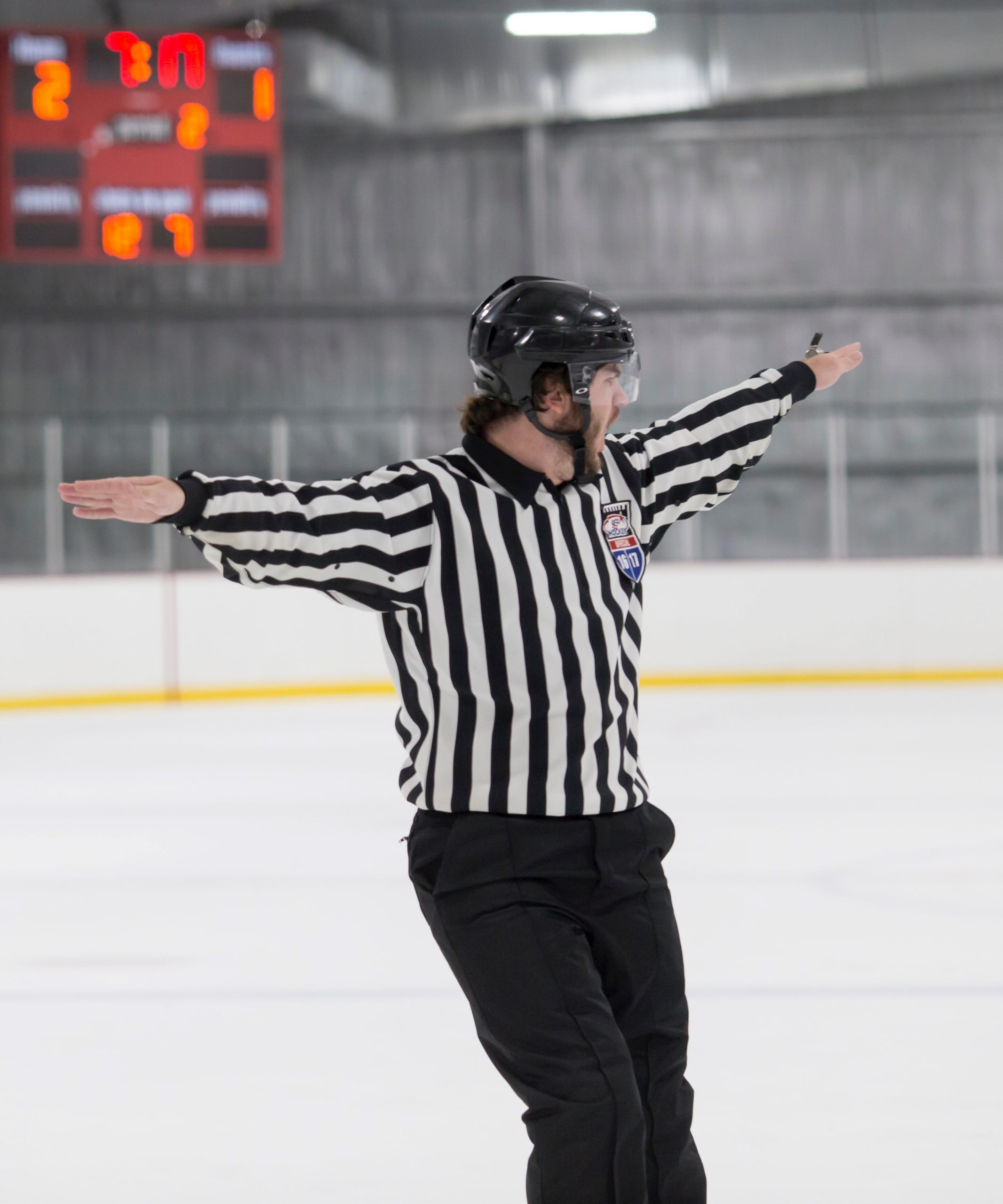
A study by Shawn Eckford on “An Analysis of Minor Hockey Officials and Perceived Organizational Support” examined the extent to which minor hockey officials perceive organizational support (POS) from the minor hockey system, and compared POS among minor hockey officials according to demographics. He surveyed a total of 261 minor hockey officials using the Survey of Perceived Organizational Support (SPOS). His results indicated significant differences according to minor hockey officials’ experience, certification level and extra-role performance. The thesis discusses his finding and makes recommendations as to how administrators can better support these officials.
Future Research
One area for future research is the exploration of implicit cultural biases (e.g. racism, toxic masculinity, homophobia) in sport through the lens of intersectionality. As Cooper and colleagues (2020) note “inequities, inequalities, and discrimination” are barriers to developing an inclusive, welcoming sports environment.
Key Terms
An interactive H5P element has been excluded from this version of the text. You can view it online here:
https://ecampusontario.pressbooks.pub/safesport/?p=285#h5p-46
Suggested Assignments
Image Descriptions
Figure 16.1 This figure demonstrates why female basketball referees leave the game. At the top of this branching scenario are uncivil behaviours on and off the court. There are four sub-branches beneath this. First is a lack of mutual respect from male counterparts, which is split further into a lack of regard for emotions and feelings by colleagues and supervisors and repetitive, low-intensity, ambiguous violations of respect. The second sub-branch is the perceived inequality of policies, which holds a lateral connection to the first branch. The third sub-branch is a lack of role modelling and mentoring, which branches further into feelings of defenselessness and vulnerability. Gendered abuse is the fourth branch, which has a lateral connection to the third. All four of these branches and sub-branches lead to a perceived lack of community, ultimately causing female referees to leave the game. [return to text]
Sources
Be Soccer. (2018). VAR World Cup status released. Retrieved October 29, 2021, from https://www.besoccer.com/new/var-world-cup-stats-released-488227
Brewer, J. (2021, February 22). Our sports need a healthier version of masculinity and men need to create it. The Washington Post. Retrieved October 26, 2021, from https://www.washingtonpost.com/sports/2021/02/22/toxic-masculinity-sports-sexism-don-mcpherson/
Cooper, J. N., Newton, A. C., Klein, M., & Jolly, S. (2020). A call for culturally responsive transformational leadership in college sport: An anti-ism approach for achieving equity and inclusion. Frontiers in Sociology, 5, 1-17. DOI: 10.3389/fsoc.2020.00065
Cuskelly, G., & Hoye, R. (2013). Sports officials’ intention to continue. Sport Management Review, 16(4), 451–464. https://doi.org/10.1016/j.smr.2013.01.003
Dehghansai, N., Lemez, S., Wattie, N., Pinder, R. A., & Baker, J. (2020). Understanding the development of elite parasport athletes using a constraint-led approach: Considerations for coaches and practitioners. Frontiers in Psychology, 11, 502981–502981. https://doi.org/10.3389/fpsyg.2020.502981
Eisenberger, R., Huntington, R., Hutchison, S., & Sowa, D. (1986). Perceived organizational support. Journal of Applied Psychology, 71(3), 500-507. DOI: 10.1037/0021-9010.71.3.500
Fasting, K. (2015). Assessing the sociology of sport: On sexual harassment research and policy. International Review for the Sociology of Sport, 50(4-5), 437–441. https://doi.org/10.1177/1012690214554272
Fink, J. S. (2016). Hiding in plain sight: The embedded nature of sexism in sport. Journal of Sport Management, 30(1), 1-7. https://doi.org/10.1123/jsm.2015-0278
Leslie, J. P. (1998). The Evangeline league’s man in the blue serge suit: Trials and tribulations. Louisiana History, 39(2), 167–188.
Livingston, L. A., & Forbes, S. L. (2016). Factors contributing to the retention of Canadian amateur sport officials: Motivations, perceived organizational support, and resilience. International Journal of Sports Science & Coaching, 11(3), 342–355. https://doi.org/10.1177/1747954116644061
Livingston, L. A., & Forbes, S. L. (2017). “Just bounce right back up and dust yourself off.”: Participation motivations, resilience, and perceived organizational support amongst amateur baseball umpires. Baseball Research Journal, 46(2), 91-101.
Livingston, L. A., Forbes, S. L., Wattie, N., & Cunningham, I. (2020). Sport officiating: Recruitment, development, and retention. Taylor & Francis Group.
Mano, B. (2018, September). Afterthought. Referee Magazine, 43(9), 4.
Mano, B. (2019, February). See that “train” a coming. Referee Magazine, 44(2), 4.
Parrish, G. (2017, July 28). Adidas shamefully gave LaVar Ball the power to remove a woman from her job. CBS Sports. Retrieved October 27, 2021, from https://www.cbssports.com/college-basketball/news/adidas-shamefully-gave-lavar-ball-the-power-to-remove-a-woman-from-her-job/
Schaeperkoetter, C. C. (2017). Basketball officiating as a gendered arena: An autoethnography. Sport Management Review, 20(1), 128-141. https://doi.org/10.1016/j.smr.2016.05.001
Tietz, S.L. (2018, April). Crisis: In these contentious times, how do officials’ handle difficult situations?. Referee Magazine, 43(4), 22-27.
Tingle, J. K., Warner, S., & Sartore-Baldwin, M. L. (2014). The experience of former women officials and the impact on the sporting community. Sex Roles, 71(1), 7-20. https://doi.org/10.1007/s11199-014-0366-8
Voigt, D. Q. (1970). America’s manufactured villain-the baseball umpire. Journal of Popular Culture, 4(1), 1–21. https://doi.org/10.1111/j.0022-3840.1970.0401_1.x
Woelfel, R. (2018, April). Replay. Referee Magazine, 43(4), 34-37.
Woelfel, R. (2018, May). Money ball. Referee Magazine, 43(5), 58-63.
Woelfel, R. (2020, September). Harassment halt. Referee Magazine, 45(9), 38-41.
VIII
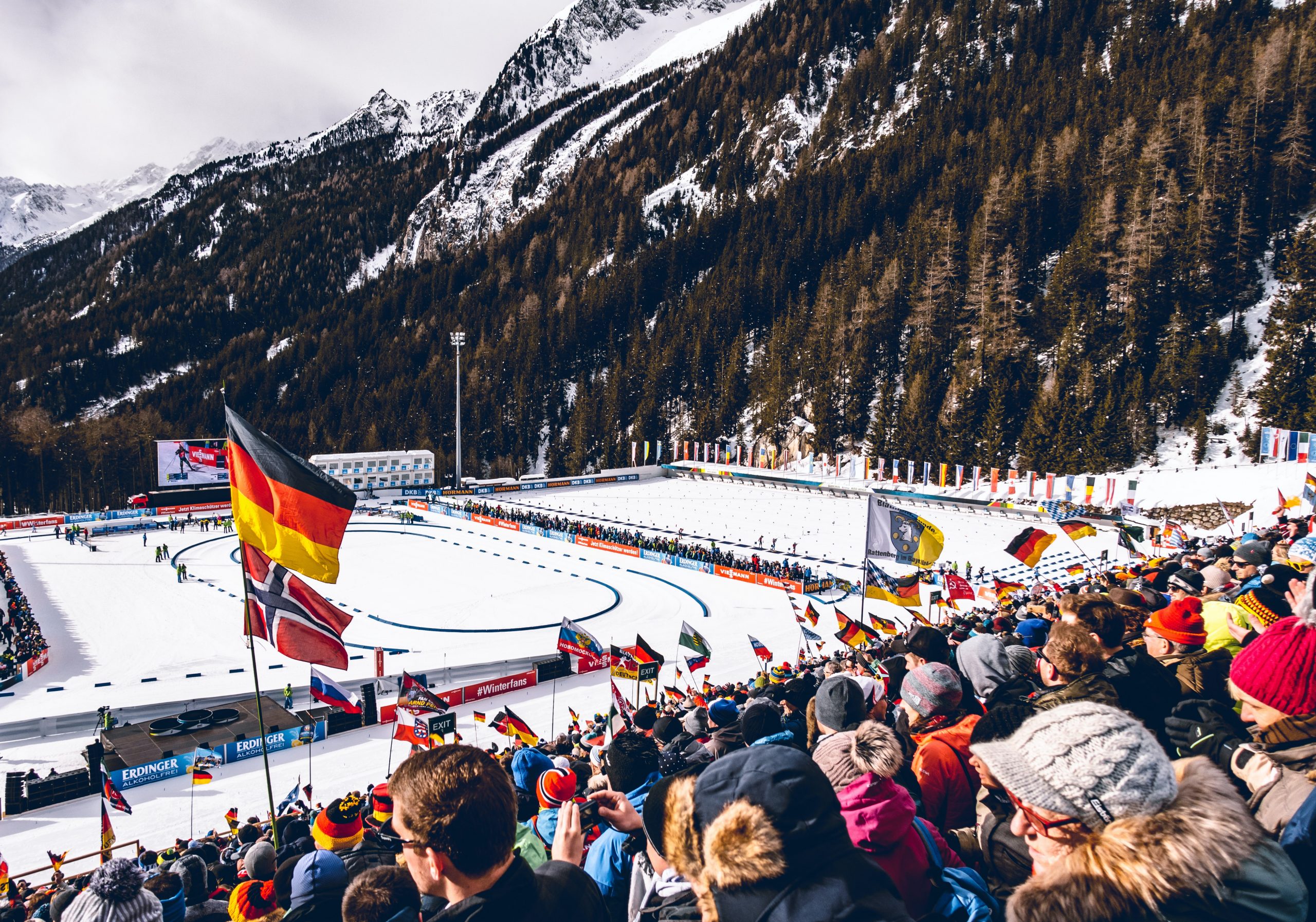
One resounding theme throughout this reader that all the authors have communicated in their own unique way is that safe sport requires effort from a variety of stakeholders at every level of the sports system. Now that a universal body has been formed to implement the Universal Code of Conduct to Prevent and Address Maltreatment in Sport (UCCMS), what happens next? In the final chapter of this reader, Gretchen Kerr, PhD, from the Faculty of Kinesiology and Physical Education at the University of Toronto writes about what needs to happen in order for the UCCMS to be realized. Finally, an epilogue written by Michele Donnelly, PhD, from the Faculty of Sport Management at Brock University offers a summary of where we currently stand in this movement, and an important perspective on what steps need to be taken next to put these words into action.
17
Gretchen Kerr
Maltreatment
Universal Code of Conduct
Athletes’ Voice
When you have completed this chapter, you will be able to:
LO1 Identify three precipitating factors to the development of the UCCMS;
LO2 Identify the research evidence used to inform the development of the UCCMS;
LO3 Identify the ways in which athletes’ voices informed the development of the UCCMS; and
LO4 Identify the next steps in realizing the UCCMS.
As a result of growing public awareness and research evidence regarding athlete maltreatment, the Universal Code of Conduct to Prevent and Address Maltreatment in Sport (UCCMS) has been developed. The UCCMS was informed by research evidence highlighting athletes’ experiences of maltreatment, including, psychological, physical, sexual harm and neglect. While the UCCMS identifies prohibited conduct, it represents only a first step in the safe sport journey. Next steps include the need for independent complaint and adjudication mechanisms, and extending the notion of safe sport beyond the prevention of harms to include optimization of the sport experience.
The Universal Code of Conduct to Prevent and Address Maltreatment in Sport (UCCMS) is a set of rules around behaviour for all Canadian stakeholders and participants in sport to follow. Written by national sport organizations (NSOs), multisport service organizations (MSOs), and Canadian Olympic and Paralympic Sport Institute (COPSI) Network members in 2019, it identifies prohibited conduct or those behaviours that will not be accepted within the sport context. By identifying standards, expectations and guidelines for behaviours in the sport context, the UCCMS can support those in sport by providing a structure to follow when addressing ethical dilemmas, including the reporting of a violation.
The UCCMS also serves to communicate the key values and commitments of sport to both internal and external audiences. In this case, the UCCMS was grounded in the Physical Activity and Sport ActPhysical Activity and Sport Act, 2003. which reads as follows:
“The Government of Canada’s policy regarding sport is founded on the highest ethical standards and values, including […] the treatment of all persons with fairness and respect, the full and fair participation of all persons in sport and the fair, equitable, transparent and timely resolution of disputes in sport”.4 (1).
The need for a universal code of conduct was called for, in part, due to the occurrence and widespread awareness of cases of athlete abuses both in Canada and abroad. While recognizing that athlete abuses have always occurred in sport, media coverage and public awareness of these experiences heightened in the latter half of the 2010 decade. The Barry Bennell case in U.K. football, the Jerry Sandusky case at Penn State University, USA (football), Larry Nassar in USA Gymnastics, Bertrand Charest (Alpine Skiing) and Matt Bell (Swimming) in Canada, are a few of many examples of high-profile cases of sexual abuse of athletes.
The heightened media attention on sexual abuse of athletes, in particular, was inevitably influenced by the MeToo Movement and the establishment of the hashtag #MeToo in 2017 which prompted individuals from around the world to publicly share their experiences of sexual violence. Although both men and women reported sexual exploitation by those in positions of power and authority, most of the voices came from girls and women. In addition to highlighting the prevalence of women’s experiences of sexual violence experiences, the hashtag #MeToo gave women a place to find validation and support.
Paralleling this heightened media attention was a growing body of research evidence regarding the harms experienced by athletes, including sexual, psychological, physical abuses, neglect, bullying and discrimination. Between 2010 and 2019, three national prevalence studies of athlete maltreatment were conducted in the U.K.,Alexander et al., 2011. Belgium and the Netherlands,Vertommen et al., 2016. and in Canada.Kerr et al., 2019.
Despite the different samples of athletes, levels of sport engagement, and measurement tools, all three studies indicated that psychological harms were most frequently reported by athletes. Psychological harms can be categorized into verbal behaviours (e.g., demeaning, threatening, degrading comments), physical behaviours (e.g., throwing objects in anger without striking an athlete), and the active denial of attention and support (e.g., refusing to coach an athlete after a sub-par performance).Stirling & Kerr, 2008. The Canadian prevalence study was one of the first to include an assessment of neglect, or the omission of care, with national team athletes reporting experiences of neglect on a repeated basis. Neglect is distinguished from the denial of attention and support in psychological abuse as neglect involves a lack of attention to the physical and psychological needs of an athlete, whereas psychological abuse is an act of commission or an active behaviour to withdraw attention and support.
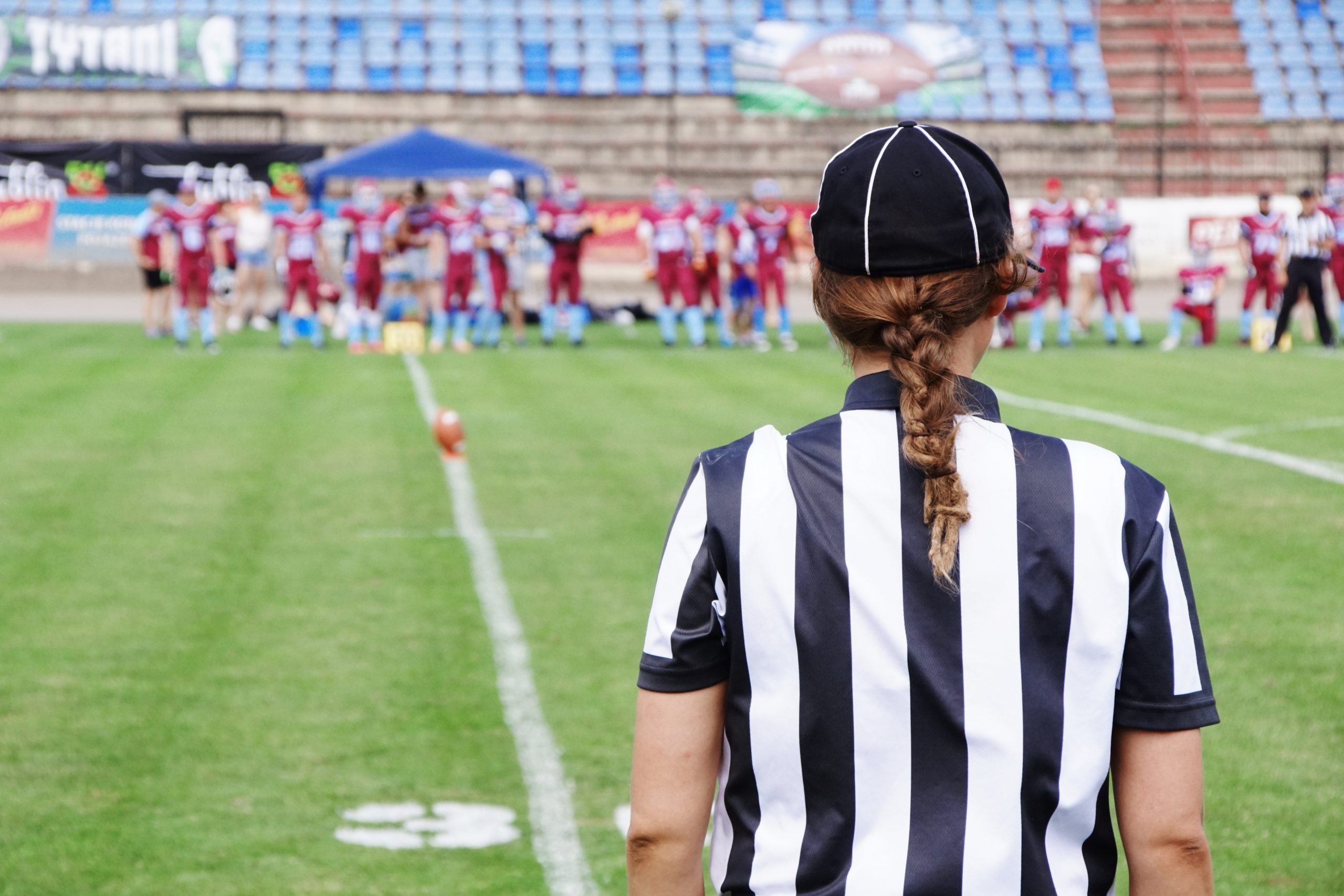
The growing body of research evidence shows that despite the primary focus on sexual abuse by the media, psychological harms are far more commonly experienced by athletes. Moreover, consistent with the findings in the child abuse literature, emerging data in sport suggests that psychologically abusive experiences can have serious and deleterious effects for athletes’ mental health and well-being. For example, Willson et al. (2021) reported that retired women athletes from aesthetic sport experienced body dysmorphia, eating disorders, lowered self-esteem, and difficulties developing trust in relationships, as a result of the psychologically abusive behaviours of body shaming in their high-performance training. Similarly, Parent et al. (2021) reported that amongst French-Canadian youth athletes between the ages of 14 and 17 years, psychological violence and neglect as (well as sexual violence) were independently related to lower self-esteem, higher psychological distress and PTSD symptoms. These findings suggest the need to broaden the lens on maltreatment to include and extend beyond sexual forms of harm in recognition of the potentially harmful long-term effects of psychological abuse and neglect.
In Canada, the Former Federal Minister of Science and Sport, Kirsty Duncan (served from January 2018 until November 2019), was instrumental in the development of the UCCMS, stating that “a systemic culture shift is required to eliminate maltreatment, including sexual, emotional, and physical abuse, neglect, harassment, bullying, exploitation and discrimination”.Canadian Heritage, 2019. The development of the UCCMS was part of this systemic cultural shift.
Societal norms and expectations are constantly changing. What was okay in homes, schools, workplaces, and relationships in the past is not necessarily okay now and sport must be held to the same standards. For organized sport to thrive, it must align its practices to be consistent with other domains in which people, including young people, live, work, learn, and develop. For example, views about how to develop and nurture children and youth now recognize the extraordinary potentialities of young people that adults carry responsibilities to nurture.
Approaches to parenting and education have shifted from parent or teacher-centred, using command and control methods, to child and student-centred methods, using more democratic and humanistic methods. These changes in approaches are reflected in the increased attention to diverse ways of learning, eliminating punishment strategies in favour of positive discipline, and decision-making driven by the unique needs of the child. In addition to the shift to more democratic ways of interacting with youth, the MeToo Movement highlighted the ways in which power should and should not be used, thus providing clarity about, and raising the bar for, expected conduct within relationships of unequal power.
The increased attention to equity, diversity, and inclusion in society broadly, have also heightened the need for a cultural shift within sport. The Truth and Reconciliation Commission in Canada, the Black Lives Matter movement that has reached across the globe, and recognition of mental health challenges across diverse populations, are some of many examples of societal shifts that will permeate and call for action in sport.
In sum, sport cannot afford to be autonomous or disconnected from the norms and expectations that characterize broader society. Using child/youth-centred approaches, command and control coaching methods must give way to democratic styles in which power is shared with athletes in age and stage-appropriate ways; punitive strategies must be replaced with guidance, explanation and positive reinforcement and; safe, inclusive, and welcoming sport environments must become the highest priority.
Video provided by Brock University Centre for Sport Capacity. Used with permission. [Transcript]

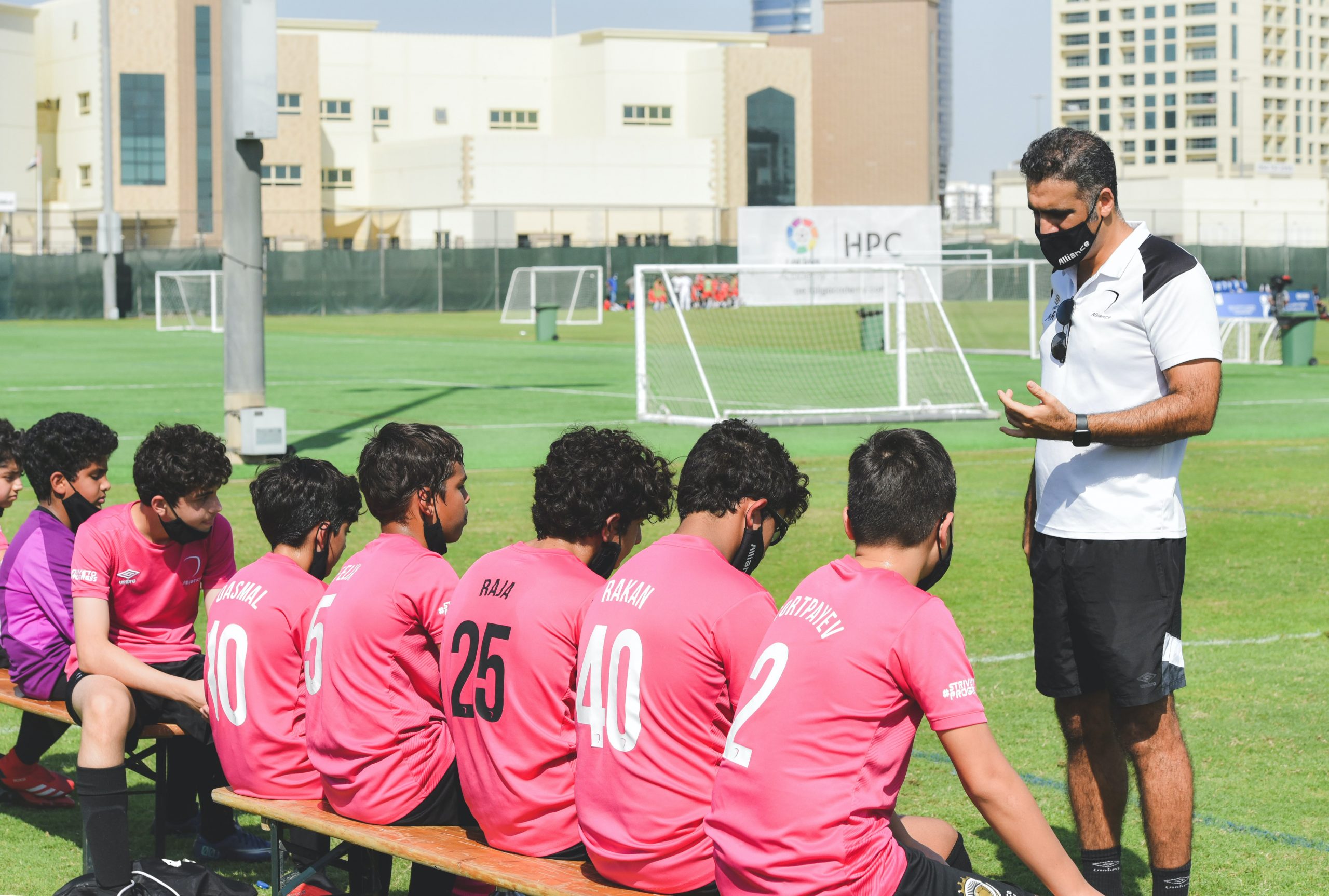
When engaging in sport as a participant, volunteer, coach, or administrator, look for behaviours that would not be deemed as acceptable in other youth-oriented endeavours such as in the classroom or other learning environments. How might sport leaders consider the following questions when providing safe sport experiences to youth?
Research evidence that informed the development of the UCCMS included the following:
Prevalence studies indicated that the code of conduct needed to address and extend beyond sexual harms to include psychological and physical harms, and neglect. The Canadian prevalence study of maltreatment experiences of national team membersWilson et al., 2021. indicated the following experiences, which are noted in Table 17.1 below.
| Types of Harms Reportedly Experienced on a Repeated Basis | Current National Team Members | Retired National Team Members (within last 10 years) |
| Psychological | 17% | 23% |
| Neglect | 15% | 22% |
| Sexual | 4% | 7% |
| Physical | 3% | 5% |
Note: Sample included 1,001 athletes, including 764 current and 237 retired athletes.
The mean age of participants was 27.7 years (SD = 9.09): 25.5 years (SD = 8.16) for current and 34.4 years (SD =8.57) for retired athletes.
Of the respondents, 61.5% identified as females, 38.4% identified as males, and 0.1% identified as other. Participants self-identified as racialized (9.7%), having a disability (11.6%), Indigenous (1.6%), and LGBTQ2I+ (7.3%).
Respondents represented 64 sports. The sports with the highest participation rates were gymnastics (5.5%), volleyball (5.4%), athletics (4.4%), swimming (3.8%), rowing (3.3%), rugby (3.5%), hockey (3.4%), and freestyle skiing (3.8%).
The normalization or acceptance of psychologically harmful behaviours in the sport context has been well-documented.e.g., Jacobs, 2017; Stafford et al., 2015; Stirling & Kerr, 2008; 2009. Psychologically violent behaviours include:
Numerous authors have written about the widespread acceptance of these behaviours in sport as methods of athlete development in spite of the prohibition of such behaviours in other youth-populated settings such as schools and in spite of the fact that these practices run contrary to the vast body of evidence on effective learning and child development methods.
Interestingly, the normalization of psychologically harmful methods was the most contentious and highly debated aspect in the process of developing the UCCMS. When a draft of the UCCMS was circulated for feedback amongst sport stakeholders (e.g., sport administrators, coaches, athletes, sport science staff), many argued against the inclusion of these psychologically related behaviours, citing their importance for athlete development and mental toughness.
Research findings highlight the reluctance of athletes to disclose and/or report their experiences of harm. When Canadian National Team athletes were asked: “If you experienced abuse, harassment, bullying, or hazing, did you tell anyone?”, only 56% of current athletes and 52% of retired athletes responded “Yes.” Further, when these athletes were asked “If you experienced abuse, harassment, bullying or hazing, did you submit a formal report/complaint of your experience(s)?”, only 15% of current athletes and 13% of retired athletes responded “Yes.” The participating athletes cited reasons for not reporting including fear of negative repercussions for their athletic career, deliberate attempts to stay silent, normalization, lack of awareness of where to go with their concerns, absence of a confidential place to take their concerns, and lack of confidence that anything would be done about the harms they experienced.
An interactive H5P element has been excluded from this version of the text. You can view it online here:
https://ecampusontario.pressbooks.pub/safesport/?p=298#h5p-48
Finally, to address the findings in high-profile cases, that other adults in positions of trust and authority knew about the occurrence of athlete maltreatment and failed to act upon this knowledge, the UCCMS was written to promote a collective responsibility. This means that all adults in the sport context have a duty to look out for the wellbeing of athletes, regardless of their age, and a duty to report when they notice inappropriate activity. Abuse often begins with small, inappropriate behaviour that if not addressed immediately will tend to escalate into more abusive situations.Canadian Centre for Child Protection, n.d. Thus, intervening early in this way is critical. In addition to the legal duty to report child maltreatment, sexual and physical abuse, the UCCMS includes a duty to report concerns of inappropriate conduct. Reporting inappropriate conduct is important to ensure proper action is taken, expectations are re-established, and inappropriate behaviour doesn’t escalate into more severe violations. For example, if an adult loses their temper with an athlete and yells or throws an object once, this may be inappropriate but not abusive. But, rather than excusing the behaviour because it’s a “one-off”, it’s important to address the problematic nature of the behaviour and reinforce expected conduct so this behaviour is not viewed as acceptable and therefore may be reproduced.
Video provided by Brock University Centre for Sport Capacity. Used with permission. [Transcript]
A key element of the development of the UCCMS was the incorporation of athletes’ voices throughout the process. The Canadian prevalence study was conducted in partnership with AthletesCAN, (please see Chapter 2 for more about the athlete perspective on safe sport) and as a result, athletes contributed to the development of the survey questions, the recruitment of survey respondents, and the dissemination of findings. They held their own Safe Sport Summit to share and discuss the findings of the prevalence study in advance of the National Safe Sport Summit held in Ottawa in 2019. AthletesCAN representatives made a powerful presentation at the National Safe Sport Summit at which time they identified a number of consensus statements and recommendations; they received a standing ovation for their presentation.
One of the most controversial aspects of the UCCMS was the prohibition of sexual relations between athletes of any age and their coaches. While acknowledging that sexual relations between a coach and an adult athlete did not constitute a criminal offence, the athletes argued strongly and successfully that the power imbalance between a coach and athlete, even if both are adults, is so influential that it essentially negates the ability of the athlete to freely provide informed consent to a sexual relation.
Athletes were also instrumental in insisting that the same code of conduct exist regardless of sport, sport type, or sport-specific differences. These arguments were made in response to attempts by some to maintain flexibility and autonomy in making decisions about what constituted prohibited behaviours on the basis of sport-specific differences. For example, concerns were expressed by some sport administrators and coaches that because touching was involved in some sports and not in others, one set of rules could not apply broadly across all sports. Similarly, while body contact is permitted in sports such as ice hockey, it is not permitted in other settings such as on a pool deck, and, as a result, some were concerned about whether a generalizable code of conduct was feasible.
In response, the athletes insisted that it was possible – and necessary – to have a common set of prohibited behaviours regardless of sport type, and that any sport-specific differences would be accounted for in the complaint management process. Without such a harmonized approach, the athletes argued that athletes would continue to be vulnerable to experiences of harm, emphasizing that it is the autonomy of sport organizations that enables the acceptance of harmful behaviours that are prohibited in other youth-populated domains. The athletes won the day on this important argument.
Finally, the athletes argued strongly for a complaint mechanism that existed independently from their sport organization. They called for a confidential, arms-length organization to receive and address complaints regarding maltreatment. They attributed their lack of willingness to report concerns about maltreatment to the existing conflicts of interest inherent in having the sport organization receive and address concerns.
An interactive H5P element has been excluded from this version of the text. You can view it online here:
https://ecampusontario.pressbooks.pub/safesport/?p=298#h5p-49
In July 2021, Canadian Heritage announced the establishment of independent reporting and complaint processes through the Sport Dispute Resolution Centre of Canada (SDRCC), a body formed in 2000 to offer tools to prevent and, when necessary, resolve conflicts. Although details are pending at the time of this writing, there are promising opportunities for sport participants to have access to transparent, confidential, and independent complaint processes. It will be the responsibility of the SDRCC to oversee and implement the UCCMS and to build upon the UCCMS by adding content pertaining to the reporting, complaint, and investigative processes, sanctions, and a potential public registry of sanctioned individuals. It will be essential that the SDRCC continue to engage athletes’ voices in the building of the reporting and complaint processes, and discussions about a public registry of sanctioned offenders.
At the present time, the adoption of the UCCMS is required by National Sport Organizations (NSOs) only. Although some NSOs intend to require or encourage adoption of the UCCMS through their provincial/territorial counterparts, there is presently no guarantee that the UCCMS will be implemented at provincial/territorial, regional or local sport levels, thus potentially leaving non-national level athletes vulnerable. The adoption of the UCCMS will need to be infused through the sport system, from grassroots to high-performance sport, so all athletes regardless of type or level of sport, or geographical location in the country, are assured of the same access to complaint mechanisms.
With every cultural shift, some resistance can be expected. Next steps in the Safe Sport journey will inevitably involve some resistance and push-back including beliefs that change is not needed or possible, or that previous ways of behaving (“the old ways”) are better for athletic performance outcomes. To counter these forms of resistance, models of cultural change should be considered.Scott & Jaffe, 1988. One of the ways to do this is to move beyond prohibited conduct by setting expected standards and helping people reach them. Additionally, it is imperative to address the bystanders and enablers that further entrench this resistance.
Finally, the notion of safe sport should be expanded beyond preventing and addressing harms to methods of promoting safe, fulfilling, positive, and welcoming sport experiences. In accordance with the Government of Canada’s Physical Activity and Sport Act, optimizing sport experiences are characterized by such aspects as enjoyment, sense of achievement, inclusion, positive relationships, optimal physical health, a strong sense of self, and the development of life skills.
Importantly, the prevention of harm does not necessarily lead to optimal sport experiences, however, the reverse is true. If we focus our efforts as concerned parents, teammates, spectators and sport leaders on optimizing sport experiences, then safe sport becomes a natural by-product.
Video provided by Brock University Centre for Sport Capacity. Used with permission. [Transcript]
The UCCMS constitutes an important piece of the puzzle in preventing and addressing maltreatment in sport. Adopting a pan-Canadian approach to identifying prohibited conduct that is generalizable across sports represents significant progress. However, the UCCMS is only a first step. In addition to identifying and broadly disseminating processes regarding reporting and complaint management, significant attention is needed to determine appropriate sanctions for UCCMS violations, and a public registry of offenders. Athletes will need to be engaged in the determination of these next steps.
We mustn’t stop at identifying prohibited conduct; instead, we need to articulate what safe, healthy, positive and inclusive sport experiences look like. Future directions will include education and training to develop leaders with the competencies required to establish sport environments in which such positive and inclusive experiences are possible. Future directions will also include researchers providing the evidence that successful athletics performance outcomes are possible – and perhaps even more probable – with safe, healthy and inclusive sport.
 Self-Reflection
Self-Reflection
Key Terms
An interactive H5P element has been excluded from this version of the text. You can view it online here:
https://ecampusontario.pressbooks.pub/safesport/?p=298#h5p-50
Further Research
With the recent implementation of the UCCMS at the national level of sport, it will be important to research the effects of the UCCMS. How have sport organizations implemented and communicated the UCCMS to their stakeholders? How has the UCCMS affected the disclosure and reporting rates of maltreatment? How will national sport organizations influence the adoption of the UCCMS at lower levels of sport? Will the adoption of the UCCMS influence stakeholders’ awareness of maltreatment and prohibited conduct?
How will education and training on the UCCMS be developed and disseminated, and will these be effective for behaviour change?
Suggested Assignments
Image Descriptions
Figure 17.1 This interactive feature demonstrates six different reasons for not reporting experiences of harm. They include fear of negative repercussions for their athletic career, deliberate attempts to stay silent, normalization, a lack of confidence that anything would be done about the harms they experienced, absence of a confidential place to take their concerns, and a lack of awarenessof where to go with their concerns. [return to text]
Figure 17.2 This figure demonstrates the four next steps in realizing the UCCMS. Step 1 is to streamline the independent reporting and complaint process. The Sport Dispute Resolution Centre of Canada (SDRCC) will have to oversee and implement the UCCMS by adding content pertaining to the reporting, complaint & investigative processes, sanctions, and a potential public registry of sanctioned individuals. Step 2 is to ensure infusion of the UCCMS throughout the sport system, at all levels. The UCCMS will need to be adopted at all levels of the sport system, from grass-roots to high-performance sport. Step 3 is to counter forms of resistance. Resistance will need to be countered by encouraging cultural change via setting expected standards, and by addressing bystanders and enablers who entrench this resistance. Step 4 is to shift the focus from prevention of harm to optimization of experiences. Finally, a focus needs to be made on optimizing sport experiences, which are characterized by such aspects as enjoyment, sense of achievement, inclusion, positive relationships, optimal physical health, a strong sense of self, and the development of life skills. [return to text]
Sources
Alexander, K., Stafford, A., & Lewis, R. (2011). The experiences of children participating in organized sport in the UK. London: NSPCC.
AthletesCAN. (n.d.). Consensus statements. Retrieved November 10, 2021, from https://athletescan.com/en/athlete-zone/representation/safe-sport/consensus-statements
Canadian Heritage. (2019, May 21). Safe sport: Gender equity announcement. Retrieved November 10, 2021, from https://www.canada.ca/en/canadian-heritage/news/2019/05/safe-sport-g-ender-equity-announcement.html
Canadian Heritage. (2021, July 6). Minister Guilbeault announces new independent safe sport mechanism. Government of Canada. Retrieved November 10, 2021, from https://www.canada.ca/en/canadian-heritage/news/2021/07/minister-guilbeault-announces-new-independent-safe-sport-mechanism.html
Canadian Centre for Child Protection. (n.d.). Programs & initiatives: Commit to kids. Retrieved November 10, 2021, from https://www.protectchildren.ca/en/programs-and-initiatives/commit-to-kids/
Jacobs, F., Smits, F., & Knoppers, A. (2017). ‘You don’t realize what you see!’: The institutional context of emotional abuse in elite youth sport. Sport in Society, 20(1), 126–143. https://doi.org/10.1080/17430437.2015.1124567
Kerr, G., & Willson, E. (2020, November 1). New allegations of abuse have grounded Canada’s artistic swimming team. The Conversation. Retrieved November 10, 2021, from https://theconversation.com/new-allegations-of-abuse-have-grounded-canadas-artistic-swimming-team-148407
Kerr, G., Willson, E., & Stirling, A. (2019). Prevalence of maltreatment among current and former national team athletes. University of Toronto. 1-51. https://athletescan.com/sites/default/files/images/prevalence_of_maltreatment_reporteng.pdf
Physical Activity and Sport Act, SC 2003, c 2. https://laws-lois.justice.gc.ca/eng/acts/p-13.4/20030702/P1TT3xt3.html
Parent, S., Vaillancourt-Morel, M.-P., & Gillard, A., (2021). Interpersonal violence (IV) in sport and mental health outcomes in teenagers. Journal of Sport and Social Issues. https://doi.org/10.1177/01937235211043652
Scott, C. D., & Jaffe, D. T. (1988). Survive and thrive in times of change. Training and Development Journal, 42(4), p.25.
Smart, Z. (2021, July 2). Heil, top Canadian athletes call on federal government to address gaps in safe sport system. CBC Sports. Retrieved November 10, 2021, from https://www.cbc.ca/sports/olympics/summer/jennifer-heil-canadian-olympians-paralympians-open-letter-1.6088744
Stafford, A., Alexander, K., & Fry, D. (2015). ‘There was something that wasn’t right because that was the only place I ever got treated like that’: Children and young people’s experiences of emotional harm in sport. Childhood (Copenhagen, Denmark), 22(1), 121–137. https://doi.org/10.1177/0907568213505625
Stirling, A. E. (2009). Definition and constituents of maltreatment in sport: Establishing a conceptual framework for research practitioners. British Journal of Sports Medicine, 43(14), 1091–1099. https://doi.org/10.1136/bjsm.2008.051433
Stirling, A. E., & Kerr, G. A. (2008). Defining and categorizing emotional abuse in sport. European Journal of Sport Science, 8(4), 173–181. https://doi.org/10.1080/17461390802086281
Stirling, A. E., & Kerr, G. A. (2009). Abused athletes’ perceptions of the coach-athlete relationship. Sport in Society, 12(2), 227-239. https://doi-org.myaccess.library.utoronto.ca/10.1080/17430430802591019
Vertommen, T., Schipper-van Veldhoven, N., Wouters, K., Kampen, J. K., Brackenridge, C. H., Rhind, D. J. ., Neels, K., & Van Den Eede, F. (2016). Interpersonal violence against children in sport in the Netherlands and Belgium. Child Abuse & Neglect, 51, 223–236. https://doi.org/10.1016/j.chiabu.2015.10.006
Willson, E., & Kerr, G. (2021). Body shaming as a form of emotional abuse in sport. International Journal of Sport and Exercise Psychology, 1–19. https://doi.org/10.1080/1612197X.2021.1979079
Willson, E., Kerr, G., Stirling, A., & Buono, S. (2021). Prevalence of maltreatment among Canadian National Team athletes. Journal of Interpersonal Violence, 1–23. https://doi.org/10.1177/08862605211045096
18
Michele K. Donnelly
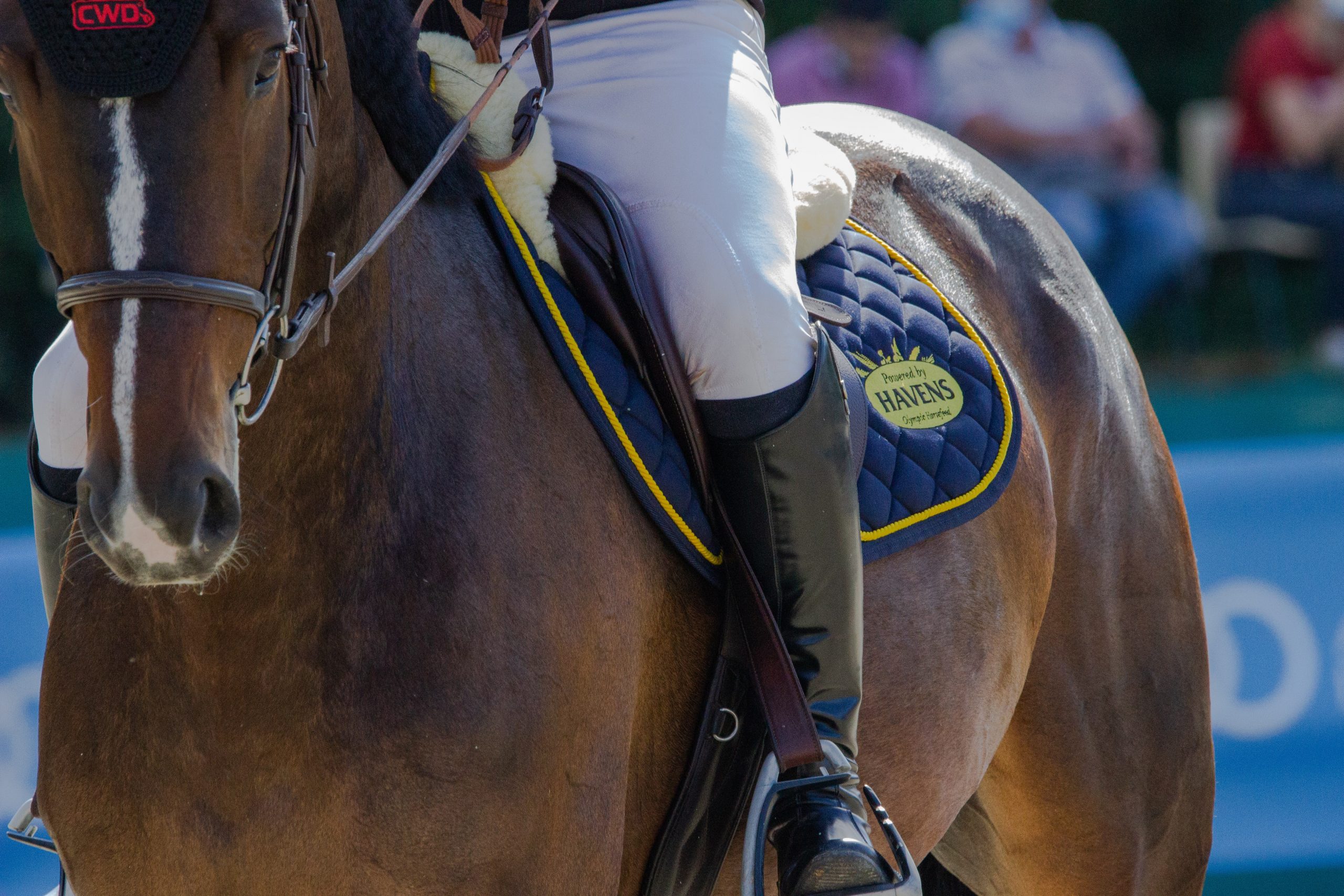
During the women’s modern pentathlon competition at the Tokyo 2020 Summer Olympic Games (held in August 2021), cameras captured a German coach punching a horse after it refused to jump for one of her athletes. The response was immediate; the coach was sent home from the Games, the governing body (Union Internationale de Pentathlon Moderne – UIPM) promised a full review, and headlines around the world condemned the coach’s actions. Following the Games, the UIPM announced that the show jumping event – one of the five events that comprise modern pentathlon – would be replaced. In January 2022, a working group has been convened to make recommendations to the UIPM about what event should replace show jumping so that horses are no longer part of the modern pentathlon. Imagine if physical abuse of human athletes had such immediate repercussions in sport?
I have intentionally oversimplified the modern pentathlon story; the horse punch was likely the final act that forced the UIPM to make long needed changes to the composition of modern pentathlon. And, there are a number of other factors – including the sport’s consistently poor viewership numbers during the Games – that have surely had a greater influence on the UIPM’s decision to replace show jumping. However, the point remains: For years, we have heard stories about physical, emotional, and sexual abuse in sport, very often perpetrated against athletes by those in positions of power over them. Why have these stories not warranted the same outrage or lead to meaningful change in the world of sport? Whatever your current role – in and outside of sport – this edited book should serve as a call to action. It can no longer be acceptable to sacrifice human beings to an opportunistic, unhealthy, and exclusive culture of sport.

The development and implementation of the Universal Code of Conduct to Prevent and Address Maltreatment in Sport (UCCMS) is an important and necessary step toward safe sport in Canada. Perhaps its most significant contribution is a more complete understanding of maltreatment. That is, an understanding of maltreatment in sport that extends beyond, while still including, sexual abuse and harassment.
Sport cannot be accessible, inclusive, and safe, if it is an environment in which maltreatment is permitted. Section 2.2 of the UCCMS identifies multiple forms of maltreatment: psychological maltreatment; physical maltreatment; sexual maltreatment; neglect; maltreatment related to grooming; maltreatment related to process; and maltreatment related to reporting; and details the various types of actions or behaviours that are included in each form.
This more holistic, thorough, and complete understanding of maltreatment is informed by the existing research about abuse in sport (research conducted by authors of chapters in this volume, such as Donnelly, Kerr, Kidd, and Willson). The UCCMS establishes standards for the conduct of all persons involved in sport, and addresses areas that continue to be unacknowledged in other national systems.
For example, the U.S. Center for SafeSport claims to be focused on ending all forms of abuse in sport, but currently only accepts reports about sexual abuse within the U.S. Olympic and Paralympic movements. Sexual abuse is the least common – though the most publicized – form of abuse in sport. Even with this limited focus, the Center has been so overwhelmed with reports about sexual abuse that there is no way they would be able to handle reporting of other forms of abuse/maltreatment. This emphasizes both the significant contribution of the UCCMS, as well as the related challenges.
The primary contributions of the UCCMS are:
Further, the UCCMS explicitly acknowledges that athletes’ different identities and backgrounds influence the ways they are treated and their experiences in sport. A recent study led by Mike Hartill and Bettina Rulofs, titled “Child Abuse in Sport: European Statistics” (2021) adopted a similar understanding of maltreatment in sport.
According to Hartill, “The attention in this area has been very much focused for a long time on sexual abuse and violence. I am not saying that is wrong but clearly we need to incorporate more forms when we are researching or making policy. The study highlights the different forms of abuse and the different prevalence rates – all of which are alarming.”Berkeley, 2021. For example, 65% of the 10,302 survey respondents reported they had experienced psychological violence as a child in sport. There is much work to be done to make sport safe globally.
Reading chapters in this edited book is one action you can take to develop your awareness of safe sport or, more accurately, the current limitations to safe sport in Canada. Learning about the history of safe sport policies, and the role of athletes in the development of those policies gives you a sense of the Canadian context. The larger context of sport is detailed in the discussion of autonomy, governance, and human rights. Returning to a focus on Canada, you can explore elements of the legal and cultural implications of safe sport, and learn about the experiences of coaches, officials, and a National Sport Organization. Recognizing, and working to change, the full picture of maltreatment in sport, including discrimination and racism, is a daunting task. How will you use what you have learned to contribute to safe sport?

Future Research
Future editions of this volume would benefit from the inclusion of additional perspectives about safe sport, which are listed below. How can you contribute to research that would help to highlight these perspectives about safe sport?
Sources
Berkeley, G. (November 27, 2021). Psychological violence against children most common type of abuse in sport, new study reveals. Inside the Games. Retrieved January 27, 2021, from https://www.insidethegames.biz/articles/1116017/psychological-violence-against-child
Canadian Safe Sport Program. (n.d.). Sport Information Resource Centre: Universal Code of Conduct to Prevent and Address Maltreatment in Sport (UCCMS), 5(1), 1-16. https://sirc.ca/wp-content/uploads/2020/01/UCCMS-v5.1-FINAL-Eng.pdf
Hartill, M., Rulofs, B., Lang, M., Vertommen, T., Allroggen, M., Cirera, E., Diketmueller, R., Kampen, J., Kohl, A., Martin, M., Nanu, I., Neeten, M., Sage, D., & Stativa, E. (2021). CASES: Child abuse in sport: European Statistics – Project Report. Ormskirk, UK: Edge Hill University.
1